Histories
Histories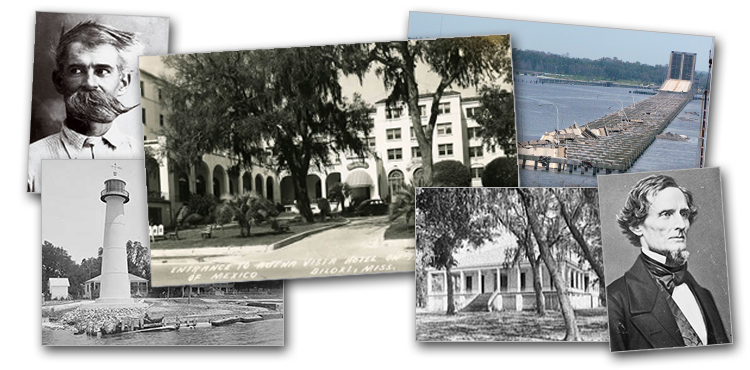
- 1596 views
Fire Department and Major Biloxi fires
Fire Department and Major Biloxi fires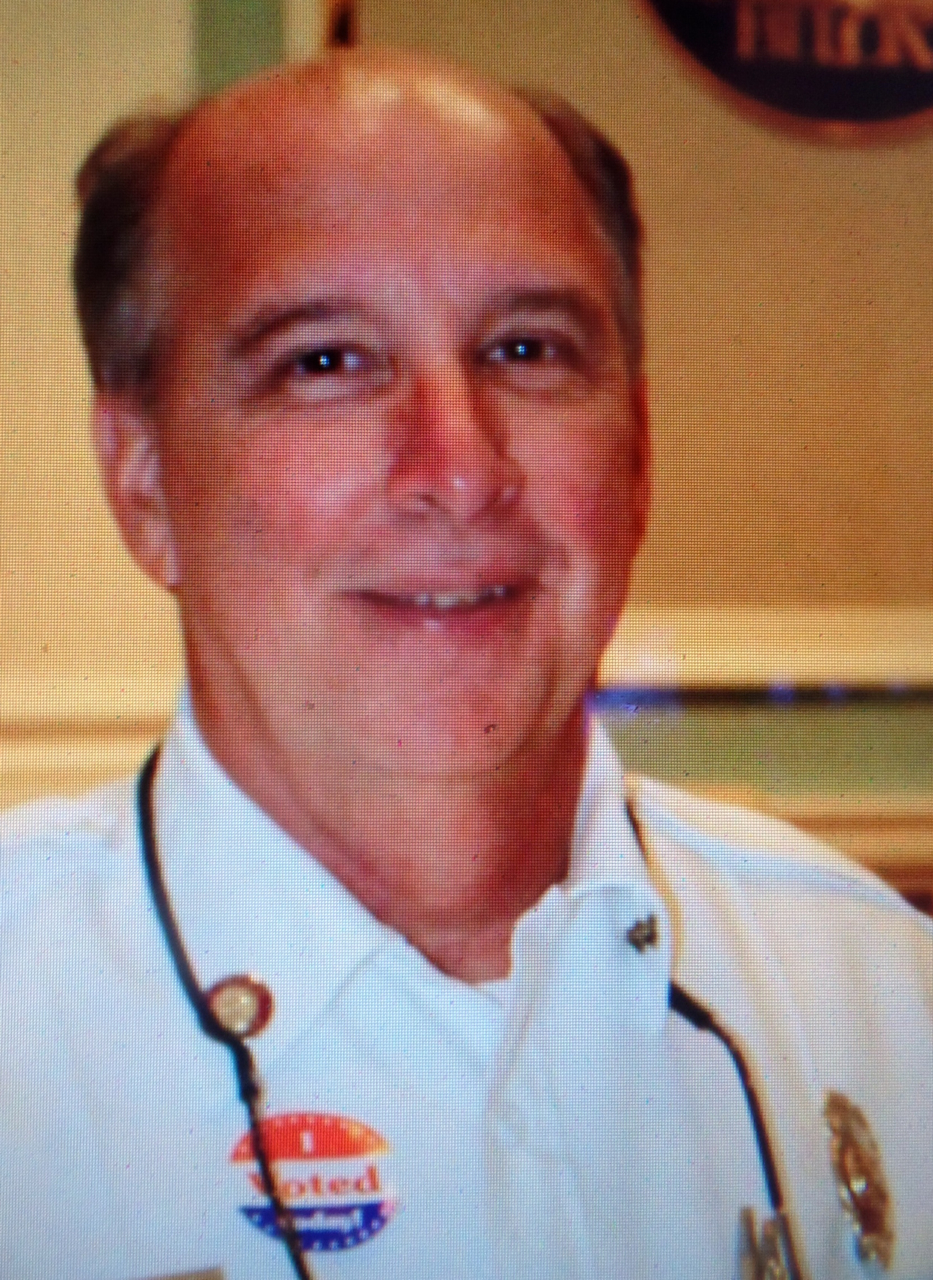
BILOXI FIRE DEPARTMENT
TIME LINE
.jpg)
Felix Charles Borries (1860-1937)
[Courtesy of Janice Hughey Hogan-September 2013]
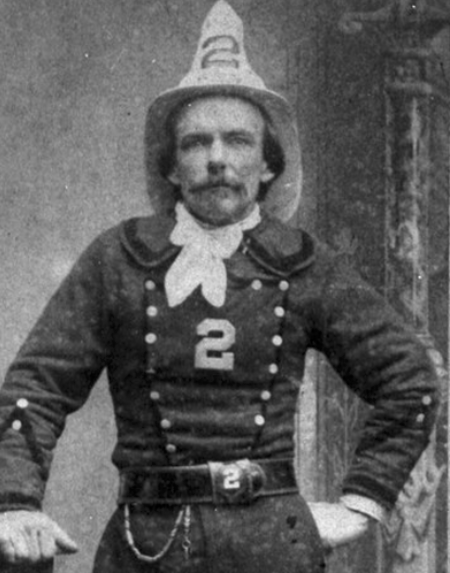
Frederick H. McCaleb [1846-1909]
[from Find A Grave.com]
1883
City of Biloxi organized its first fire company [Biloxi Volunteer Fire Company No. 1] on September 3rd at the Montross Hotel. F.W. Elmer, pres.; Will C. Grant, v. pres.; P.J. Montross, treas.; Phil McCabe, foreman; Thomas P. Bachino, 1st assist.; and Frank Greveniing, 2nd assist. Others involved: Leon Bertoli; Joe Tucei; John B. Bachino; N. Petrie; Albert Deck; Thomas McCabe; Daniel Bachino; J.M. Ritch; M.J. Grady; George H. Schrieber and N. Sullivan.(The Daily Picayune, September 6, 1883, p. 1)
1890
The Mississippi Hook & Ladder Fire Company No. 1 was chartered on February 21, 1890 by the following: August Barthes, E. Beaucoudray, Joseph Bellande, Peter Bellande, Newt Bellande, E.B. Chambers, J. Clark, M. Clark, William Collins, Thomas Collins, P. Dalton, A.B. DeLamarre, Percy L. Elmer, A. Giron, W.P. Henley, Lee Kelty, J.C. Laage, J.B. Lemon, Phil Lestrade, William Master, Dan McCarthy, Y. Petrie, R. Price, Alex Redon Jr., T. Rachford, Phil Wagner.(The Biloxi Herald, April 12, 1890, p. 2)
The Biloxi fire companies [Biloxi Volunteer Fire Company No. 1, Hook and Ladder Fire Company No. 1 and Mechanics Steam Fire Company No. 2] met in May and decided that September 19th would be the day of their annual parade since that was the day that the Biloxi Volunteer Fire Company was organized. The Biloxi Herald nominated Phil McCabe as Chief of the fire department.(The Biloxi Herald, May 24, 1890, p. 4)
1891
The engine room of the Barataria Canning Company burned in early September 1891. Damage was estimated at $1000 and the plant was disabled for a few days.(The Biloxi Herald, September 12, 1891, p. 4)
1892
On March 18th, a fire of incendiary origin destroyed the sash, door and blind factory of M.L. Vazquez north of the railorad. Loss estimated at $2000 with $1000 insurance by Phoenix. A small house valued at $400 and owned by Collier also lost.(The Biloxi Herald, March 19, 1892, p. 4)
1894
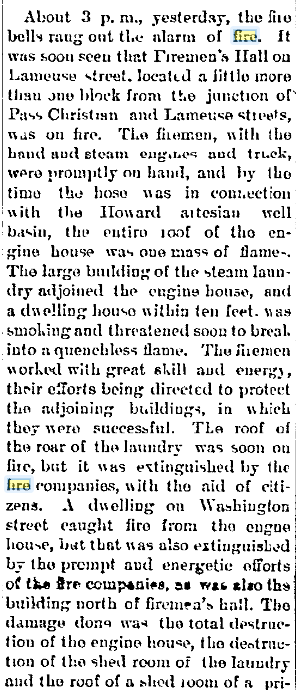
The Biloxi Herald, February 17, 1894, p. 8.

June 1909 Sanborn Map-Sheet 6
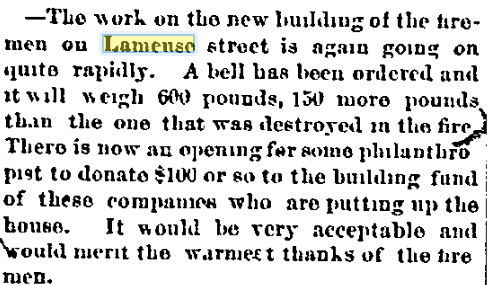
The Biloxi Herald, June 9, 1894, p. 8.
On October 12th, Biloxi's Commercial District was inflicted losses of about $75,000 when a large fire commenced in the two-story, J.W. Swetman Building on Pass Christian Street. Big losers were: S. Picard-$25,000; J.W. Swetman-$8000; G.E. Ohr Sr.-$5000; W.K.M. Dukate-$4500; and the pottery of G.E. Ohr Jr. (1857-1918)-$3000.(The Biloxi Herald, October 13, 1894, p. 8)

On August 18th, F.W. Elmer was elected Fire Chief of Biloxi by delegates from the various fire companies of the city. Felix Borries was elected 1st assistant and Gus Barthes, 2nd assistant. The annual Firemen's Day Parade, which had been neglected for a few years, was planned for September 19th with Isidore Heidenheim elected Grand Marshal of the parade.(The Biloxi Daily Herald, August 19, 1898, p. 8)
1900
On November 9th, the Great Biloxi Fire started in the rear of Kennedy's Saloon near the L&N Depot on Reynoir Street Hotel and devastated about ninety commercial and residential structures south to the beach. Damages estimated at about $600,000.(The Biloxi Daily Herald, November 9, 1900, p. 1)
1904
The City of Biloxi passed an ordinance in May that subsidized the two local fire companies to provide fire protection for Biloxi. Volunteer Fire Company No. 1 received $250 per year while Hook and Ladder Company No. 1 was given $125 annually for thier support. In addition, Biloxi was to furnish the following: ladders and buckets on hook and ladder trucks; three hose reels to be purchased with 250-feet of hose each and to be located outside markets; Mississippi Volunteer Company No. 1 firemen were to remunerated as follows: engineer-$5 per fire, fireman-$2.50 per fire, pipe men, not to exceed 2 per lead hose-$3.00 per fire, team that hauls an engine to fire to get $10.00 and team that hauls hook and ladder truck to be paid $5.00.(The Biloxi Daily Herald, may 4, 1904, p. 1)
The East End Hose Company No. 1 was organized on October 5, 1904 at Sterne’s Store 0n Point Cadet with 37 men present. Officers of the Company were: Peter C. Ott, pres.; John S. Wentzel, vice-pres.; W.T. Sterne, sec.; W.G. Manuel, treas.; John Ott Sr., foreman; Alexander Ewing, 1st assistant foreman; Charles Wentzel, 2nd assistant foreman; and Joseph Arguelles, assistant aid to the fire chief. Dues were set at 50 cents for three months. By October 8th, the company was fully equipped with a hose carriage and ancillary equipment. The fire company’s equipment was stored in the East End market house. The Company’s first Mask Ball was held on December 22, 1904.(The Biloxi Daily Herald, October 6, 1904, p. 5; October 8, 1905, p. 5; December 22, 1904, p. 1; and September 19, 1907, p. 4)
The Back Bay Hose Company was organized on November 11, 1904 in a small shed owned by Nick Voivedich on Fayard Street. There were 20 charter members with a hose drawn reel. William Gorenflo and Edward C. Joullian were generous supporters of this organization in tis primal years. The company named its two horses, Joullian and Reynoir. Original officers of Back bay Hose Company were: J.B. Reynoir, president; William Thompson, v-pres.; Nick Voivecich, foreman; George Duvic, 1st assistant; and Arthur Richard, 2nd assistant.(The Daily Herald, September 20, 1915, p. 2)
Philip McCabe (1837-1904), native of New Orleans and first chief engineer of the Biloxi Volunteer Fire Company, expired in mid-December. In their youth, Ed Glennan and Charles Redding both worked for Mr. McCabe at NOLA when he had a stove business on Camp Street in NOLA. McCabe also was the first tin can manufacturer on the Coast making fruit, oyster, and vegetable cans.(The Pascagoula Democrat-Star, October 28, 1881, p. 3 and The Biloxi Daily Herald, December 16, 1904, p. 5)
1905
Alderman T.J. Rosell, chairman of the water works committee, tested the water-fire pressure at Fayard Street and Howard Avenue with a 1 1/8 inch nozzle and it threw a stream of water 67 feet high or as high as the clock in the Nativity BVM Catholic Church. The City has two water tanks.(The Biloxi Daily Herald, September 27, 1905, p. 2)
1906
Two new LaFrance chemical fire engines arrived in late March and after being readied for service would be used by the Back Bay and West End fire companies.[The Biloxi Herald, March 30, 1906, p. 1]
1910
In late April 1910, a fire on east Division Street destroyed three, wood-framed cottages. They were owned by Frank Cook-value $1000; Mrs. John Entrekin-value $1000 and insured for $500; Mrs. Martha Parker-value $400.(The Daily Herald, April 26, 1910,p. 4)

Henry Eikel [1905-1976] and Vera Elmer [1902-1982] [m. Hugh A. Brown] ride on the Cornucopia float of the Hook and Ladder Fire Company on 19 September 1910 at the Biloxi Firmen's Day Parade.
Percy Lee Elmer [1873-1949], her father, was the last living charter member of the Mississippi Hook and Ladder Fire Co., and was one of its officers for years. Mr. Elmer was city alderman for six years and formerly was city treasurer and in former years was prominently identified with local civic affairs.
1913
The Noblin House, owned by Mrs. Ace Noblin of Edwards, Mississippi, situated on West Beach and used as a boarding house, caught fire in early August. Mrs. L.D. Rodon and Mrs. W.P. Davis both escaped death by jumping from the upper story. They were injured and treated by Dr. H.M. Folkes and Dr. W.G. Carroll who were both called to the conflagration. It was occupied by Mrs. Rodon for the summer months. The structure was formerly utilized as a santarium by Dr. W.R. Card. The Volunteer Fire Company, The Hook and Ladder Company and the West End Fire Company fought the blaze. E.L. Castanera, water works superintendent, related that this fire was the first to test the new electrical fire pump at the local pumping station. The pump maintained a pressure of 125# throughout the battle to save the Noblin House.(The Daily Herald, August 7, 1913, p. 1 and August 8, 1913, p. 8)
1921
The City had the following fire protection beginning the year: Central Station-B. Mattina and Joseph Emile; Mississippi Hook & Ladder Company-Charles Sentell; West End Fire Company-Joseph Peppard; Back Bay Fire Company-Harvey Chinn; East End Fire Company-Fred Knox; and W.F. Clark, relief fireman.(The Daily Herald, January 15, 1921, p. 1)
1922
An $800, house inhabited by employees of the Biloxi Fisherman's Packing Company on Point Cadet was destroyed by fire on February 23rd. The structure was located in an alley just back of Dave Ahern's grocery store. Other cottages in the area caught fire, but were saved by firemen from the East End, Mississippi Hook and Ladder and the Volunteer Fire Companies of Biloxi.(The Daily Herald, February 23, 1922, p. 3)
The DeJean Packing Company on Biloxi’s East Beach situated between Dunbar-Dukate and the Seafood Packing Company, was entirely destroyed by fire on 21 August. The building owned by Mrs. J.T. Maybury was valued at $1000. The packing company lost fresh and canned shrimp and machinery valued at $5000. There was no insurance. In addition, three moored schooners were damaged by the flames. The place was known as the old Greiner Packing Company.[The Daily Herald, August 22, 1922, p. 1]
On May 15th, a large fire destroyed one-half of the 3rd floor of the main building of the Riviera Hotel [formerly Montross] on Beach Boulevard and Lameuse Street. Damage estimated at $20,000.(The Daily Herald, May 15, 1922, p. 1)
After its gasoline engine back-fired, the Hilda S. , owned by Martin Fountain and sailed by George Smith, and moored at the Seafood Company pier on East Beach received slight damage. The blaze was controlled with only slight damage as the crew used its pyrine extinguisher.(The Daily Herald, August 21, 1922, p. 3)
1924
On December 16th, a fire at Beauvoir destroyed Dormitory No. 3 which was situated west of the old hospital. Two Confederate veterans perished in the conflagration, J.T. Hunter (1844-1924) and F.M. Sharp (1846-1924). They entered the Soldier's Home fro, Laurel and Columbus respectively.[The Daily Herald, December 17, 1924, p. 1]
1925
Hook and Ladder Fire Company No. 1 celebrated its 35th anniversary on February 23rd at its station on Fayard Street. Officers of the organization at this time were: Jake Lechner (1872-1930), president; Thomas E. Collins (1864-1937), v. pres.; Henry Eikel (1869-1952), secretary-treasurer; August Tremmel (1873-1942), foreman; Will Kornmann, 1st assist.; Anthony V. Ragusin (1902-1997), 2nd assist.; Charles Sentell, housekeeper; and Frank Bennett, flag bearer.(The Daily Herald, February 24, 1925, p. 1)
1926
On May 23rd, A large fire on West Howard Avenue destroyed the Yerger Building which housed the Variety Store, Electrik Maid Bakery, Newman Furniture Company, and Biloxi Mercantile Company. Losses were estimated between $75,000-$100,000.(The Biloxi News, May 23, 1926, p. 1 and The Daily Herald, May 24, 1926, p. 1)
The Point Cadet Fish and Oyster Company was destroyed by a fire in the early morning of June 11th. The plant was situated on Back Bay near the Cruso Canning Company and dealt in crab meat, fish and raw oysters. Proprietor, Emile J. DeSilvey [1886-1973], estimated his loss to be between $4000 and $5000. The conflagration also resulted in the destruction of nets, seines, fixtures and ancillary equipment.[TDH, June 11, 1926, p. 1]
The bungalow of Mrs. K.C. Roswell 1130 West Beach between Gill Avenue amd Porter caught fire in the early morning of September 4th. Three policemen, Evon Swetman (1902-1976), Richard Grady and Jake Stanovich, of the night patrol discovered the blaze and awoke the tenant, Mrs. Albert Madding. Units from West End No. 1, Central No. 1 and Hook & Ladder No. 1 arrived on the scene and quickly arrested the incipient conflagration limiting damage and the loss of the structure. The five City firemen were aided by volunteers.(The Daily Herald, September 4, 1926, p. 1)
1928
The Elmer Packing Company on Back Bay was destroyed by fire on January 31st. It was leased to Louis A. Lundy of Ocean Springs at the time of the large conflagration.(The Daily Herald, January 31, 1928, p. 2)
1930
The Jennie Johnson, an auxiliary schooner, owned by Louis O. Johnson received fire damage amounting to $150 on April 20, 1930. Captain Hub Terrell was burned on his arm and torso from the fire which emanated from the ignition of gasoline vapors in the vessel’s cabin when Terrell lit a match. The Jennie Johnson had just returned from the outside oyster reefs with a hold laden with mollusks and was moored at the Johnson Canning Company wharf. Biloxi firemen were called to the vessel and performed admirably saving the boat and its cargo. The cabin was burned as well as some of the decking and the mainsail was badly damaged by the conflagration. (The Daily Herald, April 21 1930, p. 2)
1931
Sunkist, the Popp home, was destroyed by fire on 31 May. The origin of the conflagration was unknown.(The Daily Herald, June 1, 1931, p. 2)
1933
The warehouse of Frank P. Corso on Caillavet Street near the L&N Railroad burned on October 11, 1933. He suffered a heavy loss of about $6000 from fire and water damage. Mr. Corso will move to the warehouse formerly occupied buy the Southern Grocery.(The Daily Herald, October 11, 1933, p. 1 and October 14, 1933, p. 2)
1934
In April 1934, a bulkhead and pumping stand were erected near the [Ramsay Springs Road] highway and 500 feet from Five Points in North Biloxi. Chief Sentell, A.V. Ragusin and Walter Nixon visited the site.(The Daily Herald, April 27, 1934, p. 7)
1936
The W.F. McDonnell home, a wood-framed structure of eight rooms and situated on McDonnell Avenue just off West Beach at Biloxi, was destroyed by fire on April 23, 1936. About $500 in musical instruments was lost and the house was valued at $7000. Mrs. McDonnell was ill at the time of the conflagration and was taken to the home of Mr. and Mrs. Thomas Wiltz, her neighbor.(The Daily Herald, April 23, 1936, p. 3)
On December 4th, ground was broken for the new Back Bay Fire Station on Elder Street. The 116 foot by 200 foot lot was acquired from the Elder Estate. John T. Collins was the architrect for the $5000 colonial-style structure.(The Daily Herald, December 4, 1936, p. 9)
1937
In February, several homes on Deer Island were spared damage from the recent fire.(The Daily Herald, February 4, 1937, p. 5)
The new West End Fire Station was dedicated on July 8th. John T. Collins was project architect and Robert Conway built the fire engine. Mayor Louis Braun reminded the audience that 15 months prior while a candidate for Mayor, he promised that he would make improvements to Biloxi's Fire Department if elected.(The Daily Herald, July 9, 1937, p. 1)
The new Back Bay Fire Station was dedicated on July 20th during the annual Picnic and Bazaar of the Fourth Ward Regulars. John T. Collins was architect and Robert Conway had built the company's fire engine which had an 85 HP motor and 850 feet of regular hose. It was the 5th fire apparatus for the Back Bay Fire Company since its 1904 organization.(The Daily Herald, June 21, 1937, p. 1)
1940
1942
The S.H. Kress store on West Howard Avenue sustained $2000 in damages from a fire in mid-November. Three alarm event and O.W. Trawick was the store manager.(The Daily Herald, November 13, 1942, p. 2)
Earl F. Cook (1907-1999), now attached to the Central Fire Station, was appointed assistant Fire Chief in December 1942. Earl joined the BFD on May 1, 1935. He was the son of Mr. and Mrs. Henry Cook.(The December 23, 1942, p. 15)
1944
On October 27, 1944, a fire in the old Peoples' Bank Building on the corner of Howard Avenue and Lameuse Street caused an estimated $13,000 damage exclusive of fixtures and merchandise. The Collins were hired to replace the roof and perform structural work.(The Daily Herald, October 28, 1944, p. 1 and October 31, 1944, p. 5.
1949
The Hick's Battery Manufacturing Company on Back Bay near Lee Street burned on April 6, 1949. Damage was estimated at $50,000. All five Biloxi Fire Department trucks and two fire engines from Keesler Field answeredthe fire call. Fourteen firemen and several volunteers assisted in containing the conflagration.(The Daily Herald, April 7, 1949, p. 1)
1951
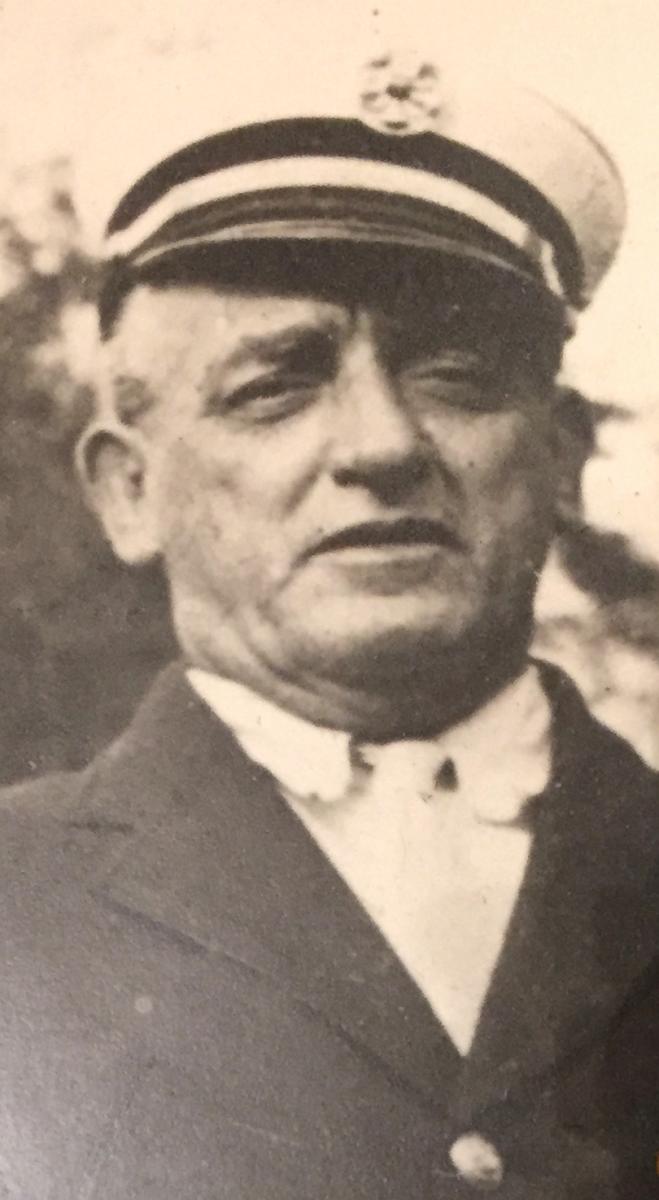
Charles Henry Sentell (1884-1951) former Biloxi Fire Chief [1933-1942] died on 25 January.[The Daily Herald, January 26, 1951, p. 12]
The laundry at the Buena Vista Hotel caught fire on the afternoon of March 14, 1951 resulting in $50,000 in damages to the structure which was situated behind the hotel. The fire was fed by linens and cleaning fluid. Unfortunately, Anthony 'Tony' Bernard Rousseau (1908-1951), a Biloxi volunteer fireman, was killed while attempting to board the fire truck of the Central Fire Station. He slipped, fell and was run over by the rear wheels of the vehicle.(The Daily Herald, March 14, 1951, p. 1)
1952
Bruce Carsen Howe (1951-1952) died on 12 March from burns received in a fire on Carter Avenue in West Biloxi. The child was rolling a jar of gasoline on the floor which exploded when near a heater in the home. He was the son of Mr. and Mrs. Robert Howe, whose father was Donald Witter Howe (1891-1952), founder of Seafoam Company, which manufactured food and pralines at their establishment on Carter Avenue. Damage to the Howe home was estimated at $1500.[The Daily Herald, March 13, 1952, p. 1]
Biloxi ordered four, new fire trucks costing about $63,000 from the Four Wheel Drive Company of Clintonville, Wisconsin. Two were high pressure pumpers 750-gallon pumper and two were standard-750 gallon pumpers. The equipment was expected in the first week of September. (The Daily Herald, June 7, 1952, p.3)
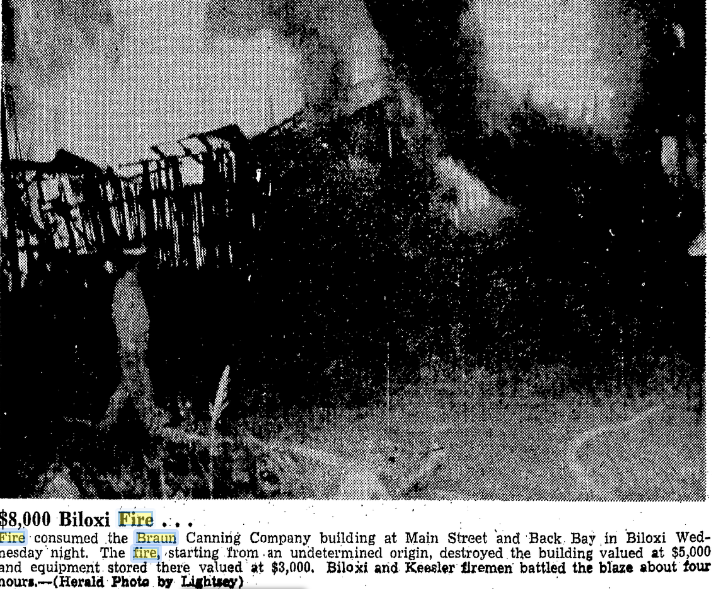
An old canning factory at Main Street and Back Bay, formerly the Braun Canning Company, was destroyed by fire on 24 September. The building [150 feet by 65 feet] was owned by Madames E.A. Braun and Lomax Burdine.[The Daily Herald, September 25, 1952, p. 1 with photo]
A new, $30,000 fire station for Biloxi's West End on Jeff Davis Avenue and the L&N RR was proposed from the $999,000 bond issue passed by Biloxi denizens in October.(The Daily Herald, December 24, 1952, p. 10)
1953
Walter Clark (1900-1961) and Frank Hecht (1901-1981) were appoined Fire Chief and Assistant Fire Chief, respectively, of the Biloxi Fire Department by incoming Mayor Laz Quave (1910-1985) .(The Daily Herald, July 6, 1953, p. 17)
1954
Herman Creel (1908-1976) was named as assistant fire chief in February 1954. William Knox retired.(The Daily Herald, March 2, 1954, p. 6)
In the early morning of November 2, 1954, a devastating conflagration which commenced in Poor Richard’s Lounge of the Sun ‘N Sand Restaurant and Lounge. Damage to the structure was estimated at $80,000 to $100,000. An apartment above the housed the A.H. Bailey family and their two young children. Units from the West End and Back Bay fire stations with assistance from KAFB first responders were called to the scene.[The Daily Herald, November 2, 1954, p. 1]
1955
In April, the Grove Club on West Beach was destroyed by fire. Owners, Louis Uchello (1909-1996) and Guy Uchello (1895-1962) valued the 1940 structure and a 1946 addition at $75,000. They averred that $10,000 was left in the safe. (The Daily Herald, April 11, 1955, p. 1)
1956
The Barthes-Sentell Fire Station No. 5, a $25,000 structure situated on Father Ryan Avenue, was dedicated on December 18th. It was named in honor of Frederick Auguste Barthes (1864-1948) and Charles Henry Sentell (1884-1951), former Biloxi Fire Chiefs.(The Daily Herald, December 17, 1956, p. 21 and December 19, 1956, p. 1)
1959
In 1959, fire damage at Biloxi was estimated at $270,489. William Gilmer, age 60, was the only fire victim. Gilmer was a former patient at the Biloxi VA Center and burned to death in his Pass Road trailer on February 20, 1959. The fire at Ohr's Junk Yard which occurred on December 27, 1959 was estimated to result in about $100,000 in damages. Antique automobiles were among the treasured items lost. The A&P Super Market fire resulted in about $75,000 in damages. Other notable conflagrations in 1959 were the $25,000 Blue Note Cafe fire on Main Street which occurred in March and a $20,000 fire in an apartment building on West Water Street in June.(The Daily Herald, January 1, 1960, p. 5)
On August 25th, the A&P Super Market on West Howard Avenue was severely harmed by fire with damage estimated at over $100,000. The building was erected in 1945 by Sam Mitchell and remodeled in 1950. All Biloxi fire units ledby Chief Walter Clark with assistance by the LeMoyne Volunteer Fire Company fought the blaze for 45 minutes.(The Daily Herald, August 26, 1959, p. 1 )
1960
On 21 May, Noel 'Little Jimmie' James Skrmetta Jr. (1957-1960) burned to death in a fire at the home of his parents, Noel 'Jimmie' James Skrmetta and Bobbie Jean Maumus Skrmetta, at 5135 Southern Avenue in Biloxi. Martin Skrmetta, an older brother, received mild burns from the gasoline fire. The Skrmetta home damage was estimated at $2000 and was valued at $12,000.(The Daily Herald, May 21, 1960, p. 1)
Captain Patrick D. Quave (1935-1960), Biloxi fireman at the East End Fire Station, was killed on Dukate Curve in a traffic accident on December 26, 1960. His spouse, Ramona Darrington Quave, was seriously injured.(The Daily Herald, December 27, 1960, p. 1.
1962

Bayview Lanes, formerly the Bayview Theatre building, was destroyed in a great conflagration on November 29th. Loss to structure and equipment was estimated at $450,000. Douglas I. Smith (1901-1979) opened a theatre, flower shop and drug store here in 1946. In 1959, the building was remodeled into a 20-lane bowling alley when owned by Ernest V. Landaiche (1895-1966).(The Daily Herald, November 30, 1962, p. 1)
1963
The Bernard T., a fishing vessel owned by Jane Taltavull Smith, sustained about $700 in damages when it caught fire at the Taltavull Company wharf on West Bay View Avenue. Batallion Chief Frank Hecht said that a shortage in the boat's electrical system was responsible for the fire damage to the cabin of the vessel.(The Daily Herald, January 28, 1963, p. 2)
1964
The new $54,000 East End Fire Station was dedicated on September 12th completing the first phase of Mayor Guice's 4-point modernization program. The W.L. Easterling Company of Ocean Springs erected the 3984 square-ft. structure on the site of the old fire station. The building was designed by H.F. Fountain Jr. & Associates.(The Daily Herald, September 3, 1964, p. 5, September 11, 1964, p. 9, and September 14, 1964, p. 1)
The old Crystal Ice Company building, situated between Lameuse Street and Delauney Street, burned for 32 hours in mid-December. Damages estimated at $182,000.(The Daily Herald, December 10, 1964, p. 1 and December 11, 1964, p. 2)
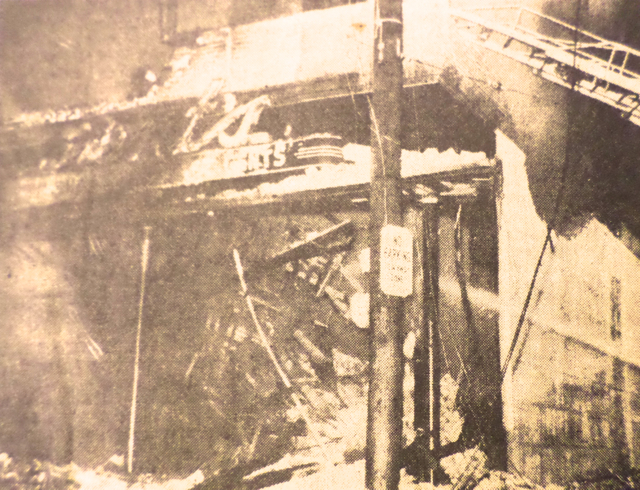
The Folkes Building, southeast corner of West Howard Avenue and Reynoir Street, burned in late December 1964. Losses estimated at $230,000 to Kent's Men Store, Royal Credit Jewelers, Acme Photo, et al. Frank Gabrich was BFD Chief.(The Daily Herald, December 26, 1964, p. 1)
The Biloxi Fire Department fought two large fires in 1964. The $55,000 East End Fire Station was completed and two, new, diesel fire trucks each costing $27,000 were acquired.(The Daily Herald, January 1, 1965, p. 1)
1965
1966
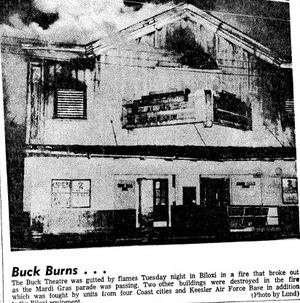
The Buck Theatre, Laughran Building and Collins Building situated on the west side of Lameuse Street between Jackson and Howard Avenue burned on Mardi Gras eve, February 22, 1966, while the Mardi Gras parade was in progress. Firemen from four other cities and KAFB fought the conflagration and two Biloxi firemen, Guy Green and George Emile, suffered smoke inhalation while battling the burning buildings. Damages were estimated to be as much as $50,000.(The Daily Herald, February 23, 1961, p. 1)
The fifth floor of the Buena Vista Hotel's East Wing caught fire at 5:45 p.m.on July 20th. 125 rooms were burned resulting in damages estimated at $150,000. All 360 rooms of the luxury hotel were in use as the Alabama Farm Bureau Federation was holding its annual meeting. Local fireman extinguished the blaze in about three hours. The Buena Vista reopened for business on July 21st.(The Times-Picayune, July 21, 1966, p. 1)
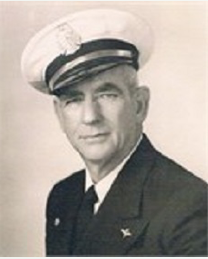
Richard Harvey Chinn [1890-1966]
Richard Harvey Chinn, retired chief of Keesler AFB fire department, died at 7 a. m. today at Howard Memorial Hospital, Biloxi. Mr. Chinn, who resided at 411 Copp St., was a native of Woolmarket and a lifelong resident of the Mississippi Coast. He began his career as a fireman in 1918 at the old Back Bay fire hall and became a fireman at Keesler in 1941. He was appointed chief at Keesler Field in 1944 and retired in 1959. In 1946 and 1947, Mr. Chinn assisted in reorganizing the Ocean Springs fire department and for his work he was made an honorary member......
[The Daily Herald, August 28, 1966)
1968
1969
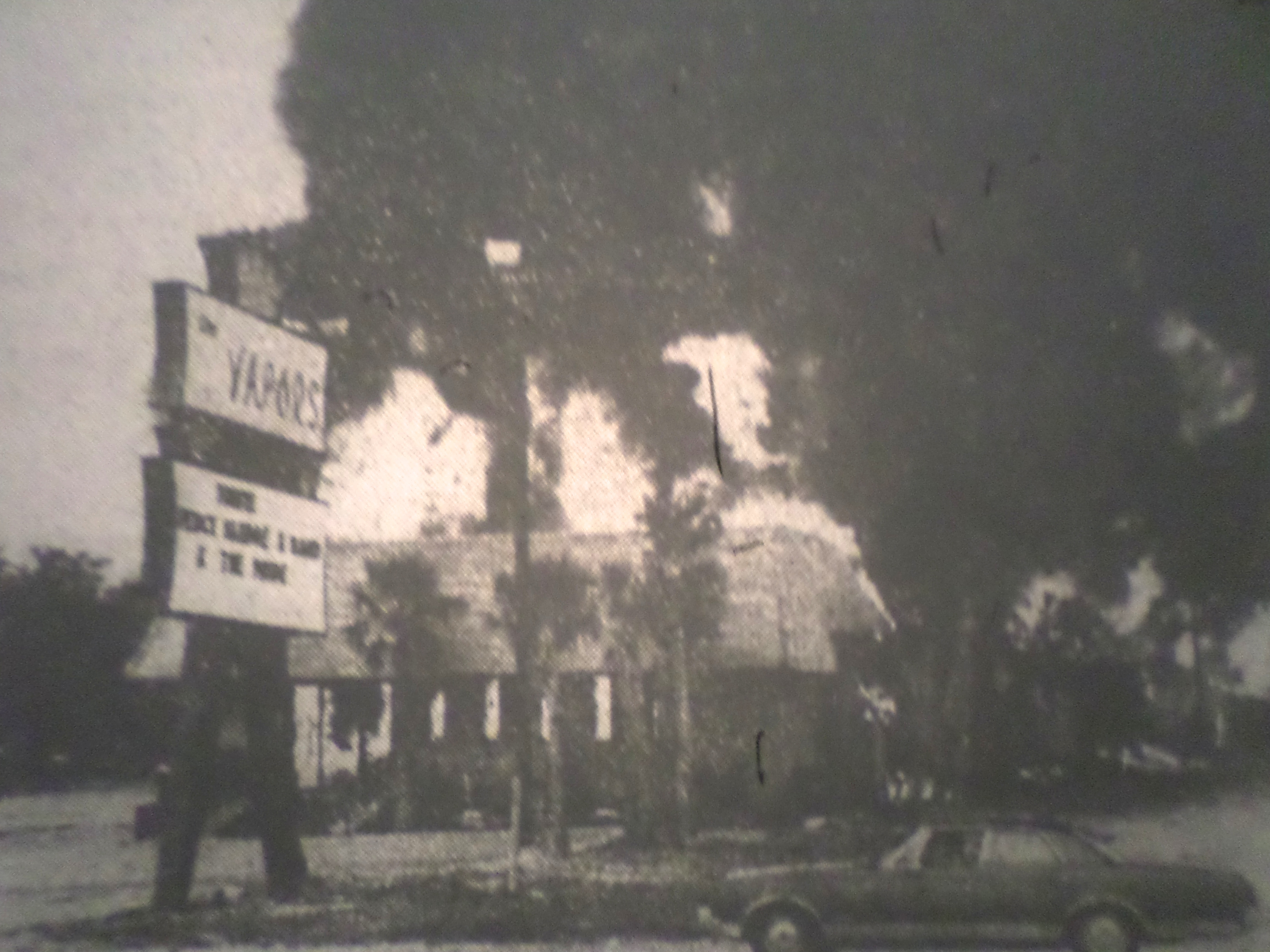
1971
The Vapors, a large night club on Biloxi's West Beach Strip east of the Broadwater Beach Hotel, was destroyed by fire on the morning of May 20th. 1971. Richard Head owner of the structure estimated damages at $120,000. It had been destroyed by Hurricane Camille in August 1969 and rebuilt.(The Daily Herald, May 20, 1971, p. 1)
1972
The Accomo Hotel and Restauant, formerly the Paradise Gardens at 744 Main Street, was gutted by fire on November 22, 1972. A post-WW II, negro night club was once the venue for entertainers such as: Antoine "Fats" Domino [1928-2017]; Guitar Slim [Eddie Jones (1926-1959)]; Chuck Willis [1928-1958]; and Johnny Otis [1921-2012]. Damage to the structure was estimated at $30,000. It was owned by Joseph T. Hathorn and William E. Jones. The fire was discovered while BFD firemen were fighting another blaze at the Auction City Furniture building 445 East Division. Fire Chief Gabrich estimated that W.M. Krohn and Ronnie Krohn, owners, loss at $5000 to their $10,000 structure.[The Daily Herald, November 22, 1972, p. 2]
1974
The Gorenflo publc school on Lameuse Street caught fire on April ? The conflagration originated in the cafeteria and destroyed the cafeteria, library, auditorium, teachers' lounge, principal's office, and four class rooms in the main school building. Damages were estimated at $1 million dollars.(The Daily Herald, October 9, 1975, p. C-1)
1975
Repairs to the fire-damaged Gorenflo school were 40 per cent completed. The 508 students in grades 1-6 were attending classes in 19 classrooms with 20 teachers.(The Daily Herald, October 9, 1975, p. C-1)
1976
Evon Emery Swetman (1902-1976), former assistant Biloxi Fire Chief, expired at Long Beach on March 15th. He was the son of the late J.W. Swetman and Sofey P. Schumann. (The Daily Herald, March 16, 1976, p. A2)
In the late afternoon and evening of August 16th, Domicilliary No. 1, a three-story, 45-year old building, housing 142 elderly and disabled patients at the Veterans Administration Hospital at Biloxi, was heavily damaged by a large conflagration. More than 100 firemen from Biloxi, Gulfport, D'Iberville and Keesler AFB fought the blaze which appeared to have commenced in the attic of the dormitory and destroyed most of the building's third floor. No lives were lost, but William B. Sheppard (1916-1976), director of the VA facility, died of a heart attack in his office around 6:00 p.m. during the height of the fire.(The Daily Herald, August 17, 1976, p. A-1)
1980
Joan Marie Manning Johnston (1960-1980), Gerald Guy Ross Jr. (1960-1980) and George W. Johnson (1957-1980) died in a duplex fire at 917 Central Beach Boulevard on January 19, 1980. Damage to the structure was estimated at $15,000. The corporal remains of the deceased were interred at the Biloxi Cemetery.(The Daily Herald, January 20, 1980)
1982
In the early morning of November 8th, 28 people died and more than 30 injured in a fire in the Harrison County jail on Delauney Street and McElroy Street in Biloxi. Robert Eugene Pates (b. 1951) was charged with 28 counts of capital murder when he was named the alleged conspirator of the conflagration. Pates was sent ot Parchman immediatley.(The Daily Herald, November 8, 1982, p. A1 and November 9, 1982, p. A2)
1981
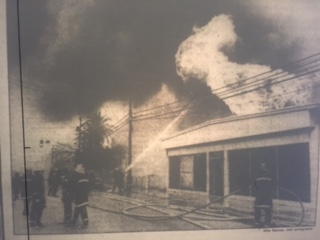
A warehouse adjacent to Melvin Supply Company at 613 East Howard Avenue was damaged by fire on February 6th. Damage was estmated in the $350,000 to $400,000 range, in early May. The struture was owned by Ernest Melvin, Beat 1 Harrison County Supervisor and Biloxi Mayoral candidate.(The Daily Herald, February 6, 1981)
1983
The Shalimar Lounge at 806 Main Street was destroyed by fire on March 8th. The building was valued at $150,000.(The Daily Herald, March 9, 1983, p. B-6)
1985
On 7 January, Harold Windom replaced Guy Bernard Roberts as Biloxi's fire chief. Chief Roberts' health was in decline but he agreed to replace Windom until his position could be filled.[The Daily Herald, Janaury 8, 1985, p. B-1]
1986
On October 20th, Carl Ohr Jr. (1952-1986) and Edwin Kurt Jacquet (1956-1986), BFD employees, were killed battling a fire in Biloxi.(The Times-Picayune, October 21, 1986, p. 1)
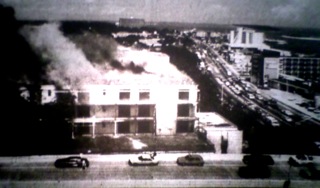
1991
On June 25th, the Buena Vista Hotel was severely damaged by fire and Steve Moore, Biloxi Fire Chief, estimated that the fire resulted resulted in damages of "hundreds of thousands of dollars and a total loss."(The Sun Herald, June 26, 1991, p. A-1)
2009
Retired Fire Chief Guy B. Roberts (1926-2009) expired at Biloxi on February 24th. He was with the Biloxi Fire Department for 32 years and retired as Fire Chief in 1988. Guy was a former Deputy for the Harrison County Sheriff's Office; a charter member of the Moose Lodge; member of the Back Bay Volunteer Fire Department; and served in the National Guard. Chief Roberts was married to the former Iris Dubaz (1929-2014).
2013
David Roberts retired as Fire Chief on March 2013, after 14 years in this position.

Joseph Boney-confirmed as Fire Chief by City Council on July 9, 2013. Mark Dronet named assistant chief on July 11, 2013.(The Sun Herald, July 10, 2013, p. A2 and July 12, 2013, p. A2)
2014
Arbor View Fire [D'Iberville, Mississippi-image from The Sun Herald]
Conflagration on March 4, 2014 at the Arbor View Apartments at D'Iberville destroyed all 20 apartments in Building 400 of the apartment complex. Biloxi units assisted in this large fire. Krystal Dannielle Gonzalez (b. 1989) of D'Iberville was arrested and charged with on a charge of 1st degree arson.(The Sun Herald, March 13, 2014, p. A1)
_______________________________________
BILOXI FIRE CHIEFS
1883-1896
Philip McCabe
Philip McCabe (1837-1905), native of New Orleans and first chief engineer of the Biloxi Volunteer Fire Company, expired in mid-December. McCabe had married
In their youth, Ed Glennan and Charles Redding both worked for Mr. McCabe at NOLA when he had a stove business on Camp Street in NOLA. McCabe also was the first tin can manufacturer on the Coast making fruit, oyster, and vegetable cans.(The Pascagoula Democrat-Star, October 28, 1881, p. 3 and The Biloxi Daily Herald, December 16, 1904, p. 5)
pre-August 1897
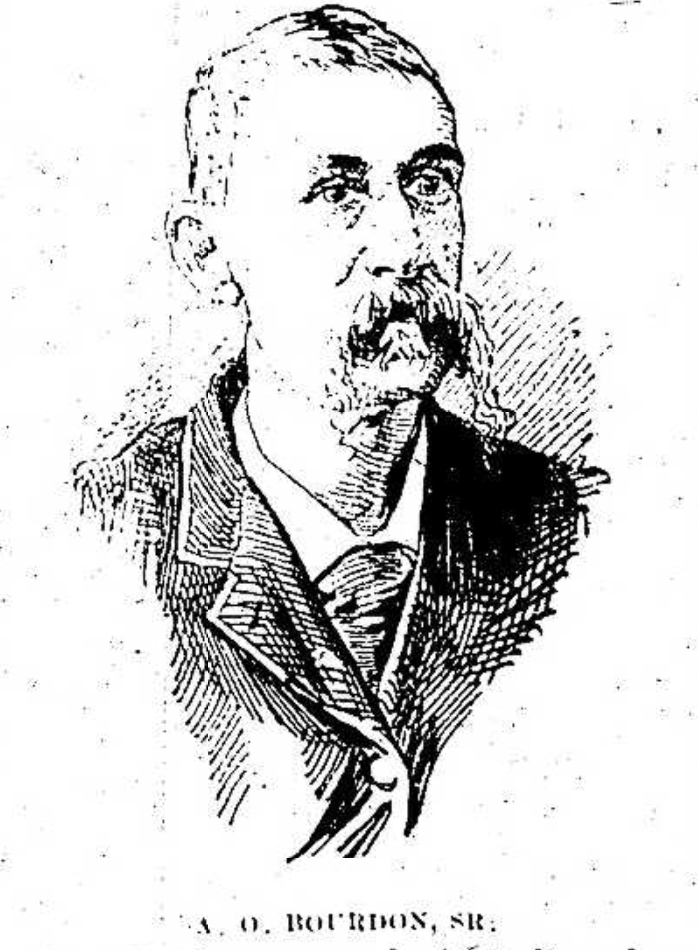
A.O. Bourdon Sr.
Arsene O. Bourdon Sr. [1845-1901]
1897
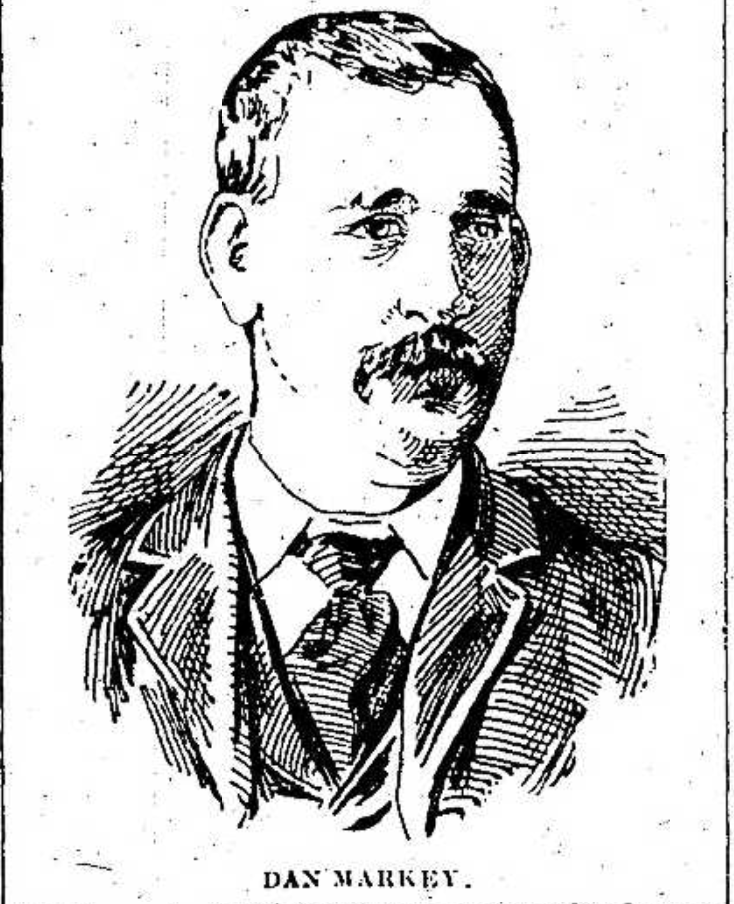
Dan Markey
Daniel Joseph Markey [1855-1900] was elected Fire Chief on August 5, 1897 by two of Biloxi's fire companies. The Mechanics Steam Fire Company No. 2 did not send a representative of the election meeting. Chief Bourdon retired.(The Biloxi Herald, August 7, 1897, p. 1)
1896-1933
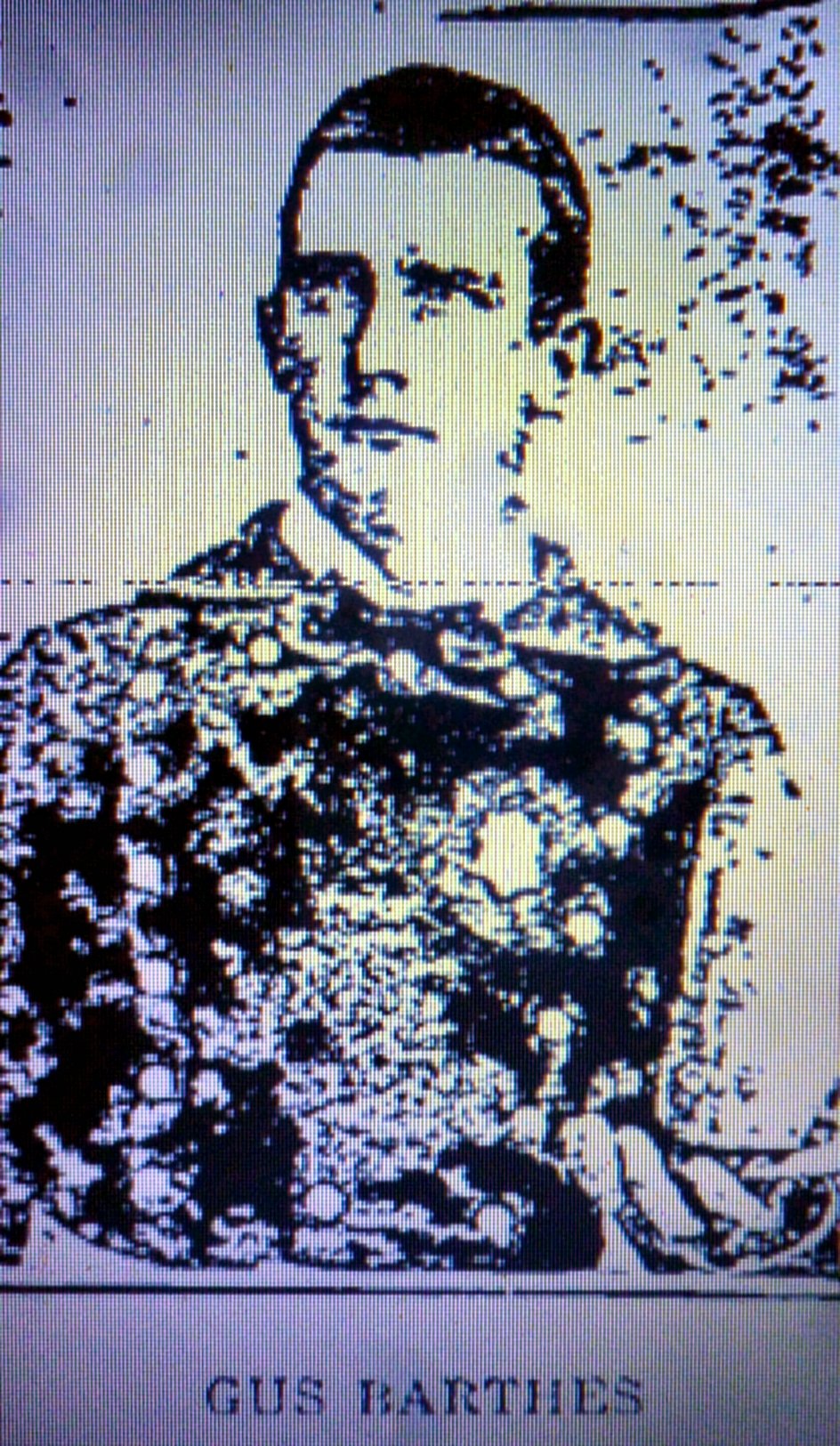
Frederick Auguste Barthes
[from The Biloxi Daily Herald, September 19, 1907]
Frederick A. Barthes (1864-1948) was the son of F.A. Barthes Sr. (18-1898) and Margaret Alexandrine Binet (d. 1877). Became Fire Chief in 1896 and retiring in 1933.
1933-
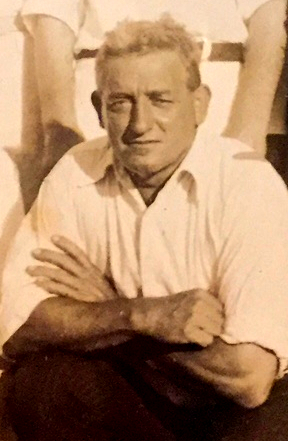
Charles H. Sentell
Charles Henry Sentell Jr. (1885-1951) was born at New Orleans on 14 December 1885 to Charles H. Sentell Sr. (1844-1910) and Johanna Aligrate (1860-1930), who married in Orleans Parish, Louisiana on 23 February 1884. Charles entered the municipal fire service at Biloxi on 7 December 1907 with Volunteer Fire Company, and transferred to the Hook and Ladder Company 15 August 1909. In May 1920, he was appointed assistant to Fire Chief Barthes and became Biloxi's Fire Chief on 1 October 1933.[The Daily Herald, January 26, 1951, p. 12]
Chief H. Sentell Jr. married Ursiline Milles, also a New orleans native, in Harrison County, Mississippi. Their children were: Russell Joseph Sentel (1927-1948); Charles Sentell; and Olivia Sentell.
1942-1942
Lee Chinn
Lee Chinn (1888-1971), age 82 years, died at Howard Memorial Hospital on Thursday night, March 11, 1971, He was the son of Mr. and Mrs. William David Chinn and was born at Vandalia, Missouri in March 1888 and came to Biloxi in 1890 with his family. As a youngster, Lee worked for a railroad company at Gulfport and at age 14 became a flagman for the L&N Railroad at the railroad Street crossing in Biloxi. He became a fireman in 1907 and was stationed at the Back Bay fire station. Lee was one of the first drivers of horse-drawn, fire engines at Biloxi. He was also one of the first to drive motor-powered firetrucks when introduce in Biloxi in 1918.
Lee Chinn was named Biloxi's fire chief in January 1942. He was released following the summer elections of 1942 and William 'Willie' Knox appointed fire chief.(The Daily Herald, January 4, 1943, p. )
In 1968 a new Biloxi fire station was named for him. Among the large Biloxi fires that Mr. Chinn assisted in fighting were: the Yerger Building on West Howard Avenue; the Avelez Hotel on West Howard Avenue; the Union Hotel; the Peoples Bank; and the Hicks Battery Company on Back Bay.
R. Harvey Chinn (1890-1966), Lee's late brother, had been fire chief of the Keesler AFB fire department. Lee Chinn retired from the BFD in 1953 and was caretaker at BSA Camp Wilkes for about four years.
Lee Chinn married Lou Ethel Fortner (1898-1971) in Harrison County, Mississippi on July 3, 1915.(Harrison Co., Mississippi Circuit Court MRB 27, p. 359)
Mr. Chinn was survived by his spouse; three sisters: Mrs. W.J. Currie and Mrs. Harry Currie, Shreveport, Louisiana; and Mildred Chinn Olster of NOLA; and many nieces and nephews.
Bradford-O'Keefe Funeral Home of Biloxi directed the Chinn funeral. Lee was a member of the First Methodist Church and his corporal remains were interred in the Southern Memorial Park cemetery at Biloxi.
1943-1953?
Lee Chinn
Lee Chinn (1888-1971) was appointed Biloxi's fire chief in January 1943 by Mayor Chester Delacruz. William Knox who had replaced Chinn, became his assistant.(The Daily Herald, January 4, 1943, p. )
1953-1961

Walter F. Clark
Walter Francis Clark (1900-1961) was appointed Fire Chief by Mayor Laz Quave (1910-1985) in July 1953. Mr. Clark joined the BFD in 1919.
1961
Frank L. Gabrich

Frank Lawrence Gabrich (1913-1986), son of John Gabrich (1864-1928) and Aeoline Pavolini (1867-1946), was born 30 March 1913. He attended Sacred Heart Academy and during WWII, he served with the 79th Infantry Division in Europe and was awarded the Purple Heart, five campaign medals and the German occupation medal. Frank made Sergeant on 1 July 1944 and was hit by shrapnel in his right arm five days later near Cherbourg, France.[The Daily Herald, September 19, 1944, p. 3]
In March 1952, Frank L. Gabrich married Elmere Rita Barras (1923-1987) in Harrison County, Mississippi. Their only child, Rachel Louise Gabrich m. Chevis Roy Hatten. Mrs. Elmere R. Gabrich was the mother of Leah Rae Vuyovich m. Gray Slay.[Harrison County, Mississippi Circuit Court MRB 89, p. 95]
Frank tranferred from the Biloxi Police Department which he joined October 19, 1937 to its Fire Department February 1, 1938. He retired as a Captain in 1958 and joined F&F Distributing Company. With the retirement of Chief Walter Clark on 1 July 1961, Gabrich was appointed Fire Chief by Mayor Danny Guice. At this time there were 39 firemen in the Biloxi force.[The Daily Herald, July 3, 1961, p. 1 and p. 2]
Fire Chief Frank Gabrich resigned 4 June.[The Daily Herald, June 8, 1973, p. 1]
1973
John T. Poulos
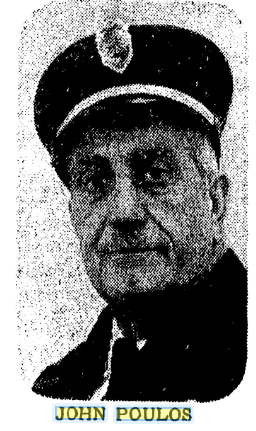
John Thomas Poulos Sr. [1914-2002] retired as acting Fire Chief effective May 1, 1974. He joined the BFD on September 16, 1945 and had a career that spanned over 28 years. John
John T. Poulos Sr., 87, retired Biloxi Fire Chief, died Wednesday, March 20, 2002, in Biloxi. Chief Poulos was a native and lifelong resident of Biloxi. He retired from the Biloxi Fire Department after 29 years of service. He served as fire chief for two years, prior to his retirement. He was a member of the International Association of Firefighters. He served with the Mississippi Army National Guard Artillery from 1932-1940. He was a member of St. John's Catholic Church. Survived by his wife of 61 years, Lucille Toncrey Poulos of Biloxi; three daughters and sons-in-law, Sheila Foster and husband, Larry, Lucille P. Strayham and husband Andrew, Crystal Ann DeLano and husband, Russell, all of Biloxi; four sons and daughters-in-law, John T. Poulos Jr. and wife, Joy of Slidell, James Poulos and wife, Darleen of Biloxi, David A. Poulos and wife, Donnet of Biloxi and Daniel P. Poulos and wife Cindy of D'Iberville; a sister, Helen Newman and husband, Paul of Biloxi; 17 grandchildren; 23 great-grandchildren; and two great-great-grandchildren. Services will be at 4:30 p.m. Friday at the Howard Avenue Chapel of Bradford-O'Keefe Funeral Homes in Biloxi, where friends may call from 3 p.m. to 4:30 p.m. Burial will be in Biloxi City Cemetery. The family prefers memorials be made to the Biloxi Firefighters Museum, 1052 Howard Avenue, Biloxi, Mississippi.[The Sun Herald, March 22, 2002]
1974

Fletcher Dumas Fest [1927-1991] was born January 22, 1927. He married Winifred Cecile Thornton (1927-2008). Children: Fletcher D. Fest Jr. [1952-2011] and M. Charles Fest. Fletcher joined the BFD in 1956 and made Captain in 1960. He was named acting assistant Fire Chief in 1973. With the announced retirement of John T. Poulos Sr. he became Fire Chief in late March 1974. Chief Fest retired November 10, 1976 from his $13,300 a year position with a remuneration of $550 per month from the Biloxi Police and Fire and Disability Relief Fund. Fest related that conflict with the Biloxi Civil Service Commission was a factor in his early retirement. His age, health, and family were salient reasons as well.[The Daily Herald, March 30, 1974, p. 2 and October 28, 1976, p. A-3]
1976
Gabriel Lehman Jr.

Gabriel 'Gabe' Lehman Jr. (1937-2010) was born at Biloxi, Mississippi on May 9, 1937 to Gabriel Lehman Sr. (1912-1984) and Cecile Albert (1917-1984). He quit school in the , but later acquired a degree from Mississippi GCCC. Gabe married Florence Aline McCaleb in Harrison County, Mississippi in May 1958.
Obituary
Gabriel Lehman, Jr., a retired fire chief with the Biloxi, Mississippi Fire Department and a resident of Baker, Louisiana, died Monday, Sept. 20, 2010, in Baton Rouge. He was 73, a native of Biloxi and a veteran of the U.S. Navy. He is survived by a daughter, Erin Lehman Smith and husband Charles, of Biloxi;son, Kevin M. Lehman and wife Gina, of Biloxi; sister, Myrna Williams and husband Terry, of Vancleave, Miss.; brother, Albert "Bucky" Lehman, of Biloxi; three grandchildren and a great-grandchild. Preceded in death by his wife, Janet Martin Lehman; parents, Gabriel Lehman Sr. and Cecile Albert Lehman; sisters, Lucille Allen, Evelyn Wilk, Lorraine Allen and Charlotte Franklin; and brother, John "Johnny Boy" Lehman.[The [Baton Rouge] Advocate on September 21, 2010]
1978

Guy B. Roberts
Guy Bernard Roberts, Biloxi native and the son of Anthony Roberts (1903-1982) and BerniceFergonis (1907-1999), was appointed Fire Chief on 30 October 1978 by Mayor Jerry O'Keefe. Major Conrad Kennedy was named assistant to Chief Roberts. Guy suceeded Gabe Lehman who retired after 20 years of service to the citizens of Biloxi. Chief Roberts joined the department in 1950.[The Daily Herald, October 31, 1978, p. A-8]
Chief Roberts had open heart surgery in December 1982 and his health continued to decline. He retired in January 1985 and was replace by Harold A. Windom.[The Daily Herald, January 8,1985, p. B-1]
OBITUARY
Guy B. Roberts, Sr., 82, of Biloxi died Tuesday, February 24, 2009 in Biloxi. Mr. Roberts was a member of Blessed Seelos Catholic Church where he served as a Eucharistic Minister, a member of Knights of Columbus Council # 1244, he was with the Biloxi Fire Department for 32 years and retired as Fire Chief in 1988, he was a former Deputy for the Harrison County Sheriff's Office, a charter member of the Moose Lodge, he was a member of the Back Bay Volunteer Fire Department and he served in the National Guard. He was preceded in death by his parents, Mr. and Mrs. Anthony "Tony" Bernice (Fegonis) Roberts, brothers, Paul Roberts and Riley "Cotton" Roberts. two granchildren, Jessica Rose and Stephen Iachino, son-in-law, Mark Landry. Survivors include his wife of 60 years, Iris Dubaz Roberts, of D'Iberville, his children, Guy B. Roberts, Jr. and his wife Barbara, of Biloxi, Charmaine Landry of D'Iberville, David Roberts and his wife, Linda of Latimer, Darnell Iachino and her husband, Ronnie of Ocean Springs, Robin Mullen and her husband, Phillip of Latimer, Laurie Pinette and her husband, Richard of Biloxi, grandchildren, Amanda, Rhett, Ashley, Micha, Mandy, Milton, Clement, Stacey, Charnell, Markie, Shane, David Jr., Billy, Jeff, Marisa, Glenn, Brandy, Mindy, Cory, Phillip, Brandon, Jonathan, 27 great-grandchildren and numerous other family and friends.
Visitation is Thursday, February 26, 2009 from 6:00 p.m. until 9:00 p.m. at the Howard Avenue Chapel of Bradford-O'Keefe Funeral Homes. Mass of Christian Burial, Friday, February 27, 2009, 11:00 a.m. at Blessed Seelos (St.John's) Catholic Church where friends may visit one hour prior to Mass. Interment is in Biloxi National Cemetery with full Biloxi Fire Department honors.[The Sun Herald, February 26, 2009]
1985
Harold A. Windom

Harold August Windom was born circa 1941 at Biloxi, Mississippi to August Windom (1904-1974) and Marie Hebert (1909-1992). he graduated from Biloxi High School in May 1959. Harold married Deanna Fayard (1943-2008), the daughter of Fayard and Ibele.
Harold was named Biloxi Fire Chief with the retirement of Guy B.Roberts in January 1985.
1999
Floyd J. Thibodeaux
Floyd John Thibodeaux married Josephine Sophie Rosetti at NBVM at Biloxi in November 1959.
1999-2013
David Roberts
David Roberts began his tenure as Biloxi fire chief in 1999 to March 2013. Mark Dronet named acting Fire Chief.
2013
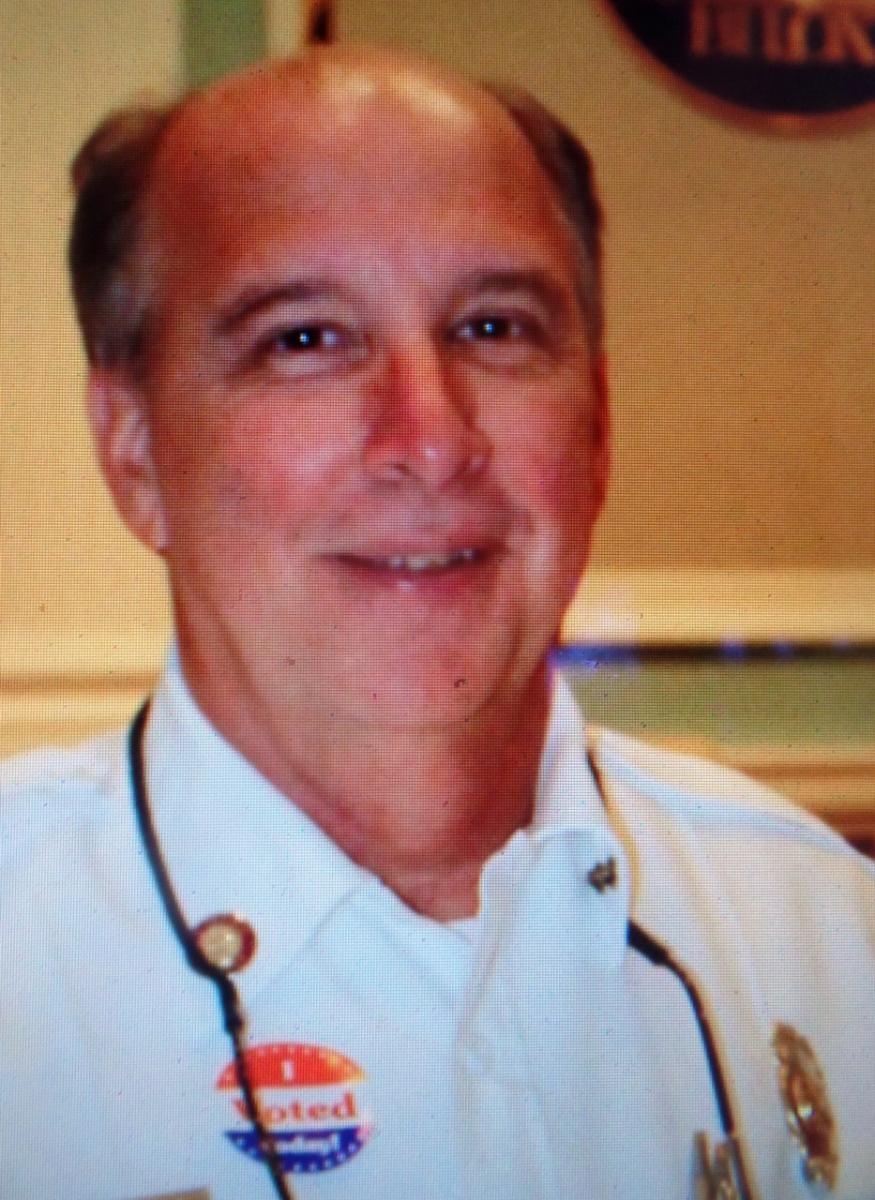
Joseph Boney-confirmed as Fire Chief by City Council on July 9, 2013. Mark Dronet named assistant chief on July 11, 2013.(The Sun Herald, July 10, 2013, p. A2 and July 12, 2013, p. A2)
In mid-July 2021, Chief Joseph Boney considers retirement as he believes that the Biloxi Council is not 100% in favor of his reappointment by Mayor Gilich.
On July 20, 2021 the Biloxi City Council voted not to reconfirm Boney [4-3 vote], which gave the Mayor 90 days to nominate a new fire chief. This came after a report that Boney and a supervisor at the fire department were investigated by the state auditor.
2021
Nicholaus Geiser
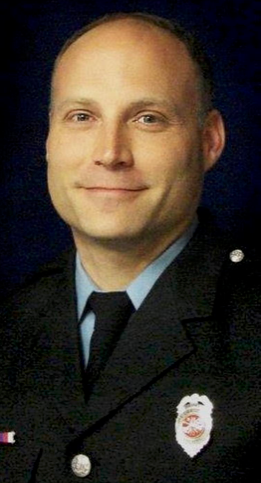
Mayor Andrew “FoFo” Gilich had 90 days from July 20 to nominate a new fire chief, but he’ll submit a candidate to the Biloxi City Council on Tuesday..
Nicholaus Geiser, a 17-year veteran of the Biloxi Fire Department, is the mayor’s choice, according to the agenda for the Aug. 3 meeting. If he is approved by the council, his salary would be $85,000.
Geiser, age 41, was promoted to captain five years ago in 2016. A Biloxi native, he completed his Bachelor of Science degree in accounting and business management at University of Southern Mississippi and has been deputy chief of training and city emergency manager.
Gilich also announced that Jason Earl Davis will become the department’s assistant chief. That position was held by Mark Dronet before he retired earlier this year. Davis is deputy chief for training,
On July 6, Chief Joe Boney announced his plan to retire at the end of the year after he learned that some of the council members were planning to remove him as chief. On July 20, the council voted not to reconfirm Boney, which gave the mayor 90 days to nominate a new fire chief. This came after a report that Boney and a supervisor at the fire departmentwere investigated by the state auditor.
Gilich has since notified the city that his last day on the job will be Aug. 5The council can either approve Geiser as chief, or vote against his appointment and ask the mayor to submit another candidate.
https://www.sunherald.com/news/local/counties/harrison-county/article253123683.html#storylink=cpy
REFERENCES:
The Biloxi Herald, “”,
The Biloxi Herald, “”,
The Biloxi Herald, “”,
The Biloxi Herald, “”,
The Biloxi Herald, “”,
The Biloxi Herald, “”,
The Biloxi Daily Herald, “”,
The Biloxi Daily Herald, “”,
The Biloxi Daily Herald, “East End Hose Company”, October 6, 1904.
The Biloxi Daily Herald, “East End”, October 8, 1904.
The Biloxi Daily Herald, “Prominent citizen [Philip McCabe] dead”, December 16, 1904.
The Biloxi Daily Herald, “Mask Ball”, December 22, 1904.
The Biloxi Daily Herald, “”,
The Biloxi Daily Herald, “Prominent citizen [Philip McCabe]dead”, December 16, 1905.
The Biloxi Daily Herald, “”,
The Biloxi Daily Herald, “”,
The Biloxi Daily Herald, “”,
The Biloxi Daily Herald, “East End Hose Company No. 1”, September 19, 1907.
The Biloxi Daily Herald, “”,
The Daily Herald, “Three Biloxi Cottages destroyed by fire”, April 26, 1910.
The Daily Herald, “Back Bay Company started in 1904 grow steadily”, September 20, 1915.
The Daily Herald, “$98,000 Fire in Biloxi early Sunday morning”, May 24, 1926.
The Daily Herald, “Biloxi Mayor talks on Fire”, May 29, 1926.
The Daily Herald, “Sentell with City 30 years”, December 7, 1937.
The Daily Herald, “$2000 fire damage to Kress Co. store”, November 13, 1942.
The Daily Herald, “Biloxi Officials”, January 4, 1943.
The Daily Herald, “With Coast Men, Women in Armed Service”, September 19, 1944.
The Daily Herald, “Heavy water damage results from Biloxi fire”, October 28, 1944.
The Daily Herald, “Start repairing Biloxi fire loss”, October 31, 1944.
The Daily Herald, “New Fire Chief”, July 6, 1953.
The Daily Herald, “Assistant Fire Chief”, July 6, 1953.
The Daily Herald, “Lehman-McCaleb”, May 3, 1958.
The Daily Herald, “Three Captain promotions for Biloxi firemen”, September 27, 1958.
The Daily Herald, “Fire breaks out at Biloxi A&P; Damage is heavy”, August 26, 1959, p. 1.
The Daily Herald, “Gabrich Chief of Biloxi Fire Department”, July 3, 1961.
The Daily Herald, “Biloxi names [Harold] Windom to head Fire Department", January 8, 1985.
The Daily Picayune, “”,
The Daily Picayune, “Burnt Biloxi”, June 6, 1889.
The Daily Picayune, “”,
The Daily Picayune, “”,
The Daily Picayune, “”,
The New Orleans Item, "Sunday Runaway", September 19, 1910.
The Sun Herald, “John T. Poulos Sr.”, March 22, 2002.
The Sun Herald, “Guy B. Roberts Sr.”, February 26, 2009.
The Sun Herald, “Gabriel Lehman, Jr.”, September 22, 2010.
The Sun Herald, “Fire chief’s [Joseph Boney] first emergency call at meeting confirming him”, July 10, 2013, p. A2.
The Sun Herald, “Dronet named Biloxi’s assistant fire chief”, July 12, 2013, p. A2.
The Sun Herald, “”,
- 5323 views
Hurricanes
Hurricanes
- 732 views
HURRICANES
HURRICANES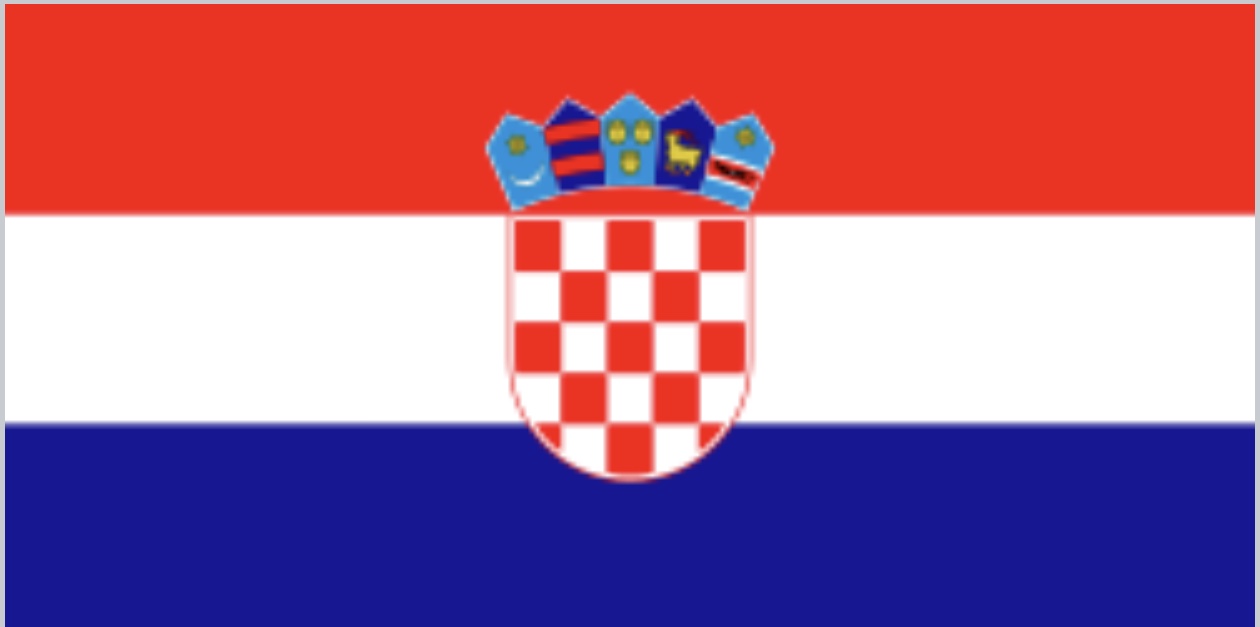
- 1062 views
Mardi Gras
Mardi Gras
BILOXI MARDI GRAS
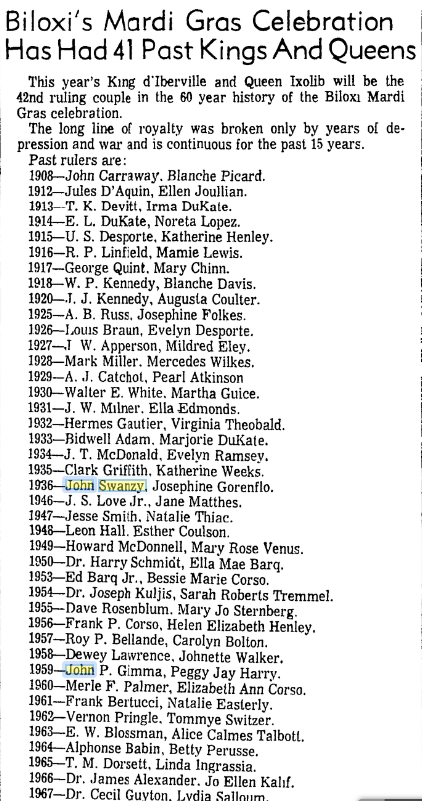
[The Daily Herald, February 16, 1968, p. 17]
TIME LINE
1880-Biloxi was nearly deserted on Mardi Gras day. The Camelia carried nearly seventy-five passengers to NOLA.(The Pascagoula Democrat-Star, February 20, 1880, p. 3)
1883-According to Mayor Ed Glennan, a Mardi Gras celebration was held in Biloxi in 1883.
1888-In February, Harry T. Howard (1856-1933) and Lydia Fairchild ruled Carnival at NOLA.(The Times Picayune, February 20, 1966, p. 117)
1895-In February, Frank T. Howard (1855-1911) and Genevieve Cottraux ruled Carnival at NOLA.(The Times Picayune, February 20, 1966, p. 117)
1900
1908
What is considered to be the first Mardi Gras celebration at Biloxi occurred on March 3, 1908.
John Carraway(1873-1931), King Bienville I, and Blanche Picard (1887-1930+), his Queen, was the daughter of Bernard Picard (1853-1896) and Sarah Levy Picard (1859-1927). Bernard Picard was born in Alsace, France. Mr. Picard came to Biloxi circa 1889, and was the proprietor of Picard's Emporium, a dry goods store, located in the Eistetter Building on Howard Avenue at Magnolia Street. He expired on May 23, 1896, of stomach cancer at his 128 Main Street residence. His corporal remains were interred at New Orleans.(The Biloxi Herald, May 23, 1896, p. 8).
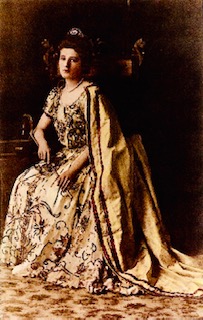
Blanche Picard
Blanche Picard (1887-1930+), a native of New Orleans, graduated from Biloxi High School in May 1904 and Elizabeth College, Charlotte, North Carolina before she married Solomon Edward ‘Sollie’ Levy (1882-pre-1930). Sollie E. Levy was born at Newborn, Alabama. At Biloxi on August 27, 1908 in the Presbyterian Church, Rabbi Mose Bergman of New Orleans performed their nuptials. Phil Riser of Demopolis, Alabama and Florence Picard, sister of the bride, were Best Man and Maid of Honor respectively in their wedding. Sollie E. Levy was a successful traveling salesman. The couples was home was in or near St. Louis, Missouri.(The Biloxi Herald, August 14, 1908, p. 1 and August 27, 1908, p. 1 and Harrison Co., Mississippi MRB 21, p. 38)
Philadelphia
John Carraway-King Bienville I
John Carraway (1873-1931) came to Biloxi in 1893. He was born at Jackson, Mississippi the son of John C. Carraway (1843-1901) and Arcola Carraway (1848-1933), both natives of the Magnolia State. In 1900, he and Mae Litel Carroway (1878-1930+), his spouse, a native of Albany, Wisconsin were domiciled on Front Street at Biloxi, where he made his livelihood as cashier for the Bank of Biloxi. Mr. Carraway matriculated to the University of Mississippi. At Biloxi, he was active in the Elk, Odd fellow, Woodman of the World, and Masonic Lodge. First president of the BYC. His parents and Tennie Carraway Moreland (1880-1905+), his Texan born cousin, were also domiciled on Front Street at this time.(The Daily Herald, p. 51 and 1900 Harrison County, Mississippi Federal Census T623 808, p. 1A, ED 31, and The Biloxi Daily Herald, July 29, 1907, p. 2)
John Carroway was a candidate for Beat One Board of Supervisors of Harrison County in 1907.(The Biloxi Daily Herald, July 29, 1907, p. 2)
King Bienville with Blanche Picard (1887-1930+), as queen, of Biloxi’s initial Mardi Gras in March 1908.
1910
1912
Jules D’Aquin (1877-1936) and Ellen J. Joullian [m. Byron P. Lyons]. Their court: King Aurguis I; W.S. McIntyre; W.J. Thomas; W.H. Hunt; P.H. Prieur; John F. Eistetter; and Charles M. Lanius.
1913
Thomas K. Devitt and Irma Dukate [m. Daniel J. Gorenflo]
1914
Elbert L. Dukate (1881-1943) and Noreta Lopez [m. Rucks Yerger Jr.]
1915
Ulysse S. Desporte (1861-1927) and Katherine Louise Henley [m. Edward McColl]
1916
R.P. Linfield and Mamie Lewis [m. John Francis]
1917
Mardi Gras 1917 was celebrated on February 20th and ruled over by George C. Quint (1886-1967) and Mary Chinn (1891-1958), who later married John F. Eistetter. The theme of the six-float night parade was ‘Centennial Spirit’ to commemorate the Mississippi statehood centennial (1817-1917). N. Salvadore Navarro (1869-1953) designed and built the floats. H.E. Blakeslee of the Mississippi Centennial Commission in Gulfport(The Daily Herald, January 23, 1917, p. 1 and February 21, 1917, p. 1)
In late 1917, with World War I raging in Western Europe, the 1918 Mardi Gras was cancelled at New Orleans. Mayor Glennan was enamored with celebrating Mardi Gras at Biloxi and called a meeting of the Biloxi Carnival Association in late December 1917 to ascertain if the business community desired to have a Mardi Gras day fete.(The Daily Herald, December 29, 1917)
1918
William P. Kennedy, King Arguis VII, and Blanche Davis [m. William E. Thompson], Queen Ixolib VII, ruled the Biloxi Mardi Gras and Elk's Ball on February 11, 1918.(The Daily Herald, February 11, 1918, p. 1 and February 12, 1918, p. 3)
1919
WW I postponed.
General John J. ‘Black Jack’ Pershing
1921
and Evelyn E. Desporte Thompson (1904-1986) ruled the Biloxi Mardi Gras on February 8th.
1922
1923
1924
1925
Dr. Albert Brown Russ and Josephine Folkes [m. Albert Brown Russ and Thomas Burns] were King and Queen of the Biloxi Mardi Gras on February 24th.
1926
Louis Braun and Evelyn E. Desporte [m. Hollis Calvin ‘Tommy’ Thompson]
1927
Les Masques held their fifth annual Mardi Gras Ball at the Biloxi Elk's Club on February 11th. Miss Amelia Castanera (1905-2000) [m. General John A. O'Keefe], the daughter of Captain Frank B. Castanera (1870-1934) and Amelia Desporte (1880-1953),was the Queen.(The Daily Herald, February 12, 1927, p. 1)
John Wright Apperson and Mildred Eley (1902-1992) ruled on March 1, 1927. Mildred was the daughter of Dr. William W. Eley (1875-1944) and Florence Keahey (1874-1948). She married Frank Kennedy. Dr. Eley was a general medical practitioner and the family resided on West Beach. Her siblings were: Clifton C. Eley (1905); and Eugenia F. Eley (1910).
1928
Mark L. Miller and Mercedes Wilkes [m. William L. Parks]
1929
Antonio J. Catchot (1864-1954) of Ocean Springsand Pearl Lee Atkinson [m. Louis J. Gutierrez] ruled the 1929 Biloxi Mardi Gras.
Antonio J. Catchot, called Captain Tony, was born on January 29, 2864 at Ocean Springs, Mississippi to Jose' Catchot (1823-1900), a native of Minorca in the Balearic Islands off the eastern coast of Spain, and Julia A. Smith (1823-1903), an 1847 immigrant from Limerick, Ireland, and the widow of John Hays.
On October 1, 1882, Tony Catchot joined the L&N Railroad. A.J. Catchot's engineering abilities were so impressive that in October 1894, he was sent to Pensacola, Florida to assist in building the Muscogee wharf, the docks at Commandancia and Tarrangona Street, and a coaling station for U.S. Steel. In 1900, the L&N loaned him to the U.S. Navy to rebuild the docks at Warrington, Florida. He then went to the Dry Tortugas to construct wharves and a condensing plant. Catchot was also loaned to the Gulf & Ship Island Railroad to erect the piers at Gulfport in 1901.
Tony Catchot returned to the L&N Railroad in 1902, and was promoted to Superintendent of the Bridge and Building Department of the New Orleans-Mobile Division in 1907. He remained as this prestigious post until 1943. A.J. Catchot had bought the old Louis Darring property on the southeast corner of Washington and Desoto in 1897. He built a new structure here commencing in February 1897. It served as a saloon until it closed in April 1899, leaving George Arndt's Paragon Saloon the only one in town. Catchot later rented the structure to various merchants.
Through the years many honors and awards were bestowed upon Captain Catchot. He was a board member of the Farmers and Merchants State Bank in 1915, and elected president of the bank in September 1925. In May 1925, Catchot formed the Superior Oil Company of Ocean Springs with J.J. Kennedy and F.B. Royster. The purpose of this $15,000 capitalized company was to market gasoline and oil in the area.
Tony Catchot was elected president of the L&N Veterans Club for the New Orleans- Mobile Division in the late 1920s. In 1929, he reigned as King d'Iberville of the Coast Mardi Gras Association. Catchot was a charter member of the Ocean Springs Fire Company No. 1 joining in 1880, and serving as its fire chief for nearly sixty years.
Antonio John Catchot retired from the L&N on January 1, 1947, after sixty-four years of loyal and meritorious service to that organization. He died on August 11, 1954, at Handsboro, Mississippi. Catchot's remains were interred at the Evergreen Cemetery on Fort Bayou.
1930s
1930
Walter E. White and Martha R. Guice [m. William M. Harrison]
1931
J.W. Milner and Ella E. Edmonds [m. Irwin M. Cowie Jr.]
1932
Hermes Gautier (1894-1969) and Virginia Theobald (1909-1995) [m. John Lockett]
1933
Bidwell Adams and Marjorie Dukate
Leslie B. Grant and Vera Bond ruled the Les Masques Mardi Gras Ball.(The Daily Herald, February 15, 1933, p. 2 with photos)
1934
John T. McDonald of Bay St. Louis and Evelyn Ramsay of Ocean Springs ruled the Mardi Gras at Biloxi on February 13th with the theme 'Seven Cities by the Sea'.(The Daily Herald, February 14, 1934, p. 1)
Biloxi's Negro community with King Zulu and his Hula warriors, Indians and Voodoo witch doctor, paraded through Biloxi's central business district on Mardi Gras eve. King Zulu ruled at the Mardi Gras ball held at the Suburban Gardens on Main Street after the parade had ended.(The Daily Herald, February 14, 1934, p. 5)
Fifty children, residing in the 'Possum Neck' neighborhood [Claiborne Street, Dorries Street and Pearl Street] east Biloxi, and sponsored by H.R. Richmond, held a junior carnival parade in their neighborhood. The four floats were designed by the children with Rene Alford and Kathryn Hecht as rulers of 'Possum Neck'.(The Daily Herald, February 15, 1934, p. 2)
1935
Clark C. Griffith and Katherine Weeks.
1936
The Billikens, a carnival club of seventy-five maids and matrons, was organized at Biloxi on January 3, 1936. The initial officers were: Myrtis B. Whetstone [Cline] captain; Eleanor G. Youska Baker, secretary; Annie Lang [Strayham], treasurer; Avis Linnelle Welch [Vignes]; Ada Moore, and Mrs. John Gryder, board members. The Billikens held their first masked dance on February 7, 1936.(The Daily Herald, January 7, 1936, p. 2)
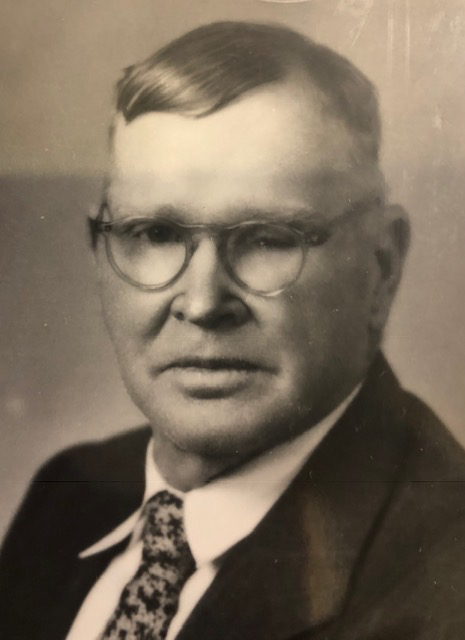
John A. Swanzy and Thelma Josephine Gorenflo [m. Lewis Edward Curtis Jr.]
1937
No celebration-1946
1938
Dixie Hollis and Catherine DeMiller [1st Junior Carnival)
Homer Redford Richmond and J.B. Richmond will enter four floats in the Junior Carnival parade on Mardi Gras Day. Every year, the children in their neighborhood have held a juvenile parade. This year they will form a part of the Coast wide Mardi Gras parade on Mardi Gras Day.(The Daily Herald, February 24, 1938, p. 2)
1939
John E. Dunnavant and Betty Grayson [2nd Junior Carnival] on February 29th.
1940s
1940
Mardi Gras on February 6th.
Clare Joachim and Forrest M. Runnels ruled the Billikens Ball.(The Daily Herald, February 8, 1941, p. 7)
1941
Miss Martha Burnett and Carl Winecoff ruled the Billikins Ball.(The Daily Herald, February 8, 1941, p. 7)
Miss Laurie Wilkes and Alf Dantzler ruled at the 19th Les Masques Ball.(The Daily Herald, February 15, 1941, p. 2)
Mrs. F.S. Eastland and Captain Dewey Reagan ruled the Mithras Ball.(The Daily Herald, February 15, 1941, p. 2)
Alonzo Parker, King Roxie, and Alice Wells, Queen Isabella, led eight floats with Colored riders through Biloxi's Downtown from Main and Division Streets celebrating Mardi Gras. The Black participants also rode horses, cars, and bicycles. Biloxi's White community did not parade in 1941.(The Daily Herald, February 23, 1941, p. 6, February 24, 1941, p. 3 and February 25, 1941, p. 1)
Our Mother of Sorrows Catholic colored school held a carnival parade on February 23rd. Nine floats carried children dressed in appropriate costumes representing: Uncle Sam and Miss Columbia' Kights and Ladies; Indians; and Miss Our Mother of Sorrows of 1941. The Sisters of the Blessed Sacrament who teach at the school planned and worked diligently to produce the parade. An orchestra, riders on gayly colored bicycles led the celebrants.(The Daily Herald, February 24, 1941, p. 3)
1942
WWII no celebration.
1943
WWII no celebration. Mardi Grad on March 9th.
1944
WWII no celebration. Mardi Gras on February 22nd.
1945
WWII no celebration. Mardi Grad on February 13th.
1946
James Love, King d'Iberville, and Jane Dukate Matthes [m. Joseph Edward Owen] (1920-2010). Mardi Gras held on on March 5th. King Zulu arrived aboard the 40-foot yacht, Metrus, at the Community House pier.(The Daily Herald, march 6, 1946, p.1)
1947
Jesse Smith, King d'Iberville and Natalie Thiac. Mardi Gras on February 18th.
1948
Mardi Gras day was observed on February 10th with Queen Esther Coulson, daughter of Mrs. Mattie Coulson, and King d'Iberville Leon Hall, spouse of Mercedes Williams, ruling the festivities.(The Daily Herald, February 6, 1948, February 11, 1948, p. 1)
1949
Howard McDonnell (1909-1992), Biloxi attorney and politician, and Mary Rose Venus Tacon (1927-1992), ruled the Biloxi Mardi Gras celebration on March 1st. Clinton Bolton (1944-1997), King Arguis, and Gayden Fritz Purcell, Queen Tevalliac, were monarchs of the Children's Mardi Gras festivities.(The Daily Herald, March 2, 1949, p. 1)
1950s
1950
Harry Johnson Schmidt, MD (1905-1997) and Ella Mae Barq on February 21st.
1951-Korean War no celebration.
1952-Korean War no celebration.
1953
Edward Barq Jr. (1921-1971) and Bessie Marie Corso [m. ] on February 17th.
1954
Dr. Joseph Luka Kuljis (1909-) and Sarah Roberts Tremmel [m. Marion Daniel Pitalo] ruled the Biloxi Mardi Gras on March 2nd.(The Daily Herald, March 2, 1954, p. 1)
1955
February 22nd.
1956
February 14th
1957
Roy Peter Bellande (1895-1964) and Carolyn McKellar Bolton, the daughter of Dr. Eldon Langston Bolton (1913-1990) and Carolyn Howard McKellar (1913-1996), ruled Mardi Gras on March 5th.(The Daily Herald, March , 1957)
1958
February 18th.
1959
February 10th
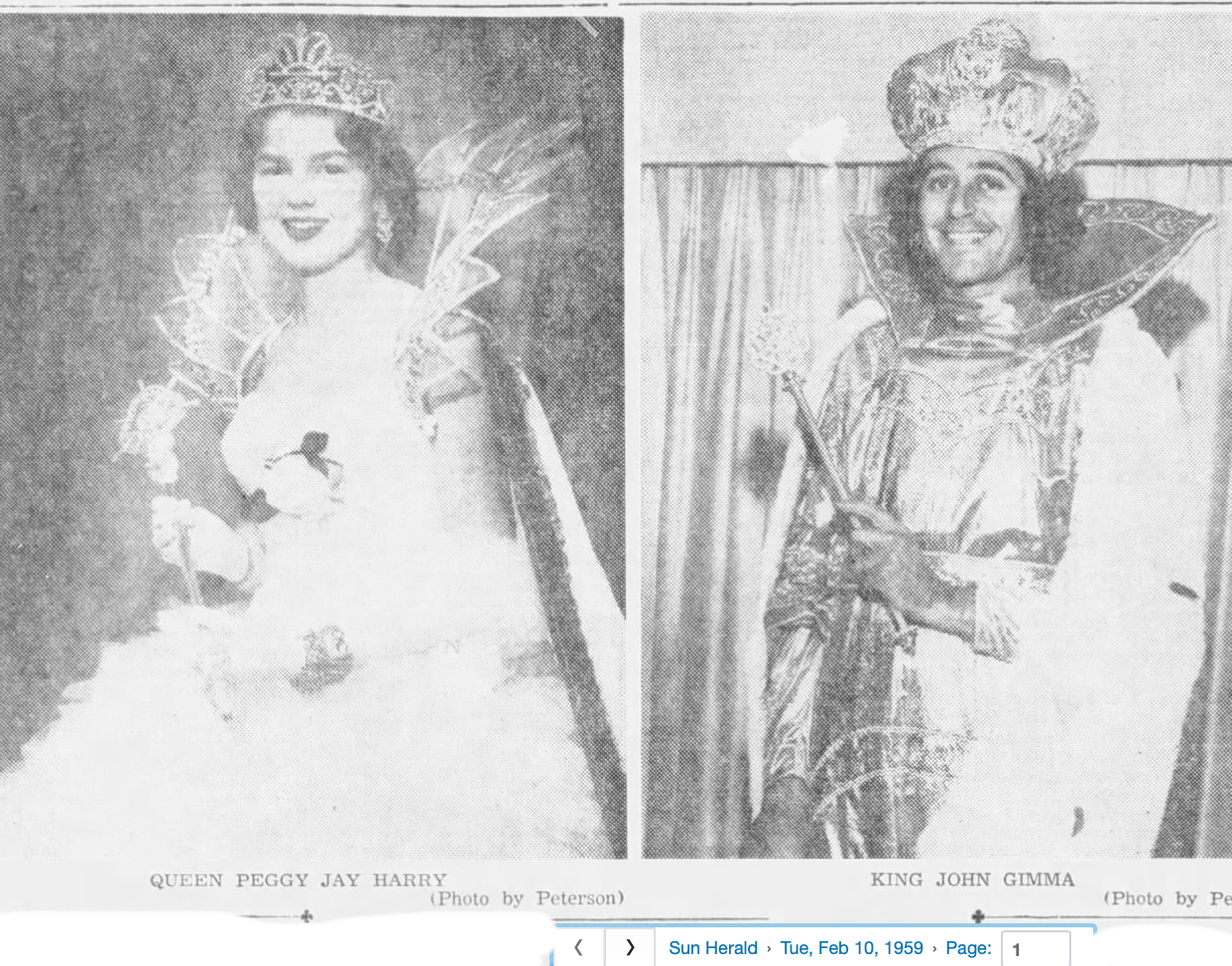
1960
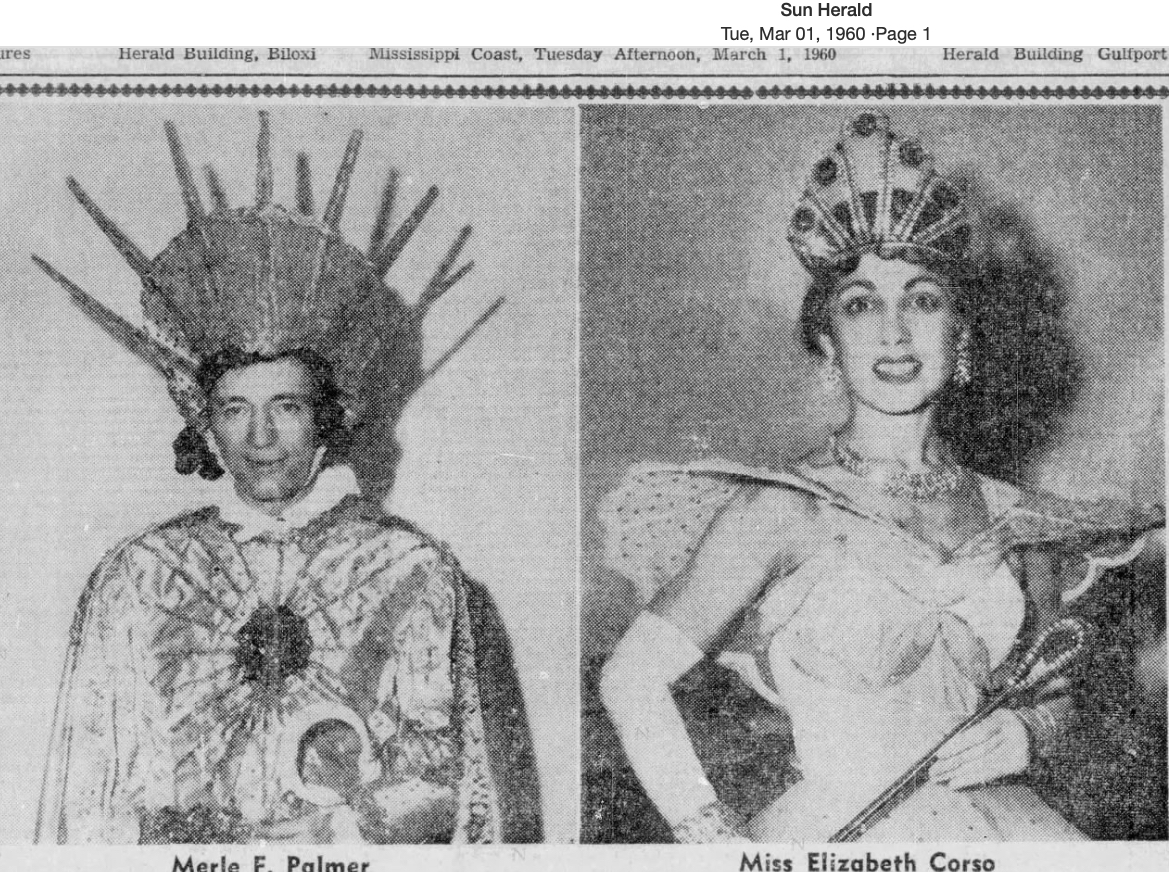
Merle F. Palmer (1919-1990) and Elizabeth ‘Liz’ Ann Corso, daughter of Frank P. Corso and Pearl Harvey, ruled mardi Gras on March 1st. She married John Schappert Joachim Jr. on November 26, 1960.(MRB 118, p. 43)
1961
February 14th.
1962
March 6th.
1963
Edward W. ‘Woody’ Blossman (1913-1990) and Alice Calmes Talbott ruled mardi Gras on February 26th. Woody Blossman was elected president of the Gulf Coast Carnival Association for 1964.(The Daily Herald, January 3, 1964, p. 1)
1964
February 11th.
1965
Queen Ixolib Linda Dorothy Ingrassia (b. 1943) [m. John Calvin Mozingo II] of Gulfport and a senior at Ole Miss, and King d'Iberville T.M. Dorsett (b. 1915), native of Texas City, Texas and manager of construction and marina at Broadwater Beach Hotel, ruled the Mardi Gras on March 2nd.(The Daily Herald, March 2, 1965, p. 1 and March 3, 1965, p. 1)
Biloxi Mardi Gras medallions planned to be cast. Designed by .(The Daily Herald, Decmebr 12, 1965, p. 27)
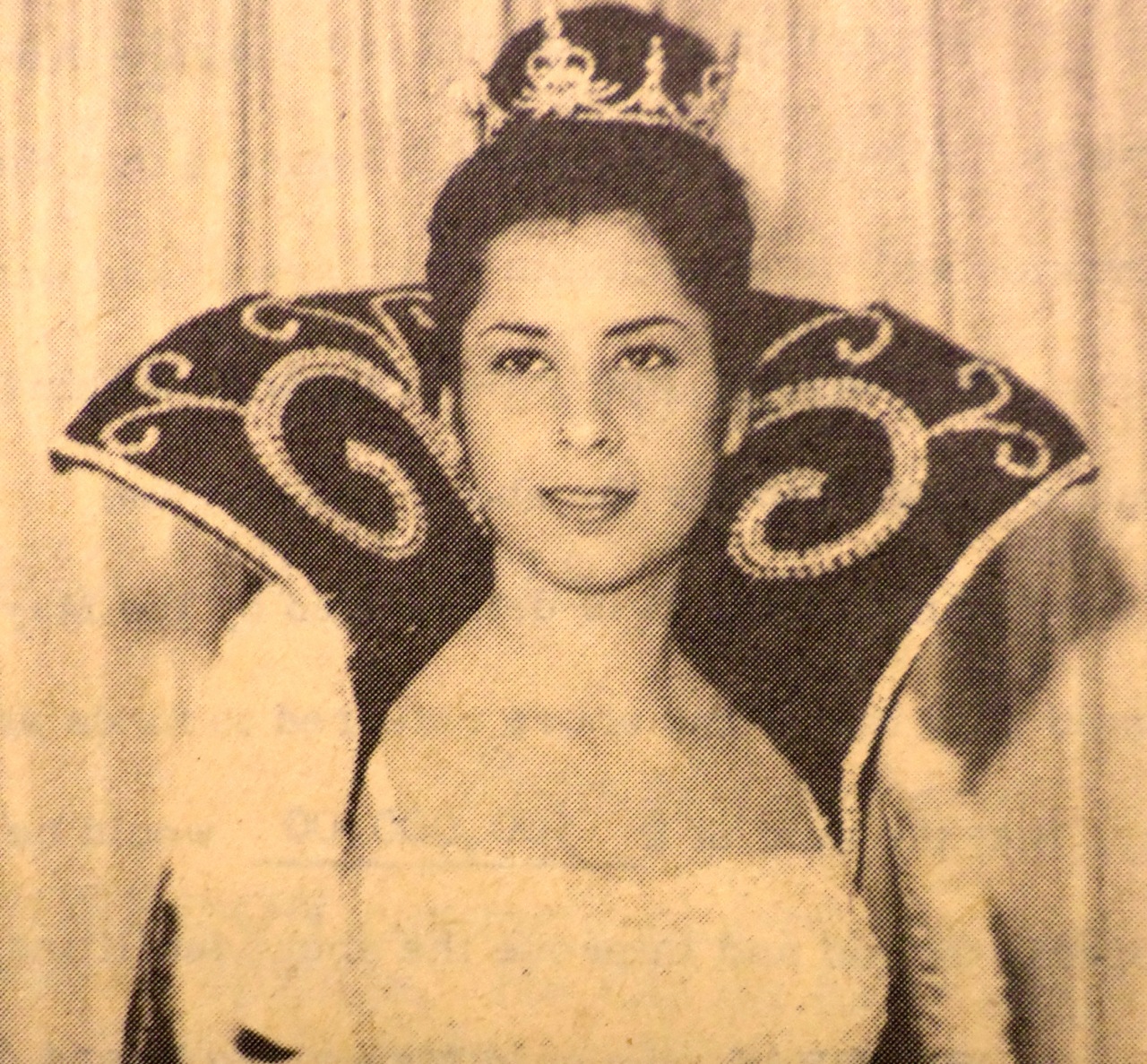
Jo Ellen Kalif
James E. Alexander, MD and Jo Ellen Kalif ruled Mardi Gras on February 22nd.(The Ocean Springs news, February 24, 1966, p. 1)
1967
February 7th.
1968
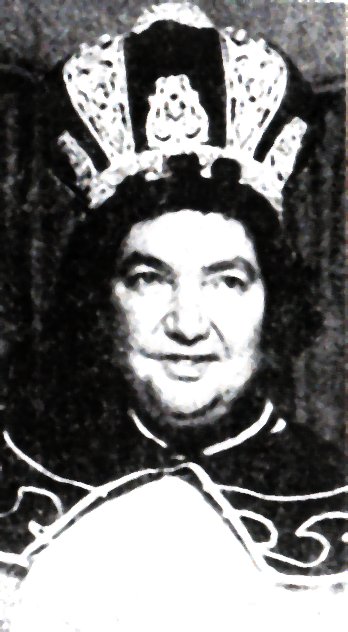
Donald W. Cumbest -King d'Iberville
Queen Ixolib, Sandra Hatten [later Mrs. William Charles Hartwell Jr.], of Gulfport and Donald W. Cumbest (1925-1995), Pascagoula attorney, city judge, and 19th JD Districy Attorney, ruled the Mardi Gras in Biloxi on February 27th.(The Daily Herald, February 27, 1968, p. 1)
1969
February 18th.
1970s
1970
February 10th.
1971
February 23rd.
1972
February 15th.
1973
March 6th.
1974
-1974 King.jpg)
John R. Blossman (1943-2009)
John R. Blossman (1943-2009), King d'Iberville and Laurie James Turnbough, Queen Ixolib, ruled the Gulf Coast Carnival Association Mardi Gras at Biloxi on February 26, 1974. The theme was the 250 Anniversary of the Biloxi Bay Colony.(The Ocean Springs Record, February 28, 1974, p. 1)
1975
February 11th.
1976
March 2nd.
1977
February 22nd.
1978
Jack Thompson, son of Hollis C. ‘Tommy’ Thompson and Evelyn Desporte Thompson (1904-1986), Queen Ixolib of 1915. Mardi Grad day February 7th.
1979
1980s
1980
1981
1982
1983
1984
1985
1986
1987
1988
1989
February 7th.
1990

1990-February 27th.
1991-Queen Ixolib Donna Michelle Haynes of Gulfport and King d'Iberville Joseph C. Wink Jr. of Diamondhead ruled the GCCA Mardi Gras on February 12th.(The Sun Herald, February 10, 1991, p. E1)
1992
1993
1994
1995
1996-
1997
1998
1999
2000
2000
2001
2002
2003
2004
2005
2006
2007
2008
Mardi Grad on February 5th.
2009
Mardi Gras on February 24th.
2010s
Mardi Gras on February 16th.
2011
Mardi Gras on March 8th.
2012
Christina Ann Carter and Mark Donlon Mavar ruled as Queen Ixolib and King d'Iberville on February 21st as The Gulf Coast Carnival Association celebrated Mardi Gras in Biloxi.(The Sun Herald, February 19, 2012, p. F1)
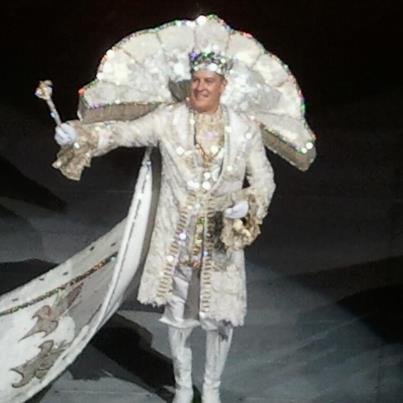
King Iberville-James Wetzell
2013
Mardi Gras on February 9th.
2017
2018
2019
Mardi Gras on March 5th.
REFERENCES:
The Biloxi Daily Herald, Business and Professional Men, (The Biloxi Daily Herald: Biloxi, Mississippi-1902).
Journals
1890s
The Biloxi Herald, “Death of Bernard Picard”, May 23, 1896.
The Daily Biloxi Herald, “”, .
The Biloxi Daily Herald, “”, .
1900s
The Biloxi Daily Herald, “Among the Candidates”, July 29, 1907.
The Biloxi Daily Herald, “Biloxi Mardi Gras now a certainty”, February 29, 1908.
The Biloxi Daily Herald, “Biloxi first Carnival a success beyond expectations”, March 4, 1908.
The Biloxi Daily Herald, “Story of the Big Parade”, March 4, 1908.
The Daily Picayune, “Mardi Gras at Biloxi”, March 4, 1908.
The Biloxi Daily Herald, “City News”, August 14, 1908.
The Biloxi Daily Herald, “Levy-Picard”, August 27, 1908.
1910s
The Daily Herald, “Chiapella gets title from King”, February 21, 1912.
The Daily Herald, “Most auspicious Mardi Gras in Biloxi’s history today”, February 16, 1915.
The Daily Herald, “ ”, February 17, 1915.
The Daily Herald, “Carnival plans start last night”, January 13, 1917.
The Daily Herald, “Blakeslee assure Carnival success”, January 23, 1917.
The Daily Herald, “Spectacular scenes mark the close of Gulf Coast’s greatest Carnival”, February 21, 1917.
The Daily Herald, “McColl-Henley”, February 11, 1918.
The Daily Herald, “King and Queen of Mardi Gras to come to Biloxi shores”, February 11, 1918.
The Daily Herald, “Elk's Ball is splendid”, February 12, 1918.
The Daily Herald, “Rapid rise of former Biloxian”, September 24, 1918.
1920s
The Daily Herald, “Thousands view spectacle of Biloxi’s Mardi Gras”, February 25, 1925.
The Daily Herald, “Fifth annual Masques Ball [Les Masques] scene of exotic brilliance”, February 12, 1927.
The Daily Herald, “Ocean Springs first to enter Mardi Gras", December 20, 1927.
The Daily Herald, “King D'Iberville nears capital city”, February 1, 1929.
1930s
The Daily Herald, “History of Biloxi Mardi Gras observance given”, February 17, 1931.
The Daily Herald, “Carraway Funeral”, August 19, 1931.
The Daily Herald, “Carraway Funeral”, August 21, 1931.
The Daily Herald, “John Carraway buried”, August 24, 1931.
The Daily Herald, “Iberville in Biloxi for annual visit, guns boom welcome”, February 9, 1932.
The Daily Herald, “King and Queens of Past Years”, February 9, 1932.
The Daily Herald, “Reign as King [Leslie B. Grant] and Queen [Vera Bond] of Les Masques at Biloxi”, February 15, 1933.
The Daily Herald, “Biloxi enjoys festivities”, February 14, 1934.
The Daily Herald, “Will announce Queen tonight”, February 13, 1934.
The Daily Herald, “Zulu celebration held in Biloxi”, February 14, 1934.
The Daily Herald, “New Carnival organization”, January 7, 1936.
The Daily Herald, "Miss [Josephine] Gorenflo Queen”, February 26, 1936.
The Daily Herald, "Four more floats in Biloxi parade”, February 24, 1938.
1940s
The Daily Herald, “Martha Burnett and Carl Winecoff rule Billikins”, February 8, 1941.
The Daily Herald, “Miss [Laurie] Wilkes and Alf Dantzler rule [Les Masques]”, February 15, 1941.
The Daily Herald, “Captain Dewey Reagan and Mrs. F.S. Eastland rule ball [Mithras]”, February 22, 1941.
The Daily Herald, “Colored Carnival Parade at Biloxi”, February 23, 1941.
The Daily Herald, “Colored Carnival Parade is planned”, February 24, 1941.
The Daily Herald, “Kiddies frolic for Mardi Gras at Biloxi”, February 25, 1941.
The Daily Herald, “King d'Iberville arrives Tuesday on Barq Yacht", February 6, 1948.
The Daily Herald, “Miss Matthes, Carl Winecoff Mithras rulers”, February 7, 1948.
The Daily Herald, “Observed Carnival at Biloxi", February 11, 1948.
The Daily Herald, “McDonnell, Miss Venus rule at Biloxi”, March 2, 1949.
1950
The Daily Herald, “”, , .
The Daily Herald, “Elect Ed Barq Jr. president Biloxi Carnival group”, March 27, 1953.
The Daily Herald, “King d'Iberville, Queen Ixolib rule Biloxi fete”, March 2, 1954.
1960
The Daily Herald, “Blossman head Coast Carnival organization”, January 3, 1964.
The Daily Herald, “Reveal mysteries of Coast mardi Gras”, March 1, 1965.
The Daily Herald, “1965 King d'Iberville is Dorsett”, March 2, 1965.
The Daily Herald, “Queen is Miss Linda Ingrassi”, March 2, 1965.
The Daily Herald, “T.M. Dorsett, Miss Ingrassi rule Mardi Gras”, March 2, 1965.
The Daily Herald, “Carnival is climaxed with Biloxi parade”, March 3, 1965.
The Daily Herald, “Biloxi medals for Mardi Gras are being cast”, December 12, 1965.
The Daily Herald, “1927 Queen Ixolib now resides in Long Beach”, February 3, 1966.
The Times-Picayune, “The Roll of Rex”, February 20, 1966.
The Daily Herald, “Biloxi Carnival Clubs look ahead to new themes for 1967 tableaux”, February 21, 1966.
The Daily Herald, “Dr. Alexander is d’Iberville; Miss Kalif is Ixolib”, February 22, 1966..
1970
The Daily Herald, “Thompson family reigns again in Biloxi”, February 6, 1978.
The Daily Herald, “”, , .
The Daily Herald, “”, , .
The Daily Herald, “”, , .
The Daily Herald, “”, , .
1980
The Sun Herald, “”, , .
The Sun Herald, “”, , .
The Sun Herald, “Mark Mavar is King dIberville”, February 19, 2012, p. F1.
The Sun Herald, “”, , .
ROYALTY
Jules D’Aquin (1877-1936) and Ellen J. Joullian [m. Byron P. Lyons]
The Court: King Aurguis I; W.S. McIntyre; W.J. Thomas; W.H. Hunt; P.H. Prieur; John F. Eistetter; and Charles M. lanius.
Murders
Murders
BILOXI MURDERS
1842
Thomas Martin, a baker, died after his jugular vein was slashed with a razor by W. Woodhall, his father-in-law. Mr. Woodhall was captured and sent to Bay St. Louis on the steamer Monmouth.(The Daily Picyaune, September 10, 1842, p. 2)
1851
Bartolo San Andro, a Spaniard called Antonio, was slain on Biloxi beach on the night of July 15th with a sword cane. His alleged killer was an Italian man who was later arrested at Bay St. Louis and held for a $1000 bail.(The Daily Picayune, July 21, 1851, p. 1)
1853

[The Daily Picayune, April 12, 1853, p. 2]
1896
Jules Soule Murder
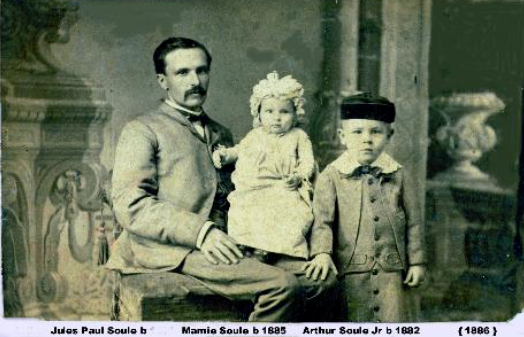
Jules P. Soule with children in 1896
While editor of The Biloxi Herald, John H. Miller (1847-1928) became embroiled with competing Biloxi editor, Jules Paul Soule (1855-1896), a native of Castillon-en-Couserans, Midi-Pyrenees, France, and the son of Bernard Dominique Jules Soule [1837-1867] and Marie Pardine Pradere [1837-1919]. His great uncle, Pierre Soule [1801-1870], was US Senator from Louisiana and US Ambassador to Spain [1853-1855]. Soule and family came to Ocean Springs from Whitecastle, Louisiana.[The Pascagoula Democrat-Star, October 23, 1896, p. 3]
In February 1896, Jules P. Soule et fils arriving from Whitecastle, Louisiana commenced The Ocean Wave, a short-lived newspaper at Ocean Springs. He became editor of the Biloxi Review when its editor, H.F. Evans, was dismissed for his scathing editorials attacking The Biloxi Herald, his competitor, and also Biloxi's Board of Aldermen, resulted in his dismissal. Unfortunately, Mr. Soule continued the Evans' policy of sarcastic denunciations and innuendoes upon the character of rivals and politicians.(The Biloxi Herald, January 25, 1896, p. 1, October 24, 1896, p. 8 and August 7, 1897, p. 1)
After several scathing articles attacking his character and reputation, Captain Miller became incensed to the point that on 7 December 1896, he shot and mortally wounded Jules P. Soule on Howard Avenue. Monsieur Soule was sent to New Orleans were he expired and later interred in the Greenwood Cemetery.(The Biloxi Herald, December 12, 1896, p. 8)
John H. Miller was acquitted of his crime against Soule by a jury in late June 1897. The innocent verdict was realized in only five minutes. Miller had many prominent gentlemen from Biloxi and other areas of Mississippi testify to his good character and moral standing.(The Biloxi Herald, July 10, 1897)
Captain Miller became a real estate magnate in Biloxi managing the Biloxi Real Estate and Loan Agency. He was also on the board of trustees of the Industrial Institute and College [later MSCW and MUW] at Columbus, Mississippi. Alice S. Miller expired at Biloxi on October 10, 1916. He died April 21, 1928 in New Orleans. Captain Miller passed a wealthy man and the citizens of Biloxi were remembered as they were gifted with funds for their incipient hospital system.(The Daily Herald, April 23, 1928, p. 2 and May 5, 1928, p. 1)
Ocean Springs, Mississippi
Jules Soule and family arrived at Ocean Springs from Whitecastle, Louisiana. Here he commenced The Ocean Springs Wave-published for 10 months in 1896 by Arthur Soule and Jules Soule, editor. Two issues (1896) available at Mississippi Department of Archives and History and on microfilm at the Pascagoula Public Library.
Baseball team
While domiciled at Ocean Springs, Jules Soule sponsored the local baseball nine. The new ball park at Ocean Springs was formally opened in June 1896 with the local squad playing Scranton. The battery from the Lopez team of Biloxi, Gaston Henderson and Adolph Abbley, led the Ocean Springs team to victory by a score of 13-8. Henderson fanned 18 batters.(The Biloxi Herald, June 27, 1896, p. 8)
Biloxi, Mississippi
In 1896, Jules Soule became editor of the Biloxi Review when H.F. Evans' policy of attacking The Biloxi Herald, his competitor, and also Biloxi's board of aldermen resulted in his dismissal and taking editorial control of The Gulfport Southward in August 1897. Captain John H. Miller was editor of The Biloxi Herald at this time and Mr. Soule contined the Evans' policy of attacking rivals in his Biloxi Review.(The Biloxi Herald, August 7, 1897, p. 1)
Civil Suit
On September 9, 1896, Lazaro Lopez, William Gorenflo, Daniel A. Nash, John C. Bradford, Raymond Caillavet and J.B. Lemon, Aldermen of the City of Biloxi filed a libel suit in the Circuit Court of Harrison County, Mississippi against H.S. Evans, editor of the Biloxi Review and local correspondent for the Daily Picayune, and the following stockholders of the journal: Edward Glennan, Louis E. Gill, Charles Redding, W.P. Henley, and E.C. Joullian. The litagation alleged that an editorial by Mr. Evans damaged the character of these well known Biloxi citizens. The plaintiffs were seeking $20,000 in damages from the defendants.(The Biloxi Herald, September 12, 1896, p. 1)
After several articles attacking his character and reputation, Captain Miller became ired to the point that he shot and mortally wounded Jules Soule, editor of The Biloxi Review on December 7th, 1896.(The Biloxi Herald, December 12, 1896, p. 8)
Captain Miller was acquitted of his crime against Soule by a jury in late June 1897. The innocent verdict was realised in only five minutes. Miller had many prominent gentlemen from other areas of Mississippi testify to his good character and moral standing.(The Biloxi Herald ,July 10, 1897)
jpg.jpg)
Captain John H. Miller
John Henry Miller (1847-1928) born December 14, 1847 at Paulding, Jasper County, Mississippi. During the Civil War, he enlisted in ‘The Jasper Grays’, Company F of the 16th Mississippi Regiment serving three year as a Lieutenant Robert E. Lee’s Army of Northern Virginia. Returning from the conflict, he married Alice Sophie Miller (1852-1916) circa 1871, and they were childless. During and post-Reconstruction, J.H. Miller was a newspaper man. (The Biloxi Daily Herald, 1902, p. 52)
Captain John H. Miller (1847-1928) assumed editorial control of The Biloxi Herald on October 31, 1896 from George W. Wilkes (1854-1915). Captain Miller left the journal on May 1, 1898 when the co-partnership, G.W. Wilkes & Company, was dissolved leaving G.W. Wiles sole owner of The Biloxi Herald.(The Biloxi Herald, June 11, 1898, p. 1 and The Daily Herald, April 23, 1928, p. 2)
In 1900, at Biloxi, the Millers lived on Front Street near the Carraway family. John H. Miller was manager of the Biloxi Real Estate and Loan Agency and was also on the board of trustees of the Industrial Institute and College at Columbus, Mississippi. Alice S. Miller expired at Biloxi on October 10, 1916. He died April 21, 1928.(1900 Harrison County, Mississippi Federal Census )
_______________________________________
FLASHBACK
Murella Hebert Powell
[published in The Sun Herald, July 27, 2014, p. F-6]
This Flashback story reflects a time when a man's honor and integrity were considered his most precious assets, and it was more or less expected that he protect those assets in a certain way.
The story involves a newspaper controversy between the Biloxi Herald, founded in 1884, and a short-lived newspaper called the Biloxi Review. The controversy ended in manslaughter.
The weekly Biloxi Review made its debut on Aug. 1, 1896, under the editorship of H.F. Evans. From the beginning, the Review practiced what was called "cut-throat competition" by launching attacks against the Herald and Biloxi's board of aldermen. The aldermen filed a libel lawsuit against the Review in September 1896 and won. The Review replaced Evans with Joules Soule, who continued Evans' same policies.
In October 1896, Capt. J.H. Miller, pictured here in 1902, of the Tupelo Journal, became the Biloxi Herald's new editor. Miller had a reputation throughout the state as a man of great integrity. About then, the Herald's owner, G.W. Wilkes, borrowed $500 from the Bank of Biloxi for new office equipment. He offered his own property and the signatures of seafood pioneers L. Lopez and W.H.K. Dukate as securities.
This opened a floodgate of insinuations by Soule of financial wrongdoing against the Biloxi Herald, and particularly upon Miller. His defamation and "scurrilous attacks" on Miller was such that the Gulf Coast Progress newspaper of Bay St. Louis stated that "no honorable or brave man could wear the stigma of Soule's denunciation and hold his head up among gentlemen."
Review issues teemed with vicious attacks on Miller. Finally, Miller avenged himself by firing a mortal shot at Soule in downtown Biloxi on Dec. 3, 1896. During his September 1897 trial for manslaughter, witnesses from along the Coast and throughout the state, including a judge from the state capital, appeared in Miller's favor. The jury was out for only 5 minutes. The verdict? Not guilty! Read more here: http://www.sunherald.com/2014/07/26/5715719/a-newspaper-war-that-went-too.html#storylink=cpy
REFERENCES:
The Biloxi Daily Herald, Business and Professional Men, (The Biloxi Daily Herald: Biloxi, Mississippi-1902).
Regina Hines Ellison, Ocean Springs, 1892, (Lewis Printing
The Biloxi Herald, “The Ocean Wave will commence about February 1st”, January 25, 1896.
The Biloxi Herald, “Safe hits”, June 27, 1896.
The Biloxi Herald, “A heavy suit for libel”, September 12, 1896.
The Biloxi Herald, “An echo of the Ocean Springs incident”, October 3, 1896.
The Biloxi Herald, “Biloxi Review and Ocean Wave”, October 24, 1896.
The Biloxi Herald, “Unwarranted insinuation”, November 21, 1896.
The Biloxi Herald, “Recorder’s Court”, December 12, 1896.
The Biloxi Daily Herald, “A statement”, December 12, 1896.
The Biloxi Herald, “Captain Miller placed on trial”, June 30, 1897.
The Biloxi Daily Herald, “Not Guilty”, July 3, 1897.
The Biloxi Herald, “Captain J.H. Miller acquitted”, July 10, 1897.
The Biloxi Daily Herald, “Result of unfortunate newspaper controversy”, July 10, 1897.
The Biloxi Daily Herald, “News story”, July 10, 1897.
The Pascagoula Democrat-Star, October 23, 1896.
The Sun Herald,'Flashback'-"A newspaper war that went to far", July 27, 2014, p. F-6.
__________________________________________________________
1897
Parkhurst Murders
Caroline F. ‘Carrie’ Boardman(1832-1897) acquires Section 20, T7S-R9W from Jacob Elmer who once had a saw mill here. Miss Boardman marries John Stevenson Parkhurst (1827-1897) in January 1894. The area now the Oak Park Subdivision becomes known as Parkhurst Point. The Parkhursts are murdered on October 21, 1897 in their Back Bay home and their bodies and domicile burned by the killer.(The Biloxi Herald, October 23, 1897 and October 30, 1897)
Harry G. Gibson(1870-1898), probably a native of New Albany, Floyd County, Indiana, was indicted on January 17, 1898 by a grand jury of the Circuit Court of Harrison County, Mississippi. He was found guilty by jury of his peers on January 29, 1898.(The Biloxi Herald, January 22, 1898)
The Mississippi Supreme Court affirmed the guilty verdict of the Circuit Court and fixed Monday, June 30, 1898 as the date for his execution.(The Biloxi Herald, May 14, 1898, p. 8)
Harry G. Gibson was hanged at Mississippi City on July 16, 1898 for the murder of John S. Parkhurst (1827-1897) and Caroline F. ‘Carrie’ Boardman Parkhurst (1832-1897). He was the first person ever legally killed for a crime in Harrison County, Mississippi.(The Biloxi Herald, July 16, 1898)
REFERENCES:
The Biloxi Herald, “Local Happenings”, January 27, 1894.
The Biloxi Herald, “A Visitor”, January 11, 1896.
The Biloxi Herald, “Latest City News”, February 20, 1897.
The Biloxi Herald, “A Fiend’s act”, October 23, 1897.
The Biloxi Herald, “The Late Horror”, October 30, 1897.
The Biloxi Herald, “Mr. and Mrs. J.S. Parkhurst”, January 15, 1898.
The Biloxi Herald, “Circuit Court”, January 22, 1898.
The Biloxi Herald, “Found guilty”, January 29, 1898.
The Biloxi Herald, “Harry G. Gibson again”, April 2, 1898.
The Biloxi Herald, “Gibson’s doom sealed”, May 14, 1898.
The Indiana State Journal, “Gibson believes that he is doomed”, June 15, 1898.
The Biloxi Herald, “Gibson executed”, July 16, 1898.
The Biloxi Herald, “County Expenses”, September 8, 1898.
______________________________________________
1900
Christina Winterstein
Christina Winterstein [1886-1900] was born in August 1886 in Harrison County, Mississippi to George W. Winterstein [1849-1933] and Margaretha Hoffmann [1850-1929]. both German immigrants and native of Alsace-Lorraine. On 2 June, 1900, Christina was butally murdered and raped by an unknown assailant o assailants which led to the equally autrocious hangings at Mississippi City of two Blackmen, Henry Askew and Ed Russell.
The investigation was held under the auspices of Marshal Robert Marion Mosley (1865-1910), a native of Kemper County, Mississippi. He married Mary Elizabeth Naylor (1869-1948), the daughter of Louis Naylor and Cornelia Ramsay, and also a native of Kemper County. There only child was Dr. Robert M. Mosley Jr. (1886-1951). Robert became a policeman at Meridian, Mississippi attaining the rank of Sergeant. The family relocated to Biloxi and he joined the BPD. Officer Mosley became Biloxi's Marshal upon the resignation of C.W. Blake in late December 1898. Robert M. Mosley resigned as Biloxi's Marshal on 2 September 1902 to become the first Chief Inspector for the Mississippi Oyster Commission which had been created by the 1902 Bower's Bill.[The Biloxi Daily Herald, September 1, 1902, p. 1]
"Horrible Atrocity"
"One of the most fearful, atrocious and heinous crimes known to the history of Biloxi occurred sometime during the day yesterday, and it had the effect, when discovered of stirring each and every one of our citizens up to a state of frenzy. Its nature, character and surroundings was just such as to do this, and no one, individually or collectively, would be expected to contain or restrain themselves under the circumstances. A bright, beautiful, pure young girl, with all alluring before her in life, ruthlessly cut down by the hand of a fiend, who sought and did destroy more than life itself, and her poor, tender body left in the woods to be discovered by her family and friends, tells a tale that is hard to believe, but which is nevertheless true and overwhelming. The victim of the fearful outrage was little Christina Winterstein, a lovely young girl about thirteen years of age, who was a pupil of the public school. She came into the city yesterday morning to attend the practices for the closing exercises. She left the city about 12 o'clock on her way home, and the last seen of her was when she left her brother's house about 12:30. When not returning about 2 o'clock her people became uneasy about her, and instituted inquiry. They came to Mr. Collins' house looking for her, having found her hat in the road coming down. Mr. Collins then started out to find the girl, and after a brief search he found blood in the road, which gave him and young Charley Foretich, who accompanined him, a clue to follow, and they found the body of the child about a hundred yards from the road, and about midway from where she was last seen and from her home. There was evidences of a struggle on the side of the road near where the fiend first attacked the little victim, and there was blood from there to where her body was found. Her remains were found at 5 p.m. There were marks on her face where she had apparantly struck with a man's fist, another mark on her breast, and the top of her head bore the mark of a blunt instrument of some sort, her scalp being laid open, and her skull fractured. The shock she sustained from the last injury would have been sufficient under the circumstances to have caused death. Dr. E. R. Bragg was summoned as soon as the child's remains were found, and after a close examination, he declared that she had been outraged after death had come to her relief The authorities were promptly notified, and a preliminary examption began, but the investigation will not be completed before some time today. In the meantime the tender remains of the girl were turned over to her family to be prepared for burial...[from The Biloxi Daily Herald, June 3, 1900, p. 1]
Reward
In late June 1900, Marshal Moseley advertised in The Biloxi Daily Herald that $200 woud be awarded to anyone who provided information that would result in the arrest of the murderer and rapist of Christina Winterstein on 2 June 1900. The Pascagoula Democrat-Star commented .[The Biloxi Daily Herald, June 24, 1900, p. 1 and The Pascagoula Democrat-Star, June 29, 1900, p. 3]
REFERENCES:
The Biloxi Daily Herald, 'Horrible atrocity', June 3, 1900
The Biloxi Daily Herald, '$200 Reward', June 24, 1900.
The Pascagoula Democrat-Star, "Mississippi Press Association versus Negro type-setters'', June 29, 1900.
The Sea Coast Echo, 'Mississippi City lynching', June 16, 1900.
__________________________________________________________________________________
The Veronica Mutiny and Trial
In August 1902, while at Ship Island, a very special event occurred in the life of Antoine Bellande. It concerned a ship mutiny. Ernest Desporte Jr. told me this tale when I was a teenager. Ernest Desporte Jr. (1888-1977) was a native of Biloxi and lifelong resident. He had a remarkable memory and enjoyed telling stories of Biloxi's early history. He also was a writer of local history and genealogy sometimes using the nom de plume, Old Timer. When I met Mr. Desporte about 1960, he was an elderly septuagenarian gentleman and of keen wit. His father, Ernest Desporte Sr.(1853-1931), had been a bar pilot and harbor master at Ship Island at the turn of the Twentieth Century. Captains Bellande and Desporte served together as fellow pilots guiding blue water barks, brigs, schooners, and steamers across the Ship Island Bar to safe anchorage at Ship Island Harbor. After 1902, they would sail these large vessels seeking Mississippi longleaf pine for the world export market into the new harbor at Gulfport.
The result of my meeting with Ernest Desporte was new knowledge about the life of Antoine Bellande. The most intriguing information was the reference to a mutiny. Desporte wrote the following for me: When Gulfport became a port about 1898, Captain Bellande was one of the pilots, piloting vessels through the Gulfport Channel into the harbor at Gulfport. On one occasion he piloted a vessel from Gulfport harbor to the open Gulf of Mexico. This vessel was bound for England, but the crew mutinied on the high seas. The crew was captured and tried in England. As Captain Bellande was the last man to see the captain and crew, he was a witness in the trial of the crew in the Royal Court of England.
Without a date for the alleged mutiny, I was never able to corroborate the tale of Captain Desporte. In the fall of 1989, I was in the history and genealogy section of the Biloxi Public Library waiting to talk to Murella Powell, archivist and historian. She was on the telephone, and I heard her speak to someone of "the mutiny at Ship Island". Immediately I thought of the account of Desporte. When she became available, I related my story, and she shared her very interesting knowledge of the subject. She had been contacted by a Canadian novelist, Bruce Wishart, who was writing a book about an episode in maritime history known as the Veronica Mutiny. Since the event commenced at Ship Island, he needed background data on the Mississippi Gulf Coast to write his novel. Murella was doing basic research for him especially concerning Ship Island.
I contacted Bruce Wishart at his residence in Brandon, Manitoba. From him I learned the details of the mutiny and with my knowledge of Captain Bellande incorporated these facts into my rendering of the story. With this background knowledge, I now present the reader the Veronica Mutiny:
At a time when most men his age had long retired or passed on, Captain Antoine Bellande and Inspector Duckworth of Scotland Yard, England were boarding an L&N train on April 15, 1903, at Biloxi. Their destination was Liverpool, England via New York where they would board the steamer, Irenia. The catalyst for this adventure had been the three-masted barque, Veronica, out of St. John, New Brunswick. The Veronica had sailed into Gulf waters south of Ship Island in August of 1902.
Captain Bellande had come to Mississippi from Marseille, France in 1851, at the age of twenty-two years. His family in France had been caulkers in a local shipyard, and the ways of the sea were natural to this young French immigrant. He had learned well the waters of the Gulf of Mexico while navigating his trading schooner the, John Randolph, to Cuba for sugar and tobacco. Occasionally, he would transport longleaf pine to Galveston and New Orleans. His maritime lore was so widely acclaimed that during the Civil War, Admiral David Farragut utilized his services for the Union Navy. His Civil War records indicate he was an acting ensign and pilot, one of only two in the entire Navy.
Antoine Bellande served the Union well. He was the pilot aboard the USS Monongahela at the Battle of Mobile Bay in August 1864, when it valiantly rammed the CSS Tennessee. After the War, Bellande settled at Back Bay (D'Iberville), and began a family with Marie Harvey (1840-1894). They moved to 254 Reynoir Street about 1882, the year he became a Ship Island bar pilot.

When Captain Bellande boarded the Veronica, he met Captain Alexander Shaw, the master of the 1167 ton vessel which was loaded during September with Mississippi lumber for Montevideo, Uruguay. The heavily laden vessel waited for a high tide and was towed across the Ship Island bar on October 11, 1902, into the waters of the Gulf of Mexico.
While at sea, the four German crewmen of the Veronica became upset with their Anglo-Saxon shipmates. While off the northeast coast of Brazil, they murdered Captain Shaw and the crew, and set the ship afire. In December 1902, the mutineers landed on the small island of Tuotoia which forms a part of the bar at the mouth of the Rio Parnaiba in northeastern Brazil. They were rescued by the SS Brunswick in mid-January 1903.
The German seamen made a fatal mistake by bringing the ship's cook Moses Thomas, a Negro, with them. On the way to England, Thomas related the tale of horror aboard the Veronica to Captain Browne. After the Brunswick reached Liverpool in late January, three of the alleged murderers were incarcerated until the trial which commenced on May 12, 1903, at the Liverpool Assizes. The fourth seaman, a youth, was given mercy.
Since Antoine Bellande was the last person to see the crew of the Veronica alive at Ship Island, he was called to testify at the trial in Liverpool. Before his departure for England with Inspector Duckworth who had been sent to Biloxi by Scotland Yard to investigate the local scene, an article of interest was printed in The Biloxi Daily Herald on April 15, 1903:
The sailor boys are very anxious concerning the visit of pilot, Antoine Bellande, to Liverpool, for they say he has never served time in the French army, and if the frog eaters in the Old World hear of his being in Europe, they fear in some manner they will get possession of him and force him to mark time and carry a gun to the great loss of the sailor craft of these waters. It is said that John Brasellman, of Dejean & Mitchell's, and John Lyons, boarding officer at Ship Island, will also be induced to go to England on the same errand.
The sworn testimony of Captain Antoine Bellande taken from The Trial of Gustav Rau, Otto Monsson, and Willem Smith: The "Veronica" Trial by Professor G.W. Keeton and John Cameron went as follows:
Antoine Bellande, sworn, examined by Mr. F.E. Smith.
I am a port pilot at Ship Island and Biloxi, and I live at Ocean Springs, four miles from Biloxi. I believe the Veronica arrived at Ship Island in ballast last August. Captain Alick Shaw was in command. She lay in quarantine for something like 15 days. I was on board during the quarantine, and was put in quarantine five days myself. I do not exactly remember either the first or second mates' names. I knew the men well, but not their names.
Tell me whether either or any or none of these men in the dock were on board then?
The middle one (Monsson) was on board when I was in quarantine. I don't know the others. I noticed nothing in particular going on on board the vessel when I was there. Captain Shaw could not hear very well; he was a little deaf.
Do you remember going on board the Veronica to take her out?
Yes, that was in October. At that time her crew consisted of twelve all told-there was Captain Shaw, the first mate and the second mate. I cannot remember the names of the other members of the crew as there were so many vessels going about. There was a man named Moses Thomas-he was the cook.
Will you look at that paper and tell us whether you saw any of those signatures made?
Yes, Monsson. I saw Thomas the cook signing. The captain of the tugboat was with me and Captain Shaw.
On what sort of terms seemed the officers to be with the crew?
They seemed to be all very well, all satisfied; I never heard anything.
Cross-examined by Mr. Maxwell for Rau.
Your only duty on board was to take the ship out to sea?
Yes.
You had nothing to do with the crew yourself?
No, only when I wanted to get underway.
Out of all those names you only saw Thomas the cook sign?
He signed, yes.
Cross-examined by Mr. Aggs for Smith. You brought the Veronica in when she came in ballast?
Yes.
Do you remember this man Monsson on board?
Yes.
Do you remember anybody else? Do you remember Rau being on board?
Yes.
When she came in who were chief officer and second officer?
Mr. Shaw was the captain; the first mate was a young man.
What I want to know is, was the same first mate and second mate that went out in her as came in with her when she came in with ballast?
Yes.
You cannot tell me the name of the first mate, but you say he was a young man. What was his height-tall or short?
He was a young man with a moustache, about the same height as me-rather short, I think.
Can you tell me anything about the course the Veronica would take in order to get to Monte Video leaving Ship Island-would she go due east?
About E.S.E.
How far east would she go before she turned down south?
She would have to go to the Strait of Florida.
Would she have to go farther east after she went through the Strait?
She would go through the Strait and keep east.
Can you tell whereabouts that part of the ocean called the Doldrums is?
No.
Can you tell whether vessels get into a part of the ocean where there are contrary winds and calms sometimes?
It happens at sea that there are calms and so on.
Is there a part of the ocean in which they are more frequent than other parts?
I do not know.
What is the time of a voyage from Ship Island to Monte Video?
Between 60 and 70 days.
Did you not say when you gave your evidence before that the length of the voyage for a sailing ship is from 43 to 80 days?
From Monte Video, yes. It is longer from Ship Island to Monte Video.
You would agree that it would not as a rule take more than 70 days?
From 60 to 70 days, although with a fair wind it might be shorter.
You spoke also as to the provisions, which were taken on board this boat. Do you know anything about that?
-Not very well. They took provisions, but I cannot say how much.
Can you tell me, would a captain as a rule take about 60 or 70 days' provisions with him for this voyage?
-Generally it is a rule to take double the provisions to come back with.
Would he not be able to get fresh provisions at Monte Video?
-He would get meat and flour, but would buy nothing else because it is too dear.
Re-examined by Mr. F.E. Smith.
Did you notice while you were on board the vessel what the name of the firm was that was supplying the provisions for the Veronica?
Yes, the DeJean & Mitchell Company. They are a good firm.
Have you made the voyage from Ship Island to Monte Video? If I gave you this chart (chart shown to witness) could you mark out the course in pencil a sailing vessel would take to go from Ship Island to Monte Video?
No, I could not do it.
The Veronica Trial ended on May 14th, 1903. Guilty was the verdict rendered by the jury against all three defendants. Two were hanged at Walton Gaol outside of Liverpool while the third was given penal servitude for life. Captain Bellande returned to America from Liverpool, England aboard the Campania and landed at New York City on May 23, 1903. At Biloxi, he continued his service in the Ship Island and Gulfport Pilots Association.
___________________________________________________________________
1914
Ora Rawls
Ora Rawls, Pascagoula, Mississippi resident, was shot and killed at Desporte's Wharf on October 6, 1914 by Alcana B. Green (1882-1930) of Denton, Texas. Green claimed taunting and self-defense. The two men were on the crew of the schooner, Nellie L., run by Captain George Seymour.(The Daily Herald, October 7, 1914, p. 1)
___________________________________________________________________
1922
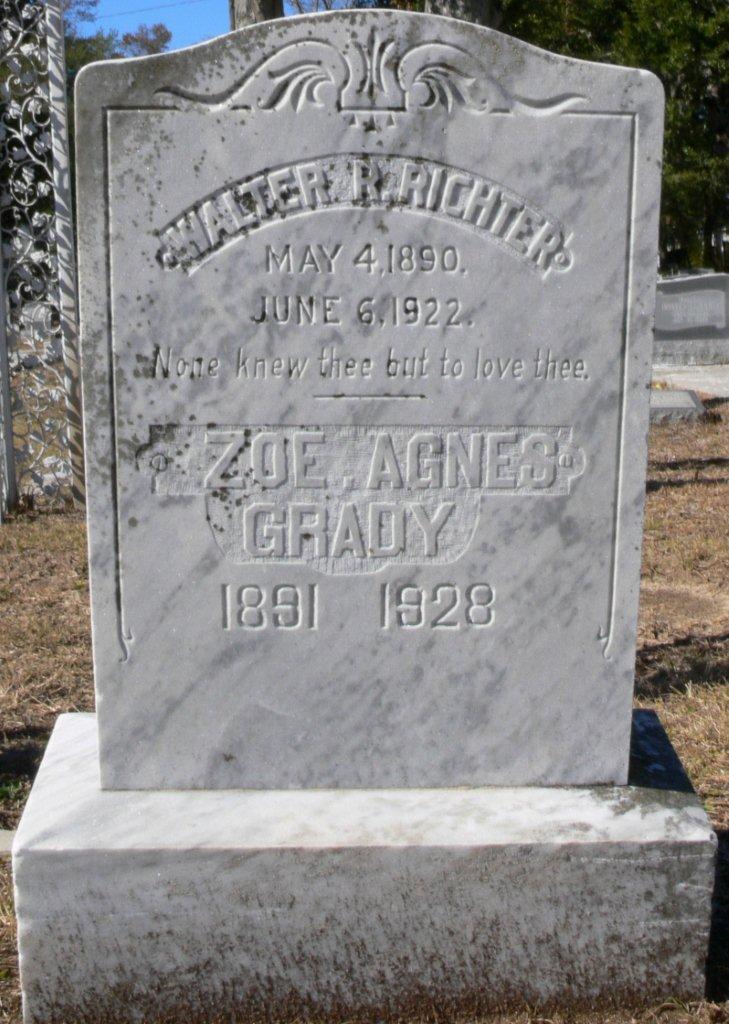
Walter Roche Richter
Walter R. Richter (1890-1922), 31 years, who was shot down by Ben Bolton (1897-1957), son of Nat Bolton on Sunday night at 10:30 and who suffered intensely during the time he lived at the Biloxi City Hospital, died at that institution this morning at 5:30 o'clock. It was stated that Mr. Richter could hardly survive the wound which penetrated the intestines. This is said to have been the second shot fired at him as he attempted to leave a building in which he and several other Biloxians were visiting for just a few moments, while out for a ride during the evening.
Hundreds of interested persons anxiously inquired about Mr. Richter all during Monday, indicating that feeling for him as one of the best young men of city. Not only did they make inquiry at the hospital, where he was carried by Officers George Mon and Alonzo Gabrich immediately after the shooting, but the question was passed along the streets as to how he was progressing. The hospital was visited by numerous persons who went to inquire and offer their assistance if it need be, but here he received every care during his last moments by medical aid and attending loved ones.
Bolton, who was given a hearing yesterday afternoon on a charge of shooting with intent to kill, will be brought back to Biloxi. The affidavit against him will now be changed to murder and he will be given another hearing and bound over to await the Harrison County grand jury without benefit of bond.
Walter Richter is survived by his wife , a little daughter, a father, W. H. Richter, of New Orleans, two sisters, Mrs. H. J. Gillen, of Biloxi and Mrs. Arthur Chester, of Montgomery, Ala., and two brothers, Alfred Richter and Bernie Richter, both of Biloxi. He was a member of the Biloxi Lodge of Elks, Knights of Columbus West End Fire Company and other organizations, whose members will attend the funeral in a body. He leaves many friends among Biloxians. He was a member of the Church of the Nativity under whose auspices he will be buried, the funeral will take place tomorrow afternoon at 3 o'clock from the late residence on Bohn street, with interment in the Biloxi cemetery.(The Daily Herald, June 6, 1922, p. 1)
Ben Bolton was found "Not Guilty" in the murder of Walter Richter. His defense attorney moved the jury to tears in his closing statements. The key statement being that "Bolton had been threatened by the deceased and that he had reason to believe that his life was in danger when the deceased was said to have arisen from the chair prior to the shooting".(The Daily Herald, December 21, 1922, p. 1)
REFERENCES:
The Daily Herald, ‘Walter R. Richter dangerously shot by Ben Bolton Sunday night in Biloxi’, June 4, 1922, p. 1.
The Daily Herald, ‘Finish taking testimony in Bolton case this afternoon’, December 20, 1922, p. 1.
The Daily Herald, ‘Ben Bolton secures freedom from the hands of jury’, December 21, 1922, p. 1.
___________________________________________________________________________________
1927
Maggie Hutchinson
Leola Ridcourt, Biloxi negress, was charged with stabbing to death Maggie Hutchinson, negress, also of Biloxi at an Elmer Street house. She pleaded self-defense as the victim was alleged to have advanced on her with an ice pick.(The Daily Herald, and April 22, 1927, p. 1 and April 27, 1927, p. 8)
Edna Johnson Longinotti
Edna Mae Johnson was born at Ocean Springs, Mississippi in February 1891 to John E. Johnson (1859-1921) and Ella Felicia Pons (1868-1910). She married Joseph R. Longinotti Jr. (1882-1968), the son of Joseph Longinotti (1846-1923) and Clotilda Longinotti (1859-1936) of Hot Springs, Arkansas, on September 29, 1909 at Nativity BVM Catholic Church at Biloxi, Mississippi.
Edna and Joseph R. Longinotti Jr. made their home at Hot Springs, Arkansas where he was in the hotel business. They were the parents of a daughter, Marjorie Longinotti.
Edna was killed on August 13, 1927 at Biloxi, Mississippi by her lover, Sam Davis, of Little Rock, Arkansas. She had been divorced from Joseph Longinotti prior to her demise.
Edna Mae was survived by Miss Emma Johnson, her aunt in Biloxi; Louis O. Johnson, an uncle, at Biloxi; Mrs. August Dorries, another aunt of Memphis, Tennessee.
The O'Keefe Funeral Parlors of Biloxi directed the Longinotti funeral with services at Nativity BVM Catholic Church in Biloxi. Committal followed in Bellande Cemetery at Ocean Springs.
REFERENCES:
The Biloxi Daily Herald, 'City New', September 21, 1909, p. 4.
The Biloxi Daily Herald, 'Longinotti-Johnson nuptials yesterday', September 30, 1909, p. 2.
The Daily Herald, 'Joe Longinott Jr. inherits fortune', July 24, 1911, p. 8.
The Daily Herald, 'Mrs. Edna Longinotti killed by her lover', August 15, 1927, p. 1.
The Daily Herald, 'Longinotti funeral', August 16, 1927, p. 2.
The Daily Herald, 'Longinottis leave for Hot Springs', August 19, 1927, p. 2.
______________________________________________________________________
1933
Frank Anderson
Frank Anderson (1881-1933) was murdered on April 16, 1933 in the doorway of the Terry Apartment house at 120 East Water Street. The only suspect was Deputy Sheriff Julius [Jules] Sablich (1872-1947), who also had the alais 'Zudie Hightower'. Mr. Anderson was born in Scotland and made his livelihood at Biloxi as a bookkeeper. Although Jules Sablich was acquitted of the crime by a jury in June 1934, the State presented evidence that this could have been a crime of passion. Frank Anderson was dating Mrs. Edwina Case, nee Edwina Lynd (1891-1973), and the widow or divorcee of Mr. Case. She was with Frank Anderson on Water Street when he was slain. The State alluded that Mr. Sablich had shown affection towards Mrs. Case and had been rejected. Mrs. Case later married Fred G. Klein (1903-1978).
In his defense, Jules Sablich had 14 witnesses testify that he present at a family party at the time of the murder. In June 1934, the jury convined and adjucated him innocence of slaying Mr. Anderson.
REFERENCES:
________________________________________________________________________
1934
Frederick J. Werkhoven
Frederick Julian Werkhoven (1900-1934) was born October 12, 1900 at Memphis, Tennessee. He was shot and killed by Roger Joseph D'Aquin (1891-1966) with a double barrel, 20 gauge shotgun at his place of business on Main Street on March 25, 1934.
Roger J. D'Aquin was a native of New Orleans and the husband of Mary Sherry (1897-1983). Mr. Werkhoven was married to Beulah Sherry (1905-1977), the sister of Mrs. D'Aquin. Roger was an US Navy veteran of World War I and had sought medical help from the Biloxi VA Hospital for his 'nervous' condition. He was found not guilty for the muder of Werkhoven in the Circuit Court of Harrison County, Mississippi in late June 1934.
Roger J. D'Aquin expired at New Orleans on January 20, 1966. His corporal remains were interred in the Metairie Cemetery.
REFERENCES:
The Daily Herald, Argument is climaxed by fatal shot', March 26, 1934.
The Daily Herald, 'Werkhoven funeral this afternoon', March 27, 1934.
The Daily Herald, 'Fred Werkhoven buried', March 28, 1934.
The Daily Herald, Circit Court term adjourns', June 26, 1934.
The Times-Picayune, 'D'Aquin', January 22, 1966.
_______________________________________________________________________
1941
Eddie [Edia Joseph] Longon (1908-1959) killed [Avis] Alves [sic] Romero (1915-1941), son of Ophelia Vincent Romero Dronet (1892-1955), in the Mavar Camps on February 12, 1941. Romero entered the Longon house in a drunken state and frightened and cursed Mr. and Mrs. Longon and their five young children. Eddie Longon avered self-defense of his family after he repeatly struck Mr. Romero in his head with a hammer until he died from the blows.
REFERENCES:
The Daily Herald, 'Man slain by hammer at Biloxi', February 13, 1941, p. 1.
______________________________________________________________________
1942
Vernell Reid Thompson
Vernell Reid Thompson (1917-1942), native of Purvis, Mississippi and the daughter of Mr. and Mrs. Seaborn Reid, was shot on a pier on Back Bay on July 17, 1942. She died in the Biloxi Hospital from her wounds August 9, 1942. William 'Buster' K. Thompson (1913-1989), her spouse, admitted shooting Vernell to Deputy Sheriff Laz Quave. No further information.(The Daily Herald, August 10, 1942, p. 9)
____________________________________________________________________________________________________________________________
John P. Rabito
John Peter Rabito (1891-1947) was born at New Olreans, the son of Anthony Rabito (1858-1931) and Lena DiNapoli Rabito (1870-1965), both natives of Contessa Entellina, Palermo, Sicily. he was murdered in the early morning of August 1947 at Biloxi, Mississippi.
REFERENCES:
The Times-Picayune, 'Bandits murder former resident [John Rabito]', August 3, 1947, p. 1.
The Times-Picayune, 'Coast robberies are held solved', August 8, 1947, p. 2.
The Times-Picayune, 'Soldier sought in Rabito killing', August 9, 1947, p. 19.
The Times-Picayune, 'Police say Tall admits slaying', August 17, 1947, p. 20.
The Daily Herald [Biloxi, Mississippi], 'Two bound to grand jury', August 19, 1945, p. 1.
The Daily Herald [Biloxi, Mississippi], 'Enter mistrial in murder case', December 11, 1947, p. 1.
_________________________________________
1950
Thomas J. Boyle Jr.
Thomas Joseph Boyle Jr. (1897-1950) was born at New Orleans on January 20, 1897 to Thomas J. Boyle Sr. (1860-1909) and Emily Theresa Schneider (1861-1949). He married Joyce Christina Staiger (1897-1973), the daughter of John Adam Staiger (1857-1937) and Marie Magdalena Seifer (1878-1916) at New Orleans on January 3, 1918. They were the parents of Joyce Gretchen Boyle (1919-2004) who married Peter Dombourian (1920-1992).
Thomas J. Boyle Jr. made his livelihood at New Orleans initially as a hotel clerk at the Lafayette Hotel. He later worked for Higgins Industries. Mr. Boyle was murdered at Biloxi, Mississippi on November 5, 1950 at 438 Porter Avenue in Biloxi, Mississippi. At the time, he was performing repairs in an old house at 438 Porter Avenue, which was owned by his aunt, also a resident of the Crescent City.
The corporal remains of Mr. T.J. Boyle Jr. were interred in the Biloxi Cemetery where his parents rest in eternal peace. His wife expired at New Orleans on January 19, 1973. Her remains were entombed in the Seifer tomb in the Greenwood Cemetery at New Orleans.
Mr. Ratcliffe was tried in the Circuit Court of Harrison County, Mississippi in early March 1951. He was found guilty of Mr. Boyle’s murder and sentenced to life in prison.
REFERENCES:
The Daily Herald, “Believe robbery was motive in Biloxi slaying”, November 6, 1950, p. 1.
The Daily Herald, ‘Begin selection jury in murder trial’, March 1, 1950, p. 6.
The Daily Herald, ‘Negro gets life’, March 3, 1951, p. 1.
The Morning Advocate [Baton Rouge], “Murder verdict held by Coroner’s jury in T.J. Boyle case”, November 8, 1950, p. 8-B.
The Times-Picayune, “[Thomas J.] Boyle”, November 5, 1950.
The Times-Picayune, “Set arraignment on murder count”, December 6, 1950.
The Times-Picayune, “[Joyce S.] Boyle”, January 20, 1973, p. 16.
_________________________________________________________________________
1955

Dale Morris
Dale Morris (1924-2000?), a 31-year old cowpuncher and rodeo rider from Whitehorse, Montana was arrested in New Orleans in early December 1955. Morris was accused of the murder of Charles W. Flink (1916-1955), a novelty store proprietor at Bay St. Louis, Mississippi on November 22, 1955, when Cowboy Morris was interupted by Flink while stealing a car tire.
1961
In early 1961, Dale Morris failed to return to Parchman prison in Mississippi. He had gone with a prison official to Fort Smith, Arkansas to acquire horses. In early May 1961, Morris was captured in Oklahoma after a gun battle with Detective Jack Merchant.(The Daily Herald, May 5, 1961, p. 1)
REFERENCES:
The Morning Advocate [Baton Rouge], "Morris ordered extradicted to Mississippi today", December 3, 1955.
The Daily Herald, "Fate of Dale Morris in hand of Hancock [County] jury", March 29, 1956.
The Times-Picayune, "State, defense end testimony", March 29, 1956.
The Daily Herald, "Enter mistrial in case of Dale Morris", March 30, 1956.
The Times-Picayune, "Cowboy [Morris] denies shooting Flink", September 21, 1956.
The Times-Picayune, "Four face charges in [Dale] Morris escape", September 24, 1957.
The Daily Herald, "Dale Morris is recaptured by Oklahoma police hand of Hancock jury", May 5, 1961.
__________________________________________________________________________
1957
Nicholas J.A. Surian
Audrey Ryan Surian (1922-1957) was allegedly stabbed to death by Nicholas J.A. Surian (1915-2004), her spouse, on January 24th at their home at 123 Kuhn Street in east Biloxi. Surian's trial ended in a mistrial on June 21, but he pleaded guilty of manslaughter in early July. Judge Leslie Baltar Grant sentenced Mr. Surian to four years in the State penitentiary for his crime.(The Daily Herald, January 26, 1957, p. 2 and July 4, 1957, p. 6, The Times-Picayune, June 21, 1957, p. 53 and The States-Times, July 5, 1957, p. 8-B)
REFERENCES:
The Daily Herald, "Surian charges with murder in death of wife", January 26, 1957.
The Daily Herald, "Surian enters plea of manslaughter", July 4, 1957.
The States-Times [Baton Rouge], "Pleaded guilty", July 5, 1957.
The Times-Picayune, "Coast murder trial is voided", June 21, 1957.
______________________________________________________________________
Aden S. Bellew
-tombstone.jpg)
Aden S. Bellew (1907-1981) was accused of murdering Harry Jacob Geiss Jr. (1924-1957), a resident of Mississippi City, at the east Biloxi Oak Street apartment of Mrs. Ruth Johnson (b. 1929) on February 13, 1957. The murder weapon was a .38 caliber revolver and Mr. Geiss was shot five times while in the bathroom of Mrs. Johnson. The corporal remains of Harry J. Geiss Jr. were interred in the Fort Sam Houston National Cemetery at San Antonio, Texas. Aden Bellew and Preston Bellew, a brother, were sent to Parchman State Penitentary in July 1960.
Aden S. Bellew expired at Saucier, Mississippi on March 19, 1981. His corporal remains were interred in the New Fayard Church Cemetery at Latimer, Jackson County, Mississippi.
REFERENCES:
The Daily Herald, “Bellew murder trial continues”, July 4, 1957.
The Daily Herald, “Bellew case will be given to jury today”, July 6, 1957.
The Daily Herald, “Orders mistrial in murder case of Aden Bellew”, July 8, 1957.
The Daily Herald, “Bellew [Preston J. Bellew and Tommy Bellew] cases back in court”, December 8, 1959.
The Times-Picayune, "Four [Aden Bellew, Preston Bellew, Thomas Bellew, and Ruth Johnson] face charges in [Dale] Morris escape", September 24, 1957.
The Morning Advocate [Baton Rouge], "Second trial on murder charge is underway", December 10, 1957.
The Times-Picayune, "Bellew trial ends suddenly", December 12, 1957.
___________________________________________
Patey-DeLoache
REFERENCES:
The Daily Herald, 'Biloxian is held for double murder', April 18, 1960, p. 1.
The Times-Picayune, '2 are fatally shot in Biloxi', April 17, 1960, p. 1.
____________________________________________
1964
.jpg)
Eleuterius-Zahra Murders
May Darnell Eleuterius (1946-1964) of 500 Oak Street at Biloxi and Joseph L. Zahra (1943-1964), USAF serviceman KAFB and from Livonia, Michigan, were shot and killed at Ocean Springs, Mississippi on July 6th.(The Daily Herald, July 7, 1964, p. 1 and July 8, 1964, p. 2)
In November 1964, Sheriff Cecil Byrd of Jackson County, Mississippi and Police Chief W.T. Broome of Ocean Springs went to Lakeland, Florida to interrogate an ex-convict from Alabama about the Eleuterius-Zahra slayings in a roadside park at Ocean Springs. He was cleared of any involvement in the July 1964 murders.(The Times-Picayune, November 4, 1964, p. 5)
REFERENCES:
The Daily Herald,“Couple found murdered at Ocean Springs”, July 7, 1964.
The Daily Herald,“Autopsy shows girl shot in double killing”, July 8, 1964.
The Times-Picayune,“Police clear slay suspect”, November 4, 1964.
___________________________________________________
1967
Harry Bennett Murder
On December 16, 1967, Harry Bennett (1902-1967), Biloxi gambler and bookmaker, was murdered gang land style outside of his apartment. Harold Donald Diddlemeyer (1943-2007), an escapee from the Mississippi State Penitentiary, was accused of his murder and in 1969 asked the court to take a lie detector test to prove his innocence of this crime. Diddlemeyer was convicted and died at Parchman Prison on 15 June, 2007.(The Daily Herald, December 16, 1967. p. 1, April 1, 1969, p. 2; The Sun Herald, March 19, 1995, p. A-1 and June 17, 2007.)
REFERENCES:
The Daily Herald,“Bullet-riddled body of Harry Bennett found”, December 16, 1967.
The Daily Herald,“Bennett rites”, December 18, 1967.
The Daily Herald, “”, April 1, 1969.
The Sun Herald, “Son bids farewell to mother [Iona Fountain Diddlemeyer] returns to prison”, April 1, 1995.
_____________________________________________________________________
1970
Donald Lester "Jimmy" James [1927-1970]-gangland slaying
'Jimmy' James, convicted in 1968 of interstate transporting of gambling equipment to aid racketeering, was slain at Caesar's Palace on the night of January 11.[The Daily Herald, January 13, 1970, p. 1]
----------------------------------------------------------------------------------------------------------------
1972
Kemp slaying
On February 16, 1972, Cornelius Bolding Kemp (1916-1972), operator of Kemp Cab Service, was strangled and robbed in his taxi cab while parked at Howard Memorial Hospital in Biloxi. The suspect was described as a Negro man about 6 feet tall, of medium build and weighing about 185 pounds. No further information.
REFERENCES:
The Daily Herald, 'Taxicab operator found dead in parking lot', February 17, 1972, p. 2.
The Daily Herald, 'Biloxi police seeking suspect in Kemp slaying', February 18, 1972, p. 2.
______________________________________________________
1974
Arthur Weinberger
On December 2, 1974, Art Weinberger, the proprietor of Art's Levis on Howard Avenue, was distracted by John 'Willie' Durengo Reddix (b. 1954) in order that Larry 'Catfish' Jones (b. 1954), Reddix's companion on that day, could sneak up behind Mr. Weinberger and kill him by striking him repeatedly with blows from a wrench. Reddix and Jones then took money and clothes from the Weinberger store and fled. Larry Jones was convicted of murder and incarcerated at Parchman Prison and of March 2012 is continuing to serve a life sentence for this heinous crime.(The Daily Herald, December 3, 1974, p.A 2, December 4, 1974, p. A2 and December 16, 1974, p. 2)
Arthur 'Art' Weinberger (1896-1974) was born on May 11, 1896 at Chicago, Illinois to Adolph Weinberger (1868-pre 1910), an 1876 Hungarian immigrant and Chicago variety store merchant, and Lena Rottenberg (1872-1930+), an 1885 Hungarian immigrant. Adolph had married and been a widower before he married Lena Rottenberger circa 1892. His children with his first wife were: Henry Weinberger (b. 1885); George A. Weinberger (b. 1888); Rae Weinberger (1890-1975) m. Joseph Shanberg (1882-1920+); and Louis Weinberger (b. 1891). Adolph and Lena R. Weinberger were the parents of: William Weinberger (1893-1976); Arthur Weinberger (1896-1974) m. Amy Rush (1907-1991); Emil G. Weinberger (1899-1986); and Richard Weinberger (1907-1982).(1900 Cook Co., Illinois Federal Census R 258, p. 14B, ED 330, 1910 and Cook Co., Illinois Federal Census T624_262, p. 7B, ED 871)
During WWI, both Art and William Weinberger served in the US Army. Art was a clerk at Butler Brothers in Chicago before joining the US Army in September 1917. He was discharged January 13, 1919. By 1920, Art and William Weinberger were domiciled at Savannah, Georgia where they retail clothes salesmen at Savannah, Georgia. By 1930, both men were in Chicago where Art was head of the household with his mother, and brothers, William, Emil, George and George A. Weinberger Jr. residing at 207 Winthrop. Art listed his occupation as an 'out of business merchant'.(1920 Chatham Co., Georgia Federal Censusu T625_241, p. 2A, ED 74 and 1930 Cook Co., Illinois Federal Census R494, p. 2A, ED 1881)
Biloxi
In September 1949, Art and Amy Weinberger acquired Lot 5-Block 2 of the Bienville Subdivision on Biloxi's West Beach Boulevard from L.C. Hicks. He later moved to the Gulf Towers near the Buena Vista Hotel.(Harrison Co., Mississippi Chancery Court Land deed Bk. 325, p. 24)
SW/C West Howard Avenue and Reynoir Street
In August 1952, Art Weinberger took a sub-lease from Genevieve Lynn Dyer on a building situated on the SW/C of West Howard Avenue and Reynoir Street. The consideration was $4000 and Mrs. Victor B. Pringle was the lessor. Here he, Ronald Weinberger, his stepson?, and William Weinberger (1893-1976), his brother, operated and managed several businesses: Art's Army Store, William's Sportswear, Allan's Mens Store, and the Howard Clothing Company.(Harrison Co., Mississippi Chancery Court Land Deed Bk. 357, pp. 418-419).
The corporal remains of Mr. Weinberger were interred in the Southern Memorial Park at Biloxi. Mississippi. He was survivied by Amy Rush Weinberger, Mrs. Donald Friedman, a daughter, of Chicago, and Ronald Winters, a son, at Atlanta, Georgia. Art had been a charter member of SunKist Country Club, a 32nd degree Mason and Shriner and has formerly owned chain stores in the Midwest.(The Daily Herald, December 3, 1974, p. A2)
REFERENCES:
The Daily Herald, “Arthur Weinberger”, December 3, 1974.
The Daily Herald, “Young Biloxi man charged in murder of store owner”, December 4, 1974.
The Daily Herald, “Third man arrested in Biloxi murder”, December 16, 1974.
The Daily Herald, “William Weinberger”, May , 1976.
The Times-Picayune, “Release of death row inmate halted”, January 30, 1983.
_______________________________________________________________________
1976
Edwina de Gruy Marter
Edwina de Gruy Marter (1940-1976) wife of Charles W. Marter, vp of the Gulf National Bank at Gulfport, was kidnapped and murdered by Richard Gerald Jordan (1946-2012+) of Hattiesburg, Mississippi on January 1976. Mr. Marter had paid a $25,000 ransom for his wife's release, but she found murdered on January 14th. Mrs. Marter was the mother of two sons: Kevin Paul Marter and Eric Charles Marter. Her corporal remains were interred in St. Louis No. 3 Cemetery at New Orleans.(The Times-Picayune, January 15, 1976, p. 14)
Richard Gerald Jordan appealed is conviction and it was denied by US District Judge Harold Cox in March 1981. Judge Cox wrote that the Court gave the petitioner a fair trial and his death sentence was proper in accordance with all the requirements of the Constitution through the application of the Mississippi death penalty statue.(The Daily Herald, March 23, 1981, p. A-2)
Mr. Jordan was incarcerated in Parchman on March 2, 1977 and has been serving a life sentence since that time.(May 2014)
REFERENCES:
The Daily Herald, 'Judge Cox denies Jordan death appeal', March 23, 1981, p. A-2.
The Dallas Morning News, 'Banker's wife found slain after ransom', January 14, 1976, p. A-1.
The Times-Picayune, 'Marter', January 15, 1976, Section I, p. 14.
_____________________________________________________________
1977
Robert E. Hansen Jr.
Robert Edward Hansen Jr. (1946-1977), age 30 years and a native of Minneapolis, Minnesota, was shot in the upper right chest with a .22 caliber rifle. He was transported to the Gulf Coast Community Hospital by Amserv and proounced DOA. Hansen lived at 376 Hopkins Boulevard and was the son of Robert E. Hansen Sr. of Council Bluffs, Iowa and Mrs. Lorraine Garber of Salem, Oregon. Gregory Sterling Achee, attached to the 3411 Student Squadron at Keesler AFB was charged with the murder which occurred at the McDonald Square Apartments, 415 McDonald Avenue in Apartment No. 203. He was held in the Harrison County Jail in Biloxi without benefit of bond. Mr. Hansen was survivied by his wife, Patti Hansen of Biloxi; his parents; and two siblings, John Hansen, and a sister, Mrs. Paula Garden, of Salem, Oregon. The body was sent to Bradford-O'Keefe Funeral Home in Biloxi.(The Daily Herald, February 13, 1977, p. A-2.
REFERENCES:
The Daily Herald, 'Keesler student held in slaying of Biloxian', February 13, 1977, p. A-2.
________________________________________________________
1981
Josie Lee Jones
Greg Jones (b. 1954) of Biloxi was arrested and charged with murder in January for the shooting death of Josie Lee Jones, age 62 years, whose body was found in the living room of her home at 629 Lameuse Streeet. She had been shot three times with a .22 caliber weapon in the back, neck and head. Mr. Jones was found shortly after the crime at Beaumont, Mississippi and was held at New Augusta until brought to the Biloxi jail. The motive for the crime was robbery and attempted sexual assault. A pistol, stereo unit and other items were found in the vehicle of Mr. Jones when he was arrested.(The Daily Herald, January 22, 1981, p. A-2)
REFERENCES:
The Daily Herald, 'Biloxi man charges in murder', January 22, 1981, p. A-2.
______________________________________________________________________
1981
Sue 'Tory' Acevedo
Sue 'Tory' Linda Dickens Acevedo [1948-1981] was shot and killed with a .38 caliber revolver on July 17, 1981. Her husband, Charles Acevedo, was charged with her murder.
REFERENCES:
The Daily Herald, 'Acevedo trial resumes after weekend break', November 4, 1985, p. A-2.
_______________________________________________________
1983
Dr. John R. Broussard (1925-1983), an Ocean Springs veterinarian, was killed by Jerry L. Davis on May 6, 1983 while attending the Jazz and Heritage Festival at New Orleans. Dr. Broussard and spouse, Betty Broussard, were preparing to camp at a site on the Chef Menteur Highway in east New orleans when robbed by Mr. Davis. Davis was convicted of 1st degree murder and sentenced to life for his crime.(The Daily Herald, February 1, 1984, p. A-1)
REFERENCES:
The Daily Herald, 'Davis found guilty', February 1, 1984, p. A-1.
__________________________________________________________________
1987
Sherry Murders
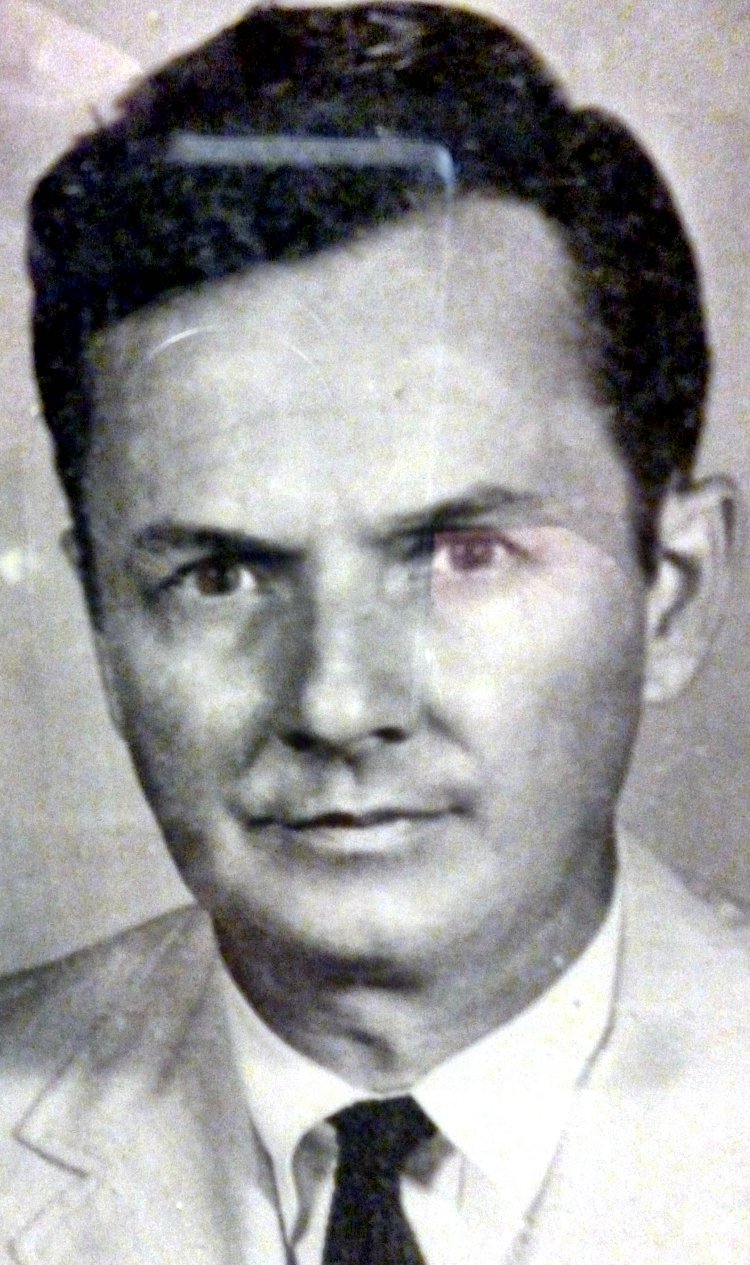
Vincent Jerome Sherry Jr.
Vincent Jerome Sherry Jr. (1929-1987), age 58 years, 203 Hickory Hills Circle, was found dead with Margaret Joyce Smith Sherry (1929-1987), his spouse, on Wednesday, September 16, 1987, at their Biloxi home.
Vincent was the son of Vincent J. Sherry Sr. (1899-1970), a commercial salesman, and Cleo Hunt Sherry (1897-1980). On November 22, 1950, he married Margaret Joyce Smith (1929-1987), a native of Mooringsport, Caddo Parish, Louisiana and the daughter of Bernie W. Smith Sr. and Rubye Dyer Smith. She was the youngest of her two siblings: Bernie W. Smith Jr. (b. 1925) and Charles Raymond "Red' Smith (1926-2009). Margaret was reared in Bowling Green, Kentucky.
Vincent and Margaret were the parents of four children: Margaret Lynne Sherry (b. 1952) m. Richard Sposito; Vincent J. Sherry III; Eric Smith Sherry m. Marian Venetia Bailey; and Leslie Anne Sherry m. Benjamin D. Miller III.
Vincent J. Sherry Jr. held degrees from Western Kentucky College, Middle Tennessee State College, and the University of Southern Mississippi. His law degree was earned at the George Washington University Law School. In 1986, Vincent was appointed by Mississippi Governor William A. Allain (1928-2013) in to serve as interim 2nd Circuit Court Judge.
Judge Sherry served in the USAF from November 1951 until November 1971. Colonel Sherry was an intelligence officer for seven years and judge advocate for thirteen years.
Vincent J. Sherry Jr. had been employed with the Biloxi law firm of Page, Mannino, & Peresich. He had taught political science and criminal justice at the University of Southern Mississippi for eight years.
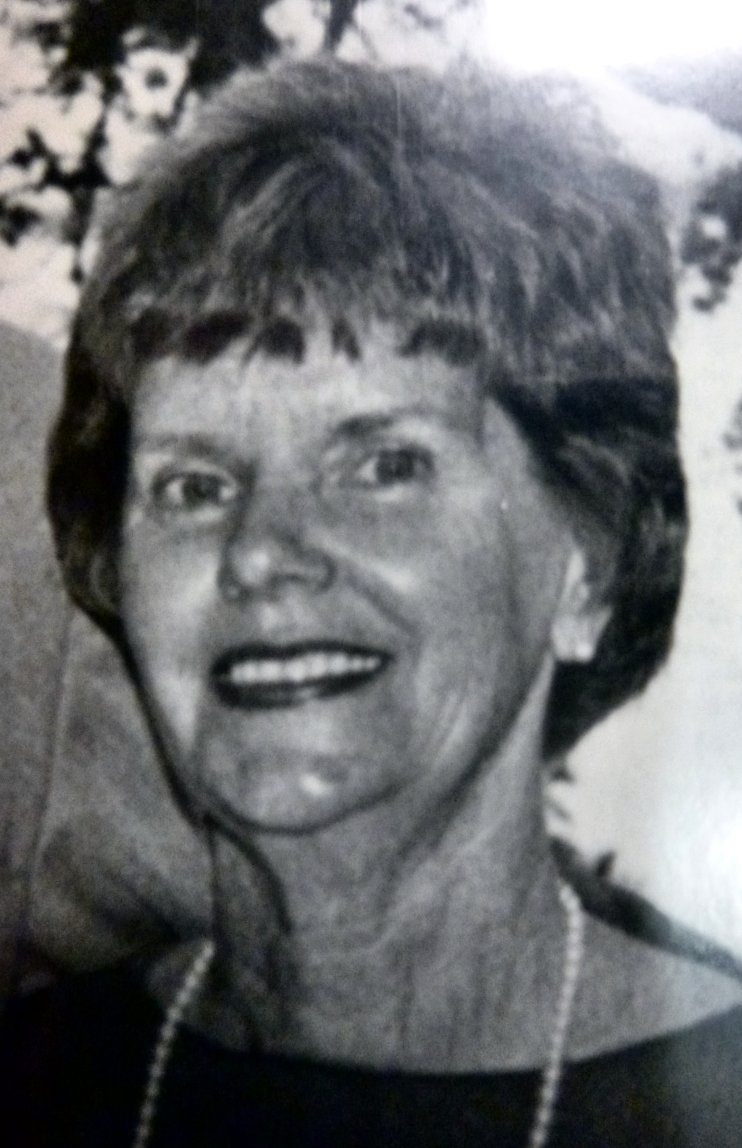
Margaret Smith Sherry
Margaret Joyce Smith (1929-1987) was born in Mooringsport, Louisiana to Bernie W. Smith Sr. and Rubye Dyer Smith. She was the youngest of her two siblings: Bernie W. Smith Jr. (b. 1925) and Charles Raymond "Red' Smith (1926-2009) m. Ann Hall.
Margaret was reared in Bowling Green, Kentucky. She graduated from Western Kentucky State College and taught school. On November 22, 1950, Margaret married Vincent Jerome Sherry Jr. (1929-1989), a native of Brooklyn, New York. They were the parents of four children: Margaret Lynne Sherry (b. 1952) m. Richard Sposito; Vincent J. Sherry III; Eric Smith Sherry m. Marian Venetia Bailey; and Leslie Anne Sherry m. Benjamin D. Miller III.
Margaret Smith Sherry was active in politics on the Coast. She was elected to the Biloxi City Council from Ward VII; served as District V representative to the Harrison County Republican Executive Committee. Mrs. Sherry ran unsuccessfully for Mayor of Biloxi in 1985.
REFERENCES:
Edward Humes, Mississippi Mud, (Gallery Books: New York-1994), 434 pages.
The Record [Leitchfield, Kentucky], 'Charles Raymond "Red" Smith', October 17, 2009.
The Sun Herald, 'Judge Vincent Sherry-Mrs. Margaret Sherry', September 18, 1987, p. A4.
The Sun Herald, 'Sherry files combed for clues to killers', September 18, 1987, p. A1.
The Sun Herald, 'Mrs. Sherry told of fears of murder', September 19, 1987, p. A1.
The Sun Herald, 'Sherrys remembered with humor, affection', September 20, 1987, p. A1.
The Sun Herald, 'Some confuse Biloxi family, Sherry daughter', October 19, 1989, p. C-2.
The Sun Herald, "Eldest [Lynne S. Sposito] will not rest until nightmare is over", December 16, 1990, p. A1.
The Sun Herald, "The Sherry Murders: 20 years later-Still stunning-Biloxi's most notorious murders revisited", September 9, 2007, p. A 1.
The Sun Herald, "FBI vet won 10-year fight", September 9, 2007, p. A 1.
The Sun Herald, "The Sherry Murders: 20 years later-Not the best sort of witness", September 10, 2007, p. A 1.
The Sun Herald, "House where Sherry's were murdered will be torn down", September 26, 2010, p. A 1.
_______________________________________________________________________________
Sylvia A. Reddix
Sylvia Ann Reddix (1958-1988) was allegedly murdered and George Henry Clay allegedly wounded by Charles Harris Jr. of Ocean Springs. The crime occured on Ebony Lane in Biloxi.
Miss Sylvia Ann Reddix, age 36, 207 Elmer Street, Biloxi died November 4, 1988, in Biloxi, Mississippi at the Biloxi Regional Medical Center. She had been shot in the upper right side of the chest with a small caliber gun.
Miss Reddix was a lifelong resident of Biloxi and a member of the New Bethel Baptist Church in Biloxi. She was formerly employed with Ingalls Shipbuilding in Pascagoula and at Keesler AfB. Sylvia was a graduate of Biloxi High School and Phillips College at Gulfport.
Sylvia Ann Reddix was survived by Mrs. Cora Hegler Reddix (1920-2010), her mother; her son, Craig R. Reddix; two sisters, Mrs. Juanita E; Woods and Mrs. Jean A. Smallman; and a grandson, all of Biloxi.
Miss Reddix's funeral was under the auspices of the Richmond Funeral Home in Biloxi. Her service was held at the New Bethel Baptist Church with internment following in the 6th Addition of the Biloxi Cemetery.
REFERENCES:
The Sun Herald, 'Ocean Springs man sought in shootings', November 6, 1984, p. A4.
The Sun Herald, 'Miss Sylvia Reddix', November 7, 1988, p. A2.
The Sun Herald, 'Mrs. Cora H. Reddix', April 11, 2010.
________________________________________________________________________________________________________
1989

Billie Dianne Edgerton Gollott
Billie Dianne Edgerton Gollott (1950-1989) was allegedly murdered by Francis Ray Gollott (1943-1995), her husband, on May 10, 1989. The affair was deemed a domestic dispute by police. Gollott was jailed and bond set at $500,000 by John McAdams, Justice Court Judge.(The Sun Herald, May 12, 1989, p. B-1)
REFERENCES:
The Sun Herald, 'Biloxi man [F. Ray Gollott] charged in shooting', May 12, 1989, p. B-1.
The Sun Herald, 'Dianne Gollott', May 13, 1989, p. A-11.
1990
Sylvester Williams
On January 8, 1990, Sylvester Williams (1959-1990) was shot and killed by a former girl friend, Deborah Joann Smith. When Mr. Williams attempted to break into her bedroom in which she and her three children had barricaded themselves, Mrs. Smith fired a .25 caliber pistol striking Williams in the forehead resulting in his demise.(The Sun Herald, January 10, 1990, p. A-1)
REFERENCES:
The Sun Herald, 'Police: Biloxi woman shot, killed ex-boyfriend as he broke in', January 10, 1990, p. A-1.
____________________________________________________________________
2004
Annie B. Denson Uchello
Annie Bell Denson Uchello (1925-2004), native of Stone County, Mississipp was assaulted in her home and expired from her injuries at Biloxi on February 29, 2004. She had been the wife of James Adron Denson (1921-2000) and lived at Mantachie, Itawamba County, Mississippi. Annie came to Biloxi in 1980 and married Salvador 'Sam' F. Uchello Jr. (1907-1996) in Harrison County, Mississippi on January 24, 1984. He passed on February 22, 1996.(The Sun Herald, March 2, 2004, p. A1 and p. A5 and Harrison Co., Mississipi 2nd JD Circuit Court MRB 27, p. 382)
REFERENCES:
The Sun Herald, 'Salvador F. Uchello Sr.', February 22, 1996.
The Sun Herald, 'Elderly woman killed in assault at Biloxi home', March 2, 2004, p. A1.
The Sun Herald, 'Annie Denson Uchello', March 2, 2004, p. A5.
_____________________________________________________________________________
2008
Andreas Koulmandas Galanis
A 28-year-old Mississippi State senior is being without bond on a capital murder charge in the Friday slaying of his roommate, also student at the university. Bobby Batiste, age 28, of 250 Sinai Road, Preston, was arrested by Oktibbeha County sheriff's deputies early Friday evening in the death of Andreas K. Galanis (1979-2008), age 28, of Biloxi and a native of Athens, Greece. According to the MSU campus directory, Galanis was a sophomore enrolled in the College of Business and Industry, while Batiste is a senior enrolled in the College of Arts and Sciences.
Sheriff Dolph Bryan said deputies discovered Galanis' body shortly after 6 p.m. Friday at Apartment 5108 at the 21 Apartments complex at 1219 Oktoc Road just south of the MSU campus. Deputies had been dispatched to the apartment between 5:30 and 5:50 p.m. Friday after members of Galanis' family in Biloxi contacted the Sheriff's Department when he failed to catch a Florida-bound flight from the Biloxi airport at 4 p.m. Friday. Initially told upon arrival that Galanis had left to catch the flight, deputies were let into the apartment by a roommate - who was identified as Batiste - to further investigate the welfare concern reported by Galanis' family. Upon entering the apartment, the deputies discovered large amounts of blood and then found Galanis' body with "very visible wounds" in a vacant suite of the apartment, Bryan said.
Bryan would not specify the nature of the wounds nor their location on Galanis body, nor would he comment on whether there were visible signs a struggle had taken place inside the apartment or what type of weapon - if any - was used to kill Galanis. Galanis' body was taken to Jackson Friday night was scheduled to undergo an autopsy some time Saturday to determine the exact cause of death, Bryan said Batiste was immediately taken into custody and questioned later Friday night. Bryan would not comment on whether Batiste gave a statement to deputies confessing to Galanis' death.
Under state law, a capital murder charge is filed against a suspect if the slaying was committed while in the act of another felony crime. Bryan said the other crime involved in Galanis' slaying was robbery, but would not comment over the specific circumstances or events of the robbery. Bryan also would not comment on whether Galanis and Batiste had been involved in any type of ongoing conflict.No additional suspects are currently being sought in connection with Galanis' death, though the investigation is continuing, Bryan said. Detectives with the Starkville Police Department and MSU Police Department are assisting sheriff's deputies with the investigation, Bryan said. "We still have an awful lot of investigative work to do, but I feel we have a really good grasp on this case at this time," Bryan said Saturday. "I don't think we'll have any more surprises." Bryan did say that anyone who might have additional information related to the investigation of Galanis' death is encouraged to call the Sheriff's Department at 323-2421 or Golden Triangle Crime Stoppers at 1-800-530-7151.
A statement from officials with Ambling Management Co. of Atlanta, Ga., which operates 21 Apartments, said that the complex management team planned to have a private security company patrolling the property and attending the main security gate on Saturday. The managers were also working with MSU administrator to arrange a "grief counselor onsite at our community to help residents during this trying time." "As with any incident of this nature, our immediate thoughts and prayers are with the victim and their family. It saddens us to know that a young person needlessly lost their life and we can't imagine the pain felt by their loved one," the statement from Ambling officials said. At the time Ambling officials released their statement Saturday, sheriff's deputies were still working to complete the gathering of evidence at the apartment complex. "The sheriff will not release any details of what occurred while the investigation is under way, but has advised us that they have made an arrest and that this was an isolated, contained event and that there is no threat of imminent danger to other residents and that there was not a firearm involved," the Ambling statement said.
______________________________________________________________________________________________________________________________________________
2019

Robert McKeithen
As of Tuesday morning, the Gulfport police chief said investigators still don't know why 19-year-old Darian Tawan Atkinson allegedly opened fire on Biloxi Police Officer Robert McKeithen [1961-2019] in the parking lot outside a police station Sunday night. McKeithen died of multiple gunshot wounds at a hospital and law enforcement agencies arrested the suspect within 24 hours of the shooting.
The suspect's brother, 21-year-old Davian Lewanika Atkinson, was also arrested by Gulfport police. He has been charged with accessory after the fact, according to the Harrison County Jail's website.
Here's what we know about Darian Atkinson, who is being held on a charge of capital murder of a law enforcement officer.

In this Monday, May 6, 2019 photo provided by the Stone County Enterprise newspaper, Darian Tawan Atkinson, wanted for capital murder in the slaying of Biloxi Patrolman Robert McKeithen, awaits transport back to Biloxi, after being arrested in Wiggins, Miss. The suspect's brother, 21-year-old Davian Lewanika Atkinson, was also arrested by Gulfport police. He has been charged with accessory after the fact.
Gulfport Police Chief Leonard Papania said authorities believe Darian Atkinson lives in Biloxi. He was arrested in Wiggins, about 35 miles north of the Gulf Coast, police said. An off- duty Biloxi officer, on his way to his home in Stone County, spotted the suspect walking on a road, reported the Stone County Enterprise. The officer called Wiggins police, who subdued him at gunpoint in a field near a hotel, according to the Stone County Enterprise. On Monday night, officers marched Darian Atkinson, handcuffed, from a police cruiser up through the front doors of the Biloxi station near where McKeithen was shot. As he passed dozens of uniformed officers, the lanky teen appeared to smile. Darian Atkinson said, “Oh, the police are mad at me ...murder," according to The Sun Herald.
REFERENCES:
The Starkville Daily News (MS), ‘Andreas Galanis: MSU student murdered. Deputies charge roommate in slaying, suspect held without bond’, March 9, 2008.
- 17789 views
Police Force
Police Force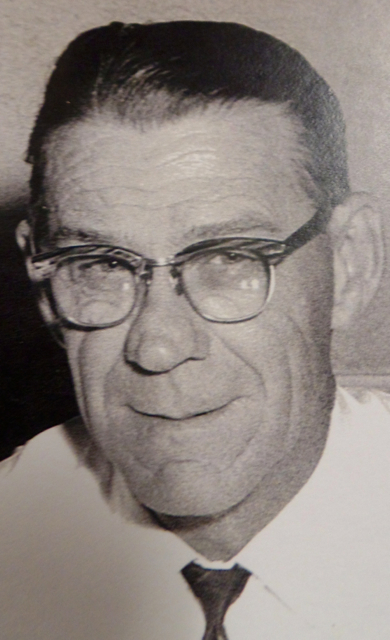
Biloxi Policeman [image made at L&N Depot ca 1940? Courtesy of Tom Walker]
TIME LINE
1841
On July 27, 1841, Rene Lameuse introduced a proposal to create a night patrol at Biloxi to preserve peace and harmony in the village. Peter Flanagan was appointed Captain of the post. One of his duties was to arrest free negroes and slaves who were on the streets of Biloxi after 9 p.m., unless they had written permission from their master, mistress or overseer. Otherwise, Captain Flanagan was to punish the violators as directed by the law. He had the power to recruit as many citizens to assist him as necessary for the task.[Harrison County, Mississippi Board of Police Minute Bk. 1, p. 5]
1842
In July 1842, Benjamin Holley was appointed Captain of the night patrol at Biloxi.[Harrison County, Mississippi Board of Police Minute Bk. 1, p. 26]
1886
The Mayor planned to veto the action of the Town Council in reducing the cost of a bar room license from $125 to $50 unless the bar keepers agree to pay $20 each towards the expenses of the Police department.(The Daily Telegraph [Monroe, Louisiana], April 28, 1886)
1888
In May 1888. J.C. DeLamarre, Biloxi town marshal, was appointed Deputy Sheriff by Sheriff Florian Seal.(The Biloxi Herald, June 2, 1888, p. 8)
1889
Carey Holliman appointed Marshal by Mayor Harry T. Howard and the City Aldermen.[TBH, January 11, 1889, p. 2]
1890
1891
J.C. DeLamarre resigned as Marshal in April 1891 and was replaced by F.A. Caillavet. Mr. DeLamarre opened the WHITE ELEPHANT, a saloon, on the corner of Pass Christian Street and Main Street.[The Biloxi Herald, April 11, 1891, p. 1]
1895
1896
J.C. DeLamarre resigned as Biloxi's marshal effective 15 March. Charles W. Blake was appointed the new Marshal by Governor McLaurin. DeLamarre was complimented by the City Council for actions taken during his short tenure as marshal.[The Biloxi Herald, March 14, 1896, p. 8]
1897
Marshal Charles W. Blake had three officers on the BPD: Robert M. Mosley, J. A. McKinley (1852-1920) and Tony Galletta (1830-1906). His salary was $50 per month and his patrolmen were paid $30 per month.(The Biloxi Herald, January 9, 1897, p. 8)
1899
Marshal Mosley and Officer McKinley captured 10 white crap shooters at Point Cadet yesterday.They pleaded guilty in court and were fined $5 and court costs. Marshal Mosely had started to break gambling in Biloxi without regards to who indulges in it. Stir clear of alluring cards and fascinating bones, if you do not want to appear in city court.(The Biloxi Daily Herald, January 17, 1899, p. 8)
1901
The Biloxi city council decided that the city would not pay for the new spring police uniforms. The Biloxi police were expected to acquire their spring uniforms at their own expense.(The Biloxi Herald, April 11, 1901, p. 8)
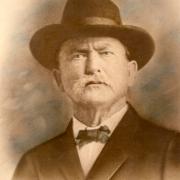
Marshal John A. McKinley (1852-1920)
When Marshal Robert M. Mosley resigned in the fall of 1902 to become Chief Inspector for the Mississippi Oyster Commission, John Augustus McKinley (1852-1920) was appointed the new Marshal by Biloxi's alderman to replace him. R.M. Randolph was his only opposition. Sardin George was added to the BPD at this time.(The Biloxi Daily Herald, September 1, 1902, p.1 and September 3, 1902, p. 1)
1909
The Mayor and board elected R.M. Randolph, Sardin George and Peter Bellande to serve at policemen for Biloxi.(The Biloxi Daily Herald, Janaury 6, 1909, p. 1)
1914
Police Chief Staehling issued instructions to his patrolmen, R.M. Randolph, Zudie Hightower, nee Julius Sablich, and Nat Bolton, to arrest proprietors of liquor joints and bootleggers. Public and private houses were also banned of alcohol. Staehling said, "there will be no favoritiism played." ? Hunt was arrested on Main Street with more than 300 quarts of beer and some whiskey. He was fined $50 by Police Judge Z.T. Champlin. Sheriff J.C. Elmer related that as many as 60 blind tigers and bootleggers in the area.(The Daily Herald, July 22, 1914, p. 1)
1915
Police Chief Staehling had a staff of police officers consisting of Peter Bellande, Sardin George, Zudie Hightower and R.M. Randolph.
1917
Chief Randolph was chastised by some members of the Police Committee and City Council because of his challenge to their interference into internal matters of the Biloxi Police Depatment.(The Daily Herald, January 9, 1917, p. 1)
The Biloxi city council discussed acquiring a conveyance vehicle for the police department. Although a motorcycle was part of the discussion, a patrol wagon was considered a possibility.(The Daily Herald, February 8, 1917, p. 3)
1918
Mayor Edward Glennan (1854-1933) started his final year as Mayor of Biloxi with turmoil in the Police Department. In January 1918, when it was time to reappoint patrolmen, Walter H. Hunt (1887-1961), 1st Ward Alderman, opposed that Frank J. ‘Zudie’ Hightower (1890-1976), Peter Bellande (1871-1933), and John W. Mabry (1873-1940) continue with the force. The Board of Aldermen appointed Joseph Mattina (1889-1969), a barber; Willie Ryan (1876-1958), Biloxi Yacht Club keeper; and Martin Green Jr. (1875-1951), a boat dealer, to replace the three men. None of the City Council’s new policemen had any law enforcement experience and they had to be trained by Chief R.M. Randolph. Chief Randolph further stated that he was greatly surprised and was unwilling to part with Officer Bellande. He declares that Officer Peter Bellande has always proven himself a very efficient Police Officer. Officer Bellande also has a large number of friends in the city administration as well as among citizens who are nor connected with the city.(The Daily Herald, January 3, 1918, p. 1)
1920
In June 1920, the Biloxi Police force was headed by Chief George Bills with Joseph Venus, a new hire, Alonzo Gabrich, and ? Michel as patrol officers. Since the resignation of Zudie Hightower, nee Sablich, Mayor J.J. Kennedy had not replaced him. Joseph Mattina (1889-1969) came on the force in July replacing Joseph Venus.(The Daily Herald, June 3, 1920, p. 3 and July 17, 1920)
John A. McKinley (1852-1920), former patrolman and Police Chief, expired at Columbia, Mississippi on September 7, 1920. Kate K. McKinley (1856-1921) died at Biloxi on .(The Daily Herald, September 9, 1920, p. 1 and
1921
At the start of 1921, the Biloxi Police Department consisted of Chief George Bills and four officers: Richard Grady, Joseph Mattina, Alonzo Gabrich, and Charles Lowd (1891-1967).(The Daily Herald, january 15, 1921, p. 1)
1922
In late March, Joseph Mattina (1889-1969), a Biloxi policeman, shot and killed Adolph Hunt (1884-1922) in downtown Biloxi. The incident was ruled as self-defense.(The Daily Herald, March 28, 1922, p. 1)
The night force in May consisted of Charles Lowd, Alonzo Gabrich, and George Mon. They protected the Riviera Hotel from looters during and after the conflagration of May 15, 1922.(The Daily Herald, May 15, 1922, p. 3)
1926
Three Biloxi policemen, Evon Swetman (1902-1976), Richard Grady and Jake Stanovich, of the night patrol discovered a blaze at the Rosell bungalow on West Beach between Porter and Gill Avenues and awoke the tenant, Mrs. Albert Madding. Units from West End No. 1, Central No. 1 and Hook & Ladder No. 1 arrived on the scene and quickly arrested the incipient conflagration limiting damage and the loss of the structure. The five City firemen were aided by volunteers.(The Daily Herald, September 4, 1926, p. 1)
1928
By early February 1928, the new police station on the first floor of Biloxi’s City Hall was nearing completion. Chief George Bills (1867-1945) had just hired Felix Mattina (1886-1946) and Frank Hecht (1901-1981) to the work with the night force to fill the void in his ranks created by the death of Officer Jake Stanovich (1891-1927). Mr. Mattina had prior law enforcement experience and had been a deputy sheriff. Frank Hecht had no police experience as he had worked for Standard Oil and the City Bus Company. With the new hires, the Biloxi night force consisted of the following men: Charles Lowd; Omer Graves (1886-1933); Evon Swetman;(1902-1976); Richard Grady (1891-1958); and Lawrence Stockton (1893-1956). Chief Bills and Alonzo Gabrich (1894-1948), City Detective, comprised the day force.(The Daily Herald, February 8, 1928, p. 2)
1932
Chief Alonzo Gabrich announced schedule changes for his police officers: Joseph Randazzo; Alick Ewing (1876-1942); Harvey Chinn; and Charles Lowd.(The Daily Herald, May 2. 1932, p. 2)
1933
1936
1939
Felix N. Mattina (1886-1946), police officer, deputy sheriff and former two term Beat 1 Constable (1928-1936), announced his candidacy for Beat 1 Constable in May 1939. Since 1936, Officer Mattina had served Biloxi as a city patrolman in the Mayor Louis E. Braun administration. He had also been a police officer during the Glennan and Kennedy mayoral years. Mattina would also run for Constable in 1943.(The Daily Herald, May 2, 1939, p. 1 and May 31, 1943, p. 1)
1940
in May 1940, Herbert McDonnell, uniformed officer, was appointed a plain clothes officer while Harry Jones, night desk sergeant, became a day force officer. Alick Eweing, officer, became the night desk sergeant.(The Daily Herald, May 6, 1940, p. 16)
1941
Chief Gabrich announced that an air school program would be initiated. Henry Cook Jr., a two-year extra duty officer would become a regular policeman. Also Pat Jordan and Harry Jones would be assigned to the new 24-hour motorcycle servive.[The Daily Herald, June 16, 1941, p. 3]
1942
Officers Louis Anglada and G. Lepre resigned from the BPD in August 1942. Lee Chinn, a fireman for 29 years, was dismissed from his duties.(The Daily Herald, August 3, 1942,p. 5)

1943
Alonzo Gabrich retired as Police Chief on January 4, 1943 after 24 years with the BPD. His tenure as Police Chief totaled 14 years. Gabrich started with the City of Biloxi working as an office boy for W.G. Henderson and later collected street taxes and drove a fire wagon. By 1917, he had been the sanitary inspector; pound master; and special police officer. The Biloxi community in respect and appreciation for his long and faithful sevice to their city, presented Mr. Gabrich with gifts: a belt buckle with three diamonds; cash and bonds; and an Elks diamond ring.[The Daily Herald, August 14, 1917, p. 1 and January 4, 1943, p. 5]

Laz Quave became Police Chief on January 4, 1943 and Louis Anglada was named his assistant. Other members of Quave's staff were: Earl Wetzel, City Detective; Arthur Largilliere, Desk Sergeant; Joseph Mattina; Charles Comeaux; Vincent Fernandez; Albert Demoran; Oswald Chatham; Henry Cook; Al Boehm; S.O. Hall; John Labash; and Floyd Gill.(The Daily Herald, January 4, 1943, p. 5)
1944
Louis E. Anglada (1910-1955) was appointed acting Police Chief of Biloxi in July 1944. He joined the Biloxi force in 1935 and worked his way to assist chief from a uniformed officer and dectective. Chief Anglado is a member of the Knights of Columbus, Fishermen's Union, Mississippi-Tennessee Peace Officers and Back Bay Fire Company.(The Daily Herald, July 8, 1944, p. 3)
1949
Captain Joseph Mattina Sr. (1889-1969), who was born at NOLA on January 13, 1889 and had been a resident of Biloxi since 1896, retired from the Biloxi Police Department in 1949. He had joined the force in 1927 [sic]. Captain Mattina was married to Sidonia Fayard (1897-1971). He expired at Gulffport, Mississippi on December 7, 1969 leaving three sons: Joseph F. Mattina (1920-2015); Dalton J. Mattina (1922-2005); and Roy Mattina, Justice of the Peace.(The Daily Herald, December 8, 1969, p. 2)
Biloxi Police Force in 1949

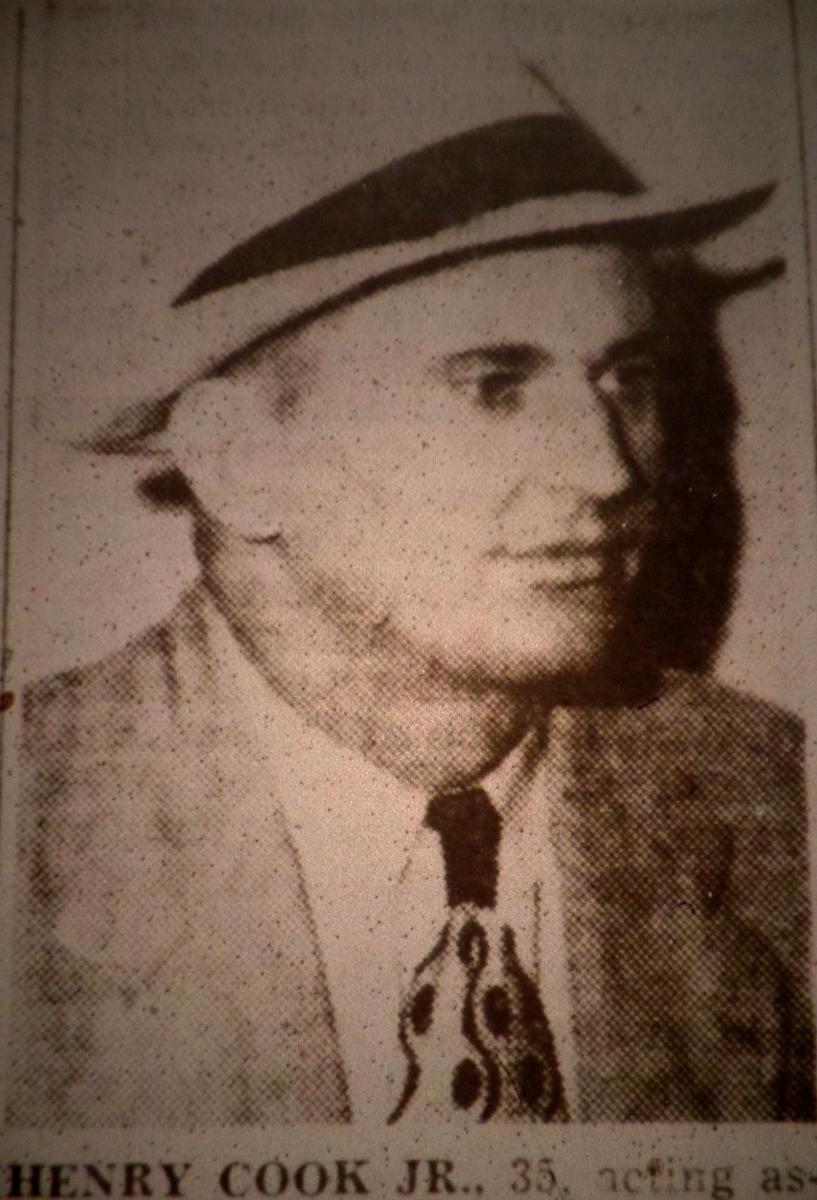
Earl Wetzel (1910-1962)-Acting Chief of Police and Henry W. Cook Jr. (1913-1951), Acting Assistant Chief of Police


Robert J. Castello (1913-1968), Captain and Louis J. Rosetti (1915-1971), Captain
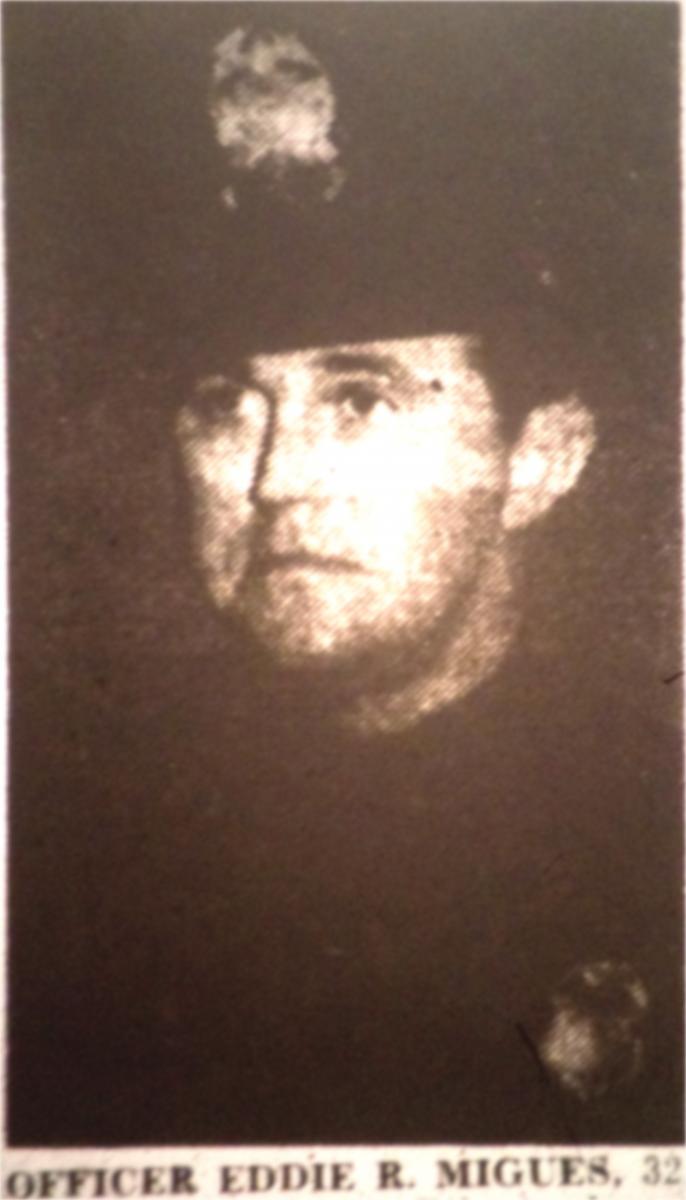
Eddie R. Migues (1916-2003)
1950
John J. Askin (1926-1950) of 403 Wisteria Lane expired on October 15, 1950. He had joined the Biloxi Police Department circa 1948 and left Bedola Seymour Askin (1926-2006), his spouse, and daughters, Betty Jean Askin and Patricia Ann Askin.(The Daily Herald, October 16, 1950, p. 12)
1951
Michael 'Mike' Skrnich, former fisherman and US Army verteran of WW II, and Robert 'Bob' Bellman, Word War II veteran, were hired by Chief Earl Wetzell.(The Daily Herald, March 2, 1951)
1952
Earl F. Batia (1929-1998), Fred Swetman and Rivers Loncon (1918-1989) were hired as police officers.(The Daily Herald, May 2, 1952, p. 6)
1953
Herbert R. McDonnell (1902-1974) was named Police Chief in July replacing Earl F. Wetzell (1910-1962).(The Daily Herald, July 6, 1953, p. 17).
1950s BPD
Front row: L-R: Jack Breal, Henry Lechner; Al Hermes; Ven Lee; Ola Mae Balius; Herbert McDonnell; Walter Williams; Louis Rosetti; ?; Louis Feranda Sr.; Emile Rousseau; and Jack Robinson.Back row: L-R: Ernest Mladinich; Bill Marie; Leroy Bourgeios; ?; Alan Sandoz; Ed Rugg; ?; Preston Coleman; Melvin Cruse; Gerald Ferrill; Junie Tiblier; ?; ? Boudin' and ?[IDed by with kind assistance of Edward Ryan, former Biloxi Police Chief]
1960
1963
1971
The Biloxi Police Union became affiliated with the AFL-CIO in October 1971. Captain Leroy Bourgeois said that the charter would be issued on October 29th at New Orleans and the local union would be called Local 673, SEIU, AFL-CIO. The Biloxi Police relinquished its affliation with the International Brotherhood of Police after holding membership for about a year and a half. Captain Bourgeios related that there were about 25 members in the local union.(The Daily Heral, October 27, 1971)
1972
Rose Street was changed to Rosetti Street by the Biloxi City Council in May 1972 to honor Biloxi Police Chief Louis A. Rosetti. Residents of Rose Street petitoned the City for the change. Mayor Daniel Guice related that the name change was not only in recognition of the late police chief, but of the whole Rosetti family who had served Biloxi for many years. Guice stated also that "we all enjoyed a close relationship with Chief Rosetti. He was a person with a heart of gold. Not only would he enforce the law, but would give help whenever and wherever needed, especially to low-income groups. I hope this action will show younger persons that by living the good life and serving the community as Chief Rosetti did, they will not be forgotten."(The Daily Herald, May 9, 1972, p. 4)
1973
Year of the 'Blue Flu epidemic' when 35 Biloxi policemen either resigned or were terminated and high ranking officials either retired or were transferred to other departments.
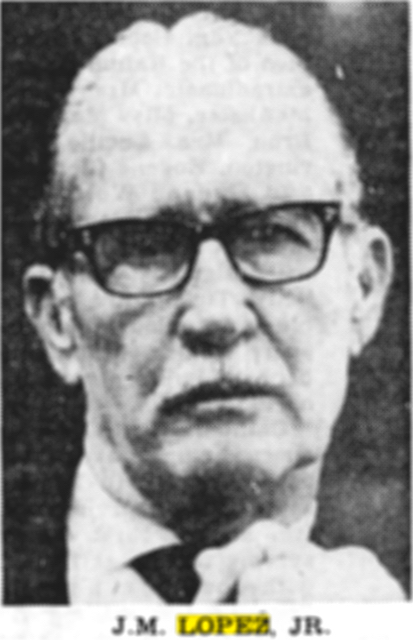
Julius M. Lopez Jr. [1908-1996] , a retired FBI AGENT, was named Biloxi's first Director of Public Safety. He was responsible for the police, firemen and recreation departments. Current Police Superintendent Leslie Montgomery was expected to resign and Fire Chief Frank Gabrich resigned 4 June.[The Daily Herald, June 8, 1973, p. 1]
Fourteen new police officers were sworn into service: Louis M. Atchison, James M. Besse, Thomas R. Curtiss, Wayne F. Garrote; Wayne E. Henning, Artis R. James Jr., Joseph B. Lesso Jr., Nicholas C. Martino, Lance C. McGill, Tommy Lee Moffett, Joseph C. Newman, James E. Pendergrass, Herbert L. Pickens, and Nickie F. Simmons.[The Daily Herald, October 2, 1973, p. 17]
1974
1975
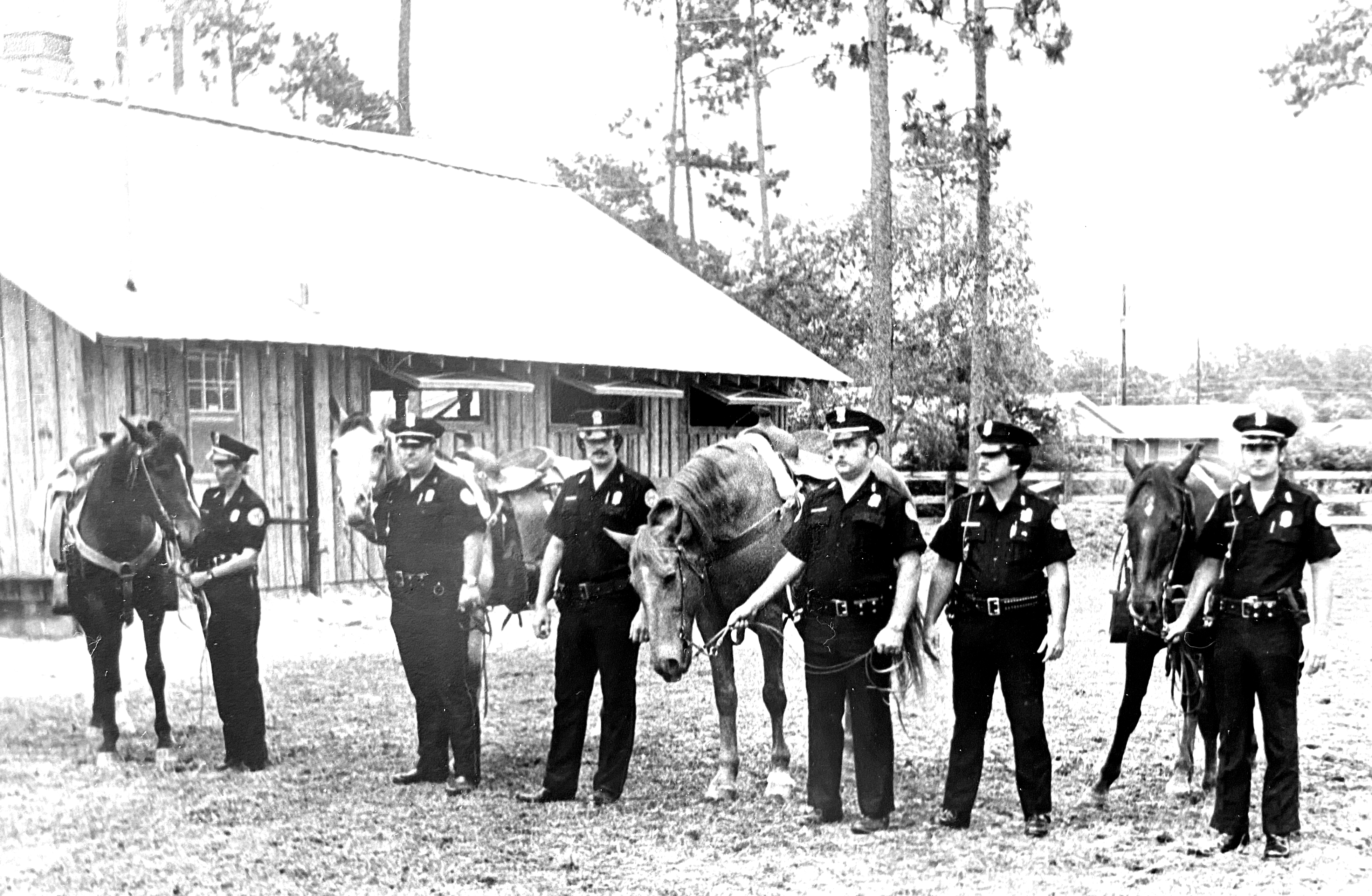
Biloxi Mounted Police Unit
[L-R: Patricia Milligan; Louis Milton Atchison; Terry Pesch; James Earl Pendergrass; Wayne Erwin Hennig; and M. Landry]
In early February 1975, J.M. Lopez Jr. [1908-1996], former FBI agent and Biloxi’s Director of Public Safety and Recreation, proposed the creation of a six-horse, manned patrol unit to provide security at Hiller Park, Howard Avenue and Magnolia Mall. Additional utilization of mounted policemen were crowd control and public protection for Mardi Gras, football games, festivals and surveillance of Biloxi’s sand beach. A stable to shelter the horses at Hiller Park was under construction. The mounted police unit became known at "Lopez's posse".[The Sun, February 6, 1975, p. B-6 and February 25, 1975, p. 1]
J.M. Lopez Jr. [1908-1996] resigned his position as Biloxi’s Director of Public Safety and Recreation effective August 29th.[The Sun, August 12, 1975, p. A-4]
The Biloxi City Council approved the contract for the sale of the Biloxi City jail to the Harrison County Board of Supervisors. The City will pay $3 per day to the County to house and feed its prisoners in the contract.(The Daily Herald, October 2, 1975, p. B-1)
Police Chief Lester J. Thompson (1941-2010) submitted a 25-year growth study of the Biloxi Police Department to city planners. The eight-month study was funded by the Law Enforcement Assitance Agency. It attempted to predict population growth patterns, urban problems, and the necessities of an ideally equipped Biloxi police force through the year 2000.(The Daily Herald, October 10, 1975, p. B-1)
1976
Police Chief Lester J. Thompson (1941-2010) submitted his resignation in June for medical reason. Mayor O'Keefe named Edward L. Ryan acting Police Chief effective 5 July.[The Daily Herald, June 12, 1976, p. 1]
1977
The Biloxi City Council voted to sell Joe, Red and Blackie, three of the horses of the mounted police unit. This action essentially terminated the patrol. Golf Carts had replaced the horse patrols in the malls last year because the horse maintenance was expensive.[The Sun, July 14, 1977, p. A-4]
Carl Ferguson, stable proprietor at Ocean Springs, offered $800 for the three Biloxi police horses.The mounted horse patrol operations became to expensive and golf carts replaced the equines in their former duties.[The South Mississippi Sun, August 2, 1977, p. A-4]
Harvey Felsher, former Biloxi Police officer, was sentenced to 15 years in the State penitentiary in the 2nd JD Harrison County Circuit Court after pleading guilty charges ranging from burlary and receiving stolen property. He was relieved from duty in 1973.(The Daily Herald, August 15, 1977, p. A2)
1979
The Biloxi Police Academy, the first organized on the Mississippi Coast, began its program in the summer to train Biloxi police officers as well as other Coast poliemen as a supplement to their training received at the Mississippi State Law Enforcement Academy near Jackson, Mississippi. Lt. Mike Green, chief training officer for the local academy, oversaw ten weeks of instruction both field and class room sessions for recruits. Police Chief Edward Ryan emphasized that the men received information about community relations; local ordinances-both city and county; media relations; and local geography.(The Daily Herald, October 9, 1979, p. A8)
1983
Kevin Ladnier, Biloxi officer, was released from a lawsuit filed in January by Charles Sykes, Gulfport attorney, against the City of Biloxi and Ladnier and Biloxi Patrolman Elmer Eugene Willis. Ladnier and Willis were officers of the Police Benevolent Association, a fraternal society.(The Daily Herald, March 22. 1983, p. A-2)
1985
Carl Wicker Short Jr. (1924-1989), Chief of Special Services for the Biloxi Safety Department retired in February 1985. Carl began his career with the Biloxi Police Department in 1947 as a desk sergeant and dispatcher. He was with the BPD for 32 years and was elected as a City Commissioner and served Biloxi from 1953-1957 as its Finance Commissioner.(The Sun Herald, October 28, 1989, p. C2)
1986
Biloxi City Council elects George W. Saxon (1927-2018) as new Police Chief on 12 August. Richard West, Public Safety Director, retired on 1 September.(The Sun Herald, August 13, 1986)
Tommy Lee Moffett became Biloxi's first Black Police Chief on 1 September. He joined the department on 1 October 1973.(The Sun Herald, August 14, 1986, p. A-1)
1987
1990
Ernest J. Mladinich Jr. (1906-1990), retired Captain of the BPD with twenty years of service, died at Biloxi on April 5, 1990.(The Sun Herald, April 6, 1990, p. C2)
1996
Richard Garry West (1937-1996), former Police Chief and Biloxi Public Safety Director expired on December 6, 1996.
2010
Lester J. Thompson Jr. (1941-2010), former Biloxi Chief of Police from 1963 to 1976, died on June 4th.(The Sun Herald, June 5, 2010).
2018
George W. Saxon (1927-2018), former MHP officer, Biloxi Chief of Police and Safety Director passed away on December 26, 2018 at Gulfport.(The Sun Herald, December 28, 2018)
2019
_____________________________________________________________________
NOTES
Peter Flanagan (d. 1846)
William P. Murray (1868-1895)
Joseph C. DeLamarre (1855-1931)
Francis Arbeau Caillavet (1856-1909)
Andrew J. Meynier (1856-1907)
Charles W. Blake (1841-1899)
Robert M. Mosley (1865-1910)
John A. McKinley (1852-1920)-Police Chief 1902-1905.
Louis Staehling (1865-1938)-Police Chief in 1906, 1908, 1910, and 1911
Richard M. Randolph (1867-1930+)
George Bills (1867-1945)
Alonzo Gabrich (1894-1948)
Laz Quave (1910-1985)-Police Chief 1943-1947 under Mayor Chester A. Delacruz.
Alonzo Gabrich (1894-1948)-Police Chief
Louis E. Anglada (1910-1955)
Earl F. Wetzell (1910-1962)
Herbert R. McDonnell (1902-1974)
Earl F. Wetzell (1910-1962)-Police Chief 1949-1953 and 1961-1962.
Frank Duggan
Lester J. Thompson (1941-2010)
Darrell David 'D.D.' Cvitanovich
George Waldron Saxon (1927-2018)
Tommy Lee Moffett (b. 1950)
Bruce Dunagan (b. 1950)
John Miller
BILOXI MARSHALS AND POLICE CHIEFS 1841-2011
1841-1841
PETER FLANAGAN
1888
WILLIAM P. MURRAY
Although little is know about William P. Murray's origin, he was active in Biloxi politics as early as 1888, when he was City Marshal, Assessor and Tax Collector and became a candidate for Mayor representing the Knights of Labor. Mr. Murray was opposed by John Walker, Emile Laudner, and Raymond Caillavet, his father-in-law and former Biloxi Mayor. William P. Murray lost to John Walker 181 votes to 103 votes, but outpolled Caillavet and Laudner who between them got only 51 votes of the over 300 casts in the mayoral election. William P. Murray (1868-1895) obviously did not ingratiate himself to Mayor-elect, John Walker (1834-1907), as he resigned his Marshal's post during the last week of March 1888 and was replaced with the appointment of Joseph C. ‘J.C.’ DeLamarre (1855-1931).(The Biloxi Herald, March 31, 1888, p. 8)
In February 1895, former Marshal, W.P. Murray found employment a bailiff in the US District Court at Mississippi City. William P. Murray expired shortly after this appointment. His death came on February 27, 1895 at Biloxi and his corporal remains were interred in the Biloxi Cemetery.(The Biloxi Herald, February 23, 1895, p. 8 and March 2, 1895, p. 8)
William P. Murray had married Emma Rose Caillavet (1869-1955), the daughter of former Biloxi mayor, Raymond Caillavet (1838-1898), and Zelina Joucheray (1841-1903), on May 19, 1891 at New Orleans, Louisiana. Their marriage was blessed by Father Blanc on July 10, 1891 at N.B.V.M.(The Biloxi Herald, July 18, 1891, p. 4 and Lepre, 1991, p. 236)
The two Murray children were born at Biloxi, Mississippi: Edgar Samuel Murray (1891-1922) m. Camelle Giglia; and Robert James Murray (1893-1986) m. Antonia Mary Lascola.(Lepre, 1991, p. 235)
Emma C. Murray and her children remained at Biloxi after the death of her spouse. By 1910, they were in residence on West Jackson Avenue. Edgar S. Murray was employed as a drugstore clerk and Robert J. Murray worked in a hardware store. Blanche Caillavet and Louise Caillavet, her sisters, were also in the Murray household.(1910 Harrison Co., Mississippi Federal Census T624_740, p. 3B, ED 35)
Mrs. Murray and her sons relocated to New Orleans and Edgar S. Murray expired here in April 1922. She worked as a hotel maid in the Crescent City and died there on August 30, 1955. Emma C. Murray’s corporal remains were interred in St. Vincent de Paul No. 1 Cemetery at New Orleans. Robert J. Murray lived at New Orleans until his death in September 1986.(The New Orleans State, April 16, 1922, p. 2, The Times-Picayune, September 1, 1955, p. 2, and The Times-Picayune, September 12, 1986, p. 23)
REFERENCES:
Jerome Lepre, Catholic Church Records Diocese of Biloxi, Mississippi, Volume I, (Catholic Diocese of Biloxi: Biloxi, Mississippi-1991)
Journals
The Biloxi Herald,“City News”, February 25, 1888.
The Biloxi Herald,“Official Municipal Vote”, March 10, 1888.
The Biloxi Herald,“City News”, March 31, 1888.
The Biloxi Herald, "Local Happenings”, July 18, 1891.
The Biloxi Herald,“The old and the new”, January 14, 1893.
The Biloxi Herald,“City Council”, August 11, 1894.
The Biloxi Herald,“Local Happenings”, January 26, 1895.
The Biloxi Herald,“Local Happenings”, February 23, 1895.
The Biloxi Herald,“Died”, March 2, 1895.
The New Orleans States, “Deaths for week”, April 16, 1922.
The Times Picayune,“Deaths [Emma R. Caillavet Murray]”,September 1, 1955.
The Times Picayune,“Deaths [Robert J. Murray]”, September 12, 1986.
1888-1892
JOSEPH C. DeLAMARRE
Joseph Charles ‘J.C.” DeLamarre (1855-1931) was born at New Orleans to Charles Davis Bougourd de LaMaire (1840-1909) and Louisa Godefroy (1833-1905). He was appointed Marshal of Biloxi in late March 1888, replacing the retiring William P. Murray (1868-1895). In late July 1888, Marshal DeLamarre collected $974 in real estate taxes for the City of Biloxi.(The Biloxi Herald,
Restaurateur
J.C. DeLamarre had been in the bar and restaurant business at Biloxi. He opened the White Elephant on the corner of Pass Christian Street [now Howard Avenue] and Main Street in April 1891. J.C. DeLamarre also had a local baseball squad called the ‘White Elephants’. His brother, Emile DeLamarre (1871-circa 1893), called ‘Melo’, also had a team, the ‘Sporting Dudes’. Melo challenged the White Elephants to a ‘friendly’ game of baseball in June 1892. Melo was captain and catcher of his Biloxi nine.(The Biloxi Herald, April 4, 1891, p. 4 and June 25, 1892, p. 4)
Resignations
J.C. DeLamarre resigned as Marshal in April 1891 and was replaced by F.A. Caillavet. Mr. DeLamare opened the WHITE ELEPHANT, a saloon, on the corner of Pass Christian Street and Main Street.[The Biloxi Herald, April 11, 1891, p. 1]
J.C. DeLamarre resigned again from his Marshal’s post on March 6, 1896. It became effective on March 15, 1896 much to the regret of the City Council and his friends. At this time, J.C. DeLamarre was domiciled on the east side of Magnolia Street in the first house south of Pass Christian Street. He vended fine and unusual flowering plants.(The Biloxi Herald, March 7, 1896, p. 8)
Candidate
By 1898, the Biloxi Marshal was no longer appointed and had to run for office.
Louisiana
Joseph C. DeLamarre and family relocated to Bayou La Maire in coastal South Louisiana. They returned to Biloxi following the 1915 September Hurricane which destroyed all of their possessions. Mr. DeLamarre became caretaker of the J.M. Lopez bungalow.(The Daily Herald, December 22, 1915, p. 2)
Popp’s Ferry fish Camp
J.C. DeLamarre, a former Biloxi City Marshal and ferry tender, was probably the first to open a simple fish camp operation at Popp’s Ferry. He was here between 1919 and 1921. J.C. DeLamarre had been in the bar and restaurant business at Biloxi. He opened the White Elephant on the corner of Pass Christian Street [now Howard Avenue] and Main Street in April 1891. J.C. DeLamarre also had a local baseball squad called the ‘White Elephants’. His brother, Emile DeLamarre (1871-circa 1893), called ‘Melo’, also had a team, the ‘Sporting Dudes’. Melo challenged the White Elephants to a ‘friendly’ game of baseball in June 1892. Melo was captain and catcher of his Biloxi nine.(The Biloxi Herald, April 4, 1891, p. 4 and June 25, 1892, p. 4)
J.C. DeLamarre married Rosa M. Trahant (1867-1896) at New Orleans in June 1887. She expired at their home on Magnolia Street in Biloxi on February 29, 1896. Mr. DeLamarre was City Marshal at the time of her demise.(The Biloxi Herald, February 29, 1896, p. 1)
After the death of his spouse, J.C. DeLamarre wedded Annie Brewer Coleman (1887-1930) from Tylertown, Mississippi. She had a son, Robert H. Coleman who resided in Gulfport. After his fish camp closed, J.C. DeLamarre was employed at the Great Southern Golf Club in Gulfport from 1921 to 1928, and was superintendent of the Naval Reserve Park at Biloxi until his retirement. Annie Brewer Coleman DeLamarre died at Gulfport in late May 1930. J.C. DeLamarre expired on May 4, 1931 and his corporal remains were interred in the Biloxi Cemetery.( The Daily Herald, May 31, 1930, p. 6 and May 5, 1931, p. 8)
Joseph Rusk resigned his position as ferry keeper and was replaced in October 1916 by Joseph C. DeLamarre (1855-1931). Dutch Caldwell was made keeper of the Tchoutacabouffa Bridge at this time.(The Daily Herald, October 20, 1916, p. 1)
Joseph C. DeLamarre, ferry tender, remained at the ferry landing and opened a fishing camp. In September 1919, he married Annie Coleman of St. Bernard Parish, Louisiana. J.C. DeLamarre stayed at Popp’s Ferry until 1921, when the County lost a law suit to W.H. Rich (1885-1971) and W.B. Swain of Gulfport and he and the County ordered to vacate the land by Chancery Court Chancellor Griffith. The denizens of the Popp’s Ferry and North Biloxi region had hoped that the judiciary would allow the ferry landing to have remained under the aegis of the Harrison County Board of Supervisors. It was believed that if the Back Bay Bridge from North Biloxi, now D’Iberville, to BiloxI were closed by a fire or hurricane that a ferry could be placed into service at Popp’s Ferry in short order.(The Daily Herald, September 19, 1919, p. 2. February 18, 1921, p. 1, and March 2, 1921, p. 6)
REFERENCES:
Journals
The Biloxi Herald ,“City News”, March 31, 1888.
The Biloxi Herald, “City News”, July 28, 1888.
The Biloxi Herald, Latest City News”, April 11, 1891.
The Biloxi Herald ,“Latest City News”, March 7, 1896.
The Biloxi Daily Herald, “Latest City News”, August 20, 1898.
The Biloxi Herald,“”,
_________________________________________________________________
1892-1893
MARSHAL FRANCIS A. CAILLAVET
Francis Arbeau Caillavet (1856-1909) was born in Biloxi in 1856. His parents were Francois Caillavet (1815-1883) and Euranie Fayard (1818-1895).
On September 20, 1878, he married Marie Dodart (1858-1942) of New Orleans. This union produced thirteen children, but five died in early childhood: Marie Louise Caillavet (1880-?); Mark Latour Caillavet (1888-1891); Joseph Clarence Caillavet (1890-1893); Beulah Antoinette Caillavet (1893-?); and Ralph Caillavet (1897-1899).
Francis A. Caillavet was survived by eight children: Laura Caillavet (1877-1954) married Christian Armand Thompson (1895-1959); Viola Caillavet (1884-1968) married Frederick Philippe Abbley (1882-1940) and Jessie Jefferson Coffey; Anita Margaret Caillavet (1886-1975) married Percy James Wetzel (1882-1929); Francis Arbeau Caillavet (1881-1946) m. Margaret Cox; Sidney Caillavet (1892-1984); Albert 'Ish' Joseph Caillavet (1895-1939) m. Elizabeth M. Caillavet (1899-1994); Wilfred Christian Caillavet (1898-1953) m. Josephine DeGeorge (1906-1979); and Hilda Mercedes Caillavet (1900-1926) married Kenneth Ackley.(Lepre, 1991, p. 1 and pp. 45-47)
F.A. Caillavet served his fellow Biloxians as Marshal from April 1891 until 1893. He was chosen Marshal by the town council on April 6, 1891 to replace J.C. DeLamarre. Mr. DeLamarre opened the “WHITE ELEPHANT”, a saloon, on the corner of Pass Christian Street and Main Street.[The Biloxi Herald, April 11, 1891, p. 1]
Francis Arbeau Caillavet was a member of the Pilot's Association from 1900 to 1909. The Caillavet Family resided at 811 Jackson near Couevas Street. The last two years of his life were lived in poor health and he died from a heart ailment.[The Biloxi Daily Herald, "May 6, 1909, p. ]
REFERENCES:
Jerome Lepre, Catholic Church Records Diocese of Biloxi, Mississippi, Volume I, (Catholic Diocese of Biloxi: Biloxi, Mississippi-1991)
The Biloxi Herald, "Town Council”, April 11, 1891.
The Biloxi Herald, "Removal”, April 11, 1891.
The Biloxi Daily Herald, "Necrology-Frances Arbeau Caillavet”, May 6, 1909.
The Daily Herald, “Mrs. Kenneth Ackley dies”, September 8, 1926.
The Daily Herald, “Arbeau Caillavet dies”, August 21, 1946.
The Daily Herald, “”, .
The Daily Herald, “”,
Personal Communication:
Letter dated February 7, 1976 from Eunice Abbley Brocato.
––––––––––––––––––––––––––––––––––––––––––––––––––––––––––––––––––––––––––
A.J. MEYNIER
––––––––––––––––––––––––––––––––––––––––––––––––––––––––––––––––––––––––––––
1897-1899
CHARLES WATSON BLAKE
Charles W. Blake (1841-1899) was a native of Galway, Ireland. Circa 1885, he married Mary Blable Sokal (1854-1927), an 1872 Austrian immigrant and the widow of Joseph Sokal. In Pennsylvania, Mary Blable and Joseph Sokal had Mary Gertrude Sokal (1881-1956), a daughter, who was known in Biloxi as Mamie Blake. Mamie Blake married Charles Henry at New Orleans in early October 1901. They apparently divorced shortly after their betrothal.(
Charles and Mary S. Blake were the parents of children: Jefferson Davis Blake (1886-1940) m. Jessica L. Wilson (1889-1930); Winnie Blake (1889-1965) m. Albert Holliman (18-1929) and Ambrose Emile Berthelote (1893-1954); and Edward Blake (1893-1979).
Marshal Blake
The fall of 1898 was very pleasant in Biloxi for Marshal Blake and Robert M. Mosley (1865-1910), his patrolman. The Biloxi Daily Herald related that Marshal Blake was busy counting the street lights and Officer Mosley complained that there was 'no business'. The reporter opined of these halycon days as follows: "Biloxi is fortunate that her policemen have nothing to do but draw their salaries. It is the best way to earn their pay."(The Biloxi Daily Herald, September 27, 1898, p. 4)
Marshal Blake became ill and retired from his position on December 31, 1898. He was lauded for his conscientiousness and faithfullness to his office and duties. C.W. Blake expired at his Lameuse Street residence on April 5, 1899. Robert M. Mosley (1865-1910) took his post as City Marshal (1865-1910).(The Biloxi Daily Herald, January 1, 1899, p. 1 and April 5, 1899, p. 8)
Rooming House
Mary Blake was the proprietor of a boarding house at 131 Lameuse Street in Biloxi. Mary Sokal or Sokili or Dlable Blake (1854-1927), the widow of Marshal Blake, relocated to New Orleans [NOLA] between 1910 and 1920 with Mamie Blake and Winnie Blake Holliman, her two daughters. They were employed in a cotton mill there. Mary expired at NOLA on June 5, 1927. Her corporal remains were shipped to Biloxi for internment in the Biloxi Cemetery. Jefferson Davis Blake (1886-1940) and Winnie Blake Holliman (1889-1956), her children, and Charles Watson Blake (1841-1899), her spouse are also buried at Biloxi.(Smith, 1905, p. 62)
REFERENCES:
W.W.A. Smith, compiler, 1905 Biloxi City Directory, Volume I, (Biloxi Daily Herald Printery: Biloxi, Mississippi-1905).
Journals
The Biloxi Herald,“”,
The Biloxi Herald,“Local and Personal”, September 27, 1898.
The Biloxi Herald,“Local and Personal”, January 3, 1899.
The Biloxi Herald,“Local and Personal”, January 3, 1899.
The Biloxi Daily Herald, “Local and Personal”, April 5, 1899.
The Biloxi Daily Herald, “City News”, October 5, 1901.
The Biloxi Daily Herald, “City News”, October 6, 1901.
The Biloxi Daily Herald, “On sloop’s topmast for twelve hours”, August 17, 1902.
The Daily Herald, “Mrs. Blake dies”, June 6, 1927.
The Daily Herald, “J.D. Blake dies”, October 1940.
The Daily Herald, “”,
The Times Picayune, “Faded souvenirs of Jefferson Davis”, June 21, 1953.
The Times Picayune,“Deaths [Ambrose E. Berthelote]”, July 15. 1954.
The Times Picayune,“Deaths [Louis W. Holliman]”, September 7, 1954.
The Times Picayune, “Deaths [Mamie Blake]”, May 9, 1956.
The Times Picayune,“Deaths [Winne Berthelote]”, November 22, 1965.
_____________________________________________________________________________
ROBERT MARION MOSLEY
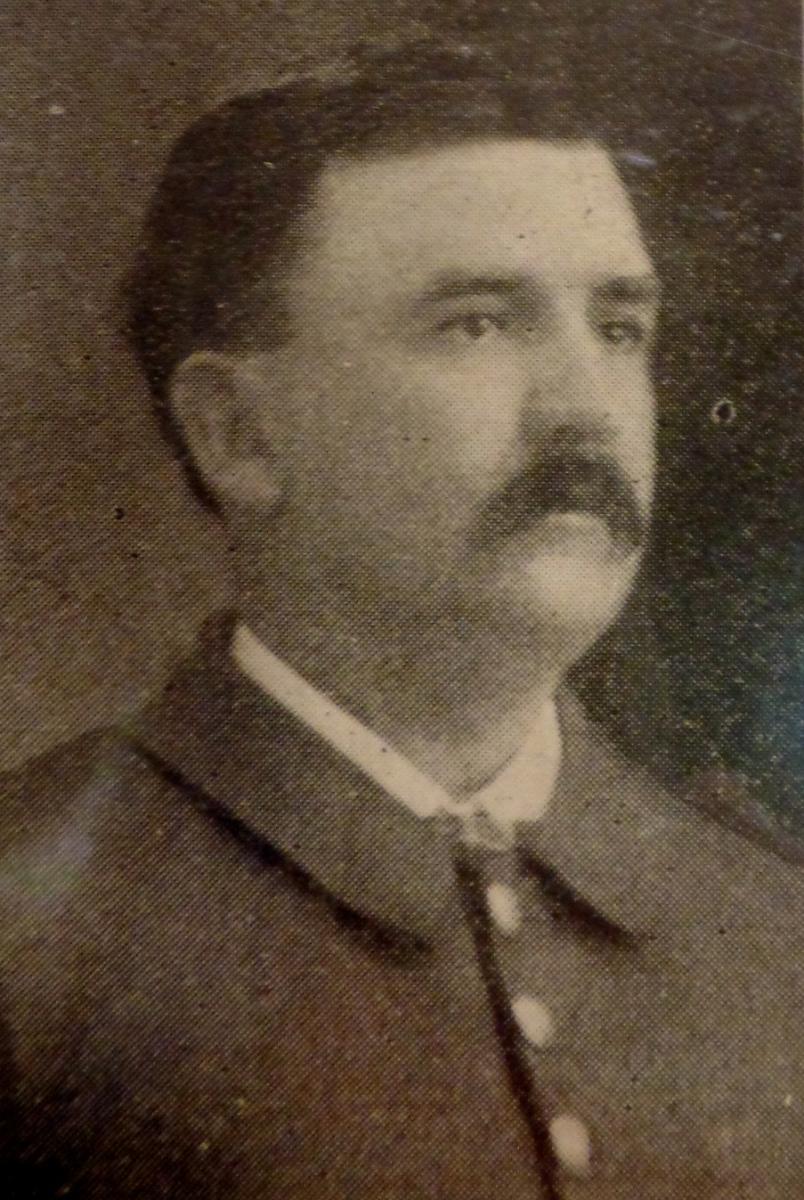
ROBERT M. MOSELY
Robert Marion Mosley (1865-1910) was born in 1865 in Kemper County, Mississippi. He married Mary Elizabeth Naylor (1869-1948), the daughter of Louis Naylor and Cornelia Ramsay, and also a native of Kemper County. There only child was Dr. Robert M. Mosley Jr. (1886-1951).
Robert became a policeman at Meridian, Mississippi attaining the rank of Sergeant. The family relocated to Biloxi and he joined the BPD. Officer Mosley became Biloxi's Marshal upon the resignation of C.W. Blake in late December 1898.
Marshal Mosley and Officer McKinley captured 10 white crap shooters at Point Cadet yesterday.They pleaded guilty in court and were fined $5 and court costs. Marshall Mosely had started to break gambling in Biloxi without regards to who indulges in it. Stir clear of alluring cards and fascinating bones, if you do not want to appear in city court.(The Biloxi Daily Herald, January 17, 1899, p. 8)
Robert M. Mosley resigned as Biloxi's Marshal on 2 September 1902 to become the first Chief Inspector for the Mississippi Oyster Commission which had been created by the 1902 Bower's Bill.[The Biloxi Daily Herald, September 1, 1902, p. 1]
REFERENCES:
The Biloxi Daily Herald, Business and Professional Men, (The Biloxi Daily Herald: Biloxi, Mississippi-1902).
The Biloxi Daily Herald, “Local and Personal”, January 17, 1899.
The Biloxi Daily Herald, “Mosley is [oyster] inspector”, September 1, 1902.
The Daily Herald, “Four hundred skiff licenses this year”, December 10, 1909.
The Daily Herald, “R.M. Mosley in dying condition”, November 21, 1910.
The Daily Herald, “R.M. Mosley passes away”, November 1910.
The Daily Herald, “Eulogy for R.M. Mosley”, November 24, 1910.
The Daily Herald, “Oyster Commission passes resolutions”, December 1, 1910.
The Daily Herald, “
_____________________________________________________________________________
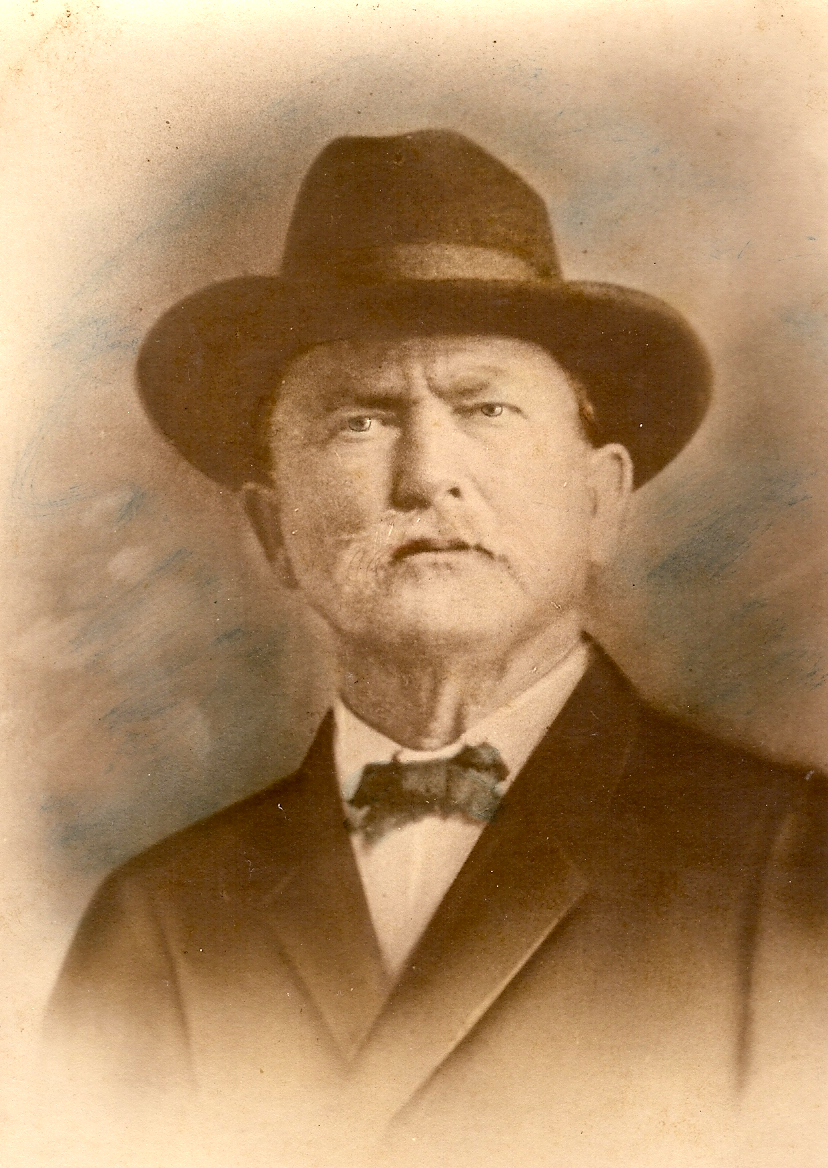
JOHN A. McKINLEY
John Augustus McKinley (1852-1920) was born April 27, 1852 at Lauderdale, Mississippi to Robert McKinley and Mary Daniels. He married Kate Kennedy Carroll (1856-1921). They were the parents of seven children of which five lived into the 20th Century. Known children are: Floyd McKinley (1872-1884); Ella Jane McKinley (1875-1933) m. Asa James Simmons (1859-1933); Mary Alma McKinley (1878-1936); Louis Fennel McKinley (1889-1931); and Augusta 'Gussie' McKinley (1893-1960) m. Houston Alonzo Mobley (1888-1953).
The McKinley family came to Biloxi in 1896 and resided at 557 Nixon Street. J.A. McKinley had served the town of Lauderdale, Mississippi as its Marshal for two years and had been a member of the Meridian Police Department for many years. He joined the Biloxi Police Department as a officer and was known to the citizenry as "Mr. Mac". The local journal lauded his as follows: "Mr. Mac stands high in social circles. He enjoys the good will and esteem of everyone-old and young.(The Biloxi Herald, September 3, 1902, p. 1)
When Marshal Robert M. Mosley resigned in the fall of 1902, McKinley was appointed by Biloxi's alderman to replace him. R.M. Randolph was his only opposition. Sardin George was added to the BPD at this time.(The Biloxi Daily Herald, September 3, 1902, p. 1)
The McKinley family left Biloxi circa 1915 for Columbia, Mississippi. Here he operated the McKinley Hotel until his death on September 7, 1920. Marshal McKinley's internment was in the Columbia City Cemetery.(The Daily Herald, September 9, 1920, p. 1)
REFERENCES:
The Biloxi Daily Herald, “For Marshall”, August 25, 1900.
The Biloxi Daily Herald, “McKinley is new Marshal”, September 3, 1902.
The Biloxi Daily Herald, “Contest talked of”, December 15, 1904.
_____________________________________________________________________________
LOUIS A. STAEHLING

Louis Aloysius Staehling, age 72 years, chief oyster inspector for the Mississippi Seafood commission, died at 3:45 a.m. today at the United States Marine Hospital, New Orleans, where he had been for about two reeks. He had rallied considerably when pneumonia set in with fatal result(s). He was a native of Alsace-Lorraine where he was educated. He came to the United States in 1884, settling in New Orleans the same year, and coming to Biloxi four years later. He engaged in the bakery business for six years, then was in the livery business with the late R. M. Mosley until he was appointed city marshall in 1907, which position he held until 1918.
Louis served as deputy sheriff for a year and was appointed chief oyster inspector in 1919. His wife, Henrietta Hilderbrand, died in 1930. His children were: Louis A. Staehling, Biloxi; Percy Stealing , New Orleans; Noel Stealing, Biloxi; Mrs. Elizabeth Nauck, Mrs. F. A. Barthes, Mrs. Walter Schneller, Biloxi; and Mrs. Claude Simon (sic), New Orleans. He also leaves a sister, Mrs. George Reisbect, and a niece Florence Reisbect, Norwood, Ohio.
Mr. Staehling was a past exalted ruler of the Biloxi Lodge of Elks, also a member of the Woodmen of the World, Maccabees, West End Fire Co., Chamber of Commmerce, Knights and Ladies of Security, Knights of Columbus, Biloxi Benevolent Association, of which he was president, and also was president of the hospital board when the new hospital was built. Mr. Staehling spoke and wrote four languages. He was most interested in fraternal charity work and his hobby was football and baseball. During his long residence in Biloxi he was prominent in virtually all civic, political, fraternal and other activities and was widely known and beloved. He had been sick for over a year.
The funeral will be at 4 p.m. Sunday from the residence of Francis Barthes, 502 Seal avenue, with services at the Church of the Nativity by Father W. Leach, pastor. Burial will be in Biloxi Cemetery beside the body of his wife.
REFERENCES:
The Daily Herald, "L. Staehling Is Taken By Death", January 15, 1938.
RICHARD M. RANDOLPH
Richard M. Randolph (1867-1930+) was born in Panola County, Mississippi in March 1867 to M.M. Randolph (1826-1909) and Cornelia K. Randolph (1836-1911), natives of Virginia and Alabama respectively. He was reared with his six siblings on a farm in the Popes and Knights Ferry Precincts and the family later resided in Courtland, Panola County, Mississippi.
The corporal remains of R.M. Randolph's parents and several siblings were interred in the Antioch Cemetery at Panola County. (1880 Panola Co., Mississippi Federal Census R661, p. 29, ED 1)
The Daily Herald, “Randolph victim of loose system”, June 12, 1917.
The Daily Herald, “Randolph visits Biloxi”, january 29, 1921.
Officers: Benjamin F. Ewing (1892-)
The Daily Herald, “”,
The Daily Herald, “George Bills dies at Biloxi home”, July 18, 1945.
_____________________________________________________________________________
1932?-1933
ALONZO L. GABRICH
.jpg)
Alonzo Gabrich retired as Police Chief on January 4, 1943 after 24 years with the BPD. His tenure as Police Chief totaled 14 years. Gabrich started with the City of Biloxi working as an office boy for W.G. Henderson. He became Sanitary Inspector, collected street taxes and drove a fire wagon. [The Daily Herald, January 4, 1943, p. 5]
The Daily Herald, “”,
The Daily Herald, “”,
__________________________________________________________________________________
1933-
GEORGE BILLS
_____________________________________________________________________________
1943-1947
LAZ QUAVE
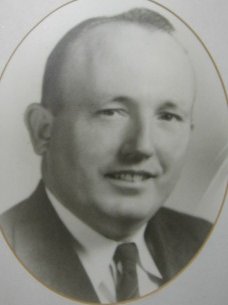
LAZ QUAVE
Laz Quave (1910-1985) was born on October 31, 1910, in rural Jackson County, Mississippi, near Vancleave, the son of Joseph Quave (1859-1928), a farm laborer, and Della ? Quave. In 1930, Laz Quave was a seaman stationed aboard the USCG Cutter Tallapoosa, near Annapolis, Maryland.(1930 Anne Arundel Co., Maryland Federal Census R 844, p. 29A, ED11)
Venus and Quave
On September 4, 1968, the Biloxi Canning & Packing Company was chartered by D.J. Venus III, Gordon D. Venus, and Laz Quave with 150,000 shares par value at $1.00 per share.(HARCO, Ms. Chancery Court Charter Bk. 2, pp. 179-182)
On September 9, 1968, the Charter of Biloxi Canning & Packing Company was amended and the name changed to Rosalis, Inc. Roy Rosalis (1909-1984), president, and Rena LeBlanc Rosalis (1917-2004), secretary, 300 shares issued.(HARCO, Ms. Charter Bk. 2, pp. 175-178).
On October 10, 1968, Rosalis, Inc. conveyed to Biloxi Canning & Packing Company for $610,000, all improvements, buildings, warehouses, docks, wharves, with riparian and littoral rights. (go 413.4 south along east side of Anglada x Landers x 253' x Chartres Street (332.9) x 136' (Stanovich) x Back Bay to point of beginning on Anglada). The sale included the following brands: Negro Head, Biloxi, Sea Beach Canned Shrimp, Mobile Bay, Danny Boy, and Pueblo. Mr. Rosalis then retired and resided at 872 Central Beach Boulevard.(HARCO, Ms. Trust Deed Bk. 535, p. 47 and Bk. 535, p. 50).
Laz Quave was a Deputy Sheriff in Harrison County, Mississippi during the term of Raleigh Clifton 'R.C.' Edwins (1897-1960) from 1939 to 1943.
Police Chief
Laz Quave was named Biloxi's Police Chief by Mayor Chester A. Delacruz in January 1943. He replaced Alonzo L. Gabrich, long-time Biloxi public servant. Police Chief Quave named Louis Anglada his assistant. Other members of Quave's staff were: Earl Wetzel, City Detective; Arthur Largilliere, Desk Sergeant; Joseph Mattina; Charles Comeaux; Vincent Fernandez; Albert Demoran; Oswald Chatham; Henry Cook; Al Boehm; S.O. Hall; John Labash; and Floyd Gill.(The Daily Herald, January 4, 1943, p. 5)
Sheriff Quave
Laz Quave was elected Sheriff of Harrison County, Mississippi in August 1947 when he defeated Aubrey Beeson of Long Beach by about fourteen hundred votes. He succeeded Maxie M. Broadus (1906-1985) of Gulfport.(The Daily Herald, August 30, 1947, p. 1)
When Laz Quave placed his name in the race for Mayor of Biloxi, he was in competition with R. Hart Chinn, incumbent, Norman Levine (1918-1953+), poultry marketer, and Elmer Williams, owner of the DeJean Packing Company.(The Daily Herald, April 13, 1953, p. 1)
Supervisor Quave
From July 1962 to December 1971, Laz Quave served the people of Harrison County, Mississippi Beat 1, as their County Supervisor.(Sullivan, 2002, p. 581)
Laz Quave expired at New Orleans on December 20, 1985. His corporal remains were interred in the Biloxi City Cemetery. Bernice Thornton Quave followed her husband in death passing on February 26, 2000 at Gautier, Mississippi. Her corporal remains were also buried in the Biloxi City Cemetery.(The Sun Herald, February 29, 2000, p. A5 and December , 1985, p. )
REFERENCES:
Charles L. Sullivan, Mississippi Gulf Coast Community College: A History, (McNaughton & Gunn, Inc.: Saline, Michigan-2002)
Journals
The Daily Herald, “New Police Chief”, January 4, 1943.
The Daily Herald, “May 12 ballot at Biloxi will have 19 names listed”, April 13, 1953.
The Daily Herald, "Coast Mayors take office", July 6, 1953, p. 1.
The Daily Herald, “Quave Grand Marshal, Ross East End Marshal”, July 8, 1954, p. 23.
The Jackson County Times, “Quave is elected in Harrison”, August 30, 1947.
The Sun Herald, "Biloxi leader Laz Quave dies", December 22, 1985, p. A-1 and p. A-12.
The Sun Herald, “Bernice Quave”, February 29, 2000, p. A5.
_____________________________________________________________________________
1947-
ALONZO L. GABRICH
REFERENCES:
The Daily Herald, “New Police Chief”, January 4, 1943.
The Times Picayune,“Gabrich receives gift from friends”, January 5, 1943.
The Times Picayune,“”,
_____________________________________________________________________________
.jpg)
LOUIS E. ANGLADA
Louis Emmett Anglada (1910-1955) was born October 29, 1910 to Louis Anglada (1871-1955) and Lenora Duggan (1875-1948). He married Winona Ross. Children: Marvin Anglada and Patrick Anglada. Died June 13, 1955.
Assist Police Chief
Louis E. Anglado (1910-1955) was appoined acting Police Chief of Biloxi in July 1944. He joined the Biloxi force in 1935 and worked his way to assist chief from a uniformed officer and dectective. Chief Anglado is a member of the Knights of Columbus, Fishermen's Union, Mississippi-Tennessee Peace Officers and Back Bay Fire Company.(The Daily Herald, July8, 1944, p. 3)
FBI School
In April 1948, Louis Anglada, Chief of Police, and Sheriff Laz Quave sponsored a two-week, police training school at the Biloxi City Hall. FBI agents from Gulfport, NOLA, and Greenville, Mississippi worked with Biloxi policemen on the following law enforcement subjects: care and use of firearms; evidence in crime scene search; traffic; disarming and defensive tactics; and testifying in court. The classes were attended by by about fifty, Mississippi coast, law officers.(The Daily Herald, April 30, 1948, p. 10)
REFERENCES:
The Daily Herald, “Anglado appointed acting Police Chief”, July 8, 1944.
The Daily Herald, “FBI police school will close today”, April 30, 1948.
The Daily Herald, “”,
The Times Picayune,“Deaths”, June 14, 1955.
__________________________________________________________________________________
1950-1953
1961-1962
EARL F. WETZELL
EARL F. WETZEL (1910-1962) [Courtesy of Thomas Walker-May 2011]
EARL F. WETZEL
Earl Francis Wetzel (1910-1962) was born on January 2, 1910 at Biloxi, Mississippi to Percy James Wetzel (1882-1929) and Anita Caillavet (1886-1975), the daughter of Francis Arbeau Caillavet (1865-1909) and Marie Dodart (1858-1942). Percy J. Wetzel and Anita Caillavet were married in Harrison County, Mississippi on September 12, 1906. Their other children were: Percy J. Wetzel Jr. (1907-1980) m. Jacobina Sekul; Marguerite Anita Wetzel m. John Edwin Webb; and Albert Howell Wetzel (1913-1994) m. Dorethea Ann Grantham.(Harrison County, Mississippi Circuit Court MRB 18, p. 295)
Earl Wetzel married Helen Baker and they were the parents of three son: Earl Wetzel Jr.; John Wetzel; and
Earl Wetzel began his long tenure with the Biloxi Police Deoartment in 1937 as a part time desk clerk. Two years later he was promoted to a patrolman and pounded his Biloxi beat until 1943 when Chief Laz Quave appointed Earl as city detective. In 1944, Wetzel became acting assistant Police Chief, but in 1945 became city detective again. In 1948, Earl was named assistant Police Chief and in 1949 appointed Biloxi's acting Police Chief. He was named Police Chief in 1950 and was suceeded by Herbert McDonnell in July 1953.(The Daily Herald, June 7, 1953, p. 12)
When Daniel Guice was elected Mayor of Biloxi in 1961, he and William Dukate (b. 1941) and A.J. ‘Tony’ Creel (1901-1992), City Commissioners, appointed Earl F. Wetzel (1910-1962) as Police Chief to replace Herbert R. McDonnell (1902-1974). Freddie Fritz Steinwinder (1907-1987) was chosen as Biloxi’s assistant Police Chief.(The Daily Herald, July 3, 1961, p. 7 and The Times Picayune, July 4, 1961, p. 25)
REFERENCES:
The Daily Herald, "New Police Chief", January 4, 1943.
The Daily Herald, “Wetzel and Cook renamed heads of Biloxi Police”, January 5, 1951.
The Daily Herald, “New city judge; police heads reappointed”, January 5, 1951.
The Daily Herald, “Wetzel leaves Police after 17 years of service”, June 7, 1953.
The Daily Herald, "Steinwinder new assistant Chief of Police", July 3, 1961.
The Times Picayune,“Wetzel to head Police at Biloxi”, July 4, 1961.
The Times Picayune,“Chief of Police at Biloxi dies”, September 21, 1962.
__________________________________________________________________________________
1953 and 1961
HERBERT R. MCDONNELL
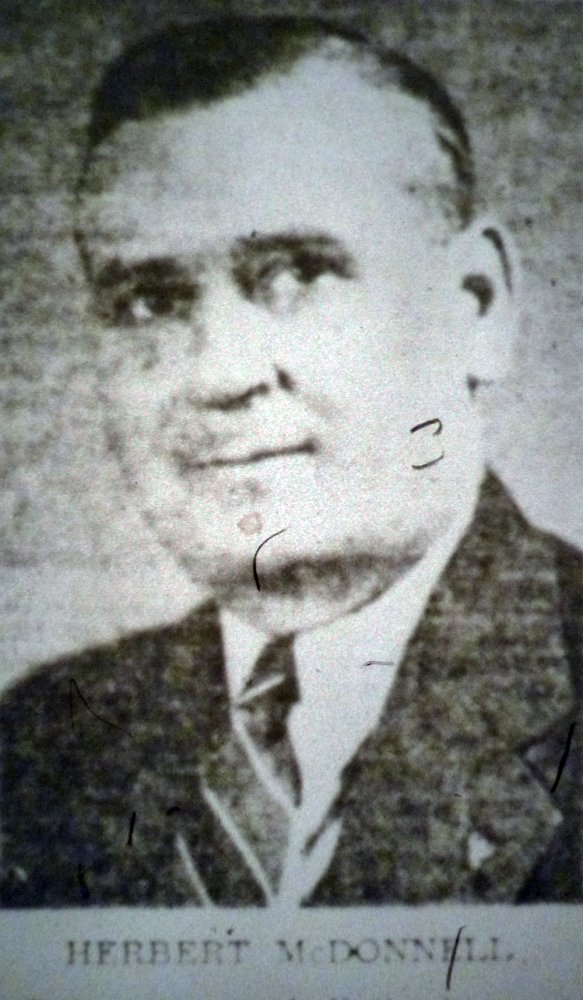
HERBERT R. MCDONNELL
1953
Herbert R. McDonnell (1902-1974) became Biloxi's Police Chief on July 6, 1953 when he was appointed to this position by Mayor Laz Quave (1910-1985). Walter Williams (1909-1981), former Biloxi police captain, was appointed assistant police chief. He was formerly employed at Keesler AFB and the Westergard Shipyard. Williams has a wife and two children and is the proprietor of a grocery store on Caillavet Street. Chief McDonnell planned to make immediate changes in the department to increase it to maximum efficiency. His first dictum was that: "Every man will put in a full day's work."(The Daily Herald, July 6, 1953, p. 1 and p. 17 and July 7, 1953, p. 12)
Herbert R. McDonnell had been a painter and seafood worker until he joined the Biloxi Police Department in 1934 as a patrolman during the Mayor John J. Kennedy administration. He was a city detective when he resigned from the Biloxi force in May 1941 to run for the newly created post of Constable. He was elected Constable Beat I in June 1941 easily defeating beating George Mon and Felix Mattina.(The Daily Herald, June 11, 1941, p. 1, July 6, 1953, p. 1. and July 1, 1961, p. 8)
1953 BPD
In July 1953, the Biloxi Police Department employed thirty-six people. In addition to Chief McDonnell and assitant Chief Williams, the department was staffed by the following: Captains-Emile Rousseau (1921-1987), Vincent P. Feranda Sr. (1905-1976) and Charles Comeaux. City Detective-Louis Rosetti (1915-1971). Identification Officer-James Robertson. Desk Sergeants-Sam Ellzey, Edmond Boudreaux, and Alvin Ryan. Officers-Joe Demoran, Oswald Luxich, Vincent P. Feranda Jr. (1927-2007), Junie Tiblier, Joe Parsons, Henry Lechner Jr., Norwood Sandoz, James Kriss, Arnold J. Barras (1925-1999), George Wallis, Bill Marie, Elwood Cox, Cornelius Cruthirds, L.J. Bourgeios, Leslie Montgomery, Bob Breal, Jack Breal, Benton Jermyn, Melvin Cruz, George Emile, and Leo Richard. Jailers-Louis Lee and Fred Fountain. Parking meter inspector-Ernest Mladinich. Truant officers-Dominic Fallo and Ola Mae Wallis Balius (1914-1996), the wife of Frank Balius. Those released from the department were: Chief Earl Wetzell (1910-1962), Captain Norris Herring, Captain E.P. Vincent, Officers Hall, Arnold Martino, and Desk Sergeant Gill Moran. Officer Batia resigned and Mayor Chinn released traffic inspector Clarence Pitfield from service.(The Daily Herald, July 6, 1953, p. 17)
1957
was appointed as assistant Police Chief at this time. Both men had an impressive resume in the law enforcement field. (The Daily Herald, )
REFERENCES:
The Daily Herald, “McDonnell named new Constable”, June 11, 1941.
The Daily Herald, “McDonnell, Clark are named heads of Police, Firemen”, July 6, 1953.
The Daily Herald, “McDonnell plans Police changes”, July 7, 1953.
The Daily Herald, “Biloxi Police Chief on retirement”, July 1, 1961.
The Daily Herald, “Steinwinder new assistant Police Chief of local police”, July 3, 1961.
The Times Picayune,“”,
__________________________________________________________________________________
1962-1971
LOUIS J. ROSETTI
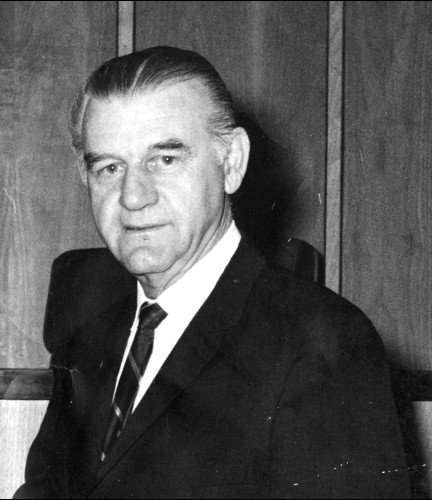
LOUIS J. ROSETTI (1915-1971) [Courtesy of Damian Rosetti-December 2011]
Louis J. Rosetti (1915-1971) was appointed Chief of Police by the Biloxi City Commissioners in mid-December 1963. He had served as acting Police Chief for about a year. F. P. Vincent was appointed to chief of detectives and Leslie Montgomery was chosen as assistant chief of Detectives. Chief Rosetti has served on the BPD for 21 years working his way through the ranks. A native of Biloxi, Louis J. Rosetti resides at 202 Rose Street.(The Daily Herald, December 19, 1963, p. 1)
Louis J. Rosetti (1915-1971) was born on August 24, 1915 at Biloxi, Mississippi to Jake Philip Rosetti (1884-1959) and Paulina Pitalo. He married Ruby Broussard (1915-1969) in Harrison County, Mississippi on June 26, 1939. They were the parents of four sons: Louis J. Rosetti Jr.; Jake P. Rosetti m. Victoria Ann Rose; Richard Reid Rosetti m. Carolyn Haven Raley and Deborah Gail Upchurch; and Frank M. Rosetti (1956-1961).
Louis J. Rosetti served the people of Biloxi, Mississippi in law enforcement with the Biloxi Police Department for almost thirty years. He began as a desk sergeant and climbed through the ranks to be appointed acting Chief of Police in October 1962 and named Police Chief in December 1963. Mr. Rosetti was a member of the Mississippi Law Enforcement Association; Tennessee-Mississippi Sheriff's and Police Officer's Association; and the Slavonian Benevolent Association. He worshiped at St. Michael's Catholic Church and worked as a trustee of the New Biloxi Hospital to handle indigent care cases.
Louis J. Rosetti died on March 24, 1971 at his home at 203 Rose Street of an apparent heart attack. Ruby Broussard, his wife, expired on March 18, 1969.
Rosetti Street
Rose Street was changed to Rosetti Street by the Biloxi City Council in May 1972 to honor Biloxi Police Chief Louis J. Rosetti. Residents of Rose Street petitoned the City for the change. Mayor Daniel Guice related that the name change was not only in recognition of the late police chief, but of the whole Rosetti family who had served Biloxi for many years. Guice stated also that "we all enjoyed a close relationship with Chief Rosetti. He was a person with a heart of gold. Not only would he enforce the law, but would give help whenever and wherever needed, especially to low-income groups. I hope this action will show younger persons that by living the good life and serving the community as Chief Rosetti did, they will not be forgotten."(The Daily Herald, May 9, 1972, p. 4)
REFERENCES:
The Daily Herald, "Rosetti named Police Chief, City of Biloxi Dies", December 19, 1963.
The Daily Herald, "Biloxi's Police Chief Dies", March 27, 1971.
The Daily Herald, "Biloxi Council changes street name to Rosetti", May 9, 1972.
__________________________________________________________________________________
1971-

Leslie F. Montgomery Sr.
Leslie Francis Montgomery Sr. [1925-2002] was born October 30, 1925 at Biloxi to Joseph H. Montgomery [1892-1972] and Catherine Fountain [1896-1992].
Leslie attended Biloxi High School where he participated in football and baseball. He was the starting center on the gridiron and caught for the diamond Indians. Les also played tennis and softball for the Biloxi Tigers. He hit 2 home runs in March 1943 against a Gulfport nine with Cecil Montgomery, his brother, also slamming a four-bagger. It is note worthy to mention that Biloxi defeated Gulfport 7-0 in Montgomery’s last high school football game. He did not graduate with the Class of 1944 as he was called into the military.[The Daily Herald, March 30, 1943, p. 5]
Pigeons
As a teen in Biloxi, Leslie began training and flying carrier pigeons. Before he joined the military in 1946, he would take some of his birds to New Orleans and release them to return to Biloxi. On one occasion, Captain F. Smith while shrimping aboard the Marion W. sent Gay Neckand Whirlaway, two of Leslie’s favorite birds, from Mitchell Key in Louisiana to fly to Biloxi. He became president of Biloxi Racing Pigeon Association.[The Daily Herald, September 6, 1941, p. 3]
Military
With World War II the salient concern of the nation, Leslie F. Montgomery enlisted in the US Navy in January 1944 and was selected to attend the Signal Corps School at San Diego, California. He was discharged May 4, 1946 with the rank of Signalman 2ndClass. He had served in the South Pacific theatre. [The Daily Herald, July 1, 1944, p. 8]
Family
Returning from WW II, Leslie F. Montgomery found employment at the Moran-Kennedy Enterprises, a boat building facility, on Back Bay at Biloxi. At St. Michael’s Catholic Church, he married Mary Sylvia Simmons[1928-1989], the daughter of Howard ‘Red’ Frank Simmons 1901-1958) and Antoinette Hebert [1910-1989], in Harrison County, Mississippi on September 15, 1946. They were the parents of five children: Leslie F. Montgomery Jr. [b. 1948]; Joseph Montgomery; Nancy Montgomery [1951]; Jeanne Marie Montgomery m. [1981] Chester Marion Brooks; and Catherine Joy Montgomery [1951-1952].[Harrison Co., Mississippi Circuit Court Bk. 72, p. 441 and September 19, 1946, p. 5]
Returning from WW II, Leslie found employment at the Moran-Kennedy Enterprises, a boat building facility on Back Bay at Biloxi.
Biloxi Police Department
With the conflict in Korea, many young Americans were called to active duty. The Biloxi Police Department lost
Obituary
Died Wednesday, January 2, 2002, in Ocean Springs.
Mr. Montgomery was a lifelong resident of Biloxi and was a member of Sacred Heart Catholic Church in D'Iberville. He was a Navy veteran of World War II, a graduate of the FBI Academy and retired in 1976 as Biloxi police chief. He was a probation and parole officer for the Southern District of Mississippi, retiring in 1992. He was president of Biloxi Racing Pigeon Association.
He was preceded in death by his wife, Sylvia Simmons Montgomery; a daughter, Cathy Joy Montgomery; his parents, Catherine and Joseph Montgomery; a brother, James Montgomery; and a sister, Marie Montgomery.
Survivors include two sons, Leslie F. Montgomery Jr. of Saucier and Joseph "Joey" Montgomery of Woolmarket; two daughters, Nancy Harrison and Jeanne Brooks, both of Biloxi; a brother, Cecil Montgomery of Biloxi; three sisters, Catherine Butterfield and Doris Stojcich, both of D'Iberville, and Ursula Sherman of Latimer; six grandchildren; and two great-grandchildren.
Visitation will be from 6 to 8 p.m. today at Riemann Memorial Funeral Home, 274 Beauvoir Road in Biloxi. Services will be at 2 p.m. Friday at Sacred Heart Catholic Church in D'Iberville where friends may call one hour before service time. Burial will be in Biloxi City Cemetery.
REFERENCES:
The Daily Herald, '',
The Daily Herald, '',
__________________________________________________________________________________
1963-1976
LESTER J. THOMPSON JR.
-image October 1975.jpg)
[from The Daily Herald, October 10, 1975, p. B4)
Lester Joseph Thompson Jr. (1941-2010) died Friday, June 4, 2010, surrounded by his family and friends after a long battle with pancreatic cancer. Born in Biloxi on June 2, 1941, he remained a lifelong resident and was preceded in death by his parents, Lester Joseph Thompson Sr. (1910-2002) and Rosalie "Georgette" Wink Thompson (1914-1978); grandparents, George B. Wink and Marguerite Stanovich Wink, Christian A. Thompson and Laure Clair Caillavet Thompson; sister Georgette (Clemmie) Thompson Gillikin; infant brother, Baby Thompson; mother-in-law, Janie Oglesby Jacquet.
He is survived by his wife of 30 years, Kathy Jacquet Thompson; sons, Lester Joseph Thompson III [1959-2017] (Christi), of Biloxi, Scott, Sr. of Brandon, MS, Dirk (Christine) of Biloxi; one sister, Joan Thompson Fink of Diamond Bar, Ca.; grandchildren, Jennifer, Charlene (Justin) Thompson Barnette, and Scott, Jr. all of Brandon, MS, Michael and Mason of Biloxi; one great grandson, Ryker, to be born in August, step-grandsons, Austin and Cody Freeman; Scott's fiance, Angie Goettel and daughter, Casey, of Brandon, MS; and his faithful Lab, Bailey; and numerous nieces and nephews. Lester cherished his family and friends and enjoyed the time he spent with the Biloxi Lunch Bunch.
Lester attended the Biloxi School System, Jeff Davis Jr. College, University of South MS, University of MS, MS State Bar Association, Zonn Institute of Polygraph, MS Judiciary College and he received a law degree from Blackstone School Of Law.
He was a member of numerous law enforcement organizations and a graduate of the F.B.I. Academy, as well as a member of The Biloxi Bay Chamber of Commerce, Biloxi Elks Lodge #606, and Slavic Benevolent Association.
He began his career walking the beat as a Biloxi Policeman in the early 60's and worked his way through the ranks serving as chief of police (1963-1976). He owned his own polygraph business, was court administrator in the Biloxi Municipal Court and retired from MDOT Law Enforcement Division.
A Mass of Christian Burial will be 12:30 p.m. Tuesday, June 8, 2010, at Our Lady of Fatima Catholic Church where friends may visit from 9:30 a.m. until service time. Interment will follow in Biloxi City Cemetery.
REFERENCES:
The Daily Herald, Police Chief Lester Thompson resigns', June 12, 1976, p. 1]
The Sun Herald, "Lester J. Thompson Sr.", March 4, 2002.
The Sun Herald, "Lester J. Thompson Jr.", June 5, 2010.
__________________________________________________________________________________
EDWARD RYAN
1976-1984
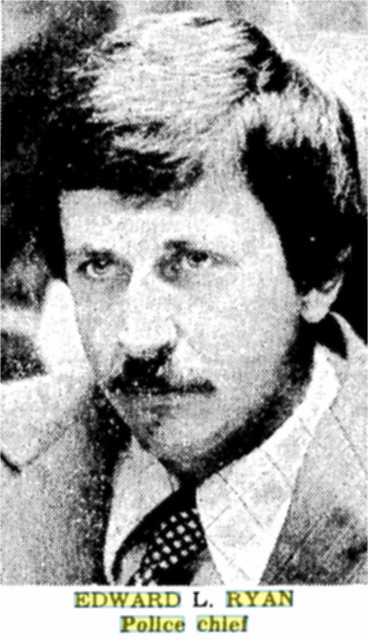
REFERENCES:
The Daily Herald, "Biloxi forms police academy", October 10, 1979, p. A8.
__________________________________________________________________________________
RICHARD G. WEST
1984-1986
Richard Garry West (1937-1996) was born in Schell City, Vernon County, Missouri. He served in the USAF from 1954 to 1958. In 1964, Richard joined the Biloxi Police Department. He retired in 1986 and had worked his way through the ranks to become Directory of Public Safety in 1984. In 1983, Garry had been appointed Chief of the Community Relations-Staff Support Unit, a newly created position. After his retirement from the Biloxi Police Department, he became Director of Security at the Mississippi Gulf Coast Coliseum.
Richard G. West married Jewel Barker and they were the parents of: Darrell W. Barker; Rhondale L. Barker; Gary Thomas West m. Cindy M. Toncrey; Lentz O. West; Beverly J. Culpepper; Lawanda N. Ramage; Melonee L. Webb; Theresa Gayle West m. Charles V. White and Lawrence Carl Olson; and Natasha Charise West m. James Hills Perkins III.
Richard's life epitomized one of service to God, family and community. One of his greatest accomplishments in law enforcement was thesis that outlined what we know today as Neighborhood Watch. The Neighborhood Watch program is used by law enforcement agencies across the United States as an effective tool in crime prevention. Because of Richards's role in creating this program, in 1985, he was inducted into the American Institute's Directory of Distinguished Americans Hall of Fame for Outstanding Achievements. Richard was also interviewed by the Smithsonian Institute for his law enforcement accomplishes. He was also presented with Presidential cuff links from President Ronald Reagan.
Richard's love of family and for God brought him great joy. He was a member of First Pentecostal Church where he served on the Board of Trustees as Senior member. He was an accomplished Minister of the Gospel of Jesus Christ, traveling as a national evangelist and in later years served as assistant pastor for the First Pentecostal Church.
Mr. West was survived by his spouse; children; nineteen grandchildren; and four great-grandchildren; three siblings: Eugene West of Colorado and Dean West and Evelyn West Hackleman (1929-2000) of El Dorado Springs, Missouri.
Richard Garry West expired at Biloxi, Mississippi on December 6, 1996. Bradford-O'Keefe Funeral Home directed his funeral services at the First Pentecostal Church on Popp's Ferry Road with internment in the Southern Memorial Park cemetery.
REFERENCES:
The Sun Herald, "Richard Garry West", December 8, 1996. p. B2.
___________________________________________________________________
FRANK DUGGAN
REFERENCES:
_____________________________________________________________________________________________
GEORGE
REFERENCES:
The Sun Herald, 'Biloxi blacks, police look for better relations', August 13, 1986, p. A-1.
________________________________________________________________________
TOMMY L. MOFFETT
REFERENCES:
__________________________________________________________________________________

DARRELL D. CVITANOVICH
Darrell David 'D.D.' Cvitanovich (1933-2019) was born at Biloxi, Mississippi on January 15, 1933 to Dominick Cvitanovich and Philomena Sercovich (1900-1985). He married Mary Hampton Teel, a native of Etowah County, Alabama and the daughter of Clyde L. Hampton and Mary Elizabeth Foster, on December 15, 1963.(Jackson Co., Mississippi Circuit Court MRB 104, p. 49)
Obituary
Darrell David “D.D.” Cvitanovich, Sr., Colonel – Mississippi Highway Patrol (Retired), born January 15, 1933 in Biloxi, Mississippi, passed away Saturday, March 9, 2019 in D’Iberville.
DD attended Dukate School, St. Stanislaus, Notre Dame Jr. High and graduated from Notre Dame High School in 1951 and immediately joined the United States Marine Corps. He spent one year in 1952 with the First Marine Division in Korea during the Korean War where he earned the Korean Service Medal with three battle stars. He was discharged from the Marine Corps as a sergeant in 1954 at the age of Twenty-one and then attended Perkinston Jr. College for two years where he played on the 1955 and 1956 Bulldog Football Teams.
He joined the Biloxi Police Department in January of 1958 and served for three years. He then attended the Mississippi Highway Patrol Training School in the fall of 1960 and was appointed as a Mississippi State Trooper on February 1, 1961.
After serving in Jones, Hancock, Harrison and Jackson counties and other statewide assignments in the 1960’s, he was promoted to a Master Sergeant in 1972. He attended the 99th Session of the FBI National Academy at Quantico Virginia in the fall of 1974. After a large retirement in the agency, DD was appointed Chief of the Mississippi Highway Patrol and held two patrol schools to fill the ranks of those who retired.
In 1986 he initiated the Travel Criminal Apprehension Program (aka The Wolf Pack) within the Mississippi Highway Patrol which has resulted in thousands of drug courier and criminal fugitive apprehensions over the years.
After his tenure as Chief there were 600 troopers in 600 cars assigned to patrol the highways in Mississippi. After serving as Chief, in 1988 he returned to enforcement duty until his retirement in 1989 when he was appointed Chief of Police in Biloxi by Mayor Pete Halat where he served until 1993.
In January 1994 he began a career in the casino industry as a charter member of Grand Casino Biloxi and Harrah’s Gulf Coast Casino until retiring a few months ago.
He was a life-long member of St. Michaels Catholic Church. He was a member of the Veterans of Foreign Wars, the Mississippi State Troopers Association and the Mississippi Retired Troopers Association.
He was preceded in death by his parents, Dominick and Philomena Sercovich Cvitanovich; three brothers, Andrew, Anthony and Earl; one granddaughter, Angel; and his beloved pet, Bugle who will be laid to rest with him.
Survivors include his loving wife of 55 years, Mary Hampton Cvitanovich; two sons, Dominick “Nicky” (Jennifer) and Darrell Jr. (Jennifer); four daughters, Deidra Cvitanovich (Fiancé Troy), Tina Cvitanovich (Gina), Lena Lee (Daniel) and Dorothy Payne (Wayne Jr.); sixteen grandchildren, Dominick “Nick”, Nathan, Cole, Chelsey, Daralyn, Danielle, Daisha, Brandon, Darrell III, Delaney, Kayla, Cassie, Amber, Christopher, Kaitlyn and Haily; seven great-grandchildren, Kenzlee, Wyatt, Maisie, Cameron, Bryceson, Ella and Kash; one sister, Barbara Lyons (Stephen); and several nieces and nephews.
Funeral Services will be held at the Howard Avenue Chapel of Bradford O’Keefe Funeral Home Wednesday, March 13, 2019 at 2:00 pm.
Friends may visit from 12:00 pm until service time. Interment will follow at Biloxi City Cemetery with full Military and Police Honors.
REFERENCES:
__________________________________________________________________________________
GEORGE WALDRON SAXON
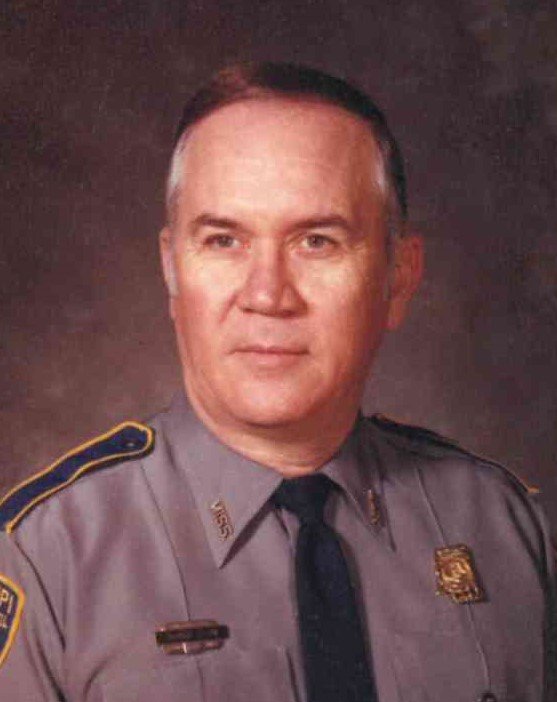
George W. Saxon
George Waldron Saxon (1927-2018), age 91 years, of Gulfport passed away on December 26, 2018, surrounded by his family. Mr. Saxon was born March 30, 1927 in Waynesboro, MS to John B. and Nora Saxon. He was the youngest of six children. He graduated from Waynesboro High School and was promptly drafted into the United States Army. Later, he transferred to the US Army Air Corps, where he served honorably during World War II. After returning home to Waynesboro, he attended Jones County Junior College. In 1947, he married Elizabeth Ann McRae, his next-door neighbor.
In 1955, he graduated from the Mississippi Highway Patrol Academy. His first assignment with the MHP was as a dispatcher in Hattiesburg. Shortly afterwards, he was transferred to the Mississippi Gulf Coast as a patrolman. For eight years, he patrolled Highway 90 between the Bay St. Louis and Ocean Springs bridges or, as he called it, the most beautiful beat in the world. In 1964, he was invited to attend the FBI National Academy in Washington, D.C. Upon his graduation from the Academy, he was reassigned as a Criminal Investigator with the MHP. After four years as an Investigator, he was promoted to District Inspector/Captain of Troop K, responsible for command of the six southern counties of the state. He served as Inspector for 12 years, until being promoted to Chief Inspector/Major where his command included the entire Southern Region of MS. His last position with the MHP was Assistant Commissioner of Public Safety / Chief of the MHP. As the Chief of the Patrol, he oversaw the day-to-day operation of the largest statewide law enforcement agency in Mississippi until his retirement in 1986. Following his retirement from the MHP, he was appointed as Director of Public Safety for the City of Biloxi, where he oversaw the city’s fire, police, and civil defense departments until 1989. George said he never worked a day in his life because he truly loved what he did and looked forward to it every day.
An avid pilot, flying was the joy of his life. His love for flying was developed early in life, where he paid for rides in crop-dusting airplanes as a young man. He became a licensed pilot in the early 1960’s and later was certified to fly helicopters, as well. During his tenure with the MHP, he was the pilot for the southern region, flying search and rescue, as well as routine patrol missions. In 1976, he began construction of an experimental, home-built aircraft called a Vari-Eze, which he completed in 1979 and first flew in 1980. He flew the plane regularly until he was 81, even making cross-country trips to major air shows in Oshkosh, WI and Lakeland, FL. He was never happier than when he was in the air, most often with a grinning grandchild in tow.
He was preceded in death by his wife of 56 years, Elizabeth Ann, infant daughter George-Ann, parents, one brother, and four sisters. He is survived by his daughter Jo Ellen Mechatto (Phil) of Gulfport; grandchildren Sam Maxie (Julie) of Vancleave, Katherine Shows of Waynesboro, Phillip Charles Mechatto (April) of Gulfport, and Todd Mechatto of Gulfport; great-grandchildren Mary Fullilove, Jacob Bachtel, Emma Maxie, Matthew Maxie, Alison Allen (Gavin), Victoria Raborn (Allan), Abigail Mechatto, and Wesley Mechatto; one great-great granddaughter Brynnleigh Raborn.
A visitation for family and friends will be held on Saturday December 29, 2018, from 1:00 PM until 3:00 PM, at Riemann Family Funeral Home, 11280 Three Rivers Road, Gulfport. The funeral service will be held at Trinity United Methodist Church, 5007 Lawson Avenue, Gulfport on Sunday, December 30, 2018, at 3:00 PM, with honors to be rendered by the Mississippi Highway Patrol Honor Guard. A visitation for family and friends will be held from 2:00 PM until the service.
Burial will follow at Floral Hills Memorial Gardens, Gulfport.
REFERENCES:
The Sun Herald, 'George Waldron Saxon', December 28, 2018.
__________________________________________________________________________________
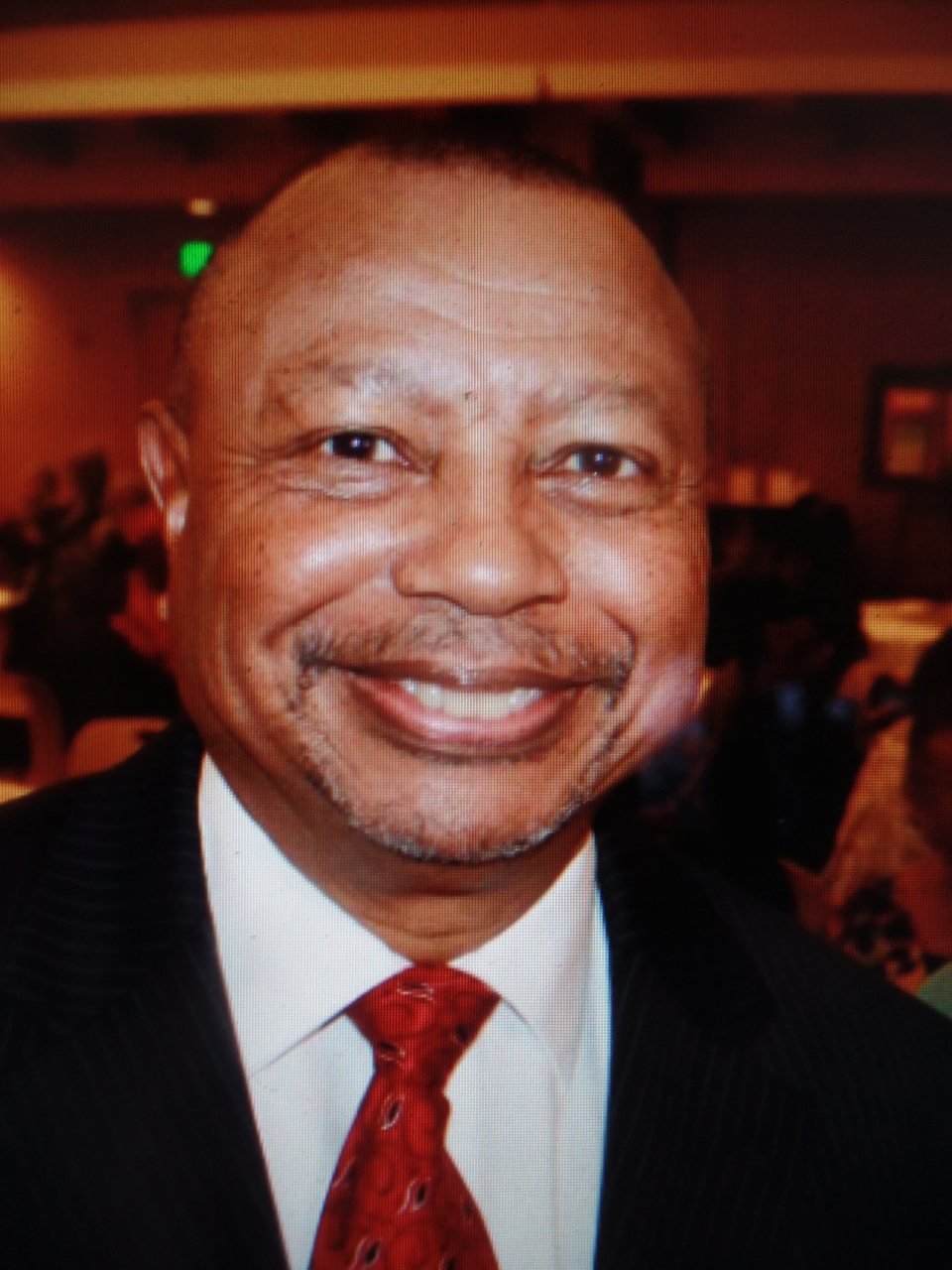
TOMMY L. MOFFETT
Tommy Lee Moffett (b. 1950) was born at Taylorsville, Smith County, Mississppi on March 2, 1950. He arrived at Biloxi, Mississippi in 1968 and found work as a building custodian at KAFB. Joined Biloxi Police Department in October 1973 and became Police Chief on 1 September 1986 and again in October 1993. Resigned 2002 and relocated to Vicksburg, Warren County, Mississippi and became Chief of Police there. Chief Moffett resigned his Police Chief's post in July 2009 and was employed in April 2010 as interim Police Chief of Indianola, Sunflower County, Mississippi.
Moffett ran the Vicksburg Police Department for eight years until July 2009, when he was ousted on a split vote of the city board following Mayor Paul Winfield’s election.
Previously, he had led the Biloxi Police Department for 16 years. In April 2010, Moffett was hired to lead and help reshape Indianola PD. “Law enforcement is my passion. It’s what I love to do,” Moffett said. “I felt like when I left the department here it was a top-notch department. When I left Indianola it wasn’t a top-notch department but it was a lot better than where it was.”
While working in Indianola, Moffett kept his home in Vicksburg and traveled the nearly 100 miles each day to the Delta city. All the travel began to take a toll and he wasn’t able to spend as much time with his grandchildren, he said.
Moffett and his wife moved to Vicksburg in 2001 and bought a home. They decided not to return to the Gulf Coast after Hurricane Katrina, he said. “We like it here and made a lot of plans here,” he said. For now, Moffett said he just plans to take it easy and wait for deer season, but he hasn’t ruled out returning to work. “I don’t know what the future holds,” Moffett said. “This is my home. I care about this city, and I care about the police department that I helped shape.”[https://www.vicksburgpost.com/2012/07/20/former-chiefmoffett-retires-from-indianola-spot-keeps-home-in-city-i-care-about/]
REFERENCES:
The Sun Herald, 'Biloxi blacks, police look for better relations', August 13, 1986, p. A-1.
The Sun Herald, 'New Chief undestands problems in Ward 2', August 14, 1986, p. A-1.
The Vicksburg Press, “Former Chief Moffett retires from Indiana spot, keeps home in city 'I care about'", July 2o, 2012.
__________________________________________________________________________________
BRUCE C. DUNAGAN
Bruce C. Dunagan (b. 1945) retired from the Biloxi Police Department in May 2009. He joined the force in 1972. Mayor Holloway appointed Linda Atterberry (b. 1950) as acting Police Chief.
REFERENCES:
__________________________________________________________________________________
JOHN MILLER
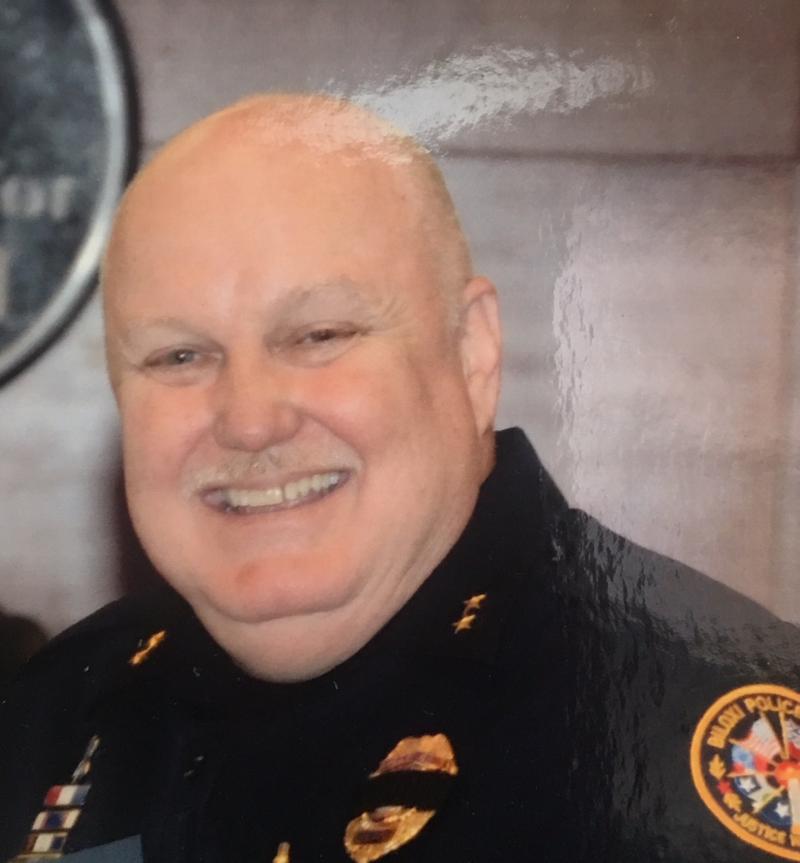
John Miller was nominated for Biloxi Police Chief by Mayor A.J. Holloway and accepted by the City Council in late November 2009. Chief Miller began his career with the BPD in 1990 as a patrolman. His astute intelligence and ability to investigate narcotic cases led to an assignment with the Special Crimes Unit in 1995. Here Miller dealt with vice and drug related issues.
Chief Miller worked his way up the ranks making Sergeant and Lieutenant and later became the leader of the Special Crimes Unit and its personnel. In 2007, John Miller was again promoted attaining the rank of Captain and continued with his investigative leadership of the Special Crimes Unit. Soon thereafter, Miller was given command of the recently expanded Special Crimes Division and also the responsibilty for directing the the Cold Case Homicide Squad.(The Sun Herald, November 21, 2009, p. A1, December 2 , 2009, p. A2 and The Biloxi-D'Iberville Press, June 27, 2013, p. 1)
REFERENCES:
The Biloxi-D'Iberville Press, "Biloxi Police Chief John Miller presented Heart of a Lion", June 27, 2013.
from Ed Ryan
- 7512 views
Research and Historical Resources
Research and Historical Resources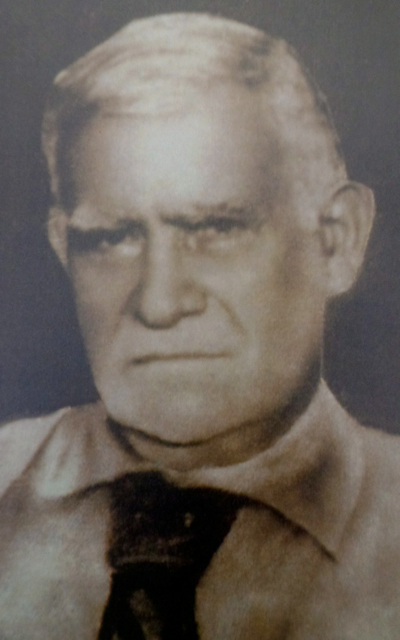
BILOXI RESEARCH
SOURCE MATERIAL FOR BILOXI RESEARCH
“Discovering the "Queen City"
There are many things germane to the culture and history of a place. Some might be considered fact and others trivia. Hopefully all are interesting and entertaining to the reader. Presented are some sources, which should provide some of the above criteria:
LITERATURE
From the literature we gain knowledge of the past. The author highly recommends the following list of books, pamphlets, and newspaper columns to anyone interested in various aspects of the history, genealogy, and culture of Biloxi, Mississippi:
Mary Louise Adkinson, Bousage-Bosarge Family, Mississippi Coast Historical and Genealogical Society-Special Issue 4 (June 1986), and 2nd Edition (January 1991), 321 pages.
Anderson, Ellis, Under Surge-Under Seige: The Odyssey of Bay St. Louis and Katrina, (University Press of Mississippi: Jackson, Mississippi-2010), 271 pages.
Klaus J. Meyer-Arndt and Rudi Hartman, editors, Casino Gambling in America: Origins, Trends, and Impacts, (Cognizant Communication Corporation: New York-1998).
William Bartram, Travels of William Bartram, (Dover Publications: New York-1955), 414 pages.
Edwin C. Bearss, Historic Resources Study-Ship Island, Harrison County, Mississippi Gulf Islands Natioal Seashore-Florida/Mississippi, (US Department of the Interior-National Park Service: Denver Service Center-1984).
Ray L. Bellande and Heidi Balje Good, From Marseille to Mississippi (1813-1990), (Bellande: Ocean Springs, Mississippi-1991), 69 pages.
Anna-Lena Berg, Blood on the Ocean-The Forgotten True Story of the Veronica Mutiny [Ship Island-October 1902], Countyvise Ltd.,United Kngdom-2012, 287 pages.
Biloxi Houses: As time keeps turning, (Biloxi Jr. High School and USM-Katrina Research Center: Long Beach, Mississippi-2008), 98 pages.
John H. Blitz, C. Baxter Mann, and Ray L. Bellande, Mississippi Archaeology, Vol. 30, No. 1, June 1995, “Fort Maurepas and Vieux Biloxi: Search and Research”, 36 pages.
John H. Blitz and C. Baxter Mann, Fisherfolk, Farmers, and Frenchmen, (Mississippi Department of Archives and History: Jackson, Mississippi-2000).
Edmond Boudreaux, The Seafood Capital of the World-Biloxi's Maritime History, (The History Press: Charleston, South Carolina-2011, 126 pages.
Jamie Bounds Ellis and Jane B. Shambra, Images of America-Biloxi, (Arcadia Publishing: Charleston, S.C.-2009, 128 pages.
Carl A. Brasseaux, A Comparative View of French Louisiana, 1699 and 1762: The Journals of Pierre LeMoyne d'Iberville and Jean-Jacques-Blaise d'Abbadie, (The Center For Louisiana Studies, USL: Lafayette, Louisiana-1979), 159 pages.
Laville Bremer, Biloxi Historical Sketch, (General Printing Company: New Orleans-1931), 42 pages.
Laville Bremer, Amichel, Gulf Coast History and Guide-Book One-To the closing of the French Period.
Martin D. Britt, Spain and the Mississippi Sound-Exploration to the Louisiana Purchase (1519-1804), Volume I, (Next Step Publishing: Ocean Springs, Mississippi-2011).
Martin D. Britt, Spain and the Mississippi Sound-The Final Years (1805-1813), Volume II, (Next Step Publishing: Ocean Springs, Mississippi-2011).
The Buildings of Biloxi an Architectural Survey, (City of Biloxi, Mississippi-1976), 172 pages.
The Buildings of Biloxi an Architectural Survey, (City of Biloxi, Mississippi-2000), 182 pages.
Cyril E. Cain, Four Centuries on the Pascagoula: History, Story, and Legend of the Pascagoula River Country,(The Reprint Company: Spartanburg, South Carolina-1983), Two volumes.
Margaret Rose Carraway, "The Cornerstone of Old Fort Maurepas", Journal of Mississippi History, April, 1951. pp. 101-104.
Earnest A. Carvin, The Harrison County, Mississippi 1880 Census, (Mississippi Coast History & Genealogical Society: Biloxi, Mississippi-1981)
Joe Casey, The Magnola Route: 1923-1927, (Southeastern Press: Mobile, Alabama-2005), 76 pages.
Nap L. Cassibry, II, Early Settlers and Land Grants at Biloxi, Volume I (Mississippi Coast Historical and Genealogical Society-Special Issue 5 (November 1986), 180 pages.
Nap L. Cassibry, II, Early Settlers and Land Grants at Biloxi, Volume II (Mississippi Coast Historical and Genealogical Society-Special Issue 5 (November 1986), 159 pages.
Nap L. Cassibry, II, The Ladner Odyssey, Mississippi Coast Historical and Genealogical Society-Special Issue 6 (January 1988), 931 pages.
Jean Andrews Cecil, That Fifty-Foot Lot, (Cecil: Rosholt, Wisconsin-2010), 43 pages.
Charting Louisiana: Five Hundred Years of Maps, (The Historic NOLA Collection-New Orleans, Louisiana-2003), 383 pages.
Oliver J. Counce, The Sesquicentennial of the Southern Yacht Club, (Franklin Southland Printing-Metairie, Louisiana-2000).
John Cuevas, Cat Island: The History of a Mississippi Gulf Coast Barrier Island, (McFarland-2011).
The Daily Herald, 50th Anniversary Souvenir, Golden Jubilee Number, Biographical and Historical 1884-1934, (The Daily Herald: Gulfport-Biloxi, Mississippi-1934). 104 pages.
The Daily Herald, "100 Years -1884-1984", (The Gulf Publishing: Gulfport-Biloxi, Mississippi-1984).
Bennett Doty, Legion of the Damned, (Garden City Publishing Company: Garden City-1928)
Charles L. Dufour, Ten Flags in the Wind-The story of Louisiana, (Harper & Row, Publishers-New Yorj-1967), 307 pages.
M. Le page Du Pratz, History of Louisiana, (Claitor’s Publishing Division: Baton Rouge, Louisiana-1972), 366 pages.
Charles L. Dyer, Along The Gulf, (Women of the Trinity Episcopal Church: Pass Christian-1971. Originally published 1895, 60 pages.
Jamie B. Ellis and Jane B. Shambra, ‘Biloxi’, (Arcadia Publishing: Charleston, South Carolina-2009), 127 pages.
Robert B. Fisher, The French Invade the South and Lose, (Shaugnessy & Co.: Biloxi-1984), 50 pages.
Alcee Fortier, A History of Louisiana (4 Volumes), (Manzi, Joyant, & Co.: New York-1904).
Henri A. Gandolfo, Metairie Cemetery, An Historical Memoir, (Stewart Enterprises: New Orleans, Louisiana-1981)
T.H. Glenn, The Mexican Gulf Coast on Mobile Bay & Mississippi Sound Illustrated, (Delchamps: Mobile, Alabama-1893), 100 pages.
Dale Greenwell, Views of D'Iberville and St. Martin, (Arcadia Publishing Company: Charleston, South Carolina-2014).
Dale Greenwell, Twelve Flags Triumphs and Tragedies: A Complete documented, detailed history of the Mississippi Coast and its people, (Published by Greenwell-1968), 175 pages.
Bonnie L. Grimstead, Cemeteries of Harrison Co., Mississippi, (Southern Heritage Press: St. Petersburg, Florida).
Julia C. Guice, Lagniappe-City of Biloxi [notes on public officials, voter registration and tax rolls], (City of Biloxi, Mississippi-circa 1966)
Julia C. Guice, 1850 Census of Harrison County, Mississippi, (City of Biloxi, Mississippi:)
Julia C. Guice, 1860 Census of Harrison County, Mississippi, (City of Biloxi, Mississippi:-1982), 109 pages.
Julia C. Guice, 1870 Census of Harrison County, Mississippi, (City of Biloxi, Mississippi:-1981), 166 pages.
Julia C. Guice, Marriages-Harrison County, Mississippi, [1841-1899], (City of Biloxi, Mississippi:), 103 pages.
Jean-Baptise de la Harpe, The Journal of the Establishment of the French in Louisiana, (University of Southwestern Louisiana: Lafayette, Louisiana-1971), 272 pages.
Robert W. Heck, Biloxi Central Business District- Historic District Study, (Eskew, Vogt, Salvato and Filson Architects: New Orleans, Louisiana-July 1986)
Nollie Hickman, Mississippi Harvest: Lumbering in the Longleaf Pine Belt (1840-1915), (The Paragon Press: Montgomery, Alabama - 1962), 306 pages.
Jay Higginbotham, Fort Maurepas: The Birth of Louisiana, (Colonial Books: Mobile-1968), 93 pages.
Jay Higginbotham, The Journal of Sauvole, (Colonial Books: Mobile-1969), 70 pages.
Jay Higginbotham, Old Mobile: Fort Louis de la Louisiane (1702- 1711), (Museum of the City of Mobile, Publication No. 4: Mobile-1977), 585 pages.
Louise C. Hoffman, An Artist Vision-Josephine Crawford, (The Historic New Orleans Collection: NOLA-2009), 159 pages.
H. Grady Howell, Jr., To Live and Die in Dixie, A History of the Third Mississippi Infantry, CSA, (Chickasaw Bayou Press: Jackson, Mississippi-1991), 644 pages.
H. Grady Howell, Jr., The Button Jar-Memories of My Childhood on Back Bay Biloxi, (Howell: Madison, Mississippi-2010), 112 pages.
Edward Humes, Mississippi Mud, (Gallery Books: New York-1994), 434 pages.
Val F. Husley, Keesler Air Force Base: A History of the Site and Its Environs”, (USAF, Office of History, 81st Training Wing, Keesler AFB Technical Training Center: Biloxi, Mississippi-1996).
Val F. Husley, Maritime Biloxi, (Arcadia Publishing: Charleston, South Carolina-2000).
Val F. Husley, Biloxi: Three Hundred Years, (The Donning Company: Virginia Beach, Virginia-1998).
Journal of the Frigate "Le Marin"(September 5, 1698-July 2, 1699), (Blossman Printing Company: Ocean Springs-1974), 70 pages.
Journal of the Jackson County Genealogical Society, Pascagoula (published quarterly since 1984).
Helen Kerr Kempe, The Pelican Guide To Old Homes of Mississippi, Volume 1: Natchez and the South, (Pelican Publishing Company: Gretna, Louisiana-1977).
Fred J. Klein III, Remembering the Biloxi Bakery-sixty delicious years 1913-1973, (Klein: Biloxi, Mississippi-2008 and 2nd addition-2009).
Fred J. Klein III, Biloxi is beautiful-wish you were here! Postcards of days gone by, (Klein: Biloxi, Mississippi-2010).
Darlene Krohn, The Descendants of Jerome Ryan, (Krohn: Latimer, Mississippi-1995).
John H. Lang, History of Harrison County, Mississippi, (The Dixie Press: Gulfport, Mississippi-1936)
Edward J. Lepoma, A Passion for People: The Story of Mary Mahoney and her Old French House Restaurant, (Quail Ridge Press: Brandon, Mississippi-1998).
Jerome Lepre, The Caillavet Family, Volume I, (Lepre, NOLA: March 1984), 105 pages.
Jerome Lepre, The Heritage of Francois Fontaine, (Lepre-NOLA-1987), 92 pages.
Jerome Lepre, The Krohn Family, (Lepre: New Orleans-1989).
Jerome Lepre, Santa Cruz Family, (Lepre, NOLA: July 1990), 160 pages.
Jerome Lepre, Catholic Church Records Diocese of Biloxi, Mississippi, Volume I, (Catholic Dioceses of Biloxi: Biloxi, Mississippi-1991).
Jerome Lepre, Index to the Records of Old Mobile-Cathedral of the Immaculate Conception-Mobile, Alabama [1704-1891], (Jackson County Genealogical Society: Pascagoula, Mississippi-1992), 495 pages..
Jerome Lepre, The Fountain Family, (Lepre, NOLA: 1992), 279 pages.
Jerome Lepre, Catholic Church Records Diocese of Biloxi, Mississippi, Volume II, (Catholic Dioceses of Biloxi: Biloxi, Mississippi-1995).
Jerome Lepre, Catholic Church Records Diocese of Biloxi, Mississippi, Volume III, (Catholic Dioceses of Biloxi: Biloxi, Mississippi-1995).
Jerome Lepre, Seymour Family, (Lepre, Biloxi, Mississippi: 2001), 457 pages.
Main Street Through Mississippi on the Old Spanish Trail, J.H. Jacque, compiler, and A.A. Heldt, photographer, (Gulfport Printing Company: Gulfport-circa 1925). Larry Cosper at Local Color Gallery has the only copy in Ocean Springs.
Earl Chapin May, The Canning Clan, (The MacMillan Company-New York-1937).
Mexican Gulf Coast Winter Resorts(Illinois Central Railroad Promotional Pamphlet circa 1890), Biloxi Public Library Archives.
Richebourg Gaillard McWilliams, Fleur de lys and Calumet, The Penicaut Narrative, (LSU Press: Baton Rouge-1953), 281 pages.
Richebourg Gaillard McWilliams, Iberville's Gulf Journals, (University of Alabama Press: University, Alabama-1981), 195 pages.
Elaine Ryan Miller and Virgil D. Miller, The Ladner Odyssey Index, (Miller-Ocean Springs, Mississippi-1996), 23 pages.
Mississippi Coast History and Genealogical Society, Biloxi (published three times a year since 1968).
Mississippi Gulf Coast Yesterday & Today (1699-1939), Federal Writers Project in Mississippi Works Progress Administration, (Gulfport Printing Company: Gulfport-1939), 162 pages.
Lu Hartley Morehead, Old Spanish Trail Along the Mississippi Gulf Coast, (Dixie Press: Gulfport, Mississippi-1955 and 1958).
Deanne Stephens Nuwer, Plague Among the Magnolias, (University of Alabama Press: Tuscaloosa, Alabama-2009).
Nola Nance Oliver, The Gulf Coast of Mississippi, (Hastings House: New York-1941). Approximately 100 pages.
Patricia E. Parrish and MSgt. Linda C. McFarland, Keesler Air Force Base The and Now: For Half Century, a Leader in Technical Training, 1941-1945, (USAF, Office of History, 81st Training Wing, Keesler AFB Technical Training Center: Biloxi, Mississippi-October 1991).
Dawson A. Phelps, Research Report on Fort de Maurepas, Mississippi, (US Department of The Interior-National Park Service, 1939)
James J. Pillar, O.M.I., The Catholic Church in Mississippi, 1837-1865, (The Hauser Press: New Orleans, Louisiana-19?).
J.B. Richmond, World War II: Combat Wooden Boats Built at Westergard Boat Works of Biloxi, Inc.-A Historical Pictorial Narrative, (J.B. Richmond: Biloxi, Mississippi-2009), 70 pages.
Stephanie C. Richmond and David A. Wheeler, The Growth of the Biloxi Public School System, Volume I, (City of Biloxi, Mississippi-1979), 103 pages.
Bernard Romans, A Concise Natural History of East and West Florida, (reprinted Pelican Publishing Company: New Orleans, Louisiana-1961), 291 pages.
SSgt. Gail R. Russell, Keesler Field: The War Years 1941-1945,(USAF, Office of History, 81st Training Wing, Keesler AFB Technical Training Center: Biloxi, Mississippi-October 1986).
75th Anniversary of the 1st National Bank of Biloxi: 1893-1968, (FNB of Biloxi: Biloxi, Mississippi-1968), 56 pages.
Flora K. Schieb, History of the Southern Yacht Club, Pelican Publishing Co., Gretna, Louisiana-1986).
Theresa Arnold-Scriber and Terry G. Scriber, Ship Island, Mississippi-Rosters and History of the Civil War Prison, (McFarland & Company, Inc.-Jefferson, North Carolina-2008).
Michael D. Seymour, Seymour Family Genealogy, (Seymour: Porterville, Kemper County, Mississippi-2002, 395 page.
David A. Sheffield and Darnell L. Nicovich, When Biloxi was Seafood Capital of the World, (City of Biloxi, Mississippi-1979).
Collen C. Sholtes and L.J. Scholtes, Biloxi and the Mississippi Gulf Coast: A Pictorial History, (The Donning Company: Norfolk, Virginia-1985), 219 pages.
Zan Skelton, "Mississippi Teacher: A Biloxi teacher's account of four decades of teaching in Mississippi", (Skelton: Biloxi, Mississippi-1991). 147 pages.
Zan Skelton, "The Biloxi Public Schools 1924-2001: The Growth of the Biloxi Public School System", Volume II, (City of Biloxi, Mississippi-2002). 282 pages.
Jean Strickland and Patricia N. Edwards, Residents of the Southeastern Mississippi Territory: Census, Tax Rolls, and Petitions, Book 1, (Strickland: Moss Point, Mississippi-1995)
Jean Strickland and Patricia N. Edwards, Residents of the Southeastern Mississippi Territory: Book 2, (Strickland: Moss Point, Mississippi-199 )
Jean Strickland and Patricia N. Edwards, Residents of the Southeastern Mississippi Territory: Book 3, (Strickland: Moss Point, Mississippi-199 )
Jean Strickland and Patricia N. Edwards, Residents of the Southeastern Mississippi Territory: Book 4, (Strickland: Moss Point, Mississippi-19 )
Jean Strickland and Patricia N. Edwards, Residents of the Southeastern Mississippi Territory: Book 5, (Strickland: Moss Point, Mississippi-199 )
Jean Strickland and Patricia N. Edwards, Residents of the Southeastern Mississippi Territory: Book 6, (Strickland: Moss Point, Mississippi-199 )
Jean Strickland and Patricia N. Edwards, Residents of the Southeastern Mississippi Territory: Records of Spanish West Florida (1806+), Book 7, (Strickland: Moss Point, Mississippi-1999)
Julie Suarez [compiler], The Biloxi Cemetery,Special Issue 7, (Mississippi Coast Historical & Genealogical Society: Biloxi, Mississippi-August 2002), pages 286.
Charles L. Sullivan, The Mississippi Gulf Coast: Portrait of a People, (Windsor Publications: Northridge, California-1985).
Charles L. Sullivan, Hurricanes of the Mississippi Gulf Coast-1717 to Present, (Gulf Publishing Company: Biloxi-1986), 139 pages.
Charles L. Sullivan, Mississippi Gulf Coast Community College: A History 1911-2000, (Mississippi Gulf Coast Community College Press: Perkinston, Mississippi-2002), 606 pages.
Charles L. Sullivan, "Building The 'Old Spanish Trail': The Story of a Modern American Highway", (Mississippi Department of Transportation-Jackson, Mississippi-2003), 38 pages.
Charles L. Sullivan, "Down South with the Dixie Press", (Mississippi Gulf Coast Community College Press; Perkinston, Mississippi-2006), 81 pages.
Charles L. Sullivan, "Down South with the Dixie Press [2007 Revised Edition]", (Mississippi Gulf Coast Community College Press; Perkinston, Mississippi-2007), 81 pages.
Charles L. Sullivan, "Down South with the Dixie Press [April 2008 Revised & Expanded Edition]", (Mississippi Gulf Coast Community College Press; Perkinston, Mississippi-2008), 111 pages.
Charles L. Sullivan, Hurricanes of the Mississippi Gulf Coast-Three Centuries of Destruction, (Mississippi Gulf Coast Community College Press: Perkinston, Mississippi-2009), 174 pages.
Charles L. Sullivan, Gulf Coast Album: A Journey in Historic Photographs 1899-2011 From NOLA across the Mississippi Gulf Coast to Mobile, (Mississippi Gulf Coast Community College Press: Perkinston, Mississippi-2011), 240 pages.
Gerald W. Sweitzer and Kathy M. Fields, The 50 Best Small Southern Towns, (Peachtree Publishers: Atlanta, Georgia-2001)
Ray M. Thompson, "Know Your Coast", (Biloxi Daily Herald-1955-1956), Biloxi Public Library Historical and Genealogical Section.
Dale M. Titler and SSgt. Gary M. Murphy, Keesler Field: Inception to Pearl Harbor 1939-1941, (USAF, Office of History, 81st Training Wing, Keesler AFB Technical Training Center: Biloxi, Mississippi-April 1981).
Dale M. Titler, Gulf Tempest: Major Hurricanes and Their Effects on Keesler Technical Center, (USAF, Office of History, 81st Training Wing, Keesler AFB Technical Training Center: Biloxi, Mississippi-1986).
Twentieth Century Coast Edition of the Biloxi Daily Herald: Historical and Biographical,(George W. Wilkes & Sons: Biloxi-August 1902), 100 pages.
R.A. Wilkinson, "The Gulf Coast", letters written for The New Orleans Times Democrat, (Passenger Department L&N Railroad: Louisville, Kentucky-1886), 63 pages.
COLONIAL HISTORY
John H. Blitz, C. Baxter Mann, and Ray L. Bellande, Mississippi Archaeology, Vol. 30, No. 1, June 1995, “Fort Maurepas and Vieux Biloxi: Search and Research”, 36 pages.
Martin D. Britt, Spain and the Mississippi Sound-Exploration to the Louisiana Purchase (1519-1804), Volume I, (Next Step Publishing: Ocean Springs, Mississippi-2011).
Martin D. Britt, Spain and the Mississippi Sound-The Final Years (1805-1813), Volume II, (Next Step Publishing: Ocean Springs, Mississippi-2011).
Jeffery P. Brain, Indians of North America, The Tunica-Biloxi, (Chelsea House Publishers: New York-Philadelphia-1990), 103 pages.
Jeffrey P. Brain, Tunica Treasure, (Peabody Museum of Archaeology and Ethnology, Harvard University: Cambridge, Massachusetts-1979), 329 pages.
Carl A. Brasseaux, A Comparative View of French Louisiana, 1699 and 1762: The Journals of Pierre Le Moyne d'Iberville and Jean-Jacques-Blaise d'Abbadie, (The Center For Louisiana Studies, University of Southwestern Louisiana-1979), 159 pages.
Gail Alexander Buzhardt and Margaret Hawthorne, Rencontres sur le Mississippi, 1682-1763, (University Press of Mississippi-Jackson, Mississippi-1993), 250 pages.
Margaret Rose Carraway, "The Cornerstone of Old Fort Maurepas", Journal of Mississippi History", April 1951, pp. 101-104.
Volney J. Cissna, Jr., "Reconstruction of Fort Maurepas", (The Gulf Regional Planning Commission Report: Gulfport, Mississippi-1973).
J.F.H. Claiborne, Mississippi as a Province, Territory, and State, (The Reprint Company: Spartanburg, South Carolina-1978), 591 pages. Reprinted from an 1880 edition.
Charles L. Dufour, Ten Flags in the Wind: The Story of Louisiana, (Harper & Row: New York-1967).
Antoine Simon Le Page Du Pratz, The History of Louisiana, (Claitor's Publishing Division: Baton Rouge, Louisiana-1972), 366 pages. Reprinted from a 1774 edition.
Robert B. Fisher, The French Invade the South and Lose, (Shaugnessy & Company: Biloxi, Mississippi-1984), 50 pages.
Dale Greenwell, Twelve Flags Triumphs and Tragedies, (Dale Greenwell: Biloxi, Mississippi-1968), 175 pages.
Peter J. Hamilton, Colonial Mobile, (Reprint by Heritage Books: Bowie, Maryland-1991). Two volumes. Originally published in 1910.
David Hardcastle, "The Military Organization of French Colonial Louisiana", from The Military Presence on the Gulf Coast, (Gulf Coast History & Humanities Conference: Pensacola, Florida-1978).
Virginia C. Harrell, Vicksburg and the River, (University of Mississippi Press: Jackson, Mississippi-1982), 112 pages.
Jay Higginbotham, "The Chaumont Concession: A French Plantation on the Pascagoula (River)", Journal of Mississippi History, November 1974, pp. 353-362.
Jay Higginbotham, Fort Maurepas: The Birth of Louisiana, (Colonial Books: Mobile, Alabama-1968), 93 pages. (may have been reprinted by the University of Alabama Press)
Jay Higginbotham, The Journal of Sauvole, (Colonial Books: Mobile, Alabama-1969), 70 pages.
Jay Higginbotham, Old Mobile: Fort Louis de la Louisiane (1702-1711), (Museum of the City of Mobile, Publication No. 4: Mobile, Alabama-1977), 585 pages.
Elbert R. Hilliard, "The Establishment of the Fort Maurepas Historical Site", A Report from the Board of Trustees of the Mississippi Department of Archives and History: Jackson, Mississippi-1973).
The History of Jackson County, Mississippi, (Jackson County Genealogical Society: Pascagoula, Mississippi-1989), 438 pages.
Louise C. Hoffman, An Artist's Vision: Josephine Crawford, [The Historic New Orleans Collection; New Orleans, Louisiana-2009]
Journal of the Frigate "Le Marin" (September 5, 1698-July 2, 1699), (Blossman Printing Company: Ocean Springs, Mississippi-1974), 70 pages.
Jo Merle Kennedy, Dauphin Island, Alabama: French Possession 1699-1763, (Coffee Printing Company: Selma, Alabama-1976),
Richebourg G. McWilliams, Fleur de lys and Calumet, The Penicaut Narrative, (LSU Press: Baton Rouge, Louisiana-1953), 281 pages.
Richebourg G. McWilliams, Iberville's Gulf Journals, (University of Alabama Press: Tuscaloosa, Alabama-1981), 195 pages.
James H. Malone, The Chickasaw Nation, (John P. Morton & Company-Louisville, Kentucky-1922).
Francois Xavier Martin, History of Louisiana (1892).
C.E. Schmidt, Ocean Springs French Beachhead, (Lewis Printing Services: Pascagoula, Mississippi-1972), 142 pages. (out of print, but available at all local libraries)
Truman Stacey, Louisiana's French Heritage, (Acadian House Publishing: Lafayette, Louisiana-1990).
Julie Broussard Suarez, Bradford-O'Keefe Funeral Records, Burial Books 33 thru 42, (1945-1960), (Suarez: Biloxi, Mississippi-1999).
Charles Sullivan, Hurricanes of the Mississippi Gulf Coast-1717 to Present, (Gulf Publishing Company: Biloxi, Mississippi-1986), 139 pages.
Charles Sullivan, The Mississippi Gulf Coast: Portrait of a People, (Windsor Publications: Northridge, California-1985), 200 pages.
Daniel H. Thomas, Fort Toulouse: The French Outpost at the Alabamas on the Coosa, The University of Alabama Press: Tuscaloosa, Alabama-1989), 90 pages.
Greg A. Waselkov and Diane E. Silva, Archaeology at the Krebs House (Old Spanish Fort), Pascagoula, Mississippi, (University of South Alabama Center for Archaeological Studies: Mobile, Alabama-1995), 85 pages.
Samuel Wilson, Jr., Gulf Coast Architecture, (Historic Pensacola Preservation Board: Pensacola, Florida-1977), 49 pages.
NEWSPAPERS
Maps
The following maps are old and give one an idea of the local geography from the French Colonial Period to the Civil War.
Specific Map of Fort Maurepas and the Bay of Biloxi and the Surrounding Area (c. 1700). Scale (1"=570'). Copy available at the Biloxi public Library.
New Biloxi (c. 1720). Copy available at the Biloxi Public Library.
Map of the Coast of New Biloxi (1"=3 1/4 miles). Copy available at the Biloxi Public Library.
Map of Part of the Coast of New Biloxi With Surrounding Islands (1"=7200').
US Coast Survey (1851) Harbor and Back Bay of Biloxi (1:10000) by W.E. Greenwell and W.M. Johnson. Biloxi Public Library.
US Coast Survey (1858) Biloxi Bay (1:40000) by W.E. Greenwell and S.A. Gilbert. Biloxi Public Library.
Sanborn Maps 1893, 1898, 1904, (2 sheets), 1909 (3 sheets), and 1925 (4 sheets).
- 6486 views
Wars-Veterans-Military Bases
Wars-Veterans-Military Bases
TIMELINE
CIVIL WAR [1861-1865]
January 9, 1861 - Mississippi became the second state to leave the Union.
January 13, 1861 - Confederate forces occupy Ship Island.
March 4, 1861- Lincoln inaugurated President at Washington D.C.
April 12, 1861 - Bombardment of Fort Sumter, Charleston, S.C. by Confederate forces of P.G.T. Beauregard.
May 21, 1861-Company E, 'Biloxi Rifles', 3rd Mississippi Regiment, mustered into State service at Jackson, Mississippi.
July 21, 1861 - Battle of First Bull Run fought in Virginia.
September 18, 1861 - Company A, The Live Oak Rifles, 3rd Regiment Mississippi Infantry, were sworn into State service. They had been organized in the spring of 1861 by A.E. Lewis, State Senator James B. McRae, and the Ramsay Family of west Jackson County. Originally 48 volunteers. Organized with the intent of protecting the coast between Ocean Springs and West Pascagoula. They fought in Kentucky, Mississippi, Georgia, Tennessee, and the Carolinas.
September 16, 1861 - Confederate forces abandon Fort Twiggs and burn the brick lighthouse at Ship Island.
October 5, 1861-Company E, 'Biloxi Rifles', 3rd Regiment Mississippi Infantry, mustered into Confedrate service at Shieldsboro [Bay St. Louis], Mississippi.
December 4, 1861 - Vanguard of 18,000 Union troops lands at Ship Island under the command of Major-General Benjamin F. Butler for the assault of New Orleans.
December 31, 1861-Biloxi surrendered to Captain Melancton Smith of the US Navy.
March 1, 1862 - Ship launch from the USS Hartford anchored at Ship Island visits Biloxi and Ocean Springs. First Union soldiers to land at Ocean Springs. Did not see over ten people. Met John and Julia Egan, Irish immigrants. Egan was US Postmaster at Ocean Springs (1856-1861). Union soldiers took Egan's letter balance, fifty New Orleans newspapers, and a number of dilapidated guns, rifles, and muskets.
April 25, 1862 - Admiral David G. Farragut captured the City of New Orleans.
May 31, 1864 - After grounding off the extensive flats off Ocean Springs, the USS Cowslip and USS Narcissus, both gunboats, went about twenty-five miles up the Tchoutacabouffa River and destroyed salt works, boats and ferries. They also captured six pleasure yachts. Sawmills and logs were not destroyed. The USS Vincennes went up Fort Bayou to cut out a schooner. It had been scuttled, but two Confederate officers, Major Toby and Captain Wilkinson, were captured while they slept.
August 5, 1864 - Battle of Mobile Bay fought between Union Navy under Farragut and Confederate force under Franklin Buchanan.
November 30, 1864-Captain John P. Elmer (1842-1864), Company E., Biloxi Rifles, was killed at Franklin, Tennessee.
June 1947-The Lyman C. Bradford Post, VFW began planning for a memorial park between Lameuse and Main Street to honor Biloxians who lost their lives in WWI and WWI. The memorial was to cost $3500 and will be donated anonymously by a local citizen.(The Daily Herald, June 5, 1947, p. 13)
_______________________________________________________________________________________________
ROSTER COMPANY E-THE BILOXI RIFLES
George W. Andrews, pvt.,1st Sgt; George Armstrong, pvt., James Armstrong, pvt., 4th, 1st cpl., 5th, 2nd Sgt.; Jacob Baltz [1840-1901], pvt., 4th Sgt.; R. Saunders Bartlett, pvt.; Theobald Balius, pvt.; Charles Bellman, pvy.; F.M. Bennett, 3rd cpl.; John P. Bennett, pvt., 4th, 3rd cp;., 3rd Sgt.; Marion Bennett, pvt.; Charles Bertho, pvt.; E.W. Biggs, pvt.; Leopold Bitterwolf, pvt.; Bochard, E., pvt.; Bourdon, A., pvt., drummer; Simon Bowman, pvt.; A.L. Bradley, pvt.; D.N. Brakefield, pvt.; H.L. Brakefield, pvt., 3rd, 2nd cpl.; John C. Brasher, pvt.; John P. Elmer (1842-1864), 1st Lieut., Capt.;
UNIT BIOGRAPHIES
-1..jpg)
LEOPOLD BITTERWOLF
Leopold Bitterwolf (1844-1912) was a native of Baden-Baden, Germany and came to NOLA circa 1847. Leopold married Margaret Knox (1852-1891) and they were the parents of three children: William Bitterwolf; Mary Catherine Bitterwolf (1878-1940) m. Henry Kern; and Madeleine Bitterwolf (1882-1912).
Leopold Bitterwolf served the CSA from 1861-until at least the Battle of Franklin, Tennessee where he was wounded. He married Adelaide Louise Mestier (1870-1933) at NOLA in June 1892. Leopold died 3 Oct 1912 at NOLA and his corporal remains were interred in the Greenwood Cemetery in the Crescent City.
At Biloxi, Mississippi Leopold Bitterwolf (The Daily Picayune, New Orleans, Friday, October 4, 1912 and The Daily Herald, )
THE CAPTURE OF BILOXI*
In the Great War that followed the secession of Mississippi and the other Southern States, there were some little differences of sentiment and sympathy in Biloxi-as was natural in a population composed of elements so varied, and so largely of foreign origin, who had enjoyed the little opportunity for becoming imbued with the principle and traditions prevailing among the Southern people in general. Yet the great majority were faithful and loyal to their State and to the Confederacy and very few of them opposed or foresook, or betrayed , the glorious cause for which their brethern were contending. Some of them attested their fidelty to it with their blood, and many by participation in its hardships and trials. Besides these individuals who entered the service at other places, two companies of volunteers were raised and organized here. One of these the Biloxi Rifles was commanded by the young and gallant Captain John P. Elmer, who was killed with both of his lieutenants, at the blood battyle of Franklin. It was constituted a part of the 3rd Mississippi Regiment. The other, originally known as the 'Henley Invincibles' was raised and first commanded by Captain John L. Henley, still a resident of Biloxi. It was detailed as for service afloat, many of its men being sailors or fishermen. Captain Henley, being severely wounded while on duty with a gunboat in the Sound was retired, and afterwards elected Mayor of the town. Besides these troops there was a company organized for home defense , under Captain Fewell.
LOG ARTILLERY
No event of real importance occurred at Biloxi itself during the war. The nearest approach to it was the surrender of the town to a Federal fleet on the 31st of December 1861, an affair that was entirely bloodless and comic, rather than a serious nature. A so-called 'battery' had been constructed near the lighthouse, the defences consisting of several hundred coffee and corn sacks-donated by Jacob Elmer, Eqsuire, the father of Captain Elmer above mentioned, and still a valued citizen of Biloxi-filled with sand. Behind these were mounted two six pounder field pieces, one of them cracked and useless and only the other capable of being fired. The lack of artillery was supplied, however, by several wooden guns, of formidable dimensions, and more conspicuously mounted than, under other circumstances, would have been consistent with the principles of military prudence and secretiveness. The battery commanded the channel of approach, and whenever the Yankee vessels would draw nigh to reconnoiter-as they often did-coming within two or three miles, Mayor Henley with a few other citizens assisting him, would make a great showing of ramming and sponging and elevating and lowering their log artillery. This had for a very long time the desired effect of keeping the enemy at a respectful distance, and on one occasion actually saved from capture a schooner, laden with valuable and much needed supplies, which had run aground a mile or two to the westward, the sight of the guns deterring the blockaders from approaching her in their open launches. On the day above mentioned [December 31, 1861] however, they approached in formidable force, with three gunboats, a detachment of marines from the flagship Niagara, and two boats crews from the steamer Massachusetts, all under the command of Captain Melancthon (sic) Smith, of the latter.
A letter from Ship Island, published in a Boston newspaper soon afterwards, and preserved in the 3rd volume of the 'Rebellion Record', gives an account of what followed, which must be very amusing to those behind the scenes. The letter says that Captain Smith steamed up to within a mile of the fort in the gunboat having the lighest draught, the Lewis, while the other vessels anchored outside, but within range to support the movement. The Lewis carried a crew of one hundred men and a pretty formidable armament consisting of 'one twenty-pound, rifled, Parrott gun, two twelve-pound rifled guns for James projectiles, one twenty-four pound Dahlgreen (sic) howitzer, and two twelve pound howitizers. Not succeeding in drawing the fire of the battery Captain Smith decided to anchor and go ashore himself with a flag of truce.' (What a terrible thing it would have been for the fleet if he had succeeded in 'drawing the fire' of that battery.)
SURRENDER DEMANDED
The writer goes on to give a long account of the panic of the citizens, the interview of Captain Smith with the mayor, whom he describes as an old man about sixty-though our esteemed fellow citiizens can hardly be credited with more than three score even at this day, after the lapse of more than twenty years-the negotiations that followed, and the conditions of things in general. In reply to the mayor's inquiry as to the object of his visit, Captain Smith said: "I have come to demand the surrender of this town, with all its fortifications, batteries, vessels in the waters, and all military and warlike stores." Considering that the fortifications consisted only of sand bags that the home guards were armed only with shot guns, and that there was no ammunition for the log cannons, or even for the six-pounder field piece, it is no wonder the mayor should have asked an armistice of twenty-four hours before giving an answer to this astinishing demands. He must have had some difficulty in keeping his countenance-to say nothing of his guns. The Federal commander was inflexible, however, and would allow only one hour, at the expiration which his terms were accepted, and the fortifications, battery, warlike stores, and etc. were all unconditionally surrendered. A detachment was sent to take possession of the battery and its contents. The writer of the letter does not say a word about the wooden guns, but we learn from other information, that the officer in command of the party and most of his men, rolled in the sand in a burst of uncontrollable merriment, when they saw what it was they had been so long and cautiously watching from afar through their spyglasses.
Such was the memorable 'Capture of Biloxi', which the writer from which our account is partly derived, gravely narrates as if it were a great event. He adds a paragraph which may be worth quoting.
MALE POPULATION GONE TO WAR
"Though the town possessed many natural beauties and redeeming qualities, still everything bore a neglected appearance. The place seemed deserted and no signs of thrift or business were observed. The entire male population capable of of bearing arms had gone to the war, while old men and boys enrolled as home guards. There were not more than fifty men in the place and about five hundred women and children. If the town and hamlets of the North were to make similar sacrifices, how long would the rebels continue to defy the power of the Federal Government?"
It does not appear that the captors valued their new acquisition highly enough to make any effort to hold it, nor, as far as our information serves, did they ever visit the shore again at this point of the war.
*[Published originally in The Biloxi Herald on October 10, 1885, this was written by Major W.T. Walthall who interviewed the men who took part in this affair, and from the record that is mentioned in the article. The office and files of The Biloxi Herald were destroyed by fire in 1882 (sic) but a copy of this article has been preserved by the family of the author. Copied in May 1941 by H.B. Walthall and published in The Daily Herald, June 4, 1941, p. 5)
REFERENCES:
H. Grady Howell, Jr., To Live and Die in Dixie, A History of the Third Mississippi Infantry, CSA, (Chickasaw Bayou Press: Jackson, Mississippi-1991).
Charles L. Sullivan, The Mississippi Gulf Coast: Portrait of a People, (Windsor Publications: Northridge, California-1985).
The Daily Herald, "",
_________________________________________________________________________________________________
BEAUVOIR TIME LINE
1890-1899
The Biloxi Herald, "Local City News", November 21, 1896, p. 8.[A grand BBQ and basket picnic was planned for Perkinston on december 11, 1896. Public invited. Camp Beauvoir Confederate Veterans.]
Uncle Jake Hollingsworth who was Postmaster at Beauvoir died yesterday [January 29, 1897]. The deceased was well known in the city [Biloxi] and along the Coast and his host of friends will regret his death. The funeral took place today.[The Biloxi Herald, Local City News, January 30, 1897, p. 8]
1900-1909
The Biloxi Daily Herald, “City News”, November 10, 1901, p. 8.[J.J. King, former resident and postmaster at Beauvoir, was found dead at New Orleans in the Osborne House. he leaves a sister in Alabama.]
The Biloxi Daily Herald, “City News”, February 4, 1903, p. 6. [Formal transfer of Beauvoir to SCV-Ms.]
The Biloxi Daily Herald, “Beauvoir-James F. Wolfe, an age Veteran, Passes Away”, December 16, 1904, p. 6.[James F. Wolfe, one of the old veterans at Beauvoir died today of natural causes. He arrived here on December 14th and his 70 years weighed heavily upon him. He had not recovered from an attack of la grippe and came to Beauvour to die. The Mayor of Canton was notified by Manager Kemp and unless instructed otherwise, the funeral will take place at the Beauvoir home tomorrow. Deceased has no near relatives of whom the management of the home are aware.
The Biloxi Daily Herald, “Beauvoir”, November 6, 1905.[William Simmons, age 69 years, veteran of Co C-11th North Carolina, died at the Soldier's Home on November 6, 1905. He came to the home seven months agho from Madison County, Mississippi. His remains were interred in the Beauvoir Cemetery.]
The Biloxi Daily Herald, “National Convention of the Daughters of the Confederacy”, November 13, 1906, p. 4.[Met at Gulfport, Mississippi for four days, November 14th-November 18th, 1906. Not less than 600 women were expected to attend. The Beauvoir Chapter was represented by Mrs. Dr. Jackson [Laura Scott Jackson (1844-1922)] and Mrs. Doctor Bolton. (Olivia Hill Sones Bolton (1868-1952)]
The Daily Herald, “City News”, December 28, 1906, p. 4. Hugh F. Cochran (1831-1906) expired at Beauvoir on December 27, 1906. He came to the home in July 1905 from Scott County, Mississippi. Private Cochran served with the 35th Mississippi Infantry Regiment Company A.
The Daily Picayune, "Necrology-Robert Dunbar Shepperd", December 10, 1907, p. 16. Robert Dunbar Shepperd, age 73 years, died December 8, 1907 at Beauvoir. He served with Company D-Jeff Davis Legion. Robert came from Chickasaw County to Beauvvoir on March 16, 1905 with Margaret, his spouse. He suffered from wounds and old age. The Reverend Crawford of the Episcopal Church officiated at his graveside service in the Beauvoir Cemetery.
Captain J.M. Mosby became Superintendent of the Soldier's Home at Beauvoir in Ocotber 1908.(The Daily Herald,
1910-1919
The Daily Herald, “Biloxi", January 17, 1910, p. 8. D.B. Turnipseed, age 84 years, died at Beauvoir on 15 January. He came to Beauvoir from Sharkey County, Mississippi on July 29, 1908. Turnipseed served with CO K, 36th Mississippi Infantry.
The Daily Herald, “Confederate dies [S.L. Rice (1828 to 2-16-1912)”, February 16, 1912, p. 8.
The Daily Herald, “Beauvoir veteran dead [J.M. Twiner]”, October 31, 1912, p. 8.[CO B-18th Mississipppi Regiment. With General Longstreet and Army of Northern Virginia and a Appomattox with General Lee.
The Daily Herald, “Veteran dies [James M. Williams (1831 to 3-12-1915) ”, March 12, 1915.
The Daily Herald, “Death at Soldiers Home [Louisa Jane Smith (1827 to 12-2-1915)]”, December 4, 1915.
The Daily Herald, “Louisiana Veteran dies at Beauvoir [George W. Christy (1837-1916) CO A 7th Louisiana Infantry-New Orleans Tigers, admitted August 13, 1910] ”, December 4, 1916. p. 1.
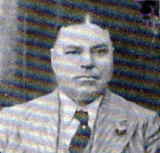
Elnathan J. Tartt (1876-1947)
Elnathan J. Tartt (1876-1947) became Superintendent of the Jefferson Davis Soldier's Home in May 1916.(The Daily Herald, May 8, 1916, p. 1)
Nathan B. Forrest, Adjutant-in-Chief and Chief of Staff of the Sons of Confederate Veterans, leaves today to arrange for the Reunion. (The Daily Herald, March 21, 1917, p. 3)
The Daily Herald, "W.B. Burdine [age 82 and a Georgia native who served with CO C 3rd Alabama Infantry and survived by his widow at the Soldiers Home] dead", June 16, 1917, p. 3.

[from The Daily Herald, March 8, 1919, p. 3]
William J. Ray (1840-1919) was very likely born in Talahatchie County, Mississipppi. He was a resident of Thaxton, Pontotoc County, Mississippi in

[from The Daily Herald, March 8, 1919, p. 3]
The Daily Herald, "Veteran dies at Home [William Marshall (1841-1919), age 78 years and a native of North Carolina, came to Beauvoir from Tallahatchie County, Mississipi in September 1915. He espired at the Beauvoir Soldiers' Home on August 17, 1919. Billy served with the 42nd North Carolina Infantry. Funeral were under the auspices of the Baptist Church with committal in Beauvoir Cemetery", August 18, 1919, p. 4.
1920-1929
The Daily Herald, “Double funeral [J.E. Mosier (1847-1920), from Charleston, Ms.-served under Gen. N.B. Forrest and P.C. Bell (1837-1920, from Liberty, Mus. CO E, 1st La. Cavalry)-internments in Beauvoir Cemetery ] at Soldiers Home”, March 22, 1920.
Ned Tartt (1902-1967) was awarded a special honor at his graduation from GMAC last week. Also Dr. Folkes gave him a $75 shot gun.(The Daily Herald, June 2, 1920, p. 3.)
The Daily Herald, “Confeds visit Biloxi [Three cars of the Gpt.& Ms. Coast Traction Co. take veterans fron Beauvoir to Biloxi]”, June 3, 1920.
The New Year's Day banquet at Beauvoir given to Confederate veterans and spouses by W.M. Lampton of Magnolia, Mississippi set a record as 600 pounds of fried chicken; 3000 Biloxi oysters; 30 gallons of turnip greens; 100 linear feet of jelly roll cake; 25 gallons of sweet milk and many other delicious delectables were served. The dinner cost about $350 and was paid for by Mr. Lampton/(The Daily Herald, January 1, 1921, p. 1)
The Daily Herald, “Dr. Folkes tells why $100,000 hospital is need at the Old Soldiers' Home", July 30, 1921, p. 1.
The Daily Herald, “[Elanathan] Tartt completes arrangements to carry Vets to Chattanooga free", October 22, 1921, p. 1. [The L&N RR, Pullman Company and Southern Railway provided 100 free passes for Confederated veterans to attend 60th Reunion at Chattanooga, Tennessee. Attending with the Beauvoir veterans were: Superintendent Tartt; his wife; Ned Tartt, his son; Dr. H.M. Folkes; Quinea Tarbutton, nurse; and two colored servants].
The Daily Herald, “Old soldier dead [Henry C. Williams (1845-1922)-CO I, 4th Alabama Cavalry-12th death here since January 2, 1922)”, March 4, 1922, p. 4.
The Daily Herald, "Contract let for Hospital", October 19, 1923, p. 1.
The Daily Herald, "New Hospital for Beauvoir will be completed in March", October 22, 1923, p. 1.
John A. Salley (1842-1923), spouse of Martha Cohron Salley (1851-1924) expired on June 26, 1923 in the hospital at Beauvoir. He was born at Bunker Hill, Mississipppi and served with CO E, 15th Mississippi Infantry during the Civil War. Internment at Evergreen Cemetery at Gulfport, Mississippi.[The Daily Herald, June 26, 1923, p. 3]
On December 16th, a fire at Beauvoir destroyed Dormitory No. 3 which was situated west of the old hospital. Two Confederate veterans perished in the conflagration, J.T. Hunter (1844-1924) and F.M. Sharp (1846-1924). They entered the Soldier's Home from, Laurel and Columbus respectively.[The Daily Herald, December 17, 1924, p. 1]
The Daily Herald, “Board praise Beauvoir home”, March 9, 1925, p. 3.
The Daily Herald, “Mississippi G.O.P. factions disagree over Beauvoir”, February 13, 1927, p. 2.
The Daily Herald, “Confedrate soldier dead”, June 6, 1928, p. 5. A.T. Daniel, age 81 years, who entered the Jeff Davis Soldiers Home in December 1925 died here June 6, 1928. He was a member of Blunt's Battalion in the Civil War. He is surviived by Mrs. C.P. Smith, a daughter at Gulfport. The body was taken to Jackson for burial.
The Daily Herald, “[Governor Thomas G. Bilbo] Bilbo presides at Beauvoir meeting”, February 13, 1928, p. 5.
The Daily Herald, “Three deaths at Beauvoir [Martha Garrett (1851-1929), Richard Trehorn, and Marie L. Casey (1847-1929)]”, January 19, 1929, p. 2.
The Daily Herald, “Reverend Elnathan 'Ned' Tartt, the Episcopal minister at Rolling Fork, Mississippi, announced his engagement to Miss Dorothy Porter of Shannon, Mississippi. Dorothy was a graduate of MSCW and the head of modern languages for the public schools of Jackson, Mississippi.”, March 18, 1929, p. 2)
The Daily Herald, “W. J. F. Lilly [age, 82-Co. A 43rd Mississippi Cavalry-entered home from Leake County. Mississippi survived by Lucinda Lilly, his spouse. Corporal remains interred in teh Beauvoir Cemetery] buried”, September 23, 1929, p. 8.
1930-1939
The Daily Herald, “Negro [George Green (1880-1930) ] injured in attack”, March 6, 1930, p. 2.
The Daily Herald, “Watermelons for Vets”, April 7, 1930, p. 2.
The Daily Herald, “Confederate graves marked”, April 29, 1930. In late April, 1930, sing the official bronze marker approved by the UVC, the Beauvoir Chapter of the UDC at Gulfport marked 30 Confederate veterans graves as follows: Mississippi City Cemetery-13 markers; Handsboro Cemetery-14 markers; and St. James Catholic Church Cemetery-3 markers.
The Daily Herald, “Beauvoir ready for guests”, June 2, 1930, p. 2.
The Confederate veterans hold their 40th Reunion at Biloxi. [see The Daily Herald, June 3, 1930, p. 1)
The Daily Herald, “Commends reunion soldiers”, August 1, 1930.
The Daily Herald, “Turnip green Tartt”, September 15, 1930, p. 2
The Daily Herald, “Trustees of Beauvoir meet”, 1932, p. 1.
T.L. Nichols, 84 year-old inmate of the Soldiers’ Home married Mrs. Alice Henshaw, age 65 years, a wealthy widow of Senatobia, Mississippi, who has been visiting at the home for four days. The groom has been in the home for two years coming from Marshall County. Their nuptials were witnessed by about 150 people. The newlyweds left for Senatobia, where they will reside at the home of Mrs. Nichols.The Daily Herald, “T.L. Nichols, 84, Mrs. A. Henshaw, 65, marry at Beauvoir”, January 19, 1932.
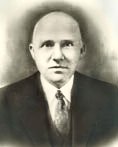
Joseph Wesley Havens (1881-1941)
Elnathan J. Tartt (1876-1947) was replaced by Joseph W. Havens as Superintendent of Beauvoir on July 1, 1932. Joseph 'Joe' Wesley Havens (1881-1941) was born May 24, 1881 at Vancleave, Jackson County, Mississippi to Abizer Havens (1858-1933) and Margarette Berry Havens (1849-1907). (The Daily Herald, June 13, 1932, p. 8)
The Daily Herald, “Celebration at Beauvoir”, June 7, 1933, p. 6.
W.F. Barclay, age 88 years and former member of Co H-18th Mississippi Regiment, died October 12, 1933, at Beauvoir. He had been visited by his wife and three sons from Magnolia, Mississippi.(The Daily Herald, October 14, 1933, p. 4 and October 19, 1933, p. 2)
J.H. Turner, age 102 years and native of South Carolina, served with Co J-41st Georgia Battalion died December 20, 1933. Buried Beauvoir Cemetery.(The Daily Herald, January 12, 1934, p. 10)
The Daily Herald, “Confederate Veteran [H. Walker in Battle of Shiloh at age 14 years. Lives 1624 3rd Street and served with CO F Baldwin Rifles-21st Alabama Regiment] taking Herald 29 years”, September 20, 1934, p. 1.
The Daily Herald, "Books presented [BHS] school", February 18, 1936, p. 1.
The Daily Herald, “Confederate Memorial Day”, April 25, 1935, p. 1.
The Daily Herald, "Memorial service [in memory of Jefferson Davis] in Church of Redeemer", June 1938, p.
The Daily Herald, "Military Crosses presented during program at Beauvoir", June 4, 1938, p. 6.
1940-1949
The Daily Herald, “Beauvoir shrine to open July 1”, May 2, 1940, p. 1.
The Daily Herald, “Sons & Daughters to restore Beauvoir”, May 7, 1940, p. 5.
The Daily Herald, “New directors for Beauvoir named”, May 9, 1940, p. 1.
The Daily Herald, “Honor Guard from [Camp] Shelby coming to Shrine dedication”, May 30, 1941, p. 9.
The Daily Herald, “Beauvoir preview will be Saturday”, February 6, 1941, p .1.
The Daily Herald, “Fine work accomplished in Beauvoir restoration”, February 8, 1941, p. 7.
The Daily Herald, “Will dedicate Beauvoir June 3”, February 10, 1941, p. 1.
The Daily Herald, “Jeff Davis Shrine to be dedicated today”, June 3, 1941, p. 1.
Recommittal of Samuel Davis (

from The Daily Herald, September 9, 1942, p. 6.
The Daily Herald, "Children of Confederacy meet with Miss Redding", October 7, 1942, p. 2.
The Daily Herald, "Mrs. Roach dies [age 84 years, widow of J.M. Roach, Co. C, 24th Ms Cavalary-buried Beauvoir Cemetery]", January 19, 1944, p. 7.
The Daily Herald, “Children of the Confederacy”, February 10, 1944, p. 6.
The Daily Herald, "Last Confederate veteran [John Wesley Castles (1847-1944)] dies at Beauvoir", October 26, 1944, p. 1.
The Daily Herald, “Beauvoir group seeks to raise 250 thousand [dollars for tropical garden to perpetuate the memory of the Men in Gray]”, January 3, 1946, p. 1.
The Daily Herald, “Confederates leaving for their homes on Wednesday”, October 9, 1946, p. 1.
The Daily Herald, “Mrs. [Josie] Rankin assumes duties as Beauvoir Superintendent”, October 15, 1946, p. 1.
Mrs. Hattie Thompson, age 83 years, native of Bay Springs and an inmate at Jefferson Davis Home, died Tuesday night. Mary Glenn, Bay Springs, and Emma Kelly, Gainesville, Florida, her daughters, were at her bedside. Mrs. Thompson was also survived by a son, Charles Athcley of Taylorsville. Funeral services were from the Hospital Chapel by the Reverend C.G. Hodge. Internment was in the Beauvoir Memorial Cemetery.[The Daily Herald, July 21, 1948, p. 8]
Elnathan J. Tartt (1876-1947) expired at Meridian, Mississippi on January 17, 1947. Burial Magnolia Cemetery at Meridian.(The Daily Herald, January 18, 1947, p. 4)
The Daily Herald, “New Beauvoir Head [L. Marie Pearce] named”, August 3, 1948, p. 1)
L. Marie Pearce of Poplarville, Mississippi assumed duties of superintendent of Beauvoir on August 1st, replaceing Josie Rankin of Gulfport. Dr. B.Z. Welch named physician.
The Daily Herald, "12 inmates are now at Beauvoir"- [Marie Pearce, Superintendent. 400 widows and half dozen veterans eligible for admission. Some Board members at this time: Calvin E. Dees-Perkinston; Mrs. Ben Stevens-Hattiesburg; Mrs. A.C. Moore-Hattiesburg; Mrs. Bertha McInnis-Laurel; and J.J. Henry-Laurel], October 6, 1948, p. 1)
The Daily Herald, "Confederate Vets still undecided about final reunion", October 6, 1948, p. 1)
1950-1959
The Daily Herald, “Mrs. Davis' shawl added to Beauvoir museum collection”, April 14, 1952, p. 1)
The Daily Herald, “”, 19.
_________________________________________________________________________________________________
The 1st Battalion Mississippi National Guard was completed in early February. Dr. J.J. Lemon was promoted to Captain and named surgeon of the 1st Battalion. Harry T. Howard (1856-1930), Captain of the Jeff Davis Light Artillery, was promoted to Major, 1st Battalion of the Mississippi National Guard. Lt. Colonel E.W. Merrill was ill at his Moss Point home.(The Biloxi Herald, February 4, 1888, p. 8)
In February, Constantine Olivari (1841-1894) was elected Captain of the Jeff Davis Light Artillery in March to replace Captain Howard. Captain Olivari received his commission from Governor Lowry in late May.(The Biloxi Herald, March 10, 1888, p. 8 and June 2, 1888, p. 8)
The Lamar Guards, a military company of heavy artillery, was organized at Biloxi in January. Officers were: Henry J. Meaut (1842-1934), Captain; Carey Holliman (1860-1935) 1st Lieutenant;Thomas D. Bachino (1861-1891), 2nd Lieutenant; Joseph Ott (1855-1932), Sgt.-at-Arms; and Dan MCDonald, secretary. The officers were commissioned by Governor Robert Lowry (1831-1910) in March. Some of the Springfield Rifles and cartridges for the Lamar Guards arrived in February. Other founding members were: Dan Markey (1855-1900); Peter Gillen (1859-1898) M.J. Grady (1841-1898); Oscar Meaut (1859-1935); Joseph Arguelles (1865-1944); Sam Shaw; and John W. Henley (d. 1918).(The Biloxi Herald, January 21, 1888, p. 1, February 11, 1888, p. 8 and March 3, 1888, p. 8)
Time Line
Slightly over one-hundred ten years ago, the United States and Spain fought a short-term global war. Although the causes for this bellicose action is complex possibly being a combination of Spain’s long internal strife with the Cuban people, the aggressive nature of American capitalism, and yellow journalism by the American press, this conflict had its immediate cause at Havana, Cuba, where the USS Maine, a 318-foot long, American battleship, commanded by Captain Sigsbee, was mysteriously destroyed on February 15, 1898. Several hundred American service men, aboard the Brooklyn Navy Yard built vessel, were killed by a large internal explosion, possibly caused by spontaneous combustion of her coal bunkers. (The Pascagoula Democrat-Star, February 18, 1898, p. 2)
Republican President William McKinley (1843-1901) and the US Congress declared war on Spain on April 21, 1898. The Spanish-American War had several impacts on Mississippi and the South. The economy in the region improved, but the conflict was also the catalyst, which returned Southern people to the mainstream of American cultural life. The pangs of the Civil War defeat and Reconstruction were still felt in the South. The Spanish-American War united former enemies and a new sense of nationalism was reborn. As one former Confederate soldiers said, "if we couldn’t whip Uncle Sam in four years we shouldn’t allow someone else to come here and do what we couldn’t do ourselves". (McLemore-1973, p. 492)
1898
USS Maine, a 318-foot long, American battleship, commanded by Captain Sigsbee, was mysteriously destroyed on February 15, 1898.
Republican President William McKinley (1843-1901) and the US Congress declared war on Spain on April 21, 1898.
Thirty-one Biloxians volunteer to serve in what would become Company D of the 1st Mississippi Volunteer Regiment. This group of men was based in Scranton [Pascagoula], Mississippi and led by Edgar Rollins DuMont.(The Biloxi Daily Herald, May 14, 1898, p. 8)
Gus Henzelena, Jap Brugniens, John Andrews, Ed Weber, Walter Champlin, Jack King, William H, Smith encamped at Chickamauga, Tennessee returned to Biloxi for a thirty day leave.(The Biloxi Daily Herald, September 17, 1898, p. 8)
Private Emile Tremmel (1868-1898), a native of New Orleans, died of sickness at Camp Chickamauga, Tennessee, on August 26, 1898. His remains were accompanied to Biloxi by Gus Henzelena (1869-1953). (The Biloxi Daily Herald, December 22, 1898, p. 8, and August 27, 1898, p. 8)
James Sheasby (who left Biloxi to enlist in the US Navy several months ago has received his discharge. He was on the USS Buccaneer and saw active service at Santiago [Cuba].(The Biloxi Daily Herald, October 20, 1898, p.8)
1899
Corporal John Meunier and Private John Griffin of Heed’s [sic] Regiment are home again.(The Biloxi Daily Herald, June 27, 1899, p. 8)
1934
The Admiral P. Magruder Camp of Spanish American War veterans held a memorial service at the BYC in memory of the 266 men who were killed when the USS Maine sank in Havana Harbor on February 15, 1898. The H.D. Money Camp of Gulfport cooperated with the Biloxi camp in sponsoring the event which was attended by 45 Boy Scouts from Biloxi, representatives of various patriotic organizations, and invited guests of the camp and its auxiliary. E.J. Scott, commander of the Biloxi camp, presided over the gathering.(The Daily Herald, February 6, 1934, p. 2)
1936
The Reverend John Campbell of the Presbyterian Church to honor those American servicemen lost at Havana, Cuba on February 15, 1898, delivered a memorial address to members of the Admiral Thomas P. Magruder Camp, veterans of the Spanish-American War.(The Daily Herald, February 18, 1936, p. 3)
Admiral Thomas P. Magruder-Camp No. 19-Biloxi, Mississippi
William F. Jones, commander; F.J. Bettinger Sr., vice commander; Harry L. Moody Jr., vice commander; E.J. Scott, quartermaster; John M. Thomas, adjutant; John G. Whelen, officer of the day; James C. Banks, officer of the guard; E.C. Rowen, trustee; C.W. Trotter, trustee; E.E. Cooper, trustee; John R. Meunier; Major Wooters; Gordon W. Cogan; Amile Bonham; John Fayard; Anthony V. Foretich; Charles G. Elfers; and L.J. Rafferty.(Lang, 1936, p. 54)
1937
Marks P. Richardson, age 64 years, Spanish American War veteran, died at 8:55 p.m., March 5, 1937 at the veterans; Adminkstration. He was admitted on June 27, 1936. Marks enlisted in the US Army on May 10, 1898 and was honorably discharges on December 20, 1898, as a private in CO E, Ist Mississippi Infantry. Mrs. Francis McMasterts Richardson, his spouse, resides in the Como Hotel, at Jackson, Mississippi.(The Daily Herald, March 6, 1937, p. 2)
1941
Mrs. L. Holzer hosted the USS Maine Memorial services of the H.D. Money Camp and Auxiliary of the Spanish American War. Commander John L. Heiss served as master of ceremonies. John Brownlee, advanced the colors, and W.A. Thornton gave the invocation. Members of the auxiliary sang 'America' accompaied by Madame Lillye Violet Carrara. Ed Watts gave a short memorial talk and H.M. Harless provided the benediction. Refreshments were served by Mrs. Holzer.(The Daily Herald, February 18, 1941, p. 10)
Victor Muleon, commander.(The Daily Herald, February 20, 1941, p. 14)
1943
Leonard Hopkins (1875-1943), native of San Augustine, Texas and resident of Biloxi for over fifty years died at Biloxi on December 24, 1943 . Mr. Hopkins resided on Reynoir Street and served as a private in the 2nd Mississippi Volunteer Infantry.(The Daily Herald, December 27, 1943, p. 5.)
1983
Herman Miller (1880-1983), native of Sweden and Spanish-American War veteran, expired in the Minneapolis, Minnesota VA Hospital. He was national commander of the Spanish-American War Veterans in 1979-1980. Mr. Miller was recommended for the Medal of Honor by his commanding officer, but time, loss of records and the US Army prevented him from this courageous award.(The Daily Herald, April 11, 1983, p. A2)
Biloxi Volunteers
Biloxians who volunteered to serve their country in the Spanish American War joined the Scranton [Pascagoula] Company, which became Company D of the 1st Mississippi Volunteer Regiment. W.P. Henley, former Captain of Battery D, and Albert ‘Tab’ Irish Hann, formerly 1st Lieutenant of Battery A, both enlisted as privates. Hann had been elected to his post in November 1897.(The Biloxi Daily Herald, May 14, 1898, p. 8)
Henley and Hann left Biloxi in May 1898 to go to Jackson, Mississippi for interviews and medical examinations with the following Biloxians: A.J. Meynier; John Fayard; August ‘Gus’ Henzelena (1869-1953); Anthony V. Foretich [1856-1945]; John T. Andrews (1860-1908); Walter G. Champlin; Edward Caillavet (1874-1923); John Griffin; J. Lamy [sic]; B. Compus [sic]; W.F. Jones; Arthur E. Richard (1877-1949); John ‘Jack’ T. King; R. Anderson Dancer (1878-1915); Emile Joseph Pons (1865-1914); Harry Bowers; Jasper ‘Jap’ Brugniens [1877-1954]; John Rene Meunier (1880-1944); Leon Charles Meunier (1878-1922); William H. Smith; Nels J. Peters (1868-1935); John Dumar?; Gordon M. Dawson; W.D. Simms; James Williams; J.E. ‘Ed’ Weber; C.C. Harlan; and Sam Murray.(The Biloxi Daily Herald, May 14, 1898, p. 8)
After their excursion to Jackson, the following Biloxi volunteers were mustered into Company D, 1st Regiment, Mississippi Volunteers: Albert Hann [1878-1933], 1st Sgt.; Arthur Richards [1877-1949], 2nd Sgt.; John Fayard, Corporal; Leon C. Meunier [1878-1922], Corporal; Gus Henzelena [1869-1953], Cook; John T. Andrews [1860-1908]; A.V. Foretich [1856-1945]; Emile Tremmel [1868-1898]; Emile Pons; [1865-1914]; Ed Weber; John T. King; G.W. Champlin; G. Darson; H. Bowers; W. Jones; Jasper L. Brugniens [1877-1954]; John Peters; and W.H. Smith.[The Biloxi Daily Herald, May 21, 1898, p. 8]
Biographies
John T. Andrews
John T. Andrews (1860-1908) was born at Biloxi, Mississippi to George W. Andrews (1823-) and Caroline G. Andrews (1838-1886). He married Rosa Llado in Harrison County, Mississippi on February 15, 1882.(Harrison Co., Mississippi Circuit Court MRB 7, p. 342)
John T. Andrews expired at Biloxi on September 26, 1908. His funeral was held from the residence of his brother, Dudley Andrews, at 930 Lameuse Street. John was survived by his two brothers, George W. Andrews (1864-1909) and Dudley Andrews (1866-1939). His corporal remains were laid to rest in the Biloxi Cemetery.(The Biloxi Daily Herald, September 26, 1908, p. 4)
Anthony V. Foretich
Albert I. Hann (1879-1933) was born . He married Alice King (1879-1964) of Birmingham, Alabama. Expired December 1933. Three children: Cornelia Hann (1902) m. John G. West; Gelon Hann (1903); and Elizabeth ‘Betty Hann (1905-1991) m. Mr. Chastang and Ulric Seuzeneau (1902-1982). Buried Chalmette National Cemetery, Chalmette, Louisiana.
Emile J. Pons
US Navy
James H. Sheasby
James H. Sheasby (1877-1938) was born in England and came to America in 1898. He married Irene Helena Collier (1882-1958), a Mississippi lass, in Harrison County, Mississippi on April 8, 1901. They were the parents of eight children: Elvera Lucille Sheasby (1902-1955) m. Mr. Smith; James Collier Sheasby (1906-1971) m. Mildred Norman; Harold Sheasby (1908-1957); Elbert James Sheasby (1909-1968) m. Nell Stark; Marguerite Sheasby (1910-1988) m. Arthur L. Dickinson; Reynolds O. Sheasby (1913-2002); Charlotte Sheasby (1916-1990) m. Mr. Meyers; and Doris Sheasby (1919-2002) m. Richard M. Corkern (1917-1991).(Harrison Co., Mississippi Circuit Court MRB 13, p. 110)
After the Spanish-American War commenced, James H. Sheasby enlisted in the United States Navy. He was discharged in October 1898 and returned to Biloxi. While in military service he served on the USS Buccaneer [sic and probably USS Brooklyn] at the Battle of Santiago de Cuba in 1898.(The Biloxi Daily Herald, October 20, 1898, p. 8)
James H. Sheasby and family lived at 221 Kuhn Street in Biloxi. He made his livelihood as a marine engineer and boat captain. On October 14, 1906, James H. Sheasby was burned badly at Daigle’s Wharf in Houma, Louisiana when the gasoline boat that he crewed on exploded. He was employed by the Pelican Lake Oyster and Packing Company. Captain Peter Harvey appears to have been in command of the vessel which was a total loss and valued at $5000. Following the boating accident, Mr. Sheasby returned to Biloxi via New Orleans.(The Biloxi Daily Herald, October 16, 1906, p. 2 and October 31, 1906)
James H. Sheasby expired on December 7, 1938 at the US Marine Hospital at New Orleans. His corporal remains were interred in the St. Roch Cemetery No. 1 at New Orleans.(The Times-Picayune, December 8, 1938, p. 23)
US VOLUNTEERS -5th Immune Regiment
This unit, composed of men from Alabama, Mississippi, and Louisiana, was mustered at Columbus, Mississippi, in late July 1898. Colonel H. H. Sargent was in command. The 5th Immune Regiment was sent to Cuba to relieve the troops of General Shafter at Santiago de Cuba, after the fighting there had subsided. They performed garrison duty here from August 1898 until March 1899. Their chief enemy was malaria and yellow fever and the other pestilence which pervaded this tropical island. (Rowland-1978, p. 560).
The 5th Immune Regiment left Columbus, Mississippi on August 6, 1898, for Savannah, Georgia, their embarkation point for southeastern Cuba. The troop transports left Savannah on the 8th of August, and arrived at Santiago de Cuba on the morning of August 12, 1898. Major James K. Vardaman (1861-1930), who resigned from the editorship of The Greenwood Commonwealth to lead a battalion of soldiers of the 5th Immunes, wrote a series of letters to his wife, Anna Burleson Robinson Vardaman. They give a detailed picture of a soldier’s life and living conditions in the tropics. The Vardaman letters were published in The Journal of Mississippi History, in April 1947. Before the Spanish-American War, Texas native, J.K. Vardaman, was a lawyer-newspaper editor. He practiced law at Winona and was editor of The Winona Advance (1882). Vardaman relocated to the Delta and edited The Greenwood Enterprise-Greenwood Commonwealth from 1890-1903. Returning from Cuba, he entered politics and was elected as a populist Democratic Governor serving the State from 1904-1908, in that capacity. Vardaman was Mississippi’s U.S. Senator from 1913-1919. He became known as "the great white father". (Biographical Directory of the American Congress-1961, p. 1751).
Major James K. Vardaman led about 82 enlisted men from Mississippi to Cuba. These young men left home robust and healthy. At Cuba, seven died, twenty-five were sent home, and for the most part the remainder "looked more like half-animated cadavers than the stalwart men they were when the regiment first landed on Cuban soil". (The Pascagoula Democrat-Star, April 14, 1899)
In May 1899, the 5th US Volunteer Infantry was sent to Camp Meade at Middleton, Pennsylvania. They were mustered out in June 1899. (The Pascagoula Democrat-Star, May 19, 1899)
Biographies
William E. Ryan
Corporal William Edward "Will" Ryan (1877-1925)-William E. Ryan was the son of Antoine Ryan (1846-1908) and Marie Ryan (1846-1886+) of Ocean Springs, Missisippi. During the Spanish-American War, he served in Company A of the 5th Immune
After the conflict, Will Ryan worked on a steamboat in 1900, and moved to Biloxi circa 1907, where he worked for the Biloxi police force. Ryan later made his livelihood as keeper of the Biloxi Yacht Club. He married Theodora Vuyovich (1886-1944) of Biloxi. Their children were: Oliver Ryan (1907-1930+), Marshall J. Ryan (1910-1930), Theodora Ryan (c. 1914), Rayoal Ryan (c. 1917), and William Ryan. The family resided at 804 Reynoir Street. Will Ryan’s corporal remains were interred in the Biloxi City Cemetery. (The Daily Herald, December 2, 1925, p. 2, and Krohn, 1995, p. 16).
A son, Marshall J. Ryan (1910-1930), died of pneumonia in March 1930. He worked for the Mississippi Ice and Utilities Company. (The Daily Herald, March 15, 1930, p. 2)
REFERENCES:
Arthur Lang, History of Harrison County, Mississippi, (The Dixie Press: Gulfport, Mississippi-1936).
The Biloxi Daily Herald, ‘Latest City News’, November 27, 1897.
The Biloxi Daily Herald, ‘Biloxi furnishes her quota of Volunteers’, May 14, 1898.
The Biloxi Daily Herald, ‘Biloxi’s dead soldier [Emile Tremmel]’, August 27, 1898.
The Biloxi Daily Herald, ‘Local Brevities’, August 30, 1898.
The Biloxi Daily Herald, ‘Local and Personal’, September 10, 1898.
The Biloxi Daily Herald, ‘Local and Personal’, September 17, 1898.
The Biloxi Daily Herald, ‘Hood’s Immunes’, October 14, 1898.
The Biloxi Daily Herald, ‘Local and Personal’, October 20, 1898.
The Biloxi Daily Herald, ‘The [Emile Tremmel]monument unveiled’, February 21, 1899.
The Biloxi Daily Herald, ‘Local and Personal’, June 27, 1899.
The Biloxi Daily Herald, ‘Personal’, October 31, 1906.
The Biloxi Daily Herald, ‘Locals’, October 16, 1906.
The Biloxi Daily Herald, ‘Necrology-John T. Andrews’, September 26, 1908.
The Daily Herald, ‘Biloxian [Albert I. Hann]tells of work in Cuba’, April 18, 1912.
The Daily Herald, ‘Corporal William E. Ryan’, December 2, 1925.
The Daily Herald, ‘Marshall Ryan Dies’, March 15, 1930.
The Daily Herald, ‘Hann’, December 4, 1933.
The Daily Herald, ‘Memorial service for men who lost lives on the Maine’, February 6, 1934.
The Daily Herald, ‘Henry Coley buried’, February 16, 1934.
The Daily Herald, ‘Memorial Service’, February 18, 1936.
The Daily Herald, 'Leonard Hopkins dies', December 27, 1943.
The Daily Herald, ‘Spanish-American War vet dies’, April 11, 1983.
The Houston Chronicle, ‘Doris Sheasby Corkern’, July 4, 2002.
The Times-Picayune, ‘Murder victim believed to be Albert K. (sic) Hann’, December 5, 1933.
The Times-Picayune, ‘Services for Captain Sheasby’, May 6, 1938.
The Times-Picayune, ‘Hann’, May 6, 1964.
Some Biloxians who served in Company D, under Captain duMont were: Gus Henzelena (1869-1953), A.V. Foretich, Tom McCabe, W. Smith, John Fayard, and Emile Tremmel. Private Emile Tremmel (1869-1898), a native of New Orleans, died of sickness at Camp Chickamauga, Tennessee, in late August 1898 His remains were accompanied to Biloxi by Gus Henzelena. (The Biloxi Daily Herald, December 22, 1898, p. 8, c. 1 and August 27, 1898, p. 8, c. 3)
Also, Albert Irish Hann, son of Gelon Hann. (see DH, 12-4-1933, p. 1)
|
|
|
WORLD WAR I [1914-1918]
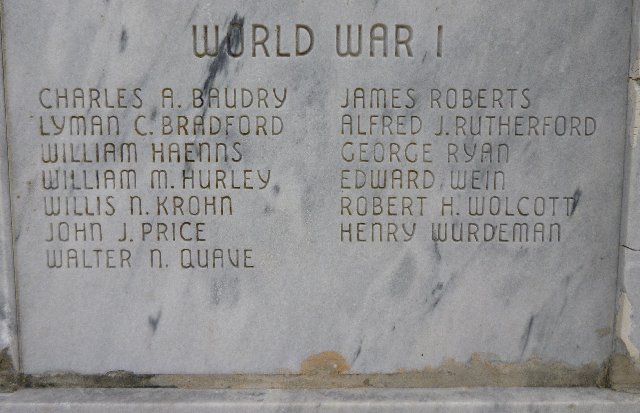
WWI MEMORIAL-GLENNAN PARK
East Beach Drive-US Highway No. 90
TIMELINE
June 28, 1914-Archdule Franz Ferdinand of Austria, the heir to the throne of Austria-Hungary was assignated in Serbia.
July 28, 1914-Serbia invaded by Austro-Hungarians followed by German invasion of Belgium, Luxembourg, and France and a Russian attack against Germany.
April 6, 1917-United States of America enters WW I.
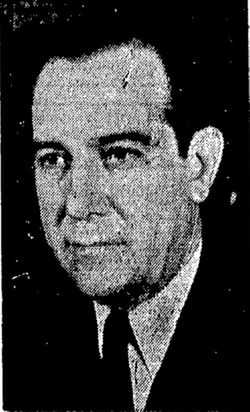
Thomas J. Grayson
October 1918-Thomas J. Grayson, First Lieutenant, U.S. Army, 28th Infantry Regiment, 1st Division, A.E.F. Date of Action: October 2 - 3, 1918-General Orders No. No. 16, W.D., 1920-Citation: The Distinguished Service Cross is presented to Thomas J. Grayson, First Lieutenant, U.S. Army, for extraordinary heroism in action near Exermont, France, October 2 - 3, 1918. Lieutenant Grayson commanded a combat patrol which penetrated 2 kilometers into the enemy lines, and although twice attacked he maintained his position for 36 hours without supplies before returning to our lines with valuable information. The leadership and initiative displayed by Lieutenant Grayson were vital factors in the successful performance of this important mission.
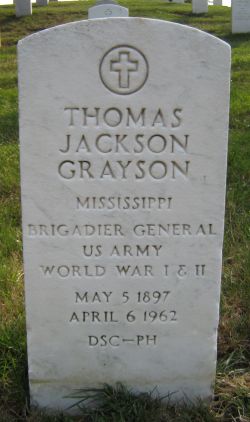
November 11, 1918-Armistice Day.
January 1921-Edward Herbert Wolcott (1894-1918), who passed from pneumonia at Flanders Field Base Hospital No. 47 at Beaune, France on October 23, 1918, was buried on January 15, 1921 in the Biloxi Cemetery. Services were conducted under the auspices of the Catholic Church and pallbearers were selected from the Charles Baudry American Legion Post. A firing squad of eight men and a bugler under the command of a petty officer from the Gulfport Naval Station accompanied the body to its final resting place.The deceased was survived by his parents, Mr. and Mrs. H. Wolcott; five brothers, Oliver C. Wolcott; Ralph Wolcutt; Harold Wolcutt; Frank Wolcutt; and Payne Wolcutt; and one sister, Miss Lee Vicie. Edward was reared in Biloxi and resided here prior to enlisting inthe 1st Alabama Infantry at Mobile.(The Daily Herald, January 25, 1921, p. 2)
June 1947-The Lyman C. Bradford Post, VFW began planning for a memorial park between Lameuse and Main Street to honor Biloxians who lost their lives in WWI and WWI. The memorial was to cost $3500 and will be donated anonymously by a local citizen.(The Daily Herald, June 5, 1947, p. 13)
Former Biloxian, Brigadier General Thomas Jackson Grayson (1897-1962), son of George W. Grayson and Mamie Pol Grayson, died on April 6, 1962. Interment was in Arlington National Cemetery. He was former Adjutant General of Mississippi, head of the Mississippi State Draft Board and the husband of Elizabeth Dantzler (1901-1946).
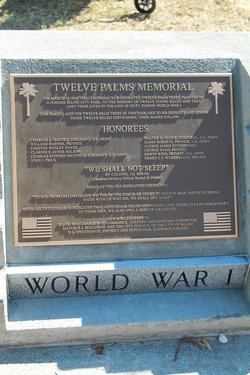
2014 Twelve Palms Memorial-Biloxi Business Men's Park
November 2014-The Biloxi Bay Chamber of Commerce through its Cultural and Heritage Committee re-dedicated the Twelve Palms Memorial on Veteran's Day 2014. The original Twelve Palms Memorial was created to honor the twelve Biloxians who lost their lives during World War I. The Biloxi Cleophan Club in March 1919,planted twelve palm trees in the L&N Park on the SW/C of Reynoir and Railroad Street, now called Esters Boulevard.(The Bilxoi-D'Iberville Press, November 7, 2014, p. 1)
____________________________________________________________________________________________
BILOXI WAR VETERANS
WWI
Captain John Meunier led Biloxi soldiers to Camp Beauregard on . His men were bivouacked in the Firemen’s Hall on Lameuse Street. In late May 1921, the flag pole that was set when they camped here was removed.
DEATHS
Men from Biloxi who died in training or participating in WWI are listed sequentially by their date of demise: George C. Ryan (1892-1917); Walter N. Quave (1886-1917); Charles L. Baudry (1891-1918); Alfred James Rutheford (1892-1918) James Roberts; Charles Nicovich (1892-1918); John J. Price; Clarence Avner Nelson; Edwin Wein (1898-1918); Chester Wesley Hayes; Henry C.T. Wurdemann (1888-1918); William Haenns (1890-1918), and Lyman C. Bradford.
In March 1919, a corrected list of 'Palm Soldiers', those from Biloxi who gave their precious lives for their country and fellow Americans, was published in The Daily Herald. A palm tree was planted in the city to honor each of these fallen heroes, as folows: Charles L. Baudry; William Haenns; Chester Wesley Hayes; Clarence Avner Nelson; Charles Nicovich; John J. Price; Walter N. Quave; James Roberts; Alfred James Rutherford; George Ryan; Edwin Wein; and Henry C.T. Wurdemann.(The Daily Herald, March 12, 1919, p. 3)
______________________________________________________________________________________________________________________
*Private George C. Ryan (1892-1917), the son of Beauregard Ryan and Virginia Vallen (1858-1928), was killed on April 23, 1917 near Enterprise, Clarke County, Mississippi when he was hit by a train. He was serving with the 1st Mississippi Infantry at the time. during World War I. Private Ryan's siblings were: Edward J. Ryan (1884-1963), Virginia R. Richards (1885-1963+), Richard Ryan (1887-1927), Ila Ryan Beaugez (1890-1914), Clarence Ryan (1895-1966), Samuel Ryan (1888-pre 1900), Homer Ryan (1905-1977), and Selma Ryan (b. 1897?).
______________________________________________________________________________________________________________________
Corporal Walter N. Quave (1886-1917), the son of Joseph Quave (1859-1928) died on December 27, 1917 at Camp Beauregard, Louisiana from pneumonia. He was a member of Troop B, Biloxi Calvary and was later transferred to a caisson company of the 114th Ammunition Train.(The Daily Herald, December 29, 1917, p. 1)
______________________________________________________________________________________________________________________
*Private Edwin Wein (1898-1918) died at Camp Beauregard, Louisiana on January 2, 1918. Edwin Wein was the son of John F. Wein (1851-1931), an 1871 Danish immigrant, and Anna Wein (1872-1910+), a native of NOLA. Initially John Wein and family lived on Lameuse Street, but by 1910 had moved to western Jackson County, Mississippi were he was a truck farmer. The Weins acquired land in the present D'Iberville community and in July 1919, they sold ten acres to Holen Hunter Grantham (1892-1964), who founded the Grantham Dairy. This tract was bounded by the following owners: north, B. Tucei; east, R.J. Quave; south, John Wein; and west, Louis Seymour.(1900 Harrison Co., Mississippi Federal Census T623_808, p. 22B, p. 21 and 1910 Jackson Co., Mississippi T624_744, p. 3B, ED 63 and 1910 Harrison County, Ms. Land Deed Bk. 126. p. 350)
The funeral of Private Edwin Wein was held at the residence of Mr. and Mrs. Robert Haas on Lameuse Street with internment in the Biloxi Cemetery. The body of Private Wein was brought to Biloxi by a representative of Caisson No. 2 of the Ammunition Train. Theodore W. Wein (1899-1982), stationed at Fort Worth, Texas, came to Biloxi for the funeral of his brother. He was also survived by a sister, Antoinette Wein Cress(1904-1925+).(The Daily Herald, January 4, 1918, p. 3 and January 5, 1918, p. 3)
__________________________________________________________________________________________________
*Private William Haenns (1890-1918) died May 10, 1918 at Camp Beauregard, Louisiana. His story is quite interesting. William Haenns, a native of Chicago, and Harry K. Barth wondered into Biloxi, Mississippi in early 1917 with their knapsacks and violins. They related that they had left Michigan for a walk as a 'study in human nature'. They planned a short tenure in the Queen City, but were widely accepted and appreciated for their musical talents. The troubadors not only entertained crowds with their violin, piano and vocal performances, but Haenns even directed the orchestra at the White House Hotel in the summer of 1917. The corporal remains of Private William Haenns were interred in the Biloxi Cemetery.(The Daily Herald, May 11, 1918, p. 3, The Sun Herald, September 18, 2011, p. F4 and September 25, 2011, p. F3)
______________________________________________________________________________________________________________________
*Alfred James Rutherford (1892-1918) was born at New Orleans on January 21, 1892 to Charles Frost Rutherford (1846-1923) and Laura R. Simmons (1861-1931). The Rutherfords, both native of the Crescent City, were married at New Orleans in January 1886. Their other children were: Charles H. Rutherford (1886-1889); John S. Rutherford (1888-1900+); Richard Shea Rutherford (1889-1922); Alice Edna Rutherford (1890-1914); Joseph Rutherford (1897-1900+); and Robert Rutherford (1900-1900+).(1900 Harrison Co., Mississippi Federal Census T 623_808, p. 15B, ED 31 and WWI Draft Registration-Harrison Co., Mississippi R1682923)
______________________________________________________________________________________________________________________
Charles S. Nicovich (1892-1918) was born September 28, 1892 at Mississippi City, Harrison Co., Mississippi to Marco Nicovich (?-1892), an Austrian immigrant, and Rosa Gondroun (1859-1952), a native of Louisiana. He was a single man and an employee of the Southern Pacific Railroad at Algiers, Louisiana and a resident of 5077 Dauphine Street in New Orleans when he registered for the miltary draft in 1917. Charles S. Nicovich passed on October 8, 1918 at Camp Merit, New Jersey, a victim of the Spanish influenza. His corporal remains were interred in the St. James Cemetery at Handsboro, Mississippi.(The Daily Herald, October 9, 1918, p. 3, October 14, 1918, p. 3)
Sergeant Nicovich was lauded by Major J.I. Sloat, his commander, as follows: "Sergeant Nicovich was an excellent soldier who was universally liked his officers and fellow soldiers, and his untimely death is a source of genuine sorrow to all. His death occured in the line of duty, and is no less honorable that had it occurred on the field of battle."(The Daily Herald, October 15, 1918,
_________________________________________________________________________________________________________________________________________________________
*Henry Charles Thomas Wurdemann (1888-1918) was born on November 7, 1888 at New Orleans, the son of Henry Wurdemann (1862-1936) and Bernadina Hoff (1870-1940). He passed from the Spanish influenza on October 10, 1918 at Camp Fortress, Virginia. Private Wurdermann had been trained at San Antonio, Texas and was stationed in Virginia at the time of his demise in October 1918. He was a member of the 29th Balloon Company, Air Service U.S. Army. Private Wurdemann was survived by Lovinia Fayard Wurdemann, his wife, parents, and several sisters and brothers.(The Daily Herald, October 11, 1918, p. 3)
The Henry Wurdemann family came to Biloxi from Derbigny Street in New Orleans circa 1904 and settled on ‘The Point’ on First Street. Both Henry Wurdemann and Henry C.T. Wurdemann were employed in the seafood industry at Biloxi as a fisherman and shell grinder respectively. By 1910, the Wurdemann family consisted of eight children extant, although Bernadina had birthed twelve: Henry C.T. Wurdemann (1888-1918); Augusta Wurdemann (1891-1908+) m. John Peter Baker; William Wurdemann (1895-1910+); Hazel Wurdemann (1896-1926); Frederick Wurdemann (1898-1910+); Alma Wurdemann (1902-1917); Mary Wurdemann (1904-1949) m. Lester Anton Narbo (-1960); Carl Wurdemann (1908-1908); and Ola Wurdemann (1909-1936+) m. Bill Thompson.(1900 Orleans Parish, Louisiana Federal Census T623_572, p. 3A, ED 67 and 1910 Harrison Co., Mississippi Federal Census T624_740, p. 26B, ED 33)
Private Wudemann’s corporal remains were brought to Biloxi by Corporal Neil Mooney who related the following to the local press: “Private Wurdemann was under me in performance of a number of duties. He seemed to be an expert rigger. He had a full military funeral side arms, preceded by the post band playing the dead march. It was very impressive. The casket was carried caisson to the depot. A large floral wreath, the tribute of his Company, together with two side American flags, came to this city with his body.”(The Daily Herald, October 14, 1918, p. 3)
Henry C.T. Wurdermann‘s corporal remains were interred in the Biloxi City Cemetery on October 14, 1918. Reverend Wabus, a Lutheran minister, presided at his burial service.(The Daily Herald, October 15, 1918, p. 3)
____________________________________________
James Roberts (1894 - 1918) was born, June 20, 1894, at Bayou La Mere, Plaquemine, Louisiana, son of Antonio James (Hymene) Roberts Sr.(1843 -1893) and Maria Gonzales Roberts. The Roberts were natives of Terre-Aux-Beoufs, St. Bernard Parish, Louisiana, Isleño descendants of the Canary Islands, Spain and natives of Louisiana.
Private James Robert was a resident of 438 Copp St. Biloxi, Mississippi. A single man, self-employed fisherman and among the Biloxians that left from Gulfport, Mississippi to Camp Greenleaf, Georgia, on July 26, 1918. He served as a member of the limited service division, a member of the Infantry. He died at Camp Server, South Carolina an October 11th, 1918, of the Spanish influenza, viral pneumonia. Private Roberts was survived by three sisters and four brothers along with his blind mother. He was waked at his mother's residence at 421 Washington Street at Biloxi with Father Milot, officiating. His corporal remains were interred in the Biloxi Cemetery on October 15t, 1918.(The Daily Herald, October 11, 1918 and October 14, 1918)
Six months after the passing of her husband on December 4th, 1893, Maria Gonzales Roberts (gave birth to Private James on June 20, 1984. She came to Biloxi with eight children: Matilda Roberts (dec. 1933), Carmela Roberts (dec. 1930), Josephine Roberts (dec.1989),Robert(1877-1964), William(dec.1930), Joseph(dec. 1938),and Victor Emile(1867-1959) and James Roberts (1894 -1918). Maria Gonzales Roberts (dec. 1931)is buried in the Biloxi Cemetery.[Courtesy of Barbara Acosta Perez, Picayune, Mississippi-May 28, 2014)
________________________________________________
*Charles L. Baudry (1891-1918), the son of Jules J. Baudry and Louise Comment, was born at New Orleans, Louisiana on September 1891. Joined US Marine Corps and served in France with Company I, 16th Infantry.
__________________________________________________________________________________________________
*Lieutenant Lyman C. Bradford (1888-1920) was the son of Lyman Bradford and Pearl Roberts. He was born at Biloxi, Mississippi on November 14, 1888. m. Maud Foxworth. Died at May 28, 1920.
Edward Herbert Wolcott (1894-1918), who passed from pneumonia at Flanders Field Base Hospital No. 47 at Beaune, France on October 23, 1918, was buried on January 15, 1921 in the Biloxi Cemetery. Services were conducted under the auspices of the Catholic Church and pallbearers were selected from the Charles Baudry American Legion Post. A firing squad of eight men and a bugler under the command of a petty officer from the Gulfport Naval Station accompanied the body to its final resting place.The deceased was survived by his parents, Mr. and Mrs. H. Wolcott; five brothers, Oliver C. Wolcott; Ralph Wolcutt; Harold Wolcutt; Frank Wolcutt; and Payne Wolcutt; and one sister, Miss Lee Vicie. Edward was reared in Biloxi and resided here prior to enlisting inthe 1st Alabama Infantry at Mobile.(The Daily Herald, January 25, 1921, p. 2)
__________________________________________________________________________________________________
*Recognized on WW I Memorial at Glennan Park in Biloxi, Mississippi.
REFERENCES:
1914
The Daily Herald, “Miss Rutherford dead”, April 22, 1914.
1917
The Daily Herald, “George Ryan killed”, April 23, 1917.
The Daily Herald, “Dance honors soldiers”, December 12, 1917.
The Daily Herald, “Corp. Quave pneumonia victim”, December 29, 1917.
1918
The Daily Herald, “[Edwin] Wein remains to arrive tonight”, January 4, 1918.
The Daily Herald, “Funeral of Private Wein held today”, January 5, 1918.
The Daily Herald, “Private Haennes (sic) to be buried here”, May 11, 1918.
The Daily Herald, “Local News paragraphs of Interest”, July 4, 1918.
The Daily Herald, “Joseph Rutherford home”, April 17, 1917.
The Daily Herald, “Joe Rutherford on Patrol Duty”, July 17, 1917.
The Daily Herald, “Alfred Rutherford Dead”, July 29, 1918.
The Daily Herald, “Body of Alfred Rutherford expected today”, July 31, 1918.
The Daily Herald, “Burial of Alfred Rutherford today”, August 1, 1918.
The Daily Herald, “Biloxi resident dies at Camp”, October 9, 1918.
The Daily Herald, “Henry Wurdemann dies at camp”, October 11, 1918.
The Daily Herald, “James Roberts dead”, October 11, 1918.
The Daily Herald, “Nicovich body arrives tonight”, October 12, 1918.
The Daily Herald, “Nicovich funeral yesterday”, October 14, 1918.
The Daily Herald, "James Roberts dead”, October 11, 1918.
The Daily Herald, “[James] Roberts body to arrive tomorrow”, October 14, 1918.
The Daily Herald, “Biloxi News Paragraphs”, October 14, 1918.
The Daily Herald, “Private Wurdemann buried yesterday”, October 15, 1918.
The Daily Herald, “Praise of Sergeant Charles Nicovich from his commanding officer”, October 15, 1918.
The Daily Herald, “Casualty show two Biloxians”, December 5, 1918.
The Daily Herald, “Obituary [Charles L. Baudry]”, December 7, 1918.
1919
The Daily Herald, “Corrected list of Palm Soldiers”, March 12, 1919.
The Daily Herald, “Cleophan Club planted palms”, March 17, 1919.
The Daily Herald, “Biloxi Post holds meeting”, November 4, 1919.
The Daily Herald, “Route of parade Thursday named”, November 25, 1919.
1920
The Daily Herald,"Lieut. Bradford's funeral yesterday", May 31, 1920.
The Daily Herald,"Bradford funeral held today", June 1, 1920.
1921
The Daily Herald, "Soldier's [Edward H. Wolcott] funeral held", Jauary 15, 1921.
The Daily Herald, “Flag pole comes down”, May 24, 1921.
1922
The Daily Herald, “Richard Shea Rutherford”, May 8, 1922.
1947
The Daily Herald, “Advance efforts for Memorial park on Biloxi Beach Front”, June 5, 1947, p. 13.
2010
The Sun Herald, “Biloxi American Legion gets first female Commander [Mildred Johnson]”, October 26, 2010.
The Sun Herald, “Musical Tramps, Part 1 [William Haenns]”, September 18, 2011.
The Sun Herald, “Musical Tramps 2 [William Haenns]”, September 25, 2011.
An unusual Prohibition day at Biloxi
Tis January 1922 and Prohibition is no longer the latest government interference in the minds of common folks. The lady seafood workers are busy in the oyster season as their spouses and sons harvest the fatten mollusks from fecund waters of the Louisiana marshes and Pass Christian reefs. The tourist club is fully subscribed with Midwest ‘Yankees’ and they are enamored with the mild winter weather as they enjoy a round of golf or a game or roque in the city park.
Rumrunners come and go with their illicit cargoes of spirituous liquors and moonshiners are busy as well distilling corn mash in their crude stills which are proliferating in the surrounding piney woodlands. The federal revenue agents are energetic as well seeking to discover and destroy illegal whiskey manufacturing and punish those responsible. They are ably assisted by the US Coast Guard whose revenue cutters ply the Mississippi Sound seeking to interdict and captured imported wine and liquor from foreign or domestic shores.
This is no tall tale or imaginative story but on or about 15 January, an unknown, sailing vessel flying the Cuban flag dropped anchor off Biloxi near Dog Key. While the Captain of the fishing schooner came ashore for water and provisions, the Naomi, a motor vessel, with armed men, boarded the mystery ship and captured the crew using gunfire aimed at their feet as persuasion. These ‘Biloxi pirates’ then “convinced” the frightened sailors to offload 110 cases of expensive champagne, cognac and bonded whisky to the waiting Naomi.
After the raid, the “Biloxi pirates” motored up Back Bay in the vicinity of Popp’s Ferry where they deposited their liquid loot on shore, albeit in a haphazard fashion, as their pursuers would discover. After receiving a reliable “tip”, the search for the stolen but illegal cargo was led by US Deputy Marshal A.W. Loposser, four Harrison County Deputy Sheriffs, Constable W.N. Bolton, and Biloxi police officers: Charles Lowd, Alonzo Gabrich, Richard Grady, George Mon, and Joseph Mattina. Arriving in the vicinity of Popp’s Ferry, the maritime posse discovered some but not all the stolen goods.
Those implicated in the pirate raid at Dog Key and indicted by a Federal grand jury were: Harold Moran, Edward Moran, Eddie A. Moran, Frederick Moran, Moses Moran, J. Fisher and Johnny Kennedy. They were originally charged in Federal court with violating the Volstead Act by having unlawful possession and importing liquor and smuggling and conspiracy to smuggle under the revised statues of that law. Their trial was scheduled for Federal court on 6 March with the charge of piracy with the connection of bringing liquor into the United States. On 2 March, the seven defendants charged with piracy on the high seas were told that their trial had been postponed until the next Federal court term.
The Moran piracy case decision came in mid-June 1923. Edward Moran, Edward A. Moran, Harold Moran, and Moise Moran were each assessed a $500 fine. The charges of conspiracy and liquor possession were dismissed. John L. Fisher and John Kennedy were not charged or fined.
Thusly ended a very bizarre legal situation of the Prohibition Era. Unequivocally, this might have been the strangest, certainly on the Mississippi coast.
REFERENCES:
The Daily Herald, ‘Alleged pirates operate on booze boat causing biggest raid in years’, January 16, 1922, p. 1.
The Daily Herald, ‘Biloxi men bound over’, January 17, 1922, p. 1,
The Daily Herald, ‘Biloxi automobiles seized in connection with liquor raids’, January 18, 1922, p. 1.
The Daily Herald, ‘federal court organizes today for criminal term-demurrer argued’, February 27, 1922, p. 1.
The Daily Herald, ‘Moran trial set for next Monday; Three weeks term almost certain’, February 28, 1922, p. 1.
The Daily Herald, ‘The Herald wins in damage suit’, March 2, 1922, p. 1.
The Daily Herald, ‘Argument in Connally case’, June 6, 1923, p. 3.
The Daily Herald, ‘Moran case disposed of’, June 12, 1923, p. 1.
The Daily Herald, ‘Prysmzel Capitan accused of piracy’, November 19, 1927, p. 9.
Men from the U.S. Coast Guard base at Biloxi began building a rifle range on Horn Island in late March.(The Daily Herald, April 2, 1927, p. 2)

1929
In early April, the U.S. Coast Guard Base, Base No. 15, on Back Bay in Naval Reserve Park was dedicated by Rear Admiral F.C. Billiard (1873-1932), Commandant of the USCG. Captain Samuel P. Edmonds (1867-1943) was in charge of the base until his retirement in 1931.(The Daily Herald, April 8, 1929, p. 1)
Vessels led by Captain Samuel P. Edmonds (1867-1943) from Coast Guard Base 15 at Biloxi were some of the first to go to the Mississippi Delta and last to leave as they assisted flood victims of the disastrous spring flood of the Mississippi River. Biloxi's civilian seamen sent over 400 boats to the inundated regionthat equipped life saving parties with boats, motors, and supplies. These first responders carried food, shoes, and clothing to the stricken while rescuing victims from trees and house tops stranded by the Great Flood. Steve Gorenflo of Biloxi was one for the first releif workers to reach the Delta with Lyle Raymond, T.J. Fountain, Charles Rousseau, L. Crofton, Captain Moran and Voyle F. Moran (1905-1997), his son. Other known Biloxians assisting in the flood zone were: John Dacey, Cleveland Huggins, and Walter White. North Biloxians going to the Delta were: George Mitchel, Thomas Fountain, Paul Trochesett, Benny Yerger, Farrell Bosarge, Walt Walton, and Jules Santa Cruz, et al. (The Daily Herald, May 5, 1927, p 2, May 16, 1927, p.1, June 6, 1927, p. 2, and March 29, 1928, p. 3)
1929
In early April, the U.S. Coast Guard Base, Base No. 15, on Back Bay in Naval Reserve Park was dedicated by Rear Admiral F.C. Billiard (1873-1932), Commandant of the USCG. Captain Samuel P. Edmonds (1867-1943) was in charge of the base until his retirement in 1931.(The Daily Herald, April 8, 1929, p. 1)
1933
The U.S. Coast Guard begin closing its base at Biloxi. By late June 1933, only three Coast Guard vessels remained in Biloxi.(the Daily Herald, June 2, 1933, p. 9)
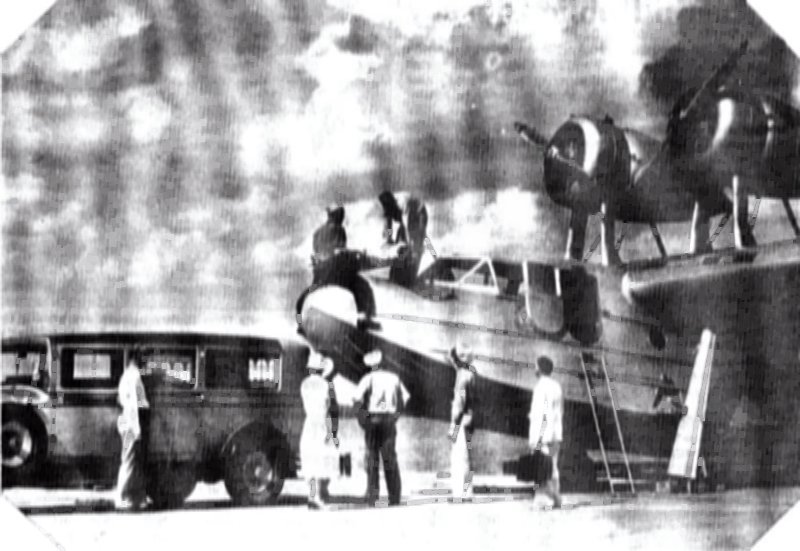
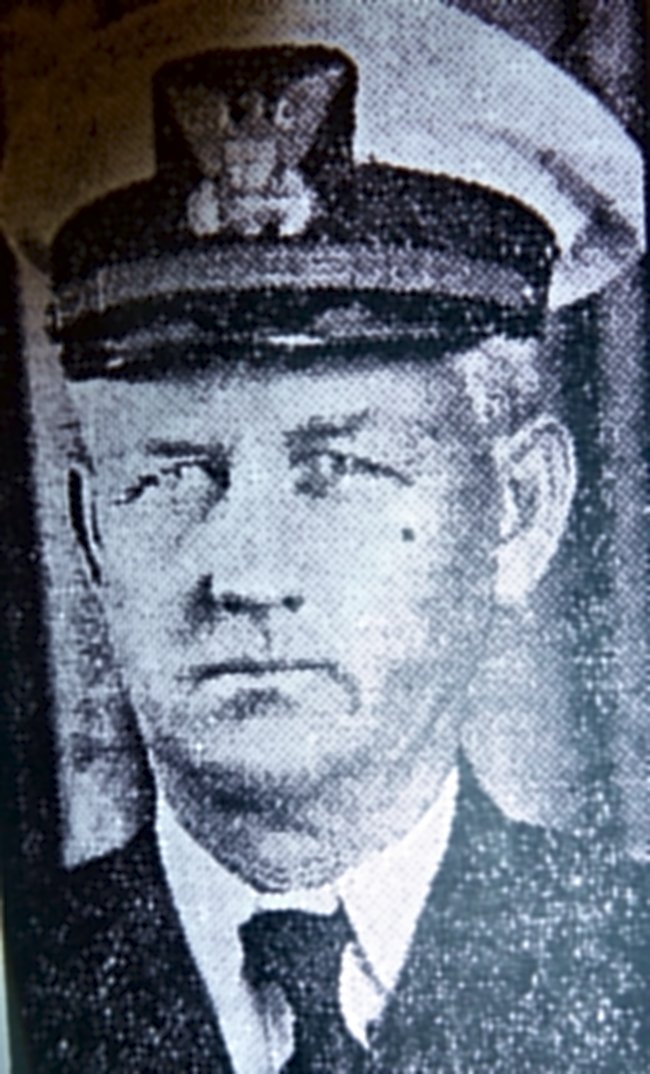
REFERENCES:
The Daily Herald,50th Anniversary Souvenir, Golden Jubilee Number, Biographical and Historical 1884-1934, "Samuel Preston Edmonds, Lieutenant Commander U.S. Coast Guard, retired” , (The Daily Herald: Gulfport-Biloxi, Mississippi-1934).
The Daily Herald, ‘Biloxians to honor Coast Guard Sunday’, April 6, 1929.
The Daily Herald, ‘Many inspect Biloxi Coast Guard Base’, April 8, 1929.
The Daily Herald, ‘3 Boats remain at Biloxi Base’, June 2, 1933.
The Jackson County Times, ‘Work to start on Plane Base in two weeks’, November 18, 1933.
The Daily Herald, ‘To purchase land for C.G. Channel’, March 6, 1934.
The Daily Herald, ‘New Coast Guard barracks’, August 9, 1935.
The Daily Herald, ‘Order Hospital plane to Biloxi’, December 30, 1935.
The Daily Herald, ‘Captain Edmonds dies after short illness at Biloxi’, June 21, 1943.
The Daily Herald, ‘Two sisters first Spars to report to Biloxi CG station’, October 16, 1943.
The Daily Herald, ‘New Coast Guard Plane for Biloxi’, July 9, 1953.
The Daily Herald, ‘Wife of former C.G. Commander dies in Florida’, September 21, 1961.
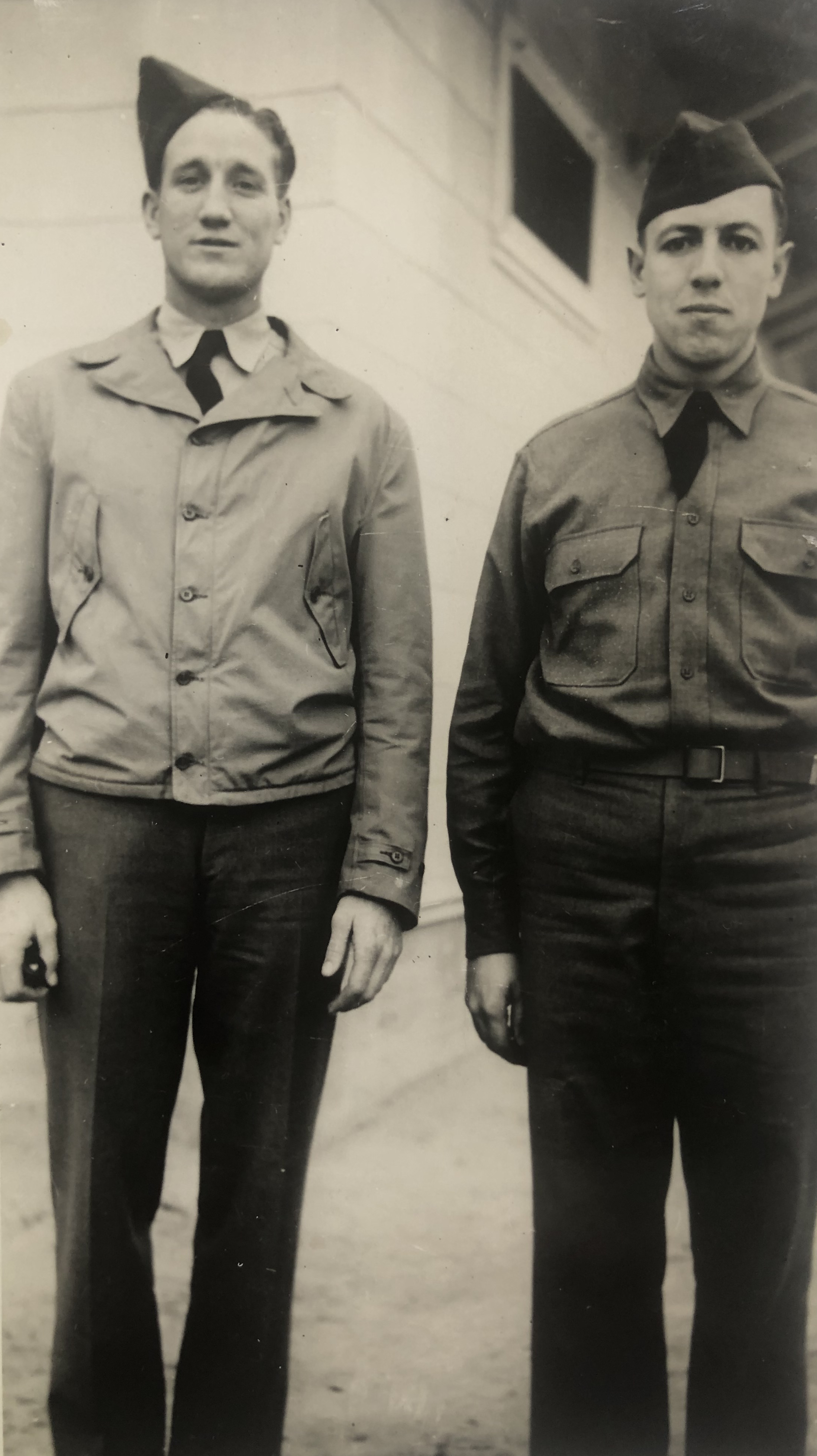
Eight men, described as Jehovah's Witnesses, were arrested in downtown Biloxi on March 1st, a Saturday afternoon, and were subsequently released on $10 bond to appear in city court Wednesday night on charges of disturbing the peace. G.C. Clark, attorney of Waynesboro, Mississippi and representing these seven men, women and several children eight years of age and under related to the press: The Witnesses are active again throughout the nation. Their activities here [Biloxi] incited several young men to chase them along streets calling them names and threatening to run them out of town. No one was hurt, but one Witness shoved a man backwards over a bicycle as he scratched and destroyed a banner bearing these words: 'Abandon religion, serve God and Christ the King. Read Watchtower, 5c."(The Daily Herald, March 3, 1941, p. 6)
Judge John M. Sekul (1911-1984),after a warning for their own personal safety, dismissed several Jehovah Witnesses from the Latimer Community. The Witnesses had been demonstrating in downtown Biloxi and almost caused a riot when citizens became incensed over their placards-one which read 'Down With Religion'. They were also distributing pamphlets.(The Daily Herald, March 6, 1941, p. 1)
The Biloxi Chamber of Commerce pledged $34,000 of the $125,000 required to acquire land for the new technical and training school.(The Daily Herald, March 21, 1941, p. 1)
In March, Biloxi was selected as the site for an Army Air Corps school.(The Jackson County Times, March 22, 1941, p. 1)
In May 1941, the City of Biloxi leased the 685-acre Naval Reserve Park to the Federal Government for an aviation school. In mid-August 1941, 2000 soldiers were living in tents in the Naval Reserve Park.(Harrison Co., Ms. Land Deed Bk. 241, pp. 119-130 and The Daily Herald, August 14, 1941)
In June 1941, the U.S. Army Air Corps activated Station No. 8, Aviation Mechanics School, at Biloxi, Mississippi. By late August 1941, this military installation had been dedicated as Keesler Army Airfield, in honor of 2nd Lieutenant Samuel Reeves Keesler (1896-1918), a native of Greenwood, Mississippi. Lieutenant Keesler had died in France from wounds received while in aerial combat against Germany during the Great War. Keesler Army Airfield not only became technical training center, but trained basic recruits. The first contingent of recruits arrived at Biloxi on August 21, 1941.
In June, a $10 million dollar contract was awarded to the construction companies of F.T. Newton (Hattiesburg), F.S. Glenn (Hattiesburg), J.A. Jones and Bernard Knost (Pass Christian) to erect the Army Air Corps School at Biloxi. Ground was broken on June 18th. The contractors expected to have 2000 men working on the base in two weeks and 10000 laborers in a month.
Byron Patton 'Pat' Harrison (1881-1941) of Gulfport, former Congressman (1911-1919) and US Senator (1919-1941) died in Washington D.C. on the 22nd of June.

Lt. Colonel Arthur Wellington Brock Jr. (1882-1961) was named Commanding Officer of the Biloxi Army Air Corps Technical School in late June.(The Daily Herald, June 26, 1941, p. 1)
In July, the telephone company announced a $70,000 improvement plan at Biloxi to provide permanent telephone facilities at Keesler Field. A new cable with a 1200 phone line capacity will be laid on the north side of Howard Avenue commencing at Fayard Street to the military base.(The Daily Herald, July 1, 1941, p. 1)
In mid-July, 5809 workers were employed building the air school.(The Jackson County Times, July 19, 1941, p. 1)
On July 22nd, the citizens of Biloxi approved a waterworks bond issue to build a $1,400,000 sewerage system and $209,000 in waterworks improvements.(The Daily Herald, July 24, 1941, p. 1)
By late July, the foundations for 233 buildings had been laid at Keesler Field. The new military base was 6.4% completed and there were 9877 laborers employed in its construction.(The Daily Herald, July 26, 1941, p. 3)
Anthony 'Tony' V. Ragusin (1902-1997), Secretary of the Chamber of Commerce, to enter the Army Air Corps. Ragusin was assigned to Keesler Field as public relations officer.(The Jackson County Times, July 28 1941, p. 1)
The R.P. Farnsworth Company had 250 men working on Harrison Court, a $586,000 defense housing project at Bay Terrace. The final development would consist of eighty-seven buildings to house 175 families with a completion date of January 1942.(The Daily Herald, October 17, 1941, p. 1)
The L&N Railroad has started work on the passenger shed at its Biloxi depot. B.R. Keebler, bridge foreman, has a crew of 20 men building the steel, passenger shed from Reynoir Street to the west end of the Express office, a distance of 350 feet. The project will take three weeks.(The Daily Herald, October 30, 1941, p. 7)
In November, J. Allen Bradford, John T. Collins, Gordon A. Dacey and George Collins Jr. founded Bradford, Collins, Dacey & Collins to provide architectural and engineering services necessary for the completion of the sanitary sewerage system and disposal plant at Biloxi.(Harrison Co., Mississippi Chancery Court Chattel Deed Bk. 79, p. 55)
Tri-State Construction Company of Atlanta was low bidder at $89, 134 to erect the USO recreation center at Biloxi.(The Daily Herald, November 25, 1941, p. 1)
On December 7th, the Empire of Japan attacked Pearl Harbor in the Hawaiian Islands. America declared war on Japan the next day. Germany and Italy sign an alliance with Japan and enter the war on December 11th.
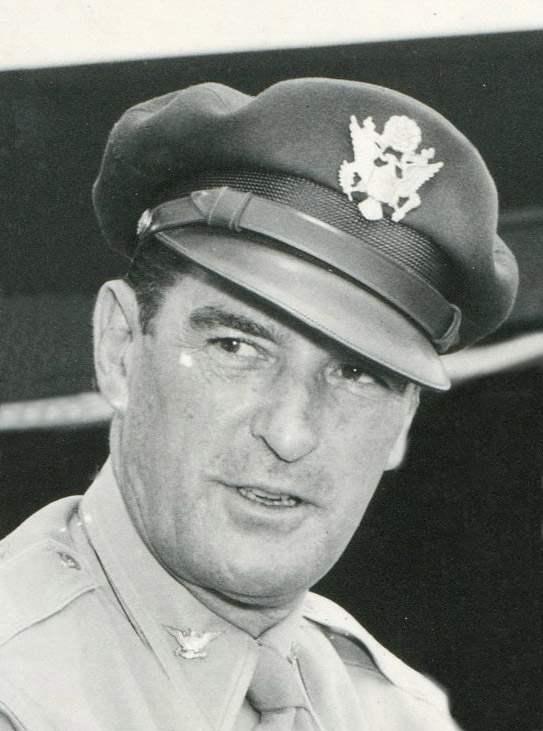
1952
In early October, a USAF T-7, twin-engine, transport aircraft crashed upon take off from KAFB. The plane landed in Back Bay 500 feet south of Brodie Point. Three servicemen died in the accident.(The Daily Herald, October 10, 1952, p. 1)
1955
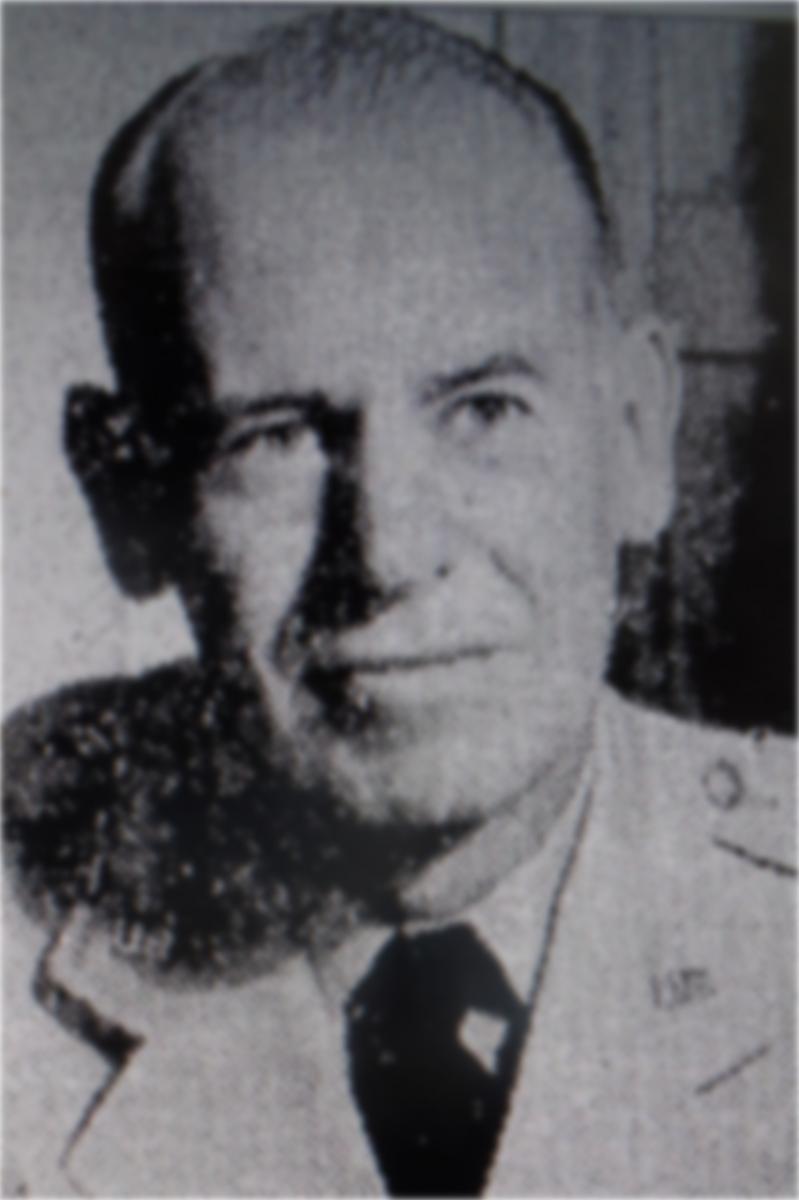
Harlan Clyde Parks
August 1953-April 1955
Major General Harlan Clyde Parks (1906-1987) was born in Selma, Iowa on October 27, 1906. He graduated from Ottumwa High School in Ottumwa, Iowa in 1925. He graduated from the U.S. Military Academy at West Point June 13, 1929. Upon graduation, he was commissioned a second lieutenant in the Coast Artil1ary Corps. From September 1929 to June 1930, General Parks attended Primary Flying School. During the next ten years, he served at various Coast Artillery bases in the United States, Hawaii and the Panama Canal Zone. During this tour, he graduated from the Coast Artillery School (Class of 1936). In Apri1 1941, General Parks was transferred to the Trinidad Sector and Base Command where he served as operations officer and an assistant chief of staff. In June 1943 he entered the Anti-aircraft School, Camp Davis, N.C., completed the course in two months and was assigned operations and training staff officer of the Antiaircraft Training Command Fort Bliss, Texas.
General Parks entered the Army-Navy Staff College in June l944. Upon graduation five months later, he was assigned to the War Department General Staff in tbe G-1 Personnel Division where he served for two years. On June 28, 1946, General Parks was transferred from the Coast Artillery to the Air Force. Five months later, he was assigned to the Strategic Air Command Headquarters at Andrews Air Force Bases, Md., as deputy chief of staff. He attended the Air War College, Maxwell Air Force Base, Ala., from June 1947 to June 1948, after which he was appointed executive officer, Office of the Deputy Chief of Staff for Operations, at Air Force Headquarters. In July 1949 he became director of personnel planning, Office of the Deputy Chief of Staff for Personnel.
General Parks was named commander of Parks Air Force Base, Pleasanton, Calif., in June 1952. He assumed command of the 3380th Technical Wing at Keesler Air Force Base, Mississippi the Electronics Center of the Air Force - on Aug. 20, 1953. On April 6, 1955, General Parks was assigned as senior member of the United Nations Command component of the Military Armistice Commission in Korea. In November of the same year, he joined the Far East Command in Tokyo as assistant chief of staff for personnel.
In December 1956, General Parks became chief of the Army and Air Force Exchange Service with Headquarters in New York City. In his present assignment he is responsible for the worldwide administration of the post exchanges in the Army and base exchanges in the Air Force. General Parks has been awarded the Legion of Merit with two oak leaf clusters, the Commendation Ribbon, the Order of the British Empire, and the Order of Military Merit Taeguk (Republic of Korea). Retired: June 1, 1960. Died: May 4, 1987
Maj. Gen. H.C. Parks Of U.N. Armistice Unit
The New York Times, May 12, 1987
Maj. Gen. Harlan C. Parks, retired, a former senior member of the United Nations Command for the Military Armistice Commission in Korea, died on May 4 of cancer
in Palm Beach, Fla. He was 81 years old and lived in Juneau Beach, Fla. General Parks served with the armistice commission in 1955. He was also assigned to the United Nations Far East Commands in Tokyo as assistant chief of staff, directing personnel. In the last three years of his 31-year military career, he was chief of the Army and Air Force Exchange Service. In that position he was responsible for the administration of a worldwide system of exchanges, or PX's, that provide military personnel and their families with merchandise and services.
General Parks retired from military service in 1960, and then joined the McCann-Erickson advertising firm as a general corporate executive. He was also vice president of the Interpublic Group of Companies, an organization of advertising agencies.
General Parks was born in Selma, Iowa, on Oct. 27, 1906. He was a graduate of the United States Military Academy at West Point, from which he was commissioned as a second lieutenant in June 1929.
He is survived by his wife, the former Catherine Fischer Unger, and two sons, Peter Parks of Manhattan and Dr. Harlan S. Parks of Saratoga, Calif., and three grandchildren. General Parks is to be buried in Arlington National Cemetery on May 27 with full military honors.
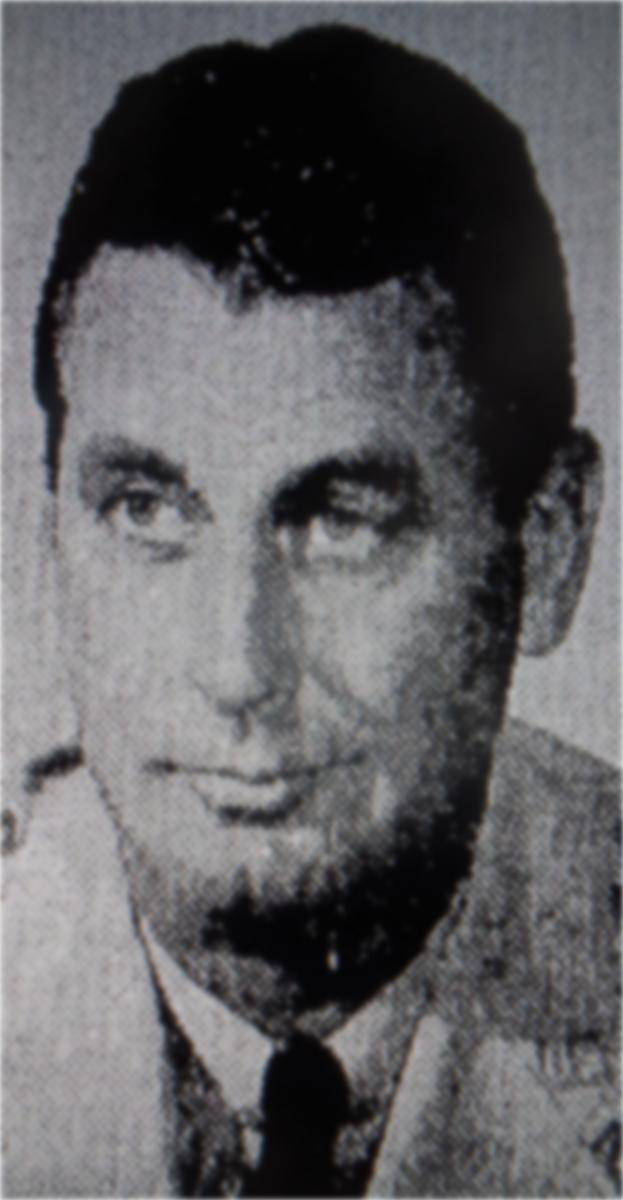
James H. Davies
April 1955-September 1955
Brigadier General James Hubert Davies (1903-1976) was born in Piedmont, California, on October 25, 1903. He graduated from high school there in 1924 and received his Bachelor of Arts degree in social sciences from the University of California in 1928. Commissioned a 2nd Lieutenant in the Air Reserve May 1, 1928, General Davies was appointed a flying cadet the following February. Entering Primary Flying School at March Field, Calif., he graduated from Advanced Flying School at Kelly Field, Texas, May 8 1930, and was commissioned a second lieutenant of Air Corps.
Assigned to the 72nd Bomb Squadron in Hawaii, in March 1932, General Davies was transferred to the Third Attack Group at Fort Crockett, Texas, moving with it to Barksdale Field, La. In October 1936 he joined the 21st Reconnaissance Squadron at Langley Field, Va., and two years later was assigned to the 23rd Composite Group at Maxwell Field, Ala.
Appointed operations officer of the 27th Bomb Group at Savannah, Ga., in March 1941, the following November General Davies assumed command of the group and took it to the Philippine Islands. In February 1942 he was named commander of the Third Bomb Group in the Southwest Pacific, becoming chief of the Bomb Section at the school of Applied Tactics, Orlando, Fla., that November. Returning to the Southwest Pacific in April 1943, he was chief of staff of the Fifth Bomber command. A year later he assumed command of the 313th Bomb Wing at Colorado Springs, Colo., taking it to the Southwest Pacific in January 1945.
Moving to Hamilton Field, Calif., that December, General Davies was assistant chief of staff for operations of the Fourth Air Force. Entering the Air War College at Maxwell Field, Ala., in August 1946, he graduated the following June and became deputy chief of the command section, Air Transport Command, at Gravelly Point, Va. He entered the National War College in August 1948 and graduated the following June.
Joining the Air Training Command, General Davies was deputy chief of staff for personnel at ATRC headquarters, Scott Air Force Base, Ill., becoming chief of staff of the command in May 1950. Assuming command of the 3510th Combat Crew Training Wing, ATRC, at Randolph Air Force Base, San Antonio, Texas, in August 1951 (designated the 3510th Flying Training Wing a year later), in April 1954 [sic] he assumed command of the 3380th Technical Training Wing at Keesler Air Force Base, Mississippi becoming deputy commander that August.
A year later General Davies was named deputy commander of the Alaskan Air Command at Elmendorf Air Force Base, Alaska. His decorations include the Distinguished Service Cross, Silver Star with oak leaf cluster, Legion of Merit and Air Medal with oak leaf cluster. He is rated a command pilot, combat observer and aircraft observer.
General Davies expired on August 20, 1976.
REFERENCES:
The Daily Herald, ‘Parks going to Korea; Davies to command Keesler’, March 18, 1955, p. 1.
The Sacramento Bee, ‘Gibson is named head of Alaskan Air Command’, August 21, 1957, p. C-6.
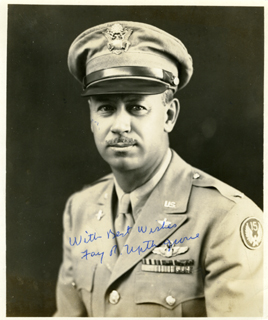
Fay R. Upthegrove
Major General Fay Roscoe Upthegrove (1905-1992) was born in Port Allegheny, Pennsylvania, on January 28,1905. He graduated from the U.S. Military Academy on June 14, 1927 and was commissioned a second lieutenant of Infantry.
That fall General Upthegrove entered Primary Flying School at Brooks Field Texas and graduated from Advanced Flying School at Kelly Field, Texas in October 1928. He then became engineering officer of the 15th Observation Squadron at Selfridge Field, Mich., and in January 1929 was transferred to the Air Force. Entering the Chemical Warfare School at Edgewood Arsenal, Md., a month later, he graduated that April and returned to the 15th Observation Squadron.
Moving to March Field, Calif., in June 1930, General Upthegrove was an instructor at the Primary Flying School. In October 1931 he was named supply officer of the Primary Flying school at Randolph Field, Texas, and the following March was appointed adjutant of the 47th School Squadron there.
Going to Luke Field, Hawaii, in November 1934, General Upthegrove was named flight commander of the Fourth Observation Squadron the following January and assumed command in August 1936. Transferred to Mitchel Field, N.Y., he was assigned duty as operations and intelligence officer of the 99th Bomb Squadron. Entering the Air Corps Tactical School at Maxwell Field, Ala., in May 1939, he graduated that August and returned to Mitchel Field as commander of the 99th Bomb squadron.
Ordered to Langley Field, Va., in December 1940, General Upthegrove became materiel officer of the 22nd Bomb Group, and a month later its executive and operations officer, moving with the bomb group to Jackson Field Miss., several months later. After serving in the Southwest Pacific area from February to April 1942, he assumed command of the 305th Bomb Group at Salt Lake City, Utah. Two months later he took command of the 99th Bomb Group at Davis-Monthan Field, Ariz., taking it to Gowen Field, Idaho, Sioux City, Iowa, and then to North Africa in January 1943. A year later he assumed command of the 304th Bomb Wing, 15th Air Force, in Italy.
Returning to the United States in August 1945, General Upthegrove assumed command of the 76th Flying Training Wing at Smyrna Field, Tenn., and that December took command of the 30th Flying Training Wing at Turner Field, Ga. In May 1946 he was designated commanding general of Chanute Field, Ill. Transferred to U.S. Air Forces in Europe at Wiesbaden, Germany, in November 1948, the following month he assumed command of the 7l00th Headquarters Command Wing, USAFE.
Joining the Strategic Air Command in June 1951, General Upthegrove became deputy commander of the Second Air Force at Barksdale Air Force Base, La., becoming commander of the Fourth Air Division there in October 1952. The following January he assumed command of the 20th Air Force, Far East Air Forces on Okinawa, and on March 1, 1955, assumed command of the 313th Air Division, FEAF.
Transferring to the Air Training Command on Sept. 1, 1955, General Upthegrove assumed command of the 3380th Technical Training Wing at Keesler Air Force Base, Mississippi.
His decorations include the Distinguished Service Medal, Silver Star, Distinguished Flying Cross with oak leaf cluster and Air Medal with 10 oak leaf clusters. He is rated a command pilot, combat observer and senior aircraft observer. General Upthegrove retired from the USAF July 31, 1957. He expired on January 8, 1992. He had married Marcella Gertrude Driscoll (1901-1970). Their corporal remains were interred in the St. Bonaventure Cemetery at Olean, New York.
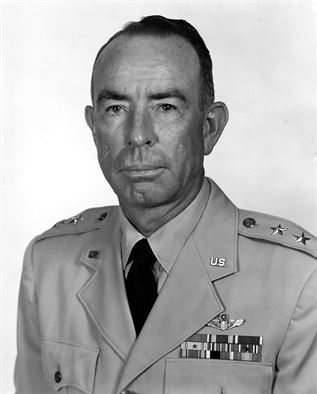
Brig. General Daniel Webster Jenkins (1907-1989)
Brig. General Daniel Webster Jenkins (1907-1989), native of Floydada, Texas and Commander of the Air Ground Operations School, located at Southern Pines, North Carolina, announced in late January that the school would relocate to KAFB in mid-February. The school building in North Carolina had burned on January 20th. Major General Jenkins died on March 25, 1989 and his corporal remains interred at St. Petersburg, Florida.(The Daily herald, January 31, 1957, p. 1)
1960
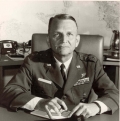
_0.jpg)
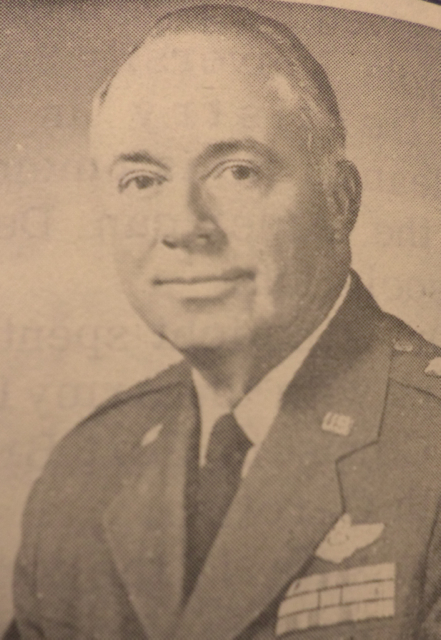
Dale M. Titler and SSgt. Gary M. Murphy, Keesler Field: Inception to Pearl Harbor 1939-1941, (USAF, Office of History, 81st Training Wing, Keesler AFB Technical Training Center: Biloxi, Mississippi-April 1981).
Dale M. Titler, Gulf Tempest: Major Hurricanes and Their Effects on Keesler Technical Center, (USAF, Office of History, 81st Training Wing, Keesler AFB Technical Training Center: Biloxi, Mississippi-1986).
Journals
The Daily Herald, 'General Rush to remain short time longer at Keesler', February 12, 1947.
The Daily Herald, 'Helicopter Air Training may come to Keesler', February 18, 1949.
The Daily Herald, 'Israel WAF is Keesler student', April 5, 1952.
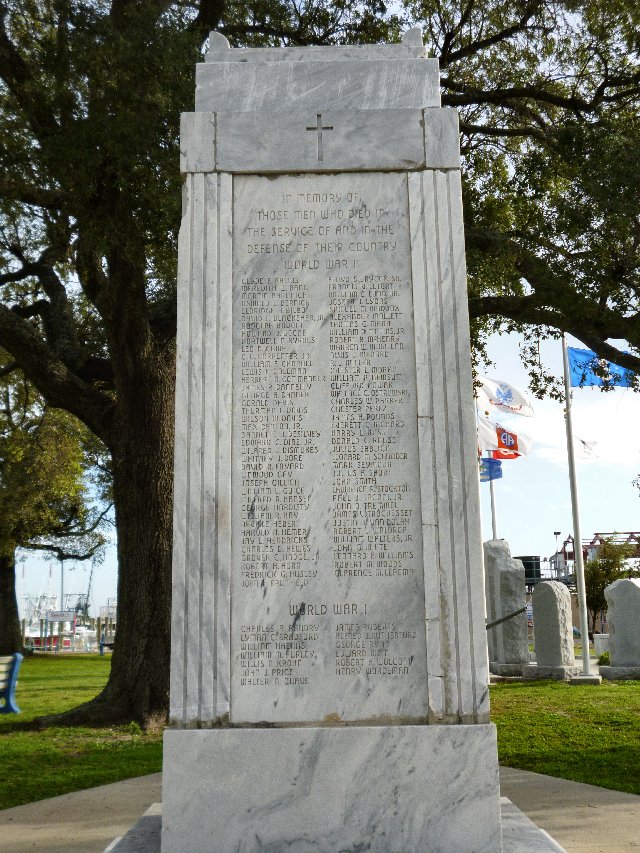
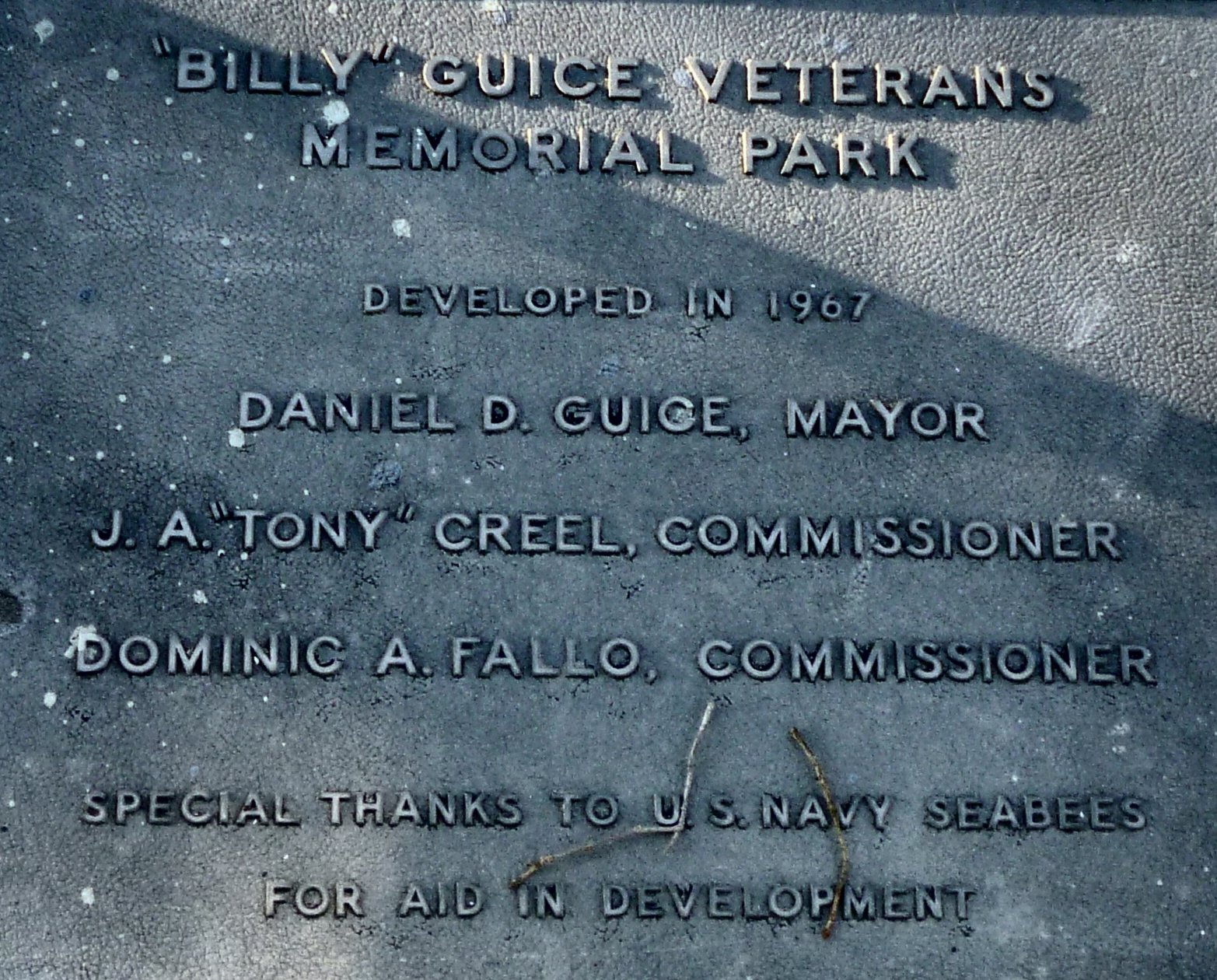
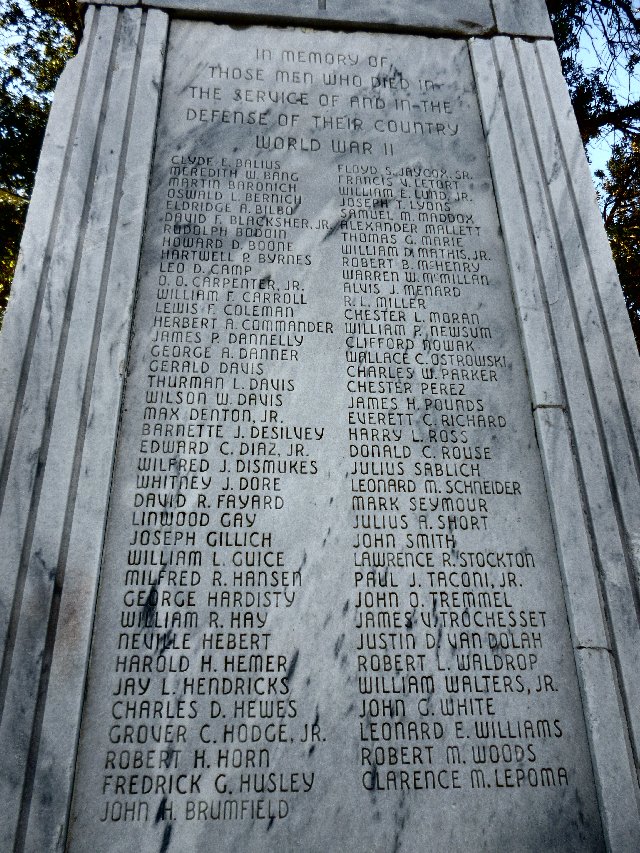
WORLD WAR II MEMORIAL
[dedicated on December 7, 1947 and donated by William Lee Guice (1887-1971)]
[ 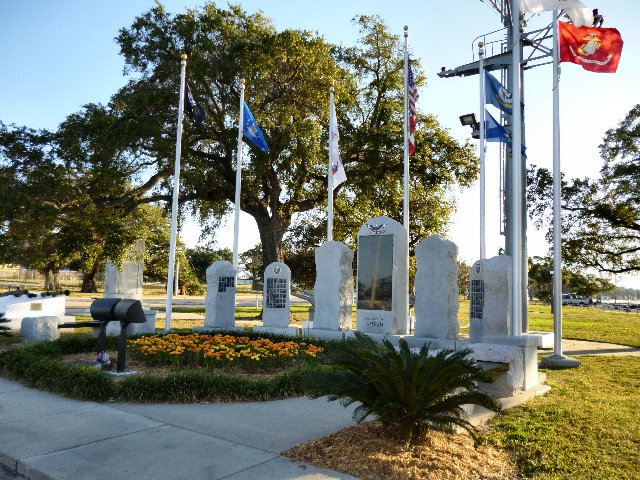
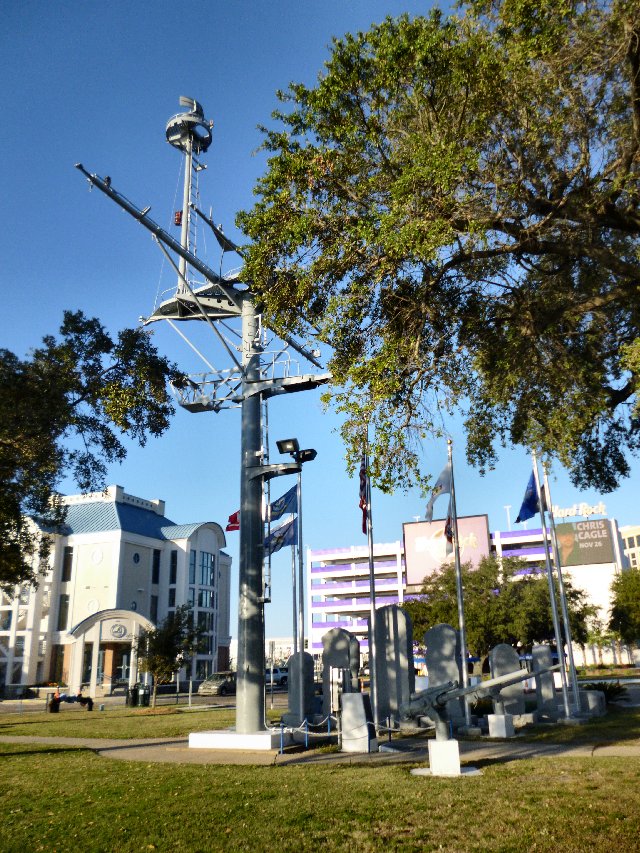
PURPLE HEART MEMORIAL USS BILOXI MAST
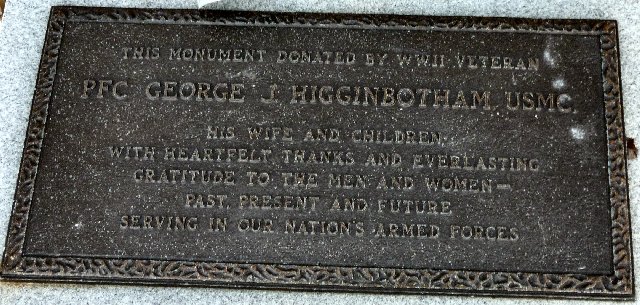
PFC GEORGE J. HIGGINBOTHAM, USMC WAS WOUNDED AT IWO JIMA ON
1942
Marian Desporte Winland , wife of Sgt. Ralph H. Winland (1917-2002) and daughter of Mr. and Mrs. Ernest Desporte, and living at 203 Magnolia Street joined the WAAC auxilliary in October 1942. She went to Camp Shelby for examinations and interviews. She will go to Des Moines, Iowa for basic training and get her uniforms.(The Daily Herald, October 7, 1942, p. 2)
1943
_0.jpg)
Elbert Lester Dukate II (1919-1986) enlisted in the US Army as a Private in December 1941 at El Paso, Texas. He graduated in June 1942 from Signal Corps training at Camp Roberts, California. Elbert then transferred to the Army Air Corps and began pilot cadet training in July 1942,and completed fifty hours of solo flying and was promoted to 1st Lieutenant in the cadet corps at Ontario, California. DuKate received his wings on March 10, 1943 at La Junta, Colorado(The Daily Herald, October 20, 1942, p. 7)
Ploesti Raid
Lt. DuKate was sent to England and flew several combat over Frankfort and Hamburg, Germany. In July 1943, he transferred to Libya with the 44th Bomb Group-67th Squadron of the 8th Air Force. On August 1, 1943, he was co-pilot of the ‘Available Jones’, a B-24 Liberator bomber, that participated in Operation Tidal Wave that sent hundreds of American bombers to destroy German-held, oil refineries at Ploesti, Romania. Referred to in USAF history as ‘Black Sunday’, the US Army Air Force lost 53 aircraft and 660 airmen in the raid.
Sgt. Leo Spann, engineer from Chapman, Alabama, described the mission: “We approached the target down the railroad track at a very low altitude of approximately 100 feet. Our target was already on fire as some other Group [the 93rd] had already bombed it. We went through the smoke and fire, dropping our bombs on our designated spot. We then went down on the deck as low as we could, as those picturesque hay stacks opened up and then revealed their guns – and these guns started giving us hell. They shot out the #4 engine and a shell exploded between the two waist gun positions, wounding both gunners in the legs. I was the engineer and operated the top turret and I had a complete view of what was going on. I saw one plane that had gone in with the wheels up in a field and all of that crew was outside of the plane.
“We broke one balloon cable and I was looking directly at it when we collided with it. I saw another B-24 climb straight up until it stalled, and just as it “fell out” I saw one parachute come out and open just before it hit the ground. I talked later to this boy (Bernard Traudt) as he came into the prison camp where I was.
“We lost speed and dropped out of formation, and the fighters jumped us. With the two waist gunners out, they came in so close to us it seemed we could almost touch them. We figured that we had shot down four of them, and they finally left us, but the #4 engine had frozen up and with a flat propeller, it caused a hellava drag. The propeller would not feather!
“We started trying to gain altitude to clear the mountains ahead. Threw out everything that wasn’t tied down – all of the guns, ammunition, equipment, etc. When we finally arrived at the coast, our #3 engine was failing. The oil pressure was almost gone and the temperature was much too high. Lt. Jones asked me how long I thought it would last and I estimated about 30 minutes at the most. We decided to feather #3 engine and see if we could fly with the other two, but they were on the same side! If we couldn’t fly, we were going to ditch it on the beach.
“I feathered the prop, Jones and Dukate got the plane leveled out, but we could not maintain our altitude. So we began making plans to ditch. We flew onward for approximately forty-five minutes before we were forced to ditch – the time was about 1840 – at least that is the time that my watch stopped. We all managed to get out of the plane and into our life rafts, even though the tail gunner and the navigator were slightly injured in the ditching.
“The next morning a German submarine came by, started to help us, changed their minds and took off, leaving us. Then, at approximately 1500 hours, a three-engined Italian seaplane sighted us, landed and picked us up and took us to Brindisi, Italy and to the hospital there. “Later that same night, Jones, Dukate, Bernard, Paolillo and myself were put on a train and sent into the mountains – to an old monastery. Much later, both Sigle and Dukate managed to escape, with Sigle getting back to the States in about two months.” [www.greenharbor.com/ROHPDF/ROHAU43.pdf]
Fred B. Ferson and Paul Linde, formerly of Tennessee, have given up their jobs to work full time to produce high quality prisms for use by the military as range finders for tanks, ships and large artillery pieces for the Franklin Arsenal. They are assisted in their shop by J.R. McElroy and J.L. McKenzie. Since 1941, the government has given contracts to amateur lens makers to help eliminate the paucity of roof prism manufacturing in America.(The Daily Herald, August 4, 1943, p. 8)
An AT-7, Army Air Corps, trainer from the Army Air Forces navagation school at Hondo, texas crashed into the Gulf of Mexico three miles southwest of Biloxi, Mississipi on August 25th. The plane had just taken off from Keesler Field on a routine training flight. The pilot and three cadets were killed.(The Daily Herald, August 26, 1943, p. 1)
The first SPARS to report to the USCG Biloxi Air Station arrived in mid-October 1943. They were two sisters, Ensigns Alice Saunders and Mary Saunders, natives of St. Cloud, Minnesota and graduates of St. Cloud Teachers' College. Both ladies were school teachers in St. Cloud before entering the Coast Guard women's reserves. Their military training took them to Smith College at Northampton, Massachusetts and the Coast Guard Academy at New London, Connecticut.(The Daily Herald, October 16, 1943, p. 1)
_3.jpg)
Martin P. Baronich Jr.
Martin Paul Baronich Jr. (1922-1943) made his livelihood like his father fishing for the local seafood canneries while living at 223 Sophie Street in East Biloxi. He enlisted in the USCG and was on active duty as a 1stClass Fireman aboard the USS Serpens (AK-97), a cargo ship, when he was killed on October 15, 1943. The USS Serpens was lost with two hundred-fifty men in late January 1945 while loading ammunitions and depth charges at Guadalcanal in the Solomon Islands. Martin’s corporal remains were returned from the South Pacific via San Francisco to Biloxi, Mississippi in October 1947, after WW II for internment in the Southern Memorial Park cemetery. His funeral was held at the Bradford Funeral Home with full military honors on October 26, 1947.(The Daily Herald, October 25, 1943, p. 2 and October 27, 1947, p. 1)
Father J.P. McGlade, pastor of St. John's Catholic Church, announced that three Parish soldiers who were killed in the recent war effort would be honored in a sermon by Father J.L. Maurer, SSJ, pastor of Our Mother of Sorrow Church, on November 14th. Remembered were: Sgt. James Velcich Trochesset, US Army AF, son of Mr. and Mrs. Albert Trochesset killed in a plane crash on September 5, 1942; Seaman 2nd Class Wilfred Jules Dismukes, US Navy, son of Mr. and Mrs. Frank Dismukes, killed in action May 8, 1942; and Fireman 2nd Class, Leonard Mark Schneider, US Navy, son of Mr. and Mrs.Chester Schneider, missing in action April 22, 1943.(The Daily Herald, November 2, 1943, p. 5)
Julia K. Wendt (1892-1985), owner of Gunston Hall on Biloxi's West Beach, was reported by Katherine herr of the Herr Realty Company of Gulfport, Mississippi to be a Japanese POW at Santo Tomas University at Manila, Philippines Islands. Mrs. Wendt was reported to be "in excellent health and engaged in various camp activities. Her latest assignment beginning on a vegetable detail."(The Daily Herald, December 13, 1943, p. 10)
1944
Captain Oswald L. Bernich (1915-1944), son of Matthew L. Bernich (1890-1951) and Jessie Inez Scarborough Bernich (1895-1979), was killed on February 12, 1944 20 miles east of Ardmore, Oklahoma in a B-29 Superfortress crash.(The Daily Herald, February 24, 1944, p. 5 and Feebruary 16, 1944, p. 8)
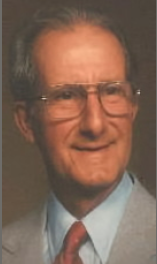
Joseph "Bee" F. Hungerford [1920-2008]


[The Daily Herald, April 4, 1946, p. 1 and p. 3]
John Joseph Labetich (1909-1944) died at the Presidio, US Army Camp, in San Francisco, California on February 20, 1944. He had married Dina Mary Mladinich (1914-2006) in Harrison Couty, Mississppi on September 12, 1934 . They had one daughter, Frances Labetich m. Gus C. Cavalier Jr. (1933-2005). John J. Labetich's corporal remains were interred in the Biloxi Cemetery.(The Daily Herald, February 21, 1944, p. 7 and March 1, 1944, p. 8 and The Sun Herald, October 7, 2006)
Sgt. John Smith (1920-1944), USMC, son of Emellda Smith of 1312 First Street, was killed at Saipan, Marianas Islands on June 23, 1944. Smith had been employed by the Mavar Packing Company and Viator's Grocery and had enlsited in the USMC circa 1937.(The Daily Herlad, September 2, 1944, p. 1)
Charles Diaz, son of Mabel Diaz, Crawford Street, Biloxi, was killed in action in New Guinea on July 31, 1944.(The Daily Herald, September 1, 1944, p. 5)
1945
Edward 'Eddie' E. Lemien (1925-2009), Jehovah Witness, stated in Federal Court at Biloxi that he was an ordained minister since childhood and did not believe in war. Lemien had failed to report for induction into military service and claimed that he had filed an appeal which he had never gotten a reply. Judge Sidney C. Mize instructed the jury to find for the defendant.(The Daily Herald, February 21, 1945, p. 1)
Marine Sgt. Sidney A. Freudenstein Jr., son of Mr. and Mrs. Sidney A. Freudenstein, 626 West Beach, Biloxi, Twin Oaks Cottages, was killed on May 19, 1944 at Okinawa. He had married Alice Williams in September 1943. Sidney A. Freudenstein III was born at NOLA a few days before his father's demise.(The Daily Herald, May 28, 1945)
Michelina Trebotich (1891-1978), native of Croatia and widow of George Trebotich, had six sons serving in the US armed forces: Steve Trebotich (1916-2010)-US Coast Guard; Joseph M. Trebotich (1917-1996)-OSN; George Trebotich-US Army Air Corps; John L. Trebotich (1920-2003)-US Army; Louis J. Trebotich (1923-2004)-USN; andPeter B. Trebotich (1926-2006)-US Army. Madeline Trebotich (1924-2006), a daughter, who married Ernest Keenan, was employed at Keesler Field.(The Daily Herald, September 11, 1945, p. 3)
Lt. Colonel Eugene A. Peresich Jr., age 25, 641 Lameuse Street, Biloxi former commander of a B-27 squadron in the ETO, has been released from active duty at the separation center at Drew Field, Florida. Colonel Peresich served with the 8th Air Force from May 1944 to June 1945, participating in the heavy air offensive during the land invasion of Europe. He flew 29 combat missions and was awarded the DFC with Oak Leaf Cluster and the Air Medal with three clusters. He also holds the American Defense Medal and the European Theater ribbon with six battle stars. Colonel Peresich enlisted as an aviation cadet in February 1941, while a student at LSU. he was graduated a second lieutenant from the flying school at Craig Field, Alabama in Seeptember 1941. His last duty station in the United States was 3rd Air Force Headquarters at Tampa, Florida. He is now active as vice president of Eugene Peresich and Sons Inc., general insurance agency, and will travel throughout Mississippi, but will make his headquarters in Biloxi.(The Daily Herald, October 11, 1945, p. 8)
1947
June 1947-The Lyman C. Bradford Post, VFW began planning for a memorial park between Lameuse and Main Street to honor Biloxians who lost their lives in WWI and WWI. The memorial was to cost $3500 and will be donated anonymously by a local citizen.(The Daily Herald, June 5, 1947, p. 13) .
December 1947-The new WW I and WW II memorial on East Beach donated by William Lee Guice (1887-1971) and Lee Dicks Guice (1892-1961), his wife, through the auspices of the V.F.W. was dedicated on December 7th.(The Daily Herald, December 5, 1947, p. 4)
REFERENCES:
The Daily Herald, “Biloxi youth [Fred A. Tucei] writes of first jump as paratroopers in US Army”, June 19, 1942, p. 5.
The Daily Herald, “Bombardier student [John Oswald Bernich (1923-1997)] tells of experiences”, June 26, 1942, p. 7.
The Daily Herald, “Biloxian [Lt. (jg) August Al Barthes (1916-2007)] tells of victory at Midway”, June 27, 1942.
The Daily Herald, “Lions hear Biloxians [P.J. Gill and Curtis Allen] who were in battle ”, July 29, 1943.
The Daily Herald, “[Frank Roberts] Tells of fighting Italians in Sicily”, August 24, 1943.
The Daily Herald, “[Stephen] Guice tells of Marines battling on Guadalcanal”, August 25, 1943.
The Daily Herald, "Two sisters first SPARS to report to Biloxi Coast Guard Station", October 16, 1943, p. 1.
The Daily Herald, “Captain Bernich on first bombing flight to Rome”, October 20, 1943, p. 2.
The Daily Herald, “Martin Baronich dies in South Pacific”, October 25, 1943..
The Daily Herald, “Fr. maurer to be Memorial speaker", November 12, 1943, p. 5.
The Daily Herald, “Eddie R. Migues [1916-2003] doubles as mule skinner”, December 1, 1943, p. 1.
The Daily Herald, “Biloxi resident [Julia Wendt] is Japanese prisoner", December 13, 1943, p. 10.
The Daily Herald, "Capt. Bernich killed in crash of plane", February 14, 1944, p. 5.
The Daily Herald, "Bernich funeral will be tomorrow", Febraury 16, 1944, p. 8.
The Daily Herald, “John L. Labetich died in Army Camp”, February 21, 1944, p. 7.
The Daily Herald, “Labetich funeral Thursday afternoon”, March 1, 1944, p. 8.
The Daily Herald, “Tell of action of Biloxi Battery [114th Field Artillery-NG] on Italian war front”, April 4, 1944, p. 7.
The Daily Herald, "Veteran [Curtis T. Parker] of Seven Battles tells of reactions overseas”, May 26, 1944, p. 6.
The Daily Herald, “Tony Pitalo tells of life in German war prisoner camp”, May 29, 1945, p. 1.
The Daily Herald, “Advance efforts for Memorial park on Biloxi Beach Front”, June 5, 1947, p. 13.
The Daily Herald, “Memorial Dedication [photo]”, December 5, 1947, p. 4.
The Daily Herald, “”, 19.
The Daily Herald, “Six sons serving in Armed Forces”, September 11, 1945, p. 3.
The Jackson County Times, “German prisoners to be used in wood cutting”, February 24, 1944, p. 1.
The Jackson County Times, “15,600 German prisoners of war based in State”, July 7, 1945, p. 1.
The Daily Herald, “Cpl. Carver arrives in Biloxi tonight”, November 11, 1951.
The Daily Herald, “Cpl. Carver home on 30-day leave”, November 11, 1951.
_________________________________________________________________________________
- 4391 views
Woolmarket
Woolmarket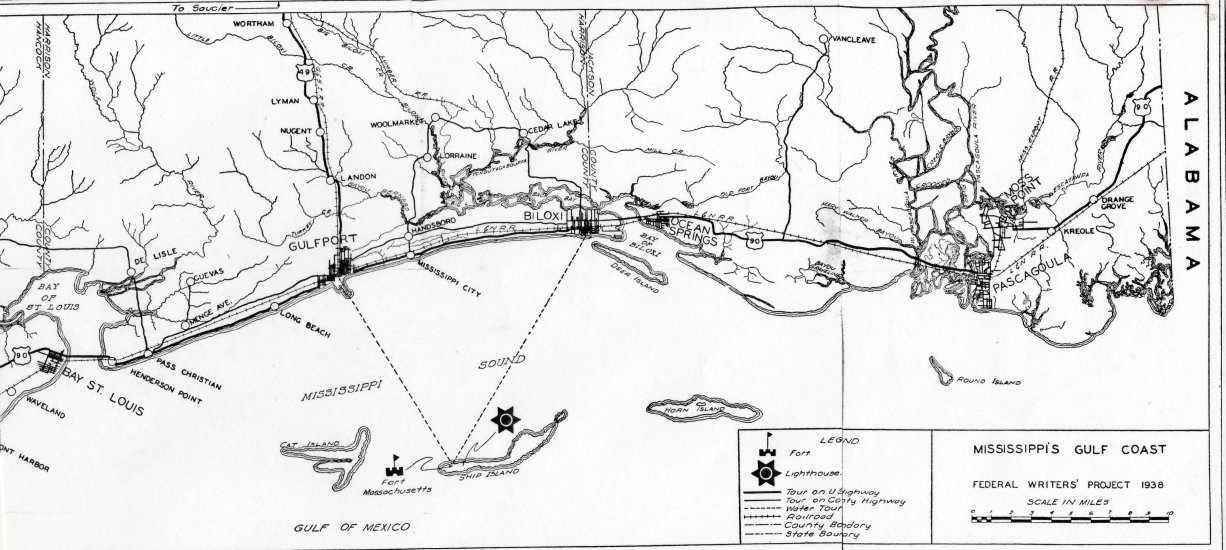
WOOLMARKET
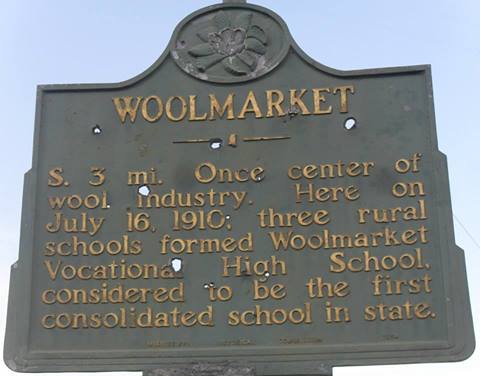

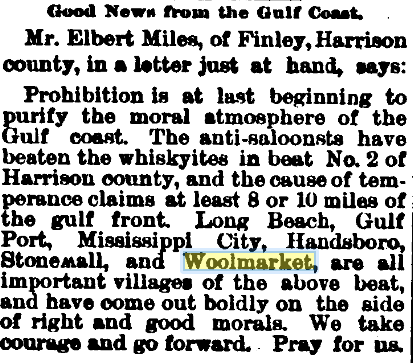
THOMAS WILLIAM GRAYSON (1825-1904)
Thomas William Grayson was born at Paulding, Jasper County, Mississippi on July 18, 1825. His father, Samuel Grayson, a Virginia native was a pioneer settler of Central Mississippi. The elder Grayson was a land surveyor and was an organizer of Jasper County. For fourteen years, Thomas Grayson served the people of Jasper County as the Clerk of the Chancery and Circuit Courts. After the Civil War in which he served with the Mississippi Volunteers 16th Regiment, Company F, Thomas W. Grayson and his wife, Ann Hyde (1832-1906), who he had married in 1847, settled at Shubuta. In Clark County, Grayson was engaged in the mercantile business.
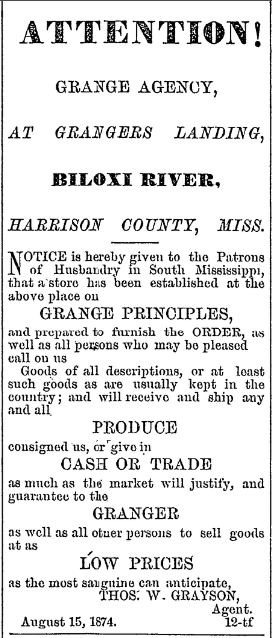
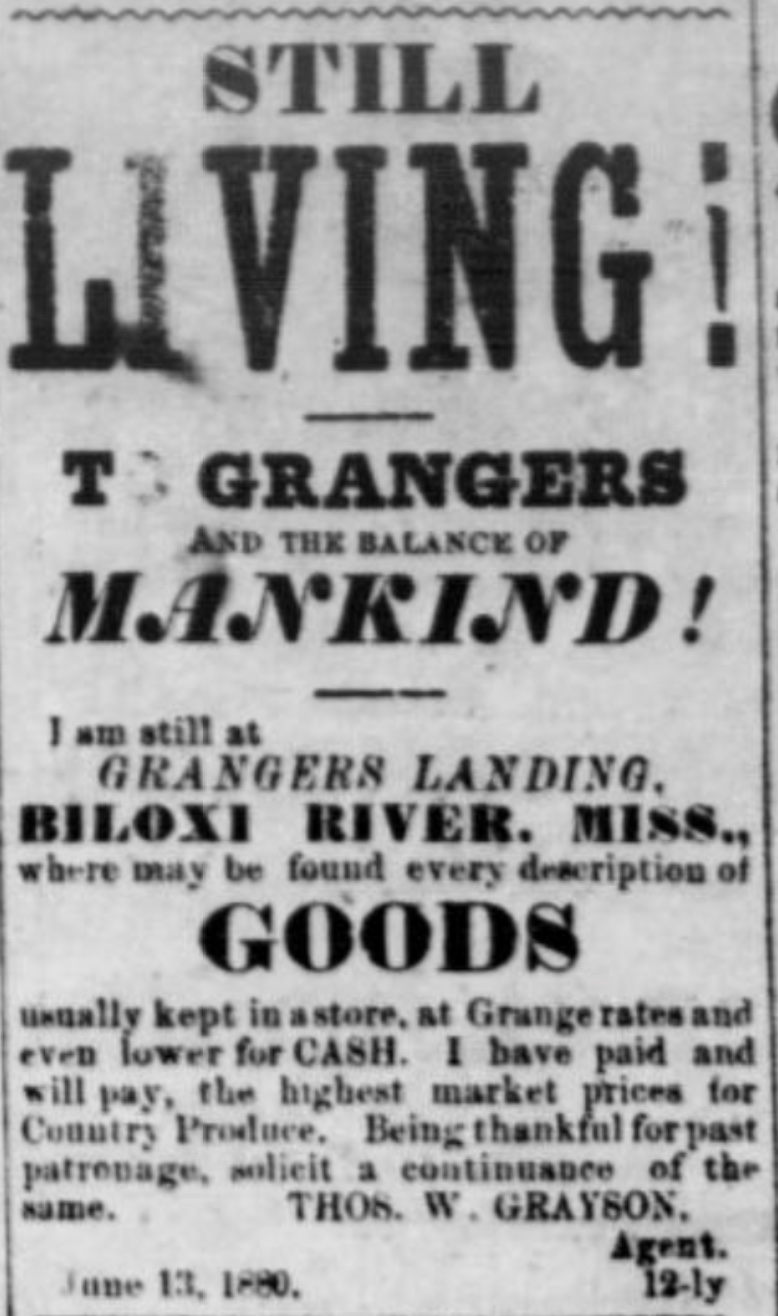
[The Handsboro Democrat, July 1, 1876, p. 4]
The Graysons moved to Ocean Springs in 1872. They remained here for two years and then relocated to Stonewall, now Woolmarket, in Harrison County. Grayson was a merchant there until 1881, when he moved back to Ocean Springs. His brother, George Grayson, had settled at Stonewall when the saw millers and woodcutters were actively exploiting the virgin, longleaf, yellow pine forest after the Civil War. George Grayson, himself a merchant, sold his store to Captain Joseph Stiglets. Stiglets deepened the lagoon to the Biloxi River and created a landing for his five coastal schooners. This site became known as Stiglet's Landing.
At Ocean Springs in January 1882, Thomas W. Grayson bought the home of Dr. David M. Dunlap (1803-1882+).(1) The property had two-hundred twenty feet on Washington Avenue south from Desoto and ran west to Jackson Avenue. Grayson had slightly over three acres in the heart of town. Barber and realtor, Edwin Martin Westbrook (1858-1913), would acquire a portion of this property later.(JXCO, Ms. Land Deed Bk. 5, pp. 615-616)
Thomas W. Grayson became a Justice of the Peace and notary. He served as Mayor of Ocean Springs in the term 1897-1898. At the time of his demise on March 4, 1904, he was Justice of the Peace for Beat Four. E.W Illing (1870-1947) was elected to his vacated office. Loren H. Whitney wrote the following after the death of Judge Grayson: "Suppose the whole world of people were like him. What then! There would be no more locking of doors at night. There would be no more jails or penitentiaries. The world would be transformed. Young men of Ocean Springs, study Judge Grayson's life and follow it, for it is worthy of all honor and praise.”
Judge Grayson was a Methodist and high-ranking Mason. He was a Mason for over fifty years. Thomas W. Grayson and Ann Hyde had thirteen children. The following are currently known: Lillian Grayson (1862-1892) married D.D. Cowan (1850-1929); Mrs. F. (Mary) Sandoz (d. 1915) of Mobile; Mrs. W.L. Owen of Alexandria, Louisiana; Walton G. Grayson (1870-1947); George W. Grayson (1870-1943) married Mamie Pol (1873-1951); Ella Grayson (b. 1875); Deliah Grayson (1885-married Clement G. Lang; Sallie Grayson (b. 1889) married John C. Orrell; and Thomas W. Grayson Jr.
Judge Grayson's corporal remains were interred at the Evergreen Cemetery in Ocean Springs, Mississippi. Mrs. Grayson died in early January 1906.(The Pascagoula Democrat-Star, January 12, 1906, p. 3)
REFERENCES:
Regina Hines Ellison, Ocean Springs 1892 (Second Edition), (Lewis Printing Services: Pascagoula-1991), p. 45.
Mississippi Gulf Coast Yesterday & Today (1699-1939), Federal Writers Project in Mississippi Works Progress Administration, (Gulfport Printing Company:Gulfport-1939), p. 136.
The Biloxi Herald, "Necrological", March 5, 1904, p. 1.
The Daily Herald, "Long Illness Is Fatal To Mrs. Geo. W. Grayson At Biloxi", November 19, 1951, p. 8.
The Pascagoula Democratic-Star, "Local News", October 12, 1883, p. 3.
The Pascagoula Democratic-Star, "T.W. Grayson", March 12, 1904, p. 4.
The Pascagoula Democratic-Star, "Ann Hyde Grayson", January 12, 1906, p. 3.
The Progress, "Thomas W. Grayson", March 12, 1904, p. 4.
The Progress, "Honor Judge Grayson", March 12, 1904, p. 1.
US Census - Jackson County, Mississippi (1900)
SCHOOLS

SHEEP and WOOL
A local industry long forgotten, but still in the distant memory of those born around 1920, is that of range animals. Cattle and sheep once roamed the savannas and forests of Harrison and Jackson County foraging on the native grasses. Several families in the St. Martin and Latimer communities north of Fort Bayou were especially well known for sheep husbandry. Some of these clans were the Basque, Krohn, Lamey, Seymour, Lemien, Eglin, Havens, Letort, and Ramsay families. The people living north of Ocean Springs in the piney woods were primarily subsistence farmers. They raised corn and hay to feed their cattle and hogs, had vegetable gardens, and supplemented their incomes through charcoal burning, lumber, and the wool from sheep. It was common for a farmer to own as many as a thousand sheep. In fact, the wealth of farm and country people was determined by their peers from the number of sheep that they possessed.
Sheep were generally never enclosed in pastures. The range was open to everyone and the stock animals of each owner mixed together. This necessitated marks and brands to differentiate ownership of the animals. From the Books of Stock Marks and Brands at the Jackson County Archives in Pascagoula, it can be ascertained the brands and marks of many individual animal owners. For example, in August 1919, Mary Doyle Krohn registered her brand as a V on the right hip of the animal. The brand and mark were valid for cattle, sheep, hogs, and goats.
In the spring on an appointed day, the stock owners had a "round up". On horseback, they drove the free ranging sheep to a common meeting point called the "parting pens". Here all the sheep were put into one pen and the lambs separated from them. The ewes were then placed in a pen with the lambs. When the lamb recognized its mother, the two were caught and the lamb given the owners mark and put into the pen of the owner. The individual flocks were then driven to the farm of each owner and shorn of their wool.
Flocks of sheep generally grew slowly as frigid winters took its toll. Many lambs died in the spring from exposure after birth. When turpentine stills were active in the area, the dogs of the turpentine workers roaming the forest, as well as wild hogs ate many young sheep. Eagles were troublesome to the farmers until they were nearly hunted to extinction. The wool produced in coastal Mississippi was classified as "Lake" wool. It brought a higher price than wool produced in counties further north as manufacturers considered it the very best.
Septuagenarian, Bernard Basque, resided on the family farm north of Fort Bayou, shared some of his childhood experiences concerning sheep husbandry. He remembers well the spring when the ewes gave birth to a lamb. Twins were rare. The lamb remained with its dam for about six months. Merino rams were bought in Texas for breeding purposes.
After shearing the sheep with manual shears, their wool was packed for market. A man would stand in a tall burlap bag and compress the wool by hand. When complete the wool bales would weigh two-three hundred pounds. In the early days, the wool was sent to Ocean Springs by wagon when the Davis Brothers were still active in the business. By the 1930s, merchant, Cliff Dees (1886-1963), at Vancleave, was the area wool broker.
Bernard Basque recalls to well the day his father, Joseph Basque (1892-1978), drove two thousand head of sheep to the farm of Albert White located north of Vancleave. He walked the entire distance herding the stray animals. Bernard relates that there were no "chuck wagons" on these sheep drives. Their family mark was "under square, under slope".
The Basque family had several uses for their sheep besides the commercial wool. The mutton was often eaten as a stew, baked, or fried. When a new baby was born into the family, the hide of a freshly slain sheep was stretched and dried. This sheepskin functioned as comfortable bedding for the youngster. Mrs. Basque and other women would card the wool into 4" x 6" squares called "batts". The batts were sewn between two layers of cloth and a warm quilt was created for bedding.
Colonial days
The history of sheep and wool in this area cannot be traced to the early Colonial years. In April 1699, when d'Iberville (1661-1706) landed at present day Ocean Springs to build Fort Maurepas, he recorded in his journal the following: "my longboat brought from the cows that belong to Surgere and me. We brought them from France. All those I got in St. Domingue (Haiti) died, three on board the Francois, one on the Marain, and four on the island where they had been placed (Ship Island?). Most people say it is the cold weather, although it has not been cold".
A few days later, the Frenchmen brought hogs and a bull to Fort Maurepas. No sheep are mentioned.
William R. Stuart
It is not known with great certainty when the first sheep were brought into Jackson County. As early as 1878, Colonel W.R. Stuart (1821-1894) was raising merino sheep at Ocean Springs. He also shipped pecans to Melbourne, Australia in 1890. Stuart had retired to Ocean Springs from New Orleans. On November 22, 1878, Stuart advertised his stock in The Pascagoula Democrat-Star as follows:
FOR SALE
PURE MERINO SHEEP
25 ewes, 2 years old in April to lamb 15 January to 15 February by a $200 imported Spanish buck.
10 pure merino bucks, 2 years old in April. My
connections with Colonel Cockrell of Tennessee, the great
breeder of pure merino sheep, enables me to fill orders at
all times from his large flock as well as my own.
W.R. Stuart-Ocean Springs, Mississippi
In July 1879, Colonel W.R. Stuart vended some of his Merino sheep to various Coast and regional stockmen. Alfred E. Lewis acquired three; Meyer, Weiss and Company of New Orleans bought six; A.A. Ulman, the proprietor of a wool factory at Bay St. Louis, got two; H.M. Duke of Scooba purchased one fine buck; and A.G. Ward of Mobile acquired two. Mr. Ulman believed that introduction of the Merino breed into the local flocks would improve the quality and quantity of the wool.(The Pascagoula Democrat-Star, July 7, 1879, p. 3)
In July 1879, Colonel Aldridge of Grenada, Mississippi drove four hundred sheep into northern Jackson County. It was anticipated that more stockmen would locate here to raise sheep.(The Pascagoula Democrat-Star, July 11, 1897, p. 3)
Woolmarket
Ocean Springs being the nearest railhead became a regional center for the buying and shipping of raw wool from the ranchers north of Fort Bayou. Woolmarket on the Biloxi River assumed this role at Harrison County. The coastal schooner was the vehicle for transport at that riverine village in Harrison County.
In 1882, the family of Thomas W. Grayson (1825-1904) came to Ocean Springs from the Woolmarket area. Grayson operated a mercantile store on the Biloxi River in the SW/4 of Section 32, T6S-R9W. This site later became known as Stiglet's Landing when Joseph M. Stiglets (1852-1924) purchased it from Dr. David M. Dunlap (1803-1884+) in November 1884.
Thomas W. Grayson is believed to have given the name "Wool Market" to the area since sheep and wool production prospered in the neighborhood. Grayson served the people of Ocean Springs as its fourth mayor (1897-1898). He was also Justice of the Peace here. His son-in-law, D.D. Cowan (1850-1929), was the first mayor of Ocean Springs (1893-1895) and also Superintendent of Education for Jackson County (1896-1905).
Back Bay Bridge
In July 1898, a writer for The Biloxi Herald publicized the need for a free bridge across the Back Bay of Biloxi to present day D'Iberville (called Back Bay at this time). He felt that the trade from this area was being diverted from Biloxi to other cities. As an example of this he related the following: Take the item of wool alone (which is grown beyond the bay), about $12,500 worth has been marketed at Ocean Springs this year and while this city could not hope to secure all the wool trade, there is not the least doubt but a large portion of that crop would be marketed in this city. There are many other products, which it is unnecessary to enumerate at this time, that would be marketed here had we such a bridge across the bay. (The Biloxi Herald, July 23, 1898, p. 2.)
The people of Back Bay (D'Iberville) got their wooden bridge to Biloxi in August 1901. It replaced an intermittent ferry system, which had been in established by the Board of Police of Harrison County in August 1843. Coincendentally, the first bridge to span Fort Bayou was dedicated in December 1901, replacing the Franco-Earle-Carver ferry which connected Ocean Springs to the wool country.
Wool marketing
In late May and June of 1891, nearly 63,000 pounds of wool were vended at Ocean Springs by local wool farmers, as compared to about 49,000 pounds in 1890. The Davis Brothers were acquiring large lots of wool for $.24 per pound while smaller lots were bought for a penny or two less. Last year prices were better. Wool growing is the best paying rural investment.(The Biloxi Herald, June 27, 1891, p. 1 and The Pascagoula Democrat-Star, June 12, 1891, p. 2)
The Davis Brothers, who operated a large mercantile store on Washington Avenue, were the leading brokers of wool at Ocean Springs. As early as 1891, George W. Davis (1842-1914) and Elias S. Davis (1859-1925) were purchasing wool from local farmers. When the shearing season closed in June of 1892, they had shipped over 60,000 pounds for which they paid about $14,000 ($.23 per pound).
In June 1895, New Orleans brokers paid local stockmen at Ocean Springs about .$13 per pound for over 30,000 pounds of Jackson-Harrison County wool.(The Biloxi Herald, June 15, 1895)
Sardin G. Ramsay vended 6000 pounds of wool to the Davis Brothers at Ocean Springs at the rate of $.15 per pound.(The Pascagoula Democrat-Star, June 4. 1897, p. 3)
H. Piser & Company of Mobile acquired over 50,000 pounds of Jackson County wool through the Davis Brothers, their local agent. The price was 19 1/2 cents per pound.(The Pascagoula Democrat-Star, July 7, 1899, p. 3)
Nine hundred head of sheep driven to Ocean Springs from the Vancleave ranches of H.C. Havens, Thomas E. Ramsay, and George W. Tootle. They were shipped to W.L. Bramblett in three railcars to Paris, Kentucky.(The Pascagoula-Democrat-Star, May 18, 1900, p. 3)
The Ocean Springs News reported the following wool marketing activity at Ocean Springs:
In June 1909, the Davis Brothers of Ocean Springs shipped about 1200 pounds of wool to the H. Piser & Co. of Mobile. They expected about 20,000 pounds to be marketed in the next week and consigned to the Mobile firm. This was the remainder of the remarkable wool purchase made by H. Piser & Co. sometime ago at the top notch price of 31 1/2 cents per pound.
In late August 1910, L.M. McClure & Company paid local stockmen 21 ½ cents per pound for their wool.
On September 22, 1910, the Metzger Brothers of Mobile bought 18,000 pounds of wool for 21 1/2 cents per pound. During the past three weeks nearly 40,000 pounds of wool were sold at Ocean Springs. Sardin Ramsay, one of Jackson Counties most substantial farmers and sheep owners, was in town to market his wool, probably the 18,000 pounds. L.M. McClure & Co. were local agents for Metzger Brothers. Sardin G. Ramsay (1837-1920) was a farmer and large landowner. The Ramsay tract consisted of several thousand acres of land in southeast quadrant of T6S-R7W. It was located southeast of the present day intersection of Highway 57 and the Gautier-Vancleave Road.
In late June 1912, wool growers from the country surrounding Ocean Springs brought over 70,000 pounds of their fleecy cut to town for shipment on the L&N Railroad to New Orleans, Mobile, and eastern manufacturing centers. Considered an average year, principal buyers, Metzker Brothers and Piser & Company of Mobile and William Vokel & Company of New Orleans, paid growers about $11,000 for their harvest.(The Daily Herald, June 27, 1912, p. 8)
In July 1915, the Ocean Springs district sold 32,000 pounds of wool at $.32 per pound. In 1914, the selling price was 21 to 25 cents per pound. As a result of the flush prices, several wool producers bought automobiles. Jackson County sheep owners produced 49,000 pounds of wool in 1915.(The Ocean Springs News, July 8, 1915, p. 1)
H.D. Money (1869-1936), who was the proprietor of the Rose farm north of Fort bayou, was also a proponent of sheep raising. Colonel Money had fruit and pecan orchards on his large farm. In September 1915, Money reported to The Ocean Springs News that his experience with sheep raising, although on a small scale, was very profitable. He related the following about his experiences: The fertilizer benefits they did those orchards is almost unbelievable. From scanty and unsatisfactory appearance, the trees put on a deep and healthy green. The nut yield is large. The sheep found abundant to eat-nothing was planted there-only the natural grass supported them. In keeping the weeds down, they saved me the expense of cultivating as well.
During the final years of World War I (1914-1918), the price of wool and mutton again increased dramatically. By October 1917, the price of wool reached $.60 per pound nearly doubling pre-War prices. Mutton cost the consumer $.17 per pound at this time. These inflated prices caused speculators to seek immediate investments in the sheep industry because of its high profit potential.
October 1917-Two hundred sixty head of sheep were shipped to Fort Worth, Texas by land owners north of Fort Bayou. Price was $3-$4 per head.
December 1917-The Southern Pine Association met at New Orleans to discuss the possibility of the large sheep flocks of the Western ranges relocating to the cut-over and timbered pine lands of the South. The western ranchers were restricted by recent homesteading of public lands there. These wool growers were seeking grazing lands for their large operations.
Newton Jones
At Ocean Springs, Newton Jones, a native of Columbus, Ohio, who came here in 1913, and bought Field Lodge, the home of Mary Florence Field at East Beach for $15,000, was one of these entrepreneurs who attempted to take advantage of the wool boom of the late War years. Mrs. Field was living at Nice, France when she sold her thirty-three acre estate to Jones. Here on the Cote d'Azur in 1914, she met Chevalier Scovel, the great tenor. They married and resided in Paris at the Villa Spontini. Field Lodge burned in the 1960s. In October 1917, Newton Jones bought 1200 acres in the northwest Latimer area from Anna Orrell and the heirs of Christopher Columbus Orrell (1832-1906), a turpentine operator and native of North Carolina, who settled here from Alabama. Here in Sections 21, 27, and 28 of T5S-R9W, he founded the Jackson County Sheep Ranch. The sheep ranch of Jones was located primarily in Harrison County straddling the Jackson County line about twelve miles north of Ocean Springs. It was fenced. In order to stock his ranch, Jones received a shipment of two hundred sheep from Bayou Sara, Louisiana in October 1917. Only one animal died in the relocation effort. The animals were driven from the L&N depot at Ocean Springs to his rural sheep ranch. In an October 1917, interview with The Jackson County Times, Newton Jones said: Sheep suffer from the lack of attention just like a growing crop, and for the best results to follow, one has to give them attention, or the enterprise becomes a failure.
In addition, Newton Jones said "that the average sheep grown in this territory weighed but 40 pounds at maturity, whereas lambs attained that size in the west in four months. This difference is the result of neglect on the part of those engaged in raising sheep, and they can be produced here of equal value to those in the west". He planned to demonstrate that they could. At the time during the Fall of 1917, a son of Newton Jones, Sergeant La Berne Jones, was serving in the Ohio artillery camped at Montgomery, Alabama. Newton Jones had a partner in the Jackson County Sheep ranch. He was Dr. Fitch who also came here from Ohio. Fitch officed in the Farmers and Merchants State Bank Building. He replaced Dr. Henry B. Powell (1867-1949) who went to Camp Shelby with the 139th Field Artillery as a Captain in the Medical Corps. After the War in April 1921, they sold their Latimer area sheep ranch to Forrest Short of Circleville, Ohio. Newton Jones also sold Field Lodge to Mr. Short at the same time, and apparently left the area. He and his wife, Gertrude Jones, probably returned to Ohio. The following reports were gleaned from The Jackson County Times to illustrate wool and sheep activity in the area from 1917 to 1927:
June 1919-A big wool sale of over 75,000 pounds at $.58 per pound was made in the area.
May 1924-Joe Basque (1892-1978) who lived north of Ocean Springs shipped 1000 head of sheep to Ohio. The price was $3.00 per head.
June 1924-Two carloads of wool were sold to a Mobile broker for $.40 per pound. The market had just dropped below this price.
June 1925-W.H. Westfall (1874-1939) and other merchants in the Vancleave area handled over 23,000 pounds of wool which was marketed at Ocean Springs at an average price of $.50 per pound. J.C. Harvey of Mobile bought the entire shipment.
June 1926-A quarantine order stopped movement of sheep in nine Mississippi counties, including Jackson. Sheep scabies, a communicable disease caused by mites, was the problem. Only dipped and disease free animals could be shipped. Several carloads of sheep were dispatched from Ocean Springs via dipping the vats at Hattiesburg. Mrs. Mary Doyle Krohn (1860-1944), former postmistress at Latimer and widow of Fred Krohn (1859-1918), sold 679 sheep to northern interest at $3.00 per head.
August 1927-During the past six weeks, Mr. R.J. Sously of Ocean Springs shipped over 6000 head of sheep to various parts of Kentucky, Tennessee, and Missouri. 2000 head were from the Krohn farm across Fort Bayou.
The decline of commercial sheep raising north of Fort Bayou can be traced to the passage of Chapter 263-House Bill No. 91 by the Mississippi legislature in 1926. The stock law was passed to prevent all live stock (cattle, horses, mules, jacks, jennets, sheep, goats, and hogs) from running at large upon open or unfenced lands. Animals were restricted to a safe enclosure. The statue also sought to prevent the spread of Texas fever ticks. In 1930, Bonnett v. Brown (No. 28288) tested the stock law in the Supreme Court of Mississippi. The original suit had been filed at George County.
Another crushing blow to sheep husbandry in the area was the 1934 screw worm epidemic. It did serious damage to regional flocks and almost destroyed the sheep industry at Jackson County.
Sheep are still raised in Jackson County today albeit their numbers are small. Now, wool fetches about $1.92 per pound as compared to $.50 per pound seventy years ago. In a comparable time period, land values in the outback Fort Bayou region have soared from $4.00 per acre to upwards of $1,000 per acre. The moral-raise land not sheep.
REFERENCES:
Ray L. Bellande, "Stiglets Landing", (unpublished essay), August 1995, p. 1.
Regina Hines Ellison, Ocean Springs, 1892, 2nd Edition, (Lewis Printing Services: Pascagoula, Mississippi-1991), p. 45, p. 55, and p. 59..
Facts About The Gulf Coast of Harrison County, Mississippi, (Reprint-Harrison County Publishing Company Ltd.-Gulfport, Mississippi-1985), pp. 13-14.
General Laws of the State of Mississippi, Chapter 263, (Tucker Printing House: Jackson, Mississippi-1926, pp. 374-375.
Jackson County WPA, p. 308.
Southern Reporter, "Bonnett v. Brown" (No. 28288), (West Publishing Company: St. Paul, Minnesota-1930), pp. 427- 429.
Jackson County, Ms. Record of Marks and Brands Book 2, pp. 12-13.
Minute of the Board of Police of Harrison County, Mississippi, Book 1, p. 42.
Journals
The Biloxi Herald, "A Bridge Needed", July 23, 1898, p. 2.
The Biloxi Herald, “Ocean Springs”, June 27, 1891.
The Biloxi Herald, "Ocean Springs", November 8, 1890, p. 4.
-------------------, "Ocean Springs", June 25, 1892, p. 1.
-------------------, February 21, 1899, p. 8.
The Daily Herald, “Lot Of Wool Sold In Ocean Springs”, June 27, 1912, p. 8
The Jackson County Times, "Local News Interest", June 30, 1917.
--------------------, "Jones Sheep Ranch Attracts Attention", October 6, 1917, p. 5.
--------------------, "Local News Interest", October 3, 1917.
--------------------, "Local News Interest", October 20, 1917.
--------------------, "Local News Interest", November 3, 1917.
--------------------, "Western Sheep Owners May Bring Flocks To South Mississippi", December 15, 1917, p. 1.
--------------------, Local and Personal, June 28, 1919.
--------------------, Local and Personal, May 31, 1924.
--------------------, "Farmers market two carloads of wool at Ocean Springs", June 28, 1924.
--------------------, Local and Personal, June 13, 1925.
--------------------, "Shipments of Sheep Stopped by Quarantine", June 5, 1926, p. 1.
--------------------, "Local and Personal", August 6, 1927.
The Ocean Springs News, "Local News", June 5, 1909.
The Ocean Springs News, “Local News”, August 20, 1910.
------------------, "Local News", September 24, 1910.
------------------, "Wool Shippers Want Autos", July 8, 1915, p. 1.
------------------, "Hundred Per Cent Profit", September 30, 1915, p. 1.
The Pascagoula Democrat-Star, "Sheep raising near the Gulf Coast", August 2, 1878, p. 1.
The Pascagoula-Democrat Star, "W.R. Stuart advertisment", November 22, 1878, p. 4.
The Pascagoula Democrat-Star, “Ocean Springs Items”, July 11, 1879.
The Pascagoula Democrat-Star, “Ocean Springs News”, June 12, 1891.
The Pascagoula Democrat-Star, “Ocean Springs Locals”, June 4, 1897.
The Pascagoula Democrat-Star, “Ocean Springs Locals”, May 18, 1900.
The Pascagoula Democrat-Star, "New Bridge Across Fort Bayou Opened", December 13, 1901.
Personal Communication:
Bernard Basque-March 1996 and July 1996.
Wool brokers
As early as 1881, Robert W. Lewis (1858-1886) of Ocean Springs was brokering wool for the William Mehle Company of New Orleans. (The Pascagoula Democrat-Star, April 22, 1881, p. 3)
Mr. Lewis was the son of Alfred E. Lewis (1812-1885) and Ann R. Farrington (1821-1901) of the Lewis Sha Plantation at West Pascagoula (Gautier). He married Mathilde L. Staples (1858-1928+), the daughter of Solomon G. Staples (1817-pre 1874) and Adeline A. Terrell (1829-1902) of St. Tammany Paris, Louisiana and Pass Christian, Mississippi. They were the parents of Ora M. Lewis Davis (1880-1911+), Lillian? Lewis (b. 1882), and Robert W. Lewis Jr. (1886-1904).
By 1892, the Davis Brothers at Ocean Springs, were purchasing wool from local farmers. When the shearing season ended in June 1892, they had shipped over 60,000 pounds of wool for which they paid about $.23 per pound. (The Pasacagoula Democrat-Star, June 1892) J.M. Breeland (1847-1903), a well-known sheep raiser in the region, shipped a car load of wool to Metzger Brothers of Mobile in October 1896. (The Pascagoula Democrat-Star, October 9, 1896)
By 1911, more than 40,000 pounds of wool were sold at Ocean Springs by sheep owners, who lived within a twenty-five mile radius of the town. Farmers received about $.18 per pound for their wool. Mobile brokers represented at the sale were H. Piser & Company and Metzker Brothers while Wm. E. Vouchel & Son came from New Orleans. (The Ocean Springs News, June 17, 1911, p. 1)
Demand for wool and mutton increased dramatically during WW I (1914-1918), as more than the entire wool production of America was utilized to make clothing for the US Army. (The Jackson County Times, January 12, 1918, p. 1) With this huge requisition for wool, the market price soared to $.58 per pound by the shearing season of June1919. Over 75,000 pounds of wool were sold by area farmers at Ocean Springs. (The Jackson County Times, June 28, 1919, p. )
After WW I, the demand for wool slowed and the price dropped accordingly. In June 1925, W.H. Westfall (1874-1939) and other merchants at Vancleave handled over 23,000 pounds of wool. It was marketed at Ocean Springs to J.C. Harvey of Mobile who paid an average price of $.50 per pound. (The Jackson County Times, June 13, 1925)
The decline of commercial sheep production in the piney woods section can be traced to the passage of Chapter 263-House Bill No. 91 by the Mississippi State legislature in 1926. This law was approved to prevent all livestock (cattle, horses, mules, jacks, jennets, sheep, goats, and hogs) from grazing at large upon the open range or unfenced lands. Stock animals were restricted to safe enclosure. The statute also sought to prevent the spread of Texas fever ticks. (General Laws of the State of Mississippi, 1926, pp. 374-374) In 1930, Bennett v. Brown (Case No. 28,288) tested the stock law in the Mississippi Supreme Court. The original cause had been filed at George County. (Southern Reporter, 1930, pp. 427-429)
Open range
In April 1932, the rural precincts of Jackson County voted to change the State stock law and allow an open range for stock animals outside of cities. The vote was 635 to 131 in favor of abrogation with approximately 50% of the eligible voters going to the polls. (The Daily Herald, April 5, 1932, p. 2)
US POSTMASTERS
William J. Johnston-December 1889
Mary Kittrell-June 1891
Eleanor M. Meyers- July 1893
Clara Cox- February 1899
Walter H. Cox-May 1899
James A. Calhoun-November 1907
Discontinued-April 1914
- 3368 views